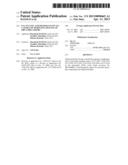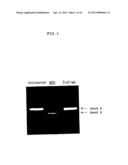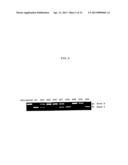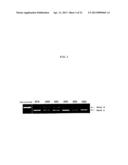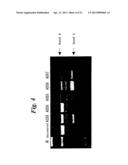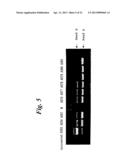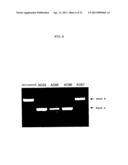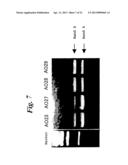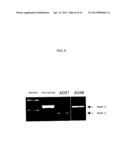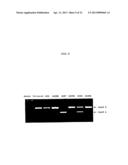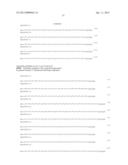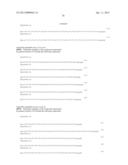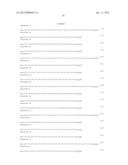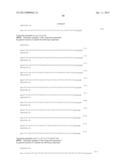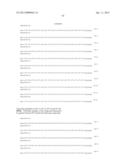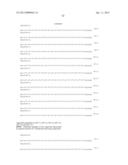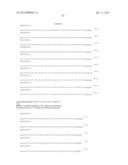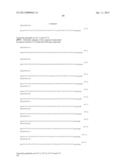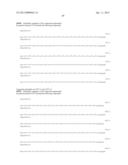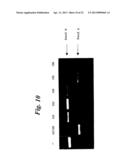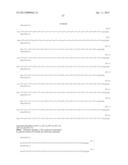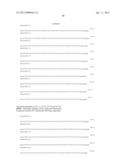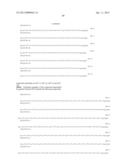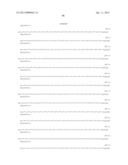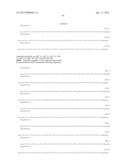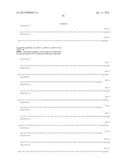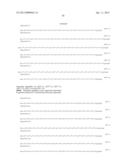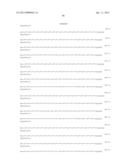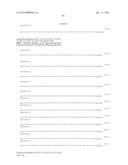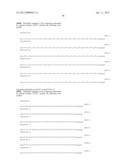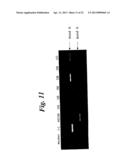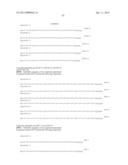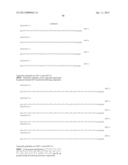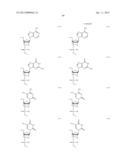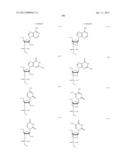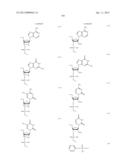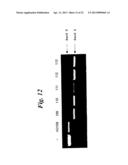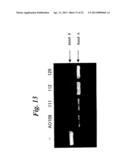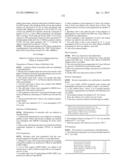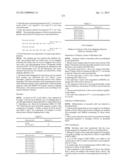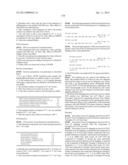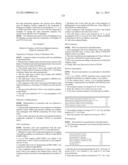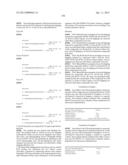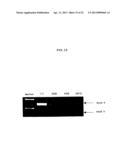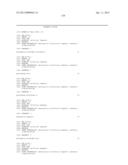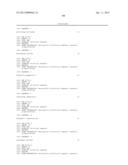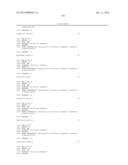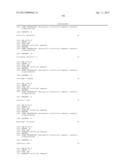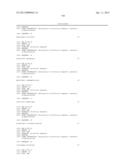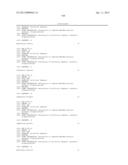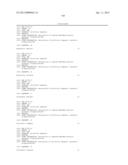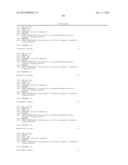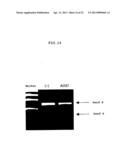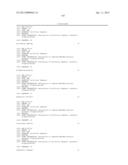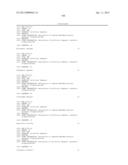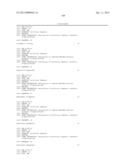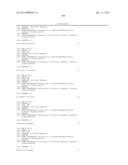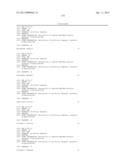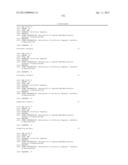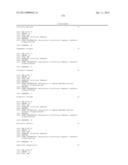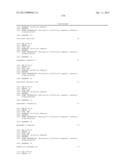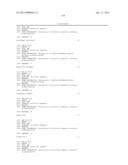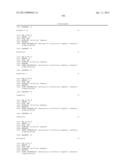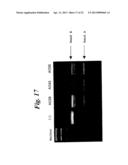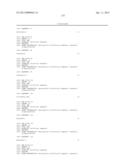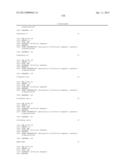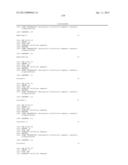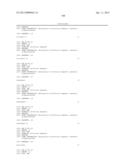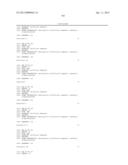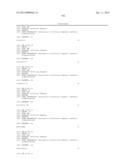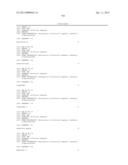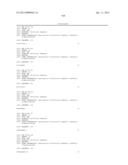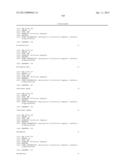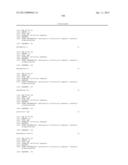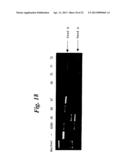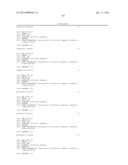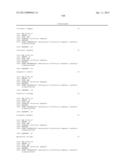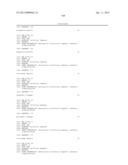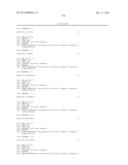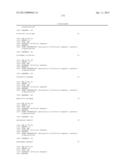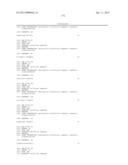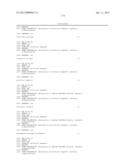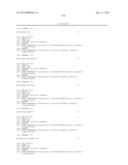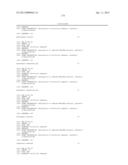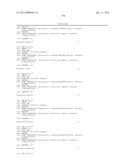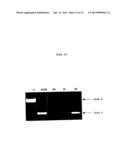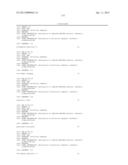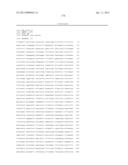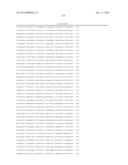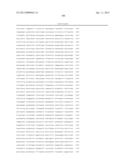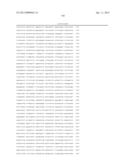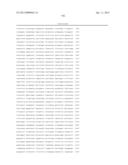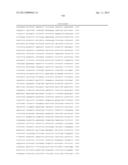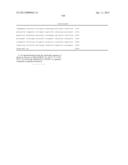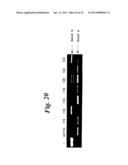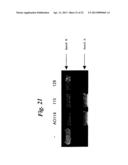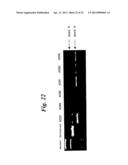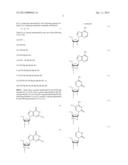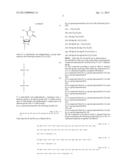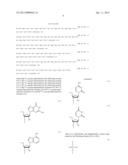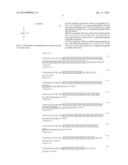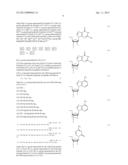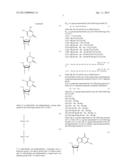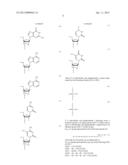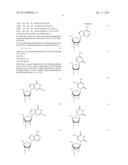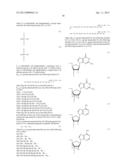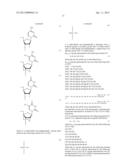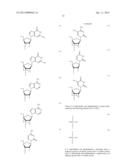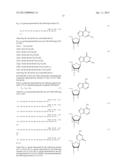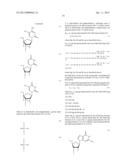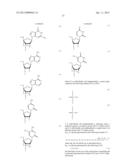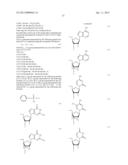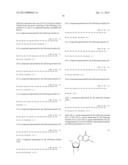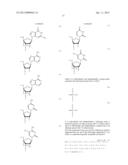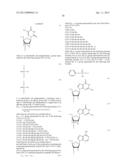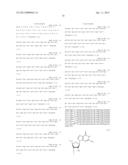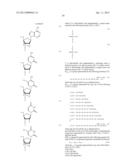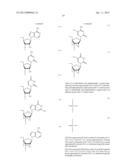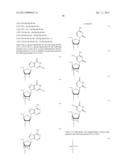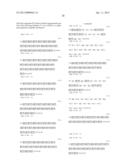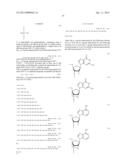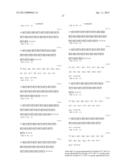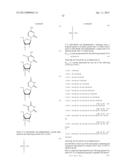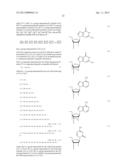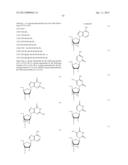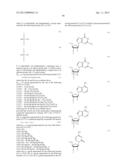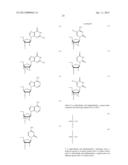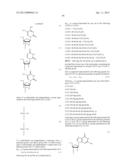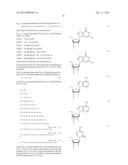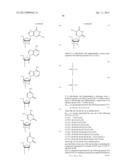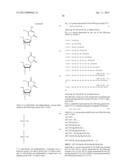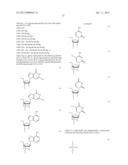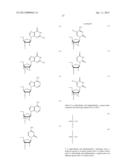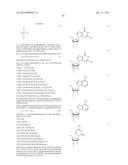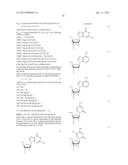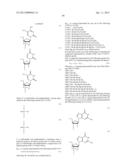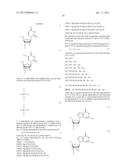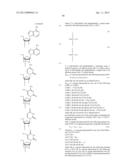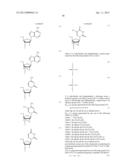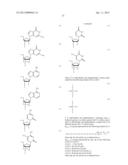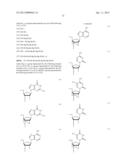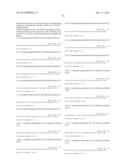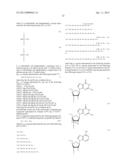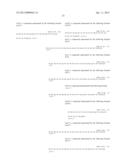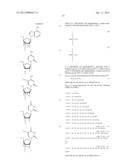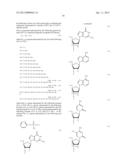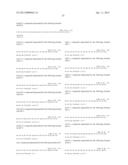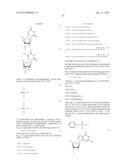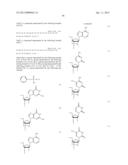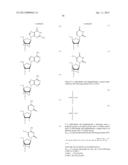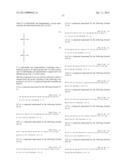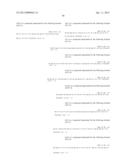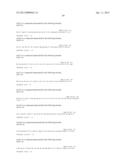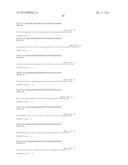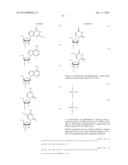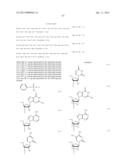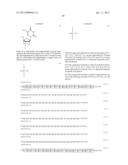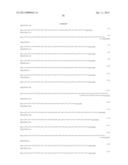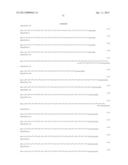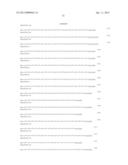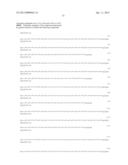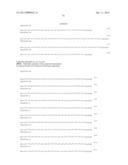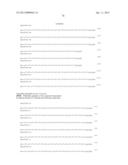Patent application title: ENA NUCLEIC ACID PHARMACEUTICALS CAPABLE OF MODIFYING SPLICING OF mRNA PRECURSORS
Inventors:
Masafumi Matsuo (Kobe-Shi, JP)
Yasuhiro Takeshima (Kobe-Shi, JP)
Makoto Koizumi (Tokyo, JP)
Makoto Koizumi (Tokyo, JP)
IPC8 Class: AC07H2104FI
USPC Class:
536 245
Class name: N-glycosides, polymers thereof, metal derivatives (e.g., nucleic acids, oligonucleotides, etc.) dna or rna fragments or modified forms thereof (e.g., genes, etc.) nucleic acid expression inhibitors
Publication date: 2013-04-11
Patent application number: 20130090465
Abstract:
Oligonucleotides having a nucleotide sequence complementary to nucleotide
numbers such as 2571-2607, 2578-2592, 2571-2592, 2573-2592, 2578-2596,
2578-2601 or 2575-2592 of the dystrophin cDNA (Gene Bank accession No.
NM_004006.1) and therapeutic agents for muscular dystrophy comprising
such oligonucleotides.Claims:
1. An oligonucleotide having the nucleotide sequence as shown in any one
of SEQ ID NOS: 2-6, 10-13, 17, 19-22, 30-77, 87 or 88 in the SEQUENCE
LISTING, or a pharmacologically acceptable salt thereof.Description:
CROSS-REFERENCE TO RELATED APPLICATIONS
[0001] The present application is a division of U.S. Ser. No. 12/847,237, filed Jul. 30, 2010, which is a division of U.S. Ser. No. 10/536,258, filed Dec. 13, 2005, which is a National Stage (371) of PCT/JP03/14915, filed Nov. 21, 2003, and claims priority to JP 2003-204381, filed Jul. 31, 2003, and JP 2002-340857, filed Nov. 25, 2002.
TECHNICAL FIELD
[0002] The present invention relates to ENA nucleic acid pharmaceuticals capable of modifying splicing of mRNA precursors. More specifically, the present invention relates to antisense oligonucleotide compounds to splicing enhancer sequences within exon 19, 41, 45, 46, 44, 50, 55, 51 or 53 of the dystrophin gene, as well as therapeutic agents for muscular dystrophy comprising the compounds.
BACKGROUND ART
[0003] Muscular dystrophy, which is a genetic muscular disease, is roughly classified into Duchenne muscular dystrophy (DMD) and Becker muscular dystrophy (BMD). DMD is the most frequently occurring genetic muscular disease and occurs at a ratio of 1 per 3,500 male births. DMD patients show symptoms of weakening of muscles in their childhood; thereafter, muscular atrophy progresses consistently and results in death at the age of around 20. Currently, there is no effective therapeutic for DMD. Development of therapeutics is strongly demanded by DMD patients throughout the world. BMD in many cases occurs in adulthood and most of the patients are capable of normal survival though slight weakening of muscles is observed. Mutations of deletions in the dystrophin gene have been identified in 2/3 of DMD and BMD cases. The progress of clinical symptoms in DMD or BMD patients is predictable depending on whether such deletions disrupt the translational reading frame of mRNA or maintain that reading frame (Monaco A. P. et al., Genomics 1988: 2:90-95). Although molecular biological understanding of DMD has been thus deepened, no effective method for treating DMD has been established yet.
[0004] When DMD patients have a frame shift mutation, dystrophin protein disappears completely from patients' skeletal muscles. On the other hand, dystrophin protein is produced from in-frame mRNA in BMD patient-derived muscle tissues, though the protein is incomplete. As a method for treating DMD, there is known a method in which an out-frame mutation (the reading frame of amino acids is shifted) is converted to an in-frame mutation (the reading frame is maintained) by modifying dystrophin mRNA (Matsuo M., Brain Dev 1996; 18:167-172). Recently, it has been reported that the mdx mouse synthesized a deletion-containing dystrophin as a result of induction of exon skipping with an oligonucleotide complementary to the splicing consensus sequence of the dystrophin gene (Wilton S. D. et al., Neuromusc Disord 1999: 9:330-338; Mann C. J. et al., Proc Natl Acad Sci USA 2001: 98:42-47). In these studies, exon skipping is induced using as a target the splicing consensus sequence located on the border between two exons.
[0005] It is asserted that splicing is regulated by splicing enhancer sequences (SESs). In fact, it has been demonstrated that by disrupting the SES within exon 19 of the dystrophin gene with an antisense oligonucleotide complementary thereto, complete skipping of exon 19 occurs in normal lymphoblastoid cells (Takeshima Y. et al., J Clin Invest 1995: 95:515-520; Pramono Z. A. et al., Biochem Biophys Res Commun 1996: 226:445-449).
[0006] It has been also reported that by introducing an oligonucleotide complementary to the SES within exon 19 of the dystrophin gene to thereby induce exon skipping, a deletion-containing dystrophin was successfully produced in muscular cells derived from DMD patients carrying exon 20 deletion (Takeshima Y. et al., Brain & Development 2001: 23:788-790; Japanese Unexamined Patent Publication No. H11-140930; Japanese Unexamined Patent Publication No. 2002-10790). This indicates that repairing of the reading frame shift by inducing exon 19 skipping with an antisense oligonucleotide complementary to the SES within exon 19 of the dystrophin gene results in production of a dystrophin protein whose function is partially restored; and thus it is possible to change DMD to BMD. If it is possible to convert DMD, a severe myoatrophy, to slight BMD, prolonging patients' lives can be expected.
[0007] At present, oligonucleotide analogues having stable and excellent antisense activity are being developed (Japanese Unexamined Patent Publication No. 2000-297097).
[0008] It is an object of the present invention to provide therapeutics with broader applicable range and higher efficacy, by improving antisense oligonucleotides to the SES within exon 19, 41, 45, 46, 44, 50, 55, 51 or 53 of the dystrophin gene.
DISCLOSURE OF THE INVENTION
[0009] As a result of extensive and intensive researches toward the achievement of the above-described object, the present inventors have succeeded in designing and synthesizing those nucleotide sequences and antisense oligonucleotide compounds which have higher exon skipping effect on exon 19, 41, 45, 46, 44, 50, 55, 51 or 53 of the dystrophin gene. Thus, the present invention has been achieved.
[0010] The present invention may be summarized as follows.
[1] An oligonucleotide having the nucleotide sequence as shown in any one of SEQ ID NOS: 2-6, 10-22, 30-78, 87 or 88 in the SEQUENCE LISTING, or a pharmacologically acceptable salt thereof. [2] The oligonucleotide of [1] above or a pharmacologically acceptable salt thereof, wherein at least one of the sugars and/or the phosphates constituting the oligonucleotide is modified. [3] The oligonucleotide of [2] above or a pharmacologically acceptable salt thereof, wherein the sugar constituting the oligonucleotide is D-ribofuranose and the modification of the sugar is modification of the hydroxyl group at position 2' of D-ribofuranose. [4] The oligonucleotide of [3] above or a pharmacologically acceptable salt thereof, wherein the modification of the sugar is 2'-O-alkylation and/or 2'-O,4'-C-alkylenation of the D-ribofuranose. [5] The oligonucleotide of [2] above or a pharmacologically acceptable salt thereof, wherein the modification of the phosphate is thioation of the phosphate group. [6] A compound represented by the following general formula (I) or a pharmacologically acceptable salt thereof:
BT--BM--BB (I)
where BT is a group represented by any one of the following (1a) to (1k):
(1a) HO--,
(1b) HO-Bt-,
(1c) HO-Bc-Bt-,
(1d) HO-Bg-Bc-Bt-,
(1e) HO--Ba-Bg-Bc-Bt-,
(1f) HO-Bg-Ba-Bg-Bc-Bt-,
(1 g) HO-Bt-Bg-Ba-Bg-Bc-Bt-,
(1 h) HO-Bc-Bt-Bg-Ba-Bg-Bc-Bt-,
(1j) HO-Bc-Bc-Bt-Bg-Ba-Bg-Bc-Bt-, or
(1k) HO-Bg-Bc-Bc-Bt-Bg-Ba-Bg-Bc-Bt-;
[0011] where Bg is a group represented by the following formula (G1) or (G2); Ba is a group represented by the following formula (A1) or (A2); Bc is a group represented by the following formula (C1) or (C2); and Bt is a group represented by the following formula (U1) or (T2):
##STR00001## ##STR00002##
where X is individually and independently a group represented by the following formula (X1) or (X2):
##STR00003##
Y is individually and independently a hydrogen atom, a hydroxyl group or an alkoxy group with 1-6 carbon atoms; and Z is individually and independently a single bond or an alkylene group with 1-5 carbon atoms; BM is a group represented by the following formula (2):
TABLE-US-00001 (SEQ ID NO: 2) -Bg-Ba-Bt-Bc-Bt-Bg-Bc-Bt-Bg-Bg-Bc-Ba-Bt-Bc-Bt- (2)
where Bg, Ba, Bt and Bc are as defined above; BB is a group represented by any one of the following (2a) to (2h):
(2a) --CH2CH2OH,
(2b) -Bt-CH2CH2OH,
(2c) -Bt-Bg-CH2CH2OH,
(2d) -Bt-Bg-Bc-CH2CH2OH,
(2e) -Bt-Bg-Bc-Ba--CH2CH2OH,
(2f) -Bt-Bg-Bc-Ba-Bg-CH2CH2OH,
(2g) -Bt-Bg-Bc-Ba-Bg-Bt-CH2CH2OH, or
(2h) -Bt-Bg-Bc-Ba-Bg-Bt-Bt-CH2CH2OH
[0012] where Bg, Ba, Bt and Bc are as defined above; provided that at least one of the nucleosides constituting the compound represented by formula (I) has 2'-O,4'-C-alkylene group. [7] The compound according to claim 6 which is selected from the group consisting of the following compounds (i) to (vi), or a pharmacologically acceptable salt thereof: (i) a compound where BT is a group represented by (1k) and BB is a group represented by (2h), (ii) a compound where BT is a group represented by (1a) and BB is a group represented by (2a), (iii) a compound where BT is a group represented by (1a) and BB is a group represented by (2h), (iv) a compound where BT is a group represented by (1e) and BB is a group represented by (2a), (v) a compound where BT is a group represented by (1k) and BB is a group represented by (2a), (vi) a compound where BT is a group represented by (1a) and BB is a group represented by (2f), and (vii) a compound where BT is a group represented by (1a) and BB is a group represented by 2d). [8] The compound of [6] above which is selected from the group consisting of the following compounds (I1) to (I7), or a pharmacologically acceptable salt thereof:
TABLE-US-00002 (SEQ ID NO: 1) HO-Bg**-Bc**-Bc**-Bt**-Bg**-Ba*-Bg*-Bc*-Bt*-Bg*-Ba*-Bt*-Bc*-Bt*-Bg*- Bc*-Bt*-Bg*-Bg*-Bc*-Ba*-Bt*-Bc*-Bt*-Bt*-Bg*-Bc**-Ba**-Bg**- Bt**-Bt**-CH2CH2OH (I1) (SEQ ID NO: 2) HO-Bg**-Ba**-Bt**-Bc**-Bt**-Bg*-Bc*-Bt*-Bg*-Bg*-Bc**-Ba**-Bt**- Bc**-Bt**-CH2CH2OH (I2) (SEQ ID NO: 3) HO-Bg**-Ba**-Bt**-Bc**-Bt**-Bg*-Bc*-Bt*-Bg*-Bg*-Bc*-Ba*-Bt*-Bc*-Bt*-Bt*- Bg*-Bc**-Ba**-Bg**-Bt**-Bt**-CH2CH2OH (I3) (SEQ ID NO: 4) HO-Ba*-Bg**-Bc**-Bt**-Bg**-Ba*-Bt**-Bc*-Bt*-Bg*-Bc*-Bt*-Bg*-Bg**-Bc**- Ba*-Bt**-Bc**-Bt**-CH2CH2OH (I4) (SEQ ID NO: 5) HO-Bg**-Bc**-Bc**-Bt**-Bg**-Ba*-Bg*-Bc*-Bt*-Bg*-Ba*-Bt*-Bc*-Bt*-Bg*-Bc*- Bt*-Bg*-Bg**-Bc**-Ba*-Bt**-Bc**-Bt**-CH2CH2OH (I5) (SEQ ID NO: 6) HO-Bg**-Ba*-Bt**-Bc**-Bt**-Bg**-Bc*-Bt*-Bg*-Bg*-Bc*-Ba*-Bt*-Bc*-Bt**- Bt**-Bg**-Bc**-Ba*-Bg**-CH2CH2OH (I6) (SEQ ID NO: 4) HO-Ba**-Bg**-Bc**-Bt**-Bg**-Ba**-Bt**-Bc**-Bt**-Bg**-Bc**-Bt**- Bg**-Bg**-Bc**-Ba**-Bt**-Bc**-Bt**-CH2CH2OH (I7) (SEQ ID NO: 7) HO-Bg**-Ba**-Bt**-Bc**-Bt**-Bg*-Bc*-Bt*-Bg*-Bg*-Bc*-Ba*-Bt*-Bc**-Bt**- Bt**-Bg**-Bc**-CH2CH2OH (I8) (SEQ ID NO: 2) HO-Bg**-Ba**-Bt**-Bc**-Bt**-Bg**-Bc**-Bt**-Bg**-Bg**-Bc**-Ba**- Bt**-Bc**-Bt**-CH2CH2OH (I9)
where Bg* is a group represented by the following formula (G1a), Ba* is a group represented by the following formula (A1a); Bc* is a group represented by the following formula (C1a); Bt* is a group represented by the following formula (U1a); Bg** is a group represented by formula (G2); Ba** is a group represented by formula (A2); Bc** is a group represented by formula (C2); and Bt** is a group represented by formula (T2):
##STR00004##
where X is individually and independently a group represented by the following formula (X1) or (X2):
##STR00005##
and R1 is individually and independently an alkyl group with 1-6 carbon atoms.) [9] The compound of [8] above where X in formulas (G1a), (A1a), (C1a) and (U1a) is a group represented by formula (X2) and X in formulas (G2), (A2), (C2) and (T2) is a group represented by formula (X1), or a pharmacologically acceptable salt thereof. [10] The compound of [8] above where X in all the formulas (G1a), (A1a), (C1a), (U1a), (G2), (A2), (C2) and (T2) is a group represented by formula (X2), or a pharmacologically acceptable salt thereof. [11] The compound of [8] above which is represented by any one of the following formulas (I1-a), (I2-a), (I3-a), (I4-a), (I5-a), (I6-a), (I7-a), (I8-a) and (I9-a), or a pharmacologically acceptable salt thereof:
##STR00006##
where Bg* is a group represented by formula (G1a); Ba* is a group represented by formula (A1a); Bc* is a group represented by formula (C1a); Bt* is a group represented by formula (U1a); Bg** is a group represented by formula (G2); Ba** is a group represented by formula (A2); Bc** is a group represented by formula (C2); Bt** is a group represented by formula (T2); and in individual formulas, at least one of Bg*, Ba*, Bc*, Bt*, Bg**, Ba**, Bc** and Bt** has a group represented by formula (X2) as X and all of
##STR00007##
have a group represented by (X1) as X. [12] The compound of any one of [6] to [11] above where Yin formulas (G1), (A1), (C1) and (U1) is a methoxy group and Z in formulas (G2), (A2), (C2) and (T2) is an ethylene group, or a pharmacologically acceptable salt thereof. [13] A compound represented by the following general formula (I') or a pharmacologically acceptable salt thereof:
BT'1--BM'1--BB'1 (I')
where BT'1 is a group represented by any one of the following (1a') to (1o'): (1a') HO--, (1b') HO-Bg-, (1c') HO-Bc-Bg-, (1d') HO-Bt-Bc-Bg-, (1e') HO-Bt-Bt-Bc-Bg-, (1f') HO-Bc-Bt-Bt-Bc-Bg-, (1g') HO-Bt-Bc-Bt-Bt-Bc-Bg-, (1 h') HO-Bg-Bt-Bc-Bt-Bt-Bc-Bg-, (1j') HO--Ba-Bg-Bt-Bc-Bt-Bt-Bc-Bg-, (1k') HO-Bg-Ba-Bg-Bt-Bc-Bt-Bt-Bc-Bg-,
TABLE-US-00003 (SEQ ID NO: 89) (1l')HO-Bt-Bg-Ba-Bg-Bt-Bc-Bt-Bt-Bc-Bg-, (SEQ ID NO: 90) (1m')HO-Bt-Bt-Bg-Ba-Bg-Bt-Bc-Bt-Bt-Bc-Bg-, (SEQ ID NO: 91) (1n')HO-Bg-Bt-Bt-Bg-Ba-Bg-Bt-Bc-Bt-Bt-Bc-Bg-, or (SEQ ID NO: 2) (1o')HO-Ba-Bg-Bt-Bt-Bg-Ba-Bg-Bt-Bc-Bt-Bt-Bc-Bg-,
where Bg is a group represented by the following formula (G1) or (G2); Ba is a group represented by the following formula (A1) or (A2); Bc is a group represented by the following formula (C1) or (C2); and Bt is a group represented by the following formula (U1) or (T2):
##STR00008## ##STR00009##
where X is individually and independently a group represented by the following formula (X1) or (X2):
##STR00010##
Y is individually and independently a hydrogen atom, a hydroxyl group or an alkoxy group with 1-6 carbon atoms; and Z is individually and independently a single bond or an alkylene group with 1-5 carbon atoms; BM'1 is a group represented by the following formula (I'):
-Ba--Ba--Ba-Bc-Bt-Bg-Ba- (1')
where Bg, Ba, Bt and Bc are as defined above; BB'1 is a group represented by any one of the following (12a') to (121'): (12a') --CH2CH2OH, (12b') -Bg-CH2CH2OH, (12c') -Bg-Bc-CH2CH2OH, (12d') -Bg-Bc-Ba--CH2CH2OH, (12e') -Bg-Bc-Ba--Ba--CH2CH2OH, (12f')-Bg-Bc-Ba--Ba--Ba--CH2CH2OH, (12g') -Bg-Bc-Ba--Ba--Ba-Bt-CH2CH2OH, (12h') -Bg-Bc-Ba--Ba--Ba-Bt-Bt-CH2CH2OH, (12i') -Bg-Bc-Ba--Ba--Ba-Bt-Bt-Bt-CH2CH2OH, (12j') -Bg-Bc-Ba--Ba--Ba-Bt-Bt-Bt-Bg-CH2CH2OH,
TABLE-US-00004 (SEQ ID NO: 92) (12k')-Bg-Bc-Ba-Ba-Ba-Bt-Bt-Bt-Bg-Bc-CH2CH2OH, or (SEQ ID NO: 93) (12l')-Bg-Bc-Ba-Ba-Ba-Bt-Bt-Bt-Bg-Bc-Bt-CH2CH2OH,
where Bg, Ba, Bt and Bc are as defined above; provided that at least one of the nucleosides constituting the compound represented by formula (I') has 2'-O,4'-C-alkylene group. [14] A compound represented by the following general formula (II') or a pharmacologically acceptable salt thereof:
BT'2--BM'2--BB'2 (II')
where BT'2 is a group represented by any one of the following (2a') to (2j'): (2a') HO--, (2b') HO-Bg-, (2c') HO--Ba-Bg-, (2d') HO--Ba--Ba-Bg-, (2e') HO--Ba--Ba--Ba-Bg-, (2f') HO-Bc-Ba--Ba--Ba-Bg-, (2g') HO-Bg-Bc-Ba--Ba--Ba-Bg-, (2h') HO-Bt-Bg-Bc-Ba--Ba--Ba-Bg-, or (2j') HO-Bg-Bt-Bg-Bc-Ba--Ba--Ba-Bg- where Bg is a group represented by the following formula (G1) or (G2); Ba is a group represented by the following formula (A1) or (A2); Bc is a group represented by the following formula (C1) or (C2); and Bt is a group represented by the following formula (U1) or (T2):
##STR00011## ##STR00012##
where X is individually and independently a group represented by the following formula (X1) or (X2):
##STR00013##
Y is individually and independently a hydrogen atom, a hydroxyl group or an alkoxy group with 1-6 carbon atoms; and Z is individually and independently a single bond or an alkylene group with 1-5 carbon atoms; BM'2 is a group represented by the following formula (2'):
TABLE-US-00005 (SEQ ID NO: 94) -Bt-Bt-Bg-Ba-Bg-Bt-Bc-Bt-Bt-Bc-(2')
where Bg, Ba, Bt and Bc are as defined above; BB'2 is a group represented by any one of the following (22a') to (22i'): (22a') --CH2CH2OH, (22b') --Ba--CH2CH2OH, (22c') --Ba-Ba--CH2CH2OH, (22d') --Ba--Ba--Ba--CH2CH2OH, (22e') --Ba--Ba--Ba--Ba--CH2CH2OH, (22f') --Ba--Ba--Ba--Ba-Bc-CH2CH2OH, (22g') --Ba--Ba--Ba--Ba-Bc-Bt-CH2CH2OH, (22h') --Ba--Ba--Ba--Ba-Bc-Bt-Bg-CH2CH2OH, or (22i') --Ba--Ba--Ba--Ba-Bc-Bt-Bg-Ba--CH2CH2OH where Bg, Ba, Bt and Bc are as defined above; provided that at least one of the nucleosides constituting the compound represented by formula (II') has 2'-O,4'-C-alkylene group. [15] A compound represented by the following general formula (III') or a pharmacologically acceptable salt thereof:
BT'3--BM'3--BB'3 (III')
where BT'3 is a group represented by any one of the following (3a') to (3c'): (3a') HO--, (3b') HO-Bc-, or (3c') HO-Bg-Bc- where Bg is a group represented by the following formula (G1) or (G2); Ba is a group represented by the following formula (A1) or (A2); Bc is a group represented by the following formula (C1) or (C2); and Bt is a group represented by the following formula (U1) or (T2):
##STR00014## ##STR00015##
where X is individually and independently a group represented by the following formula (X1) or (X2):
##STR00016##
Y is individually and independently a hydrogen atom, a hydroxyl group or an alkoxy group with 1-6 carbon atoms; and Z is individually and independently a single bond or an alkylene group with 1-5 carbon atoms; BM'3 is a group represented by the following formula (3'):
TABLE-US-00006 (SEQ ID NO: 95) -Bc-Bg-Bc-Bt-Bg-Bc-Bc-Bc-Ba-Ba-(3')
where Bg, Ba, Bt and Bc are as described above;) BB'3 is a group represented by any one of the following (32a') to (32i'): (32a') --CH2CH2OH, (32b') -Bt-CH2CH2OH, (32c') -Bt-Bg-CH2CH2OH, (32d') -Bt-Bg-Bc-CH2CH2OH, (32e') -Bt-Bg-Bc-Bc-CH2CH2OH, (32f') -Bt-Bg-Bc-Bc-Ba--CH2CH2OH, (32g') -Bt-Bg-Bc-Bc-Ba-Bt-CH2CH2OH, (32h') -Bt-Bg-Bc-Bc-Ba-Bt-Bc-CH2CH2OH, or (32i') -Bt-Bg-Bc-Bc-Ba-Bt-Bc-Bc-CH2CH2OH, where Bg, Ba, Bt and Bc are as described above; provided that at least one of the nucleosides constituting the compound represented by formula (III') has 2'-O,4'-C-alkylene group. [16] A compound represented by the following general formula (IV') or a pharmacologically acceptable salt thereof:
BT'4--BM'4--BB'4 (IV')
where BT'4 is a group represented by any one of the following (4a') to (4m'): (4a') HO--, (4b') HO--Ba--, (4c') HO--Ba--Ba--, (4d') HO-Bc-Ba--Ba--, (4e') HO--Ba-Bc-Ba--Ba--, (4f') HO-Bg-Ba-Bc-Ba--Ba--, (4g') HO-Bt-Bg-Ba-Bc-Ba--Ba--, (4h') HO-Bc-Bt-Bg-Ba-Bc-Ba--Ba--, (4j') HO-Bt-Bc-Bt-Bg-Ba-Bc-Ba--Ba--, (4k') HO-Bt-Bt-Bc-Bt-Bg-Ba-Bc-Ba--Ba--,
TABLE-US-00007 (SEQ ID NO: 96) (4l')HO-Bg-Bt-Bt-Bc-Bt-Bg-Ba-Bc-Ba-Ba-, or (SEQ ID NO: 97) (4m')HO-Bt-Bg-Bt-Bt-Bc-Bt-Bg-Ba-Bc-Ba-Ba-
where Bg is a group represented by the following formula (G1) or (G2); Ba is a group represented by the following formula (A1) or (A2); Bc is a group represented by the following formula (C1) or (C2); and Bt is a group represented by the following formula (U1) or (T2):
##STR00017## ##STR00018##
where X is individually and independently a group represented by the following formula (X1) or (X2):
##STR00019##
Y is individually and independently a hydrogen atom, a hydroxyl group or an alkoxy group with 1-6 carbon atoms; and Z is individually and independently a single bond or an alkylene group with 1-5 carbon atoms; BM'4 is a group represented by the following formula (4'):
-Bc-Ba-Bg-Bt-Bt-Bt-Bg- (4')
where Bg, Ba, Bt and Bc are as described above; BB'4 is a group represented by any one of the following (42a') to (42l'): (42a') --CH2CH2OH, (42b') -Bc-CH2CH2OH, (42c') -Bc-Bc-CH2CH2OH, (42d') -Bc-Bc-Bg-CH2CH2OH, (42e') -Bc-Bc-Bg-Bc-CH2CH2OH, (42f') -Bc-Bc-Bg-Bc-Bt-CH2CH2OH, (42f') -Bc-Bc-Bg-Bc-Bt-Bg-CH2CH2OH, (42h') -Bc-Bc-Bg-Bc-Bt-Bg-Bc-CH2CH2OH, (42i') -Bc-Bc-Bg-Bc-Bt-Bg-Bc-Bc-CH2CH2OH, (42j') -Bc-Bc-Bg-Bc-Bt-Bg-Bc-Bc-Bc-CH2CH2OH,
TABLE-US-00008 (SEQ ID NO: 98) (42k')-Bc-Bc-Bg-Bc-Bt-Bg-Bc-Bc-Bc-Ba-CH2CH2OH, or (SEQ ID NO: 99) (42l')-Bc-Bc-Bg-Bc-Bt-Bg-Bc-Bc-Bc-Ba-Ba-CH2CH2OH
where Bg, Ba, Bt and Bc are as described above; provided that at least one of the nucleosides constituting the compound represented by formula (IV') has 2'-O,4'-C-alkylene group. [17] A compound represented by the following general formula (V') or a pharmacologically acceptable salt thereof:
BT'5--BM'5--BB'5 (V')
where BT'5 is a group represented by any one of the following (5a') to (5g'): (5a') HO--, (5b') HO-Bt-, (5c') HO-Bt-Bt-, (5 d') HO-Bt-Bt-Bt-, (5e') HO-Bt-Bt-Bt-Bt-, (5f') HO-Bc-Bt-Bt-Bt-Bt-, or (5g') HO-Bg-Bc-Bt-Bt-Bt-Bt- where Bg is a group represented by the following formula (G1) or (G2); Ba is a group represented by the following formula (A1) or (A2); Bc is a group represented by the following formula (C1) or (C2); and Bt is a group represented by the following formula (U1) or (T2):
##STR00020## ##STR00021##
where X is individually and independently a group represented by the following formula (X1) or (X2):
##STR00022##
Y is individually and independently a hydrogen atom, a hydroxyl group or an alkoxy group with 1-6 carbon atoms; and Z is individually and independently a single bond or an alkylene group with 1-5 carbon atoms; BM'5 is a group represented by the following formula (5'):
TABLE-US-00009 (SEQ ID NO: 100) -Bc-Bt-Bt-Bt-Bt-Ba-Bg-Bt-Bt-Bg-Bc-Bt-Bg-Bc- (5')
where Bg, Ba, Bt and Bc are as described above; BB'5 is a group represented by any one of the following (52a') to (52i'): (52a') --CH2CH2OH, (52b') -Bt-CH2CH2OH, (52c') -Bt-Bc-CH2CH2OH, (52d') -Bt-Bc-Bt-CH2CH2OH, (52e') -Bt-Bc-Bt-Bt-CH2CH2OH, (52f') -Bt-Bc-Bt-Bt-Bt-CH2CH2OH, (52g') -Bt-Bc-Bt-Bt-Bt-Bt-CH2CH2OH, (52h') -Bt-Bc-Bt-Bt-Bt-Bt-Bc-CH2CH2OH, or (52i') -Bt-Bc-Bt-Bt-Bt-Bt-Bc-Bc-CH2CH2OH where Bg, Ba, Bt and Bc are as described above; provided that at least one of the nucleosides constituting the compound represented by formula (V') has 2'-O,4'-C-alkylene group. [18] A compound represented by the following general formula (VI') or a pharmacologically acceptable salt thereof:
BT'6--BM'6--BB'6 (VI')
where BT'6 is a group represented by any one of the following (6a') to (6r'):
TABLE-US-00010 (SEQ ID NO: 101) (6l')HO-Bg-Bt-Bt-Bg-Bc-Bt-Bg-Bc-Bt-Bc-, (SEQ ID NO: 102) (6m')HO-Ba-Bg-Bt-Bt-Bg-Bc-Bt-Bg-Bc-Bt-Bc-, (SEQ ID NO: 103) (6n')HO-Bt-Ba-Bg-Bt-Bt-Bg-Bc-Bt-Bg-Bc-Bt-Bc-, (SEQ ID NO: 104) (6o')HO-Bt-Bt-Ba-Bg-Bt-Bt-Bg-Bc-Bt-Bg-Bc-Bt-Bc-, (SEQ ID NO: 105) (6p')HO-Bt-Bt-Bt-Ba-Bg-Bt-Bt-Bg-Bc-Bt-Bg-Bc-Bt- Bc-, (SEQ ID NO: 106) (6q')HO-Bt-Bt-Bt-Bt-Ba-Bg-Bt-Bt-Bg-Bc-Bt-Bg-Bc-Bt- Bc-, or (SEQ ID NO: 107) (6r')HO-Bc-Bt-Bt-Bt-Bt-Ba-Bg-Bt-Bt-Bg-Bc-Bt-Bg-Bc- Bt-Bc-
where Bg is a group represented by the following formula (G1) or (G2); Ba is a group represented by the following formula (A1) or (A2); Bc is a group represented by the following formula (C1) or (C2); and Bt is a group represented by the following formula (U1) or (T2):
##STR00023## ##STR00024##
where X is individually and independently a group represented by the following formula (X1) or (X2):
##STR00025##
Y is individually and independently a hydrogen atom, a hydroxyl group or an alkoxy group with 1-6 carbon atoms; and Z is individually and independently a single bond or an alkylene group with 1-5 carbon atoms; BM'6 is a group represented by the following formula (6'):
-Bt-Bt-Bt-Bt-Bc-Bc- (6')
where Bg, Ba, Bt and Bc are as described above; BB'6 is a group represented by any one of the following (62a') to (62m'):
TABLE-US-00011 (SEQ ID NO: 108) (62k')-Ba-Bg-Bg-Bt-Bt-Bc-Ba-Ba-Bg-Bt-CH2CH2OH, (SEQ ID NO: 109) (62l')-Ba-Bg-Bg-Bt-Bt-Bc-Ba-Ba-Bg-Bt-Bg-CH2CH2OH, or (SEQ ID NO: 110) (62m')-Ba-Bg-Bg-Bt-Bt-Bc-Ba-Ba-Bg-Bt-Bg-Bg- CH2CH2OH
where Bg, Ba, Bt and Bc are as described above; provided that at least one of the nucleosides constituting the compound represented by formula (VI') has 2'-O,4'-C-alkylene group. [19] A compound represented by the following general formula (VII') or a pharmacologically acceptable salt thereof:
BT'7--BM'7--BB'7 (VII')
where BT'7 is a group represented by any one of the following (7a') to (7f'): (7a') HO--, (7b') HO-Bt-, (7c') HO--Ba-Bt-, (7d') HO-Bt-Ba-Bt-, (7e') HO-Bt-Bt-Ba-Bt-, or (7f') HO-Bg-Bt-Bt-Ba-Bt- where Bg is a group represented by the following formula (G1) or (G2); Ba is a group represented by the following formula (A1) or (A2); Bc is a group represented by the following formula (C1) or (C2); and Bt is a group represented by the following formula (U1) or (T2):
##STR00026## ##STR00027##
where X is individually and independently a group represented by the following formula (X1) or (X2):
##STR00028##
Y is individually and independently a hydrogen atom, a hydroxyl group or an alkoxy group with 1-6 carbon atoms; and Z is individually and independently a single bond or an alkylene group with 1-5 carbon atoms; BM'7 is a group represented by the following formula (7'):
TABLE-US-00012 (SEQ ID NO: 21) -Bc-Bt-Bg-Bc-Bt-Bt-Bc-Bc-Bt-Bc-Bc-Ba-Ba-Bc-Bc-(7')
where Bg, Ba, Bt and Bc are as described above; BB'7 is a group represented by the following (72a'):
--CH2CH2OH (72a')
provided that at least one of the nucleosides constituting the compound represented by formula (VII') has 2'-O,4'-C-alkylene group. [20] The compound of any one of [13] to [19] above which is selected from the group consisting of the following compounds (i') to (xiii'), or a pharmacologically acceptable salt thereof: (i') a compound represented by the following formula (i'):
TABLE-US-00013 (SEQ ID NO: 10) HO-Ba-Bg-Bt-Bt-Bg-Ba-Bg-Bt-Bc-Bt-Bt-Bc-Bg-Ba-Ba- Ba-Bc-Bt-Bg-Ba-Bg-Bc-Ba-CH2CH2OH (i')
(ii') a compound represented by the following formula (ii'):
TABLE-US-00014 (SEQ ID NO: 11) HO-Ba-Ba-Ba-Bc-Bt-Bg-Ba-Bg-Bc-Ba-Ba-Ba-Bt-Bt-Bt- Bg-Bc-Bt-CH2CH2OH (ii')
(iii') a compound represented by the following formula (iii'):
TABLE-US-00015 (SEQ ID NO: 12) HO-Bt-Bt-Bg-Ba-Bg-Bt-Bc-Bt-Bt-Bc-Ba-Ba-Ba-Ba-Bc- Bt-Bg-Ba-CH2CH2OH (iii')
(iv') a compound represented by the following formula (iv'):
TABLE-US-00016 (SEQ ID NO: 13) HO-Bg-Bt-Bg-Bc-Ba-Ba-Ba-Bg-Bt-Bt-Bg-Ba-Bg-Bt-Bc- Bt-Bt-Bc-CH2CH2OH (iv')
(v') a compound represented by the following formula (v'):
TABLE-US-00017 (SEQ ID NO: 14) HO-Bg-Bc-Bc-Bg-Bc-Bt-Bg-Bc-Bc-Bc-Ba-Ba-Bt-Bg-Bc- CH2CH2OH (v')
(vi') a compound represented by the following formula (vi'):
TABLE-US-00018 (SEQ ID NO: 15) HO-Bc-Bg-Bc-Bt-Bg-Bc-Bc-Bc-Ba-Ba-Bt-Bg-Bc-Bc-Ba- Bt-Bc-Bc-CH2CH2OH (vi')
(vii') a compound represented by the following formula (vii'):
TABLE-US-00019 (SEQ ID NO: 16) HO-Bc-Ba-Bg-Bt-Bt-Bt-Bg-Bc-Bc-Bg-Bc-Bt-Bg-Bc-Bc- Bc-Ba-Ba-CH2CH2OH (vii')
(viii') a compound represented by the following formula (viii'):
TABLE-US-00020 (SEQ ID NO: 17) HO-Bt-Bg-Bt-Bt-Bc-Bt-Bg-Ba-Bc-Ba-Ba-Bc-Ba-Bg-Bt- Bt-Bt-Bg-CH2CH2OH (viii')
(ix') a compound represented by the following formula (ix'):
TABLE-US-00021 (SEQ ID NO: 18) HO-Bg-Bc-Bt-Bt-Bt-Bt-Bc-Bt-Bt-Bt-Bt-Ba-Bg-Bt-Bt- Bg-Bc-Bt-Bg-Bc-CH2CH2OH (ix')
(x') a compound represented by the following formula (x'):
TABLE-US-00022 (SEQ ID NO: 19) HO-Bc-Bt-Bt-Bt-Bt-Ba-Bg-Bt-Bt-Bg-Bc-Bt-Bg-Bc-Bt- Bc-Bt-Bt-Bt-Bt-Bc-Bc-CH2CH2OH (x')
(xi') a compound represented by the following formula (xi'):
TABLE-US-00023 (SEQ ID NO: 20) HO-Bt-Bt-Bt-Bt-Bc-Bc-Ba-Bg-Bg-Bt-Bt-Bc-Ba-Ba-Bg- Bt-Bg-Bg-CH2CH2OH (xi')
(xii') a compound represented by the following formula (xii'):
TABLE-US-00024 (SEQ ID NO: 21) HO-Bc-Bt-Bg-Bc-Bt-Bt-Bc-Bc-Bt-Bc-Bc-Ba-Ba-Bc-Bc- CH2CH2OH (xii')
(xiii') a compound represented by the following formula (xiii'):
TABLE-US-00025 (SEQ ID NO: 22) HO-Bg-Bt-Bt-Ba-Bt-Bc-Bt-Bg-Bc-Bt-Bt-Bc-Bc-Bt-Bc- Bc-Ba-Ba-Bc-Bc-CH2CH2OH (xiii')
where Bg is a group represented by the following formula (G1) or (G2); Ba is a group represented by the following formula (A1) or (A2); Bc is a group represented by the following formula (C1) or (C2); and Bt is a group represented by the following formula (U1) or (T2):
##STR00029## ##STR00030##
where X is individually and independently a group represented by the following formula (X1) or (X2):
##STR00031##
Y is individually and independently a hydrogen atom, a hydroxyl group or an alkoxy group with 1-6 carbon atoms; and Z is individually and independently a single bond or an alkylene group with 1-5 carbon atoms. [21] The compound of any one of [13] to [20] above which is represented by any one of the following compounds (I' 1) to (I'20), or a pharmacologically acceptable salt thereof:
TABLE-US-00026 (SEQ ID NO: 10) HO-B a **-B g **-B t **-B t **-B g **-B a *-B g *- B t *-B c *-B t *-B t *-B c *-B g *-B a *-B a *- B a *-B c *-B t *-B g **-B a **-B g **-B c **- B a **-CH2CH2OH (I'1) (SEQ ID NO: 10) HO-B a **-B g **-B t **-B t **-B g **-B a **- B g **-B t **-B c *-B t *-B t *-B c *-B g *-B a *- B a *-B a **-B c **-B t **-B g **-B a **-B g **- B c **-B a **-CH2CH2OH (I'2) (SEQ ID NO: 11) HO-Ba**-Ba**-Ba**-Bc**-Bt**-Bg*-Ba*-Bg*-Bc*-Ba*- Ba*-Ba*-Bt*-Bt**-Bt**-Bg**-Bc**-Bt**- CH2CH2OH (I'3) (SEQ ID NO: 12) HO-Bt**-Bt**-Bg**-Ba**-Bg**-Bt*-Bc*-Bt*-Bt*-Bc*- Ba*-Ba*-Ba*-Ba**-Bc**-Bt**-Bg**-Ba**-CH2CH2OH (I'4) (SEQ ID NO: 13) HO-Bg**-Bt**-Bg**-Bc**-Ba**-Ba*-Ba*-Bg*-Bt*-Bt*- Bg*-Ba*-Bg*-Bt**-Bc**-Bt**-Bt**-Bc**-CH2CH2OH (I'5) (SEQ ID NO: 12) HO-Bt**-Bt**-Bg*-Ba*-Bg*-Bt**-Bc**-Bt**-Bt**-Bc**- Ba*-Ba*-Ba*-Ba*-Bc**-Bt**-Bg*-Ba*-CH2CH2OH (I'6) (SEQ ID NO: 13) HO-Bg*-Bt**-Bg*-Bc**-Ba*-Ba*-Ba*-Bg*-Bt**-Bt**- Bg*-Ba*-Bg*-Bt**-Bc**-Bt**-Bt**-Bc**-CH2CH2OH (I'7) (SEQ ID NO: 14) HO-Bg**-Bc**-Bc**-Bg**-Bc**-Bt*-Bg*-Bc*-Bc*-Bc*- Ba**-Ba**-Bt**-Bg**-Bc**-CH2CH2OH (I'8) (SEQ ID NO: 15) HO-Bc**-Bg*-Bc**-Bt**-Bg*-Bc*-Bc**-Bc**-Ba*-Ba*- Bt**-Bg*-Bc**-Bc**-Ba*-Bt*-Bc**-Bc**-CH2CH2OH (I'9) (SEQ ID NO: 16) HO-Bc**-Ba*-Bg*-Bt**-Bt**-Bt*-Bg*-Bc**-Bc**-Bg*- Bc**-Bt**-Bg*-Bc**-Bc**-Bc**-Ba*-Ba*-CH2CH2OH (I'10) (SEQ ID NO: 17) HO-Bt**-Bg*-Bt**-Bt**-Bc**-Bt**-Bg*-Ba*-Bc**-Ba*- Ba*-Bc**-Ba*-Bg*-Bt**-Bt**-Bt**-Bg*-CH2CH2OH (I'11) (SEQ ID NO: 15) HO-Bc**-Bg*-Bc**-Bt**-Bg*-Bc*-Bc**-Bc**-Ba*-Ba*- Bt**-Bg*-Bc**-Bc**-Ba*-Bt*-Bc**-Bc**-CH2CH2OH (I'12) (SEQ ID NO: 18) HO-Bg**-Bc**-Bt**-Bt**-Bt**-Bt*-Bc*-Bt*-Bt*-Bt*- Bt*-Ba*-Bg*-Bt*-Bt*-Bg**-Bc**-Bt**-Bg**-Bc**- CH2CH2OH (I'13) (SEQ ID NO: 19) HO-Bc*-Bt*-Bt*-Bt*-Bt*-Ba**-Bg**-Bt**-Bt**-Bg**- Bc**-Bt**-Bg**-Bc**-Bt**-Bc**-Bt**-Bt*-Bt*-Bt*- Bc*-Bc*-CH2CH2OH (I'14) (SEQ ID NO: 21) HO-Bc**-Bt**-Bg**-Bc**-Bt**-Bt*-Bc*-Bc*-Bt*-Bc*- Bc**-Ba**-Ba**-Bc**-Bc**-CH2CH2OH (I'15) (SEQ ID NO: 22) HO-Bg**-Bt**-Bt**-Ba**-Bt**-Bc*-Bt*-Bg*-Bc*-Bt*- Bt*-Bc*-Bc*-Bt*-Bc*-Bc**-Ba**-Ba**-Bc**-Bc**- CH2CH2OH (I'16) (SEQ ID NO: 19) HO-Bc**-Bt**-Bt**-Bt**-Bt**-Ba*-Bg*-Bt*-Bt*-Bg*- Bc*-Bt*-Bg*-Bc*-Bt*-Bc*-Bt*-Bt**-Bt**-Bt**-Bc**- Bc**-CH2CH2OH (I'17) (SEQ ID NO: 20) HO-Bt**-Bt**-Bt**-Bt**-Bc**-Bc*-Ba*-Bg*-Bg*-Bt*- Bt*-Bc*-Ba*-Ba**-Bg**-Bt**-Bg**-Bg**-CH2CH2OH (I'18) (SEQ ID NO: 21) HO-Bc**-Bt*-Bg*-Bc**-Bt*-Bt*-Bc**-Bc**-Bt*-Bc**- Bc**-Ba*-Ba*-Bc**-Bc**-CH2CH2OH (I'19) (SEQ ID NO: 21) HO -Bc**-Bt**-Bg*-Bc**-Bt**-Bt*-Bc*-Bc**-Bt*-Bc*- Bc**-Ba*-Ba*-Bc**-Bc**-CH2CH2OH (I'20)
where Bg* is a group represented by the following formula (G1a); Ba* is a group represented by the following formula (A1a); Bc* is a group represented by the following formula (C1a); Bt* is a group represented by the following formula (U1a); Bg** is a group represented by the following formula (G2); Ba** is a group represented by the following formula (A2); Bc** is a group represented by the following formula (C2); and Bt** is a group represented by the following formula (T2):
##STR00032## ##STR00033##
where X is individually and independently a group represented by the following formula (X1) or (X2); R1 is individually and independently an alkyl group with 1-6 carbon atoms; and Z is individually and independently a single bond or an alkylene group with 1-5 carbon atoms:
##STR00034##
[22] The compound of [21] above where X in formulas (G1a), (A1a), (C1a) and (U1a) is a group represented by formula (X2) and X in formulas (G2), (A2), (C2) and (T2) is a group represented by formula (X1), or a pharmacologically acceptable salt thereof. [23] The compound of [21] above where X in all the formulas (G1a), (A1a), (C1a),a (U1a), (G2), (A2), (C2) and (T2) is a group represented by formula (X2), or a pharmacologically acceptable salt thereof. [24] The compound of [21] above which is represented by any one of the following formulas (I' 1-a) to (I'20-b), or a pharmacologically acceptable salt thereof:
##STR00035## ##STR00036## ##STR00037## ##STR00038## ##STR00039##
where Bg* is a group represented by formula (G1a), Ba* is a group represented by formula (A1a); Bc* is a group represented by formula (C1a); Bt* is a group represented by formula (U1a); Bg** is a group represented by formula (G2); Ba** is a group represented by formula (A2); Bc** is a group represented by formula (C2); Bt** is a group represented by formula (T2); and in individual formulas, at least one of Bg*, Ba*, Bc*, Bt*, Bg**, Ba**, Bc** and Bt** has a group represented by formula (X2) as X and all of
##STR00040##
have a group represented by (X1) as X. [25] The compound of any one of [13] to [24] above where Y in formulas (G1), (A1), (C1) and (U1) is a methoxy group and Z in formulas (G2), (A2), (C2) and (T2) is an ethylene group, or a pharmacologically acceptable salt thereof. [26] A compound represented by the following general formula (I'') or a pharmacologically acceptable salt thereof:
BT''1--BM''1BB''1 (I'')
where BT''1 is a group represented by any one of the following (1a'') to (1m''):
TABLE-US-00027 (1a'')HO-, (1b'')HO-Bt-, (1c'')HO-Bt-Bt-, (1d'')HO-Bt-Bt-Bt-, (1e'')HO-Ba-Bt-Bt-Bt-, (1f'')HO-Bt-Ba-Bt-Bt-Bt-, (1g'')HO-Bg-Bt-Ba-Bt-Bt-Bt-, (1h'')HO-Bt-Bg-Bt-Ba-Bt-Bt-Bt-, (1i'')HO-Bt-Bt-Bg-Bt-Ba-Bt-Bt-Bt-, (1j'')HO-Bt-Bt-Bt-Bg-Bt-Ba-Bt-Bt-Bt-, (SEQ ID NO: 111) (1k'')HO-Ba-Bt-Bt-Bt-Bg-Bt-Ba-Bt-Bt-Bt-, (SEQ ID NO: 112) (1l'')HO-Bc-Ba-Bt-Bt-Bt-Bg-Bt-Ba-Bt-Bt-Bt-, or (SEQ ID NO: 113) (1m'')HO-Bc-Bc-Ba-Bt-Bt-Bt-Bg-Bt-Ba-Bt-Bt-Bt-,
where Bg is a group represented by the following formula (G1) or (G2); Ba is a group represented by the following formula (A1) or (A2); Bc is a group represented by the following formula (C1) or (C2); and Bt is a group represented by the following formula (U1) or (T2):
##STR00041## ##STR00042##
where X is individually and independently a group represented by the following formula (X1) or (X2):
##STR00043##
Y is individually and independently a hydrogen atom, a hydroxyl group or an alkoxy group with 1-6 carbon atoms; and Z is individually and independently a single bond or an alkylene group with 1-5 carbon atoms; BM''1 is a group represented by the following formula (1''):
--Ba-Bg-Bc-Ba-Bt-Bg- (1'')
where Bg, Ba, Bt and Bc are as defined above; BB''1 is a group represented by any one of the following (101a'') to (101 m''):
TABLE-US-00028 (101a'')-CH2CH2OH, (101b'')-Bt-CH2CH2OH, (101c'')-Bt-Bt-CH2CH2OH, (101d'')-Bt-Bt-Bc-CH2CH2OH, (101e'')-Bt-Bt-Bc-Bc-CH2CH2OH, (101f'')-Bt-Bt-Bc-Bc-Bc-CH2CH2OH, (101g'')-Bt-Bt-Bc-Bc-Bc-Ba-CH2CH2OH, (101h'')-Bt-Bt-Bc-Bc-Bc-Ba-Ba-CH2CH2OH, (101i'')-Bt-Bt-Bc-Bc-Bc-Ba-Ba-Bt-CH2CH2OH, (101j'')-Bt-Bt-Bc-Bc-Bc-Ba-Ba-Bt-Bt-CH2CH2OH, (SEQ ID NO: 114) (101k'')-Bt-Bt-Bc-Bc-Bc-Ba-Ba-Bt-Bt-Bc-CH2CH2OH, (SEQ ID NO: 115) (101l'')-Bt-Bt-Bc-Bc-Bc-Ba-Ba-Bt-Bt-Bc-Bt-CH2CH2OH, or (SEQ ID NO: 116) (101m'')-Bt-Bt-Bc-Bc-Bc-Ba-Ba-Bt-Bt-Bc-Bt-Bc-CH2CH2 OH,
where Bg, Ba, Bt and Bc are as defined above; provided that at least one of the nucleosides constituting the compound represented by formula (I'') has 2''-O,4''-C-alkylene group. [27] A compound represented by the following general formula (II'') or a pharmacologically acceptable salt thereof:
BT''2--BM''2--BB''2 (II'')
where BT''2 is a group represented by any one of the following (2a'') to (2g''): (2a'') HO--, (2b'') HO-Bg-, (2c'') HO-Bt-Bg-, (2d'') HO--Ba-Bt-Bg-, (2e'') HO-Bc-Ba-Bt-Bg-, (2f'') HO-Bg-Bc-Ba-Bt-Bg-, or (2g'') HO--Ba-Bg-Bc-Ba-Bt-Bg-, where Bg is a group represented by the following formula (G1) or (G2); Ba is a group represented by the following formula (A1) or (A2); Bc is a group represented by the following formula (C1) or (C2); and Bt is a group represented by the following formula (U1) or (T2):
##STR00044## ##STR00045##
where X is individually and independently a group represented by the following formula (X1) or (X2):
##STR00046##
Y is individually and independently a hydrogen atom, a hydroxyl group or an alkoxy group with 1-6 carbon atoms; and Z is individually and independently a single bond or an alkylene group with 1-5 carbon atoms; BM''2 is a group represented by the following formula (2''):
-Bt-Bt-Bc-Bc-Bc-Ba--Ba-Bt-Bt-Bc-Bt-Bc- (2'') (SEQ ID NO: 116)
where Bg, Ba, Bt and Bc are as defined above; BB''2 is a group represented by any one of the following (102a'') to (102g''): (102a'') --CH2CH2OH, (102b'') --Ba--CH2CH2OH, (102c'') --Ba-Bg-CH2CH2OH, (102d'') --Ba-Bg-Bg-CH2CH2OH, (102e'') --Ba-Bg-Bg-Ba--CH2CH2OH, (102f'') --Ba-Bg-Bg-Ba--Ba--CH2CH2OH, or (102g'') --Ba-Bg-Bg-Ba--Ba-Bt-CH2CH2OH, where Bg, Ba, Bt and Bc are as defined above; provided that at least one of the nucleosides constituting the compound represented by formula (II'') has 2''-O,4''-C-alkylene group. [28] A compound represented by the following general formula (III'') or a pharmacologically acceptable salt thereof:
BT''3--BM''3--BB''3 (III'')
where BT''3 is a group represented by any one of the following (3a'') to (3m''):
TABLE-US-00029 (3a'')HO-, (3b'')HO-Bc-, (3c'')HO-Ba-Bc-, (3d'')HO-Ba-Ba-Bc-, (3e'')HO-Ba-Ba-Ba-Bc-, (3f'')HO-Ba-Ba-Ba-Ba-Bc-, (3g'')HO-Bg-Ba-Ba-Ba-Ba-Bc-, (3h'')HO-Bt-Bg-Ba-Ba-Ba-Ba-Bc-, (3i'')HO-Ba-Bt-Bg-Ba-Ba-Ba-Ba-Bc-, (3j'')HO-Ba-Ba-Bt-Bg-Ba-Ba-Ba-Ba-Bc-, (SEQ ID NO: 117) (3k'')HO-Bt-Ba-Ba-Bt-Bg-Ba-Ba-Ba-Ba-Bc-, (SEQ ID NO: 118) (3l'')HO-Ba-Bt-Ba-Ba-Bt-Bg-Ba-Ba-Ba-Ba-Bc-, or (SEQ ID NO: 119) (3m'')HO-Bc-Ba-Bt-Ba-Ba-Bt-Bg-Ba-Ba-Ba-Ba-Bc-
where Bg is a group represented by the following formula (G1) or (G2); Ba is a group represented by the following formula (A1) or (A2); Bc is a group represented by the following formula (C1) or (C2); and Bt is a group represented by the following formula (U1) or (T2):
##STR00047## ##STR00048##
where X is individually and independently a group represented by the following formula (X1) or (X2):
##STR00049##
Y is individually and independently a hydrogen atom, a hydroxyl group or an alkoxy group with 1-6 carbon atoms; and Z is individually and independently a single bond or an alkylene group with 1-5 carbon atoms; BM''3 is a group represented by the following formula (3''):
-Bg-Bc-Bc-Bg-Bc-Bc- (3'')
where Bg, Ba, Bt and Bc are as defined above; BB''3 is a group represented by any one of the following (103a'') to (103m''):
TABLE-US-00030 (103a'')-CH2CH2OH, (103b'')-Ba-CH2CH2OH, (103c'')-Ba-Bt-CH2CH2OH, (103d'')-Ba-Bt-Bt-CH2CH2OH, (103e'')-Ba-Bt-Bt-Bt-CH2CH2OH, (103f'')-Ba-Bt-Bt-Bt-Bc-CH2CH2OH, (103g'')-Ba-Bt-Bt-Bt-Bc-Bt-CH2CH2OH, (103h'')-Ba-Bt-Bt-Bt-Bc-Bt-Bc-CH2CH2OH, (103i'')-Ba-Bt-Bt-Bt-Bc-Bt-Bc-Ba-CH2CH2OH, (103j'')-Ba-Bt-Bt-Bt-Bc-Bt-Bc-Ba-Ba-CH2CH2OH, (SEQ ID NO: 120) (103k'')-Ba-Bt-Bt-Bt-Bc-Bt-Bc-Ba-Ba-Bc-CH2CH2OH, (SEQ ID NO: 121) (103l'')-Ba-Bt-Bt-Bt-Bc-Bt-Bc-Ba-Ba-Bc-Ba-CH2CH2OH, or (SEQ ID NO: 122) (103m'')-Ba-Bt-Bt-Bt-Bc-Bt-Bc-Ba-Ba-Bc-Ba-Bg-CH2CH2 OH
where Bg, Ba, Bt and Bc are as defined above; provided that at least one of the nucleosides constituting the compound represented by formula (III'') has 2''-O,4''-C-alkylene group. [29] A compound represented by the following general formula (IV'') or a pharmacologically acceptable salt thereof:
BT''4--BM''4--BB''4 (IV'')
where BT''4 is a group represented by any one of the following (4a'') to (4j''): (4a'') HO--, (4b'') HO--Ba--, (4c'') HO-Bc-Ba--, (4d'') HO-Bt-Bc-Ba--, (4e'') HO-Bg-Bt-Bc-Ba--, (4f'') HO-Bg-Bg-Bt-Bc-Ba--, (4g'') HO--Ba-Bg-Bg-Bt-Bc-Ba--, (4h'') HO-Bt-Ba-Bg-Bg-Bt-Bc-Ba--,
(41'') HO-Bc-Bt-Ba-Bg-Bg-Bt-Bc-Ba--, or
[0013] (4j'') HO-Bg-Bc-Bt-Ba-Bg-Bg-Bt-Bc-Ba- where Bg is a group represented by the following formula (G1) or (G2); Ba is a group represented by the following formula (A1) or (A2); Bc is a group represented by the following formula (C1) or (C2); and Bt is a group represented by the following formula (U1) or (T2):
##STR00050## ##STR00051##
where X is individually and independently a group represented by the following formula (X1) or (X2):
##STR00052##
Y is individually and independently a hydrogen atom, a hydroxyl group or an alkoxy group with 1-6 carbon atoms; and Z is individually and independently a single bond or an alkylene group with 1-5 carbon atoms; BM''4 is a group represented by the following formula (4''):
-Bg-Bg-Bc-Bt-Bg-Bc-Bt-Bt-Bt- (4'')
where Bg, Ba, Bt and Bc are as defined above; BB''4 is a group represented by any one of the following (104a'') to (104j''): (104a'') --CH2CH2OH, (104b'') -Bg-CH2CH2OH, (104c'') -Bg-Bc-CH2CH2OH, (104d'') -Bg-Bc-Bc-CH2CH2OH, (104e'') -Bg-Bc-Bc-Bc-CH2CH2OH, (104f'') -Bg-Bc-Bc-Bc-Bt-CH2CH2OH, (104g'') -Bg-Bc-Bc-Bc-Bt-Bc-CH2CH2OH, (104h'') -Bg-Bc-Bc-Bc-Bt-Bc-Ba--CH2CH2OH, (104i'') -Bg-Bc-Bc-Bc-Bt-Bc-Ba-Bg-CH2CH2OH, or (104j'') -Bg-Bc-Bc-Bc-Bt-Bc-Ba-Bg-Bc-CH2CH2OH where Bg, Ba, Bt and Bc are as defined above; provided that at least one of the nucleosides constituting the compound represented by formula (IV'') has 2''-O,4''-C-alkylene group. [30] A compound represented by the following general formula (V'') or a pharmacologically acceptable salt thereof:
BT''5--BM''5--BB''5 (V'')
where BT''5 is a group represented by any one of the following (5a'') to (5j''): (5a'') HO--, (5b'') HO--Ba--, (5c'') HO-Bg-Ba--, (5d'') HO-Bg-Bg-Ba--, (5e'') HO--Ba-Bg-Bg-Ba--, (5f'') HO-Bc-Ba-Bg-Bg-Ba--, (5g'') HO-Bc-Bc-Ba-Bg-Bg-Ba--, (5h'') HO-Bt-Bc-Bc-Ba-Bg-Bg-Ba--,
(51'') HO-Bg-Bt-Bc-Bc-Ba-Bg-Bg-Ba--, or
[0014] (5j'') HO--Ba-Bg-Bt-Bc-Bc-Ba-Bg-Bg-Ba-- where Bg is a group represented by the following formula (G1) or (G2); Ba is a group represented by the following formula (A1) or (A2); Bc is a group represented by the following formula (C1) or (C2); and Bt is a group represented by the following formula (U1) or (T2):
##STR00053## ##STR00054##
where X is individually and independently a group represented by the following formula (X1) or (X2):
##STR00055##
Y is individually and independently a hydrogen atom, a hydroxyl group or an alkoxy group with 1-6 carbon atoms; and Z is individually and independently a single bond or an alkylene group with 1-5 carbon atoms; BM''5 is a group represented by the following formula (5''):
-Bg-Bc-Bt-Ba-Bg-Bg-Bt-Bc-Ba- (5'')
where Bg, Ba, Bt and Bc are as defined above; BB''5 is a group represented by any one of the following (105a'') to (105j''): (105a'') --CH2CH2OH, (105b'') -Bg-CH2CH2OH, (105c'') -Bg-Bg-CH2CH2OH, (105d'') -Bg-Bg-Bc-CH2CH2OH, (105e'') -Bg-Bg-Bc-Bt-CH2CH2OH, (105f'') -Bg-Bg-Bc-Bt-Bg-CH2CH2OH, (105g'') -Bg-Bg-Bc-Bt-Bg-Bc-CH2CH2OH, (105h'') -Bg-Bg-Bc-Bt-Bg-Bc-Bt-CH2CH2OH, (105i'') -Bg-Bg-Bc-Bt-Bg-Bc-Bt-Bt-CH2CH2OH, or (105j'') -Bg-Bg-Bc-Bt-Bg-Bc-Bt-Bt-Bt-CH2CH2OH where Bg, Ba, Bt and Bc are as defined above; provided that at least one of the nucleosides constituting the compound represented by formula (V'') has 2''-O,4''-C-alkylene group. [31] A compound represented by the following general formula (VI'') or a pharmacologically acceptable salt thereof:
BT''6--BM''6--BB''6 (VI'')
where BT''6 is a group represented by any one of the following (6a'') to (6j''): (6a'') HO--, (6b'') HO--Ba--, (6c'') HO--Ba--Ba--, (6d'') HO--Ba--Ba--Ba--, (6e'') HO-Bc-Ba--Ba--Ba--, (6f'') HO-Bc-Bc-Ba--Ba--Ba--, (6g'') HO-Bt-Bc-Bc-Ba--Ba--Ba--, (6h'') HO-Bt-Bt-Bc-Bc-Ba--Ba--Ba--,
(61'') HO-Bc-Bt-Bt-Bc-Bc-Ba--Ba--Ba--, or
[0015] (6j'') HO-Bt-Bc-Bt-Bt-Bc-Bc-Ba--Ba--Ba-- where Bg is a group represented by the following formula (G1) or (G2); Ba is a group represented by the following formula (A1) or (A2); Bc is a group represented by the following formula (C1) or (C2); and Bt is a group represented by the following formula (U1) or (T2):
##STR00056## ##STR00057##
where X is individually and independently a group represented by the following formula (X1) or (X2):
##STR00058##
Y is individually and independently a hydrogen atom, a hydroxyl group or an alkoxy group with 1-6 carbon atoms; and Z is individually and independently a single bond or an alkylene group with 1-5 carbon atoms; BM''6 is a group represented by the following formula (6''):
-Bg-Bc-Ba-Bg-Bc-Bc-Bt-Bc-Bt- (6'')
where Bg, Ba, Bt and Bc are as defined above; BB''6 is a group represented by any one of the following (106a'') to (106j''): (106a'') --CH2CH2OH, (106b'') -Bc-CH2CH2OH, (106c'') -Bc-Bg-CH2CH2OH, (106d'') -Bc-Bg-Bc-CH2CH2OH, (106e'') -Bc-Bg-Bc-Bt-CH2CH2OH, (106f'') -Bc-Bg-Bc-Bt-Bc-CH2CH2OH, (106g'') -Bc-Bg-Bc-Bt-Bc-Ba--CH2CH2OH, (106h'') -Bc-Bg-Bc-Bt-Bc-Ba-Bc-CH2CH2OH, (106i'') -Bc-Bg-Bc-Bt-Bc-Ba-Bc-Bt-CH2CH2OH, or (106j'') -Bc-Bg-Bc-Bt-Bc-Ba-Bc-Bt-Bc-CH2CH2OH, where Bg, Ba, Bt and Bc are as defined above; provided that at least one of the nucleosides constituting the compound represented by formula (VI'') has 2''-O,4''-C-alkylene group. [32] A compound represented by the following general formula (VII'') or a pharmacologically acceptable salt thereof:
BT''7--BM''7--BB''7 (VII'')
where BT''7 is a group represented by any one of the following (7a'') to (7j''): (7a'') HO--, (7b'') HO-Bt-, (7c'') HO-Bt-Bt-, (7d'') HO-Bg-Bt-Bt-, (7e'') HO--Ba-Bg-Bt-Bt-, (7f'') HO-Bg-Ba-Bg-Bt-Bt-, (7g'') HO-Bt-Bg-Ba-Bg-Bt-Bt-, (7h'') HO--Ba-Bt-Bg-Ba-Bg-Bt-Bt-,
(71'') HO-Bt-Ba-Bt-Bg-Ba-Bg-Bt-Bt-, or
[0016] (7j'') HO-Bc-Bt-Ba-Bt-Bg-Ba-Bg-Bt-Bt- where Bg is a group represented by the following formula (G1) or (G2); Ba is a group represented by the following formula (A1) or (A2); Bc is a group represented by the following formula (C1) or (C2); and Bt is a group represented by the following formula (U1) or (T2):
##STR00059## ##STR00060##
where X is individually and independently a group represented by the following formula (X1) or (X2):
##STR00061##
Y is individually and independently a hydrogen atom, a hydroxyl group or an alkoxy group with 1-6 carbon atoms; and Z is individually and independently a single bond or an alkylene group with 1-5 carbon atoms; BM''7 is a group represented by the following formula (7''):
-Bt-Bc-Bt-Bt-Bc-Bc-Ba--Ba--Ba- (7'')
where Bg, Ba, Bt and Bc are as defined above; BB''7 is a group represented by any one of the following (107a'') to (107j''): (107a'') --CH2CH2OH, (107b'') -Bg-CH2CH2OH, (107c'') -Bg-Bc-CH2CH2OH, (107d'') -Bg-Bc-Ba--CH2CH2OH, (107e'') -Bg-Bc-Ba-Bg-CH2CH2OH, (107f'') -Bg-Bc-Ba-Bg-Bc-CH2CH2OH, (107g'') -Bg-Bc-Ba-Bg-Bc-Bc-CH2CH2OH, (107h'') -Bg-Bc-Ba-Bg-Bc-Bc-Bt-CH2CH2OH, (107i'') -Bg-Bc-Ba-Bg-Bc-Bc-Bt-Bc-CH2CH2OH, or (107j'') -Bg-Bc-Ba-Bg-Bc-Bc-Bt-Bc-Bt-CH2CH2OH where Bg, Ba, Bt and Bc are as defined above; provided that at least one of the nucleosides constituting the compound represented by formula (VII'') has 2''-O,4''-C-alkylene group. [33] A compound represented by the following general formula (VIII'') or a pharmacologically acceptable salt thereof:
BT''8--BM''8--BB''8 (VIII'')
where BT''8 is a group represented by any one of the following (8a'') to (8n''):
TABLE-US-00031 (8a'')HO-, (8b'')HO-Bc-, (8c'')HO-Bt-Bc-, (8d'')HO-Ba-Bt-Bc-, (8e'')HO-Bc-Ba-Bt-Bc-, (8f'')HO-Bt-Bc-Ba-Bt-Bc-, (8g'')HO-Bt-Bt-Bc-Ba-Bt-Bc-, (8h'')HO-Bt-Bt-Bt-Bc-Ba-Bt-Bc-, (8i'')HO-Bg-Bt-Bt-Bt-Bc-Ba-Bt-Bc-, (8j'')HO-Bt-Bg-Bt-Bt-Bt-Bc-Ba-Bt-Bc-, (SEQ ID NO: 123) (8k'')HO-Bt-Bt-Bg-Bt-Bt-Bt-Bc-Ba-Bt-Bc-, (SEQ ID NO: 124) (8l'')HO-Ba-Bt-Bt-Bg-Bt-Bt-Bt-Bc-Ba-Bt-Bc-, (SEQ ID NO: 125) (8m'')HO-Bc-Ba-Bt-Bt-Bg-Bt-Bt-Bt-Bc-Ba-Bt-Bc-, or (SEQ ID NO: 126) (8n'')HO-Bc-Bc-Ba-Bt-Bt-Bg-Bt-Bt-Bt-Bc-Ba-Bt-Bc-
where Bg is a group represented by the following formula (G1) or (G2); Ba is a group represented by the following formula (A1) or (A2); Bc is a group represented by the following formula (C1) or (C2); and Bt is a group represented by the following formula (U1) or (T2):
##STR00062## ##STR00063##
where X is individually and independently a group represented by the following formula (X1) or (X2):
##STR00064##
Y is individually and independently a hydrogen atom, a hydroxyl group or an alkoxy group with 1-6 carbon atoms; and Z is individually and independently a single bond or an alkylene group with 1-5 carbon atoms; BM''8 is a group represented by the following formula (8''):
--Ba-Bg-Bc-Bt-Bc- (8'')
where Bg, Ba, Bt and Bc are as defined above; BB''8 is a group represented by any one of the following (108a'') to (108n''):
TABLE-US-00032 (108a'')-CH2CH2OH, (108b'')-Bt-CH2CH2OH, (108c'')-Bt-Bt-CH2CH2OH, (108d'')-Bt-Bt-Bt-CH2CH2OH, (108e'')-Bt-Bt-Bt-Bt-CH2CH2OH, (108f'')-Bt-Bt-Bt-Bt-Ba-CH2CH2OH, (108g'')-Bt-Bt-Bt-Bt-Ba-Bc-CH2CH2OH, (108h'')-Bt-Bt-Bt-Bt-Ba-Bc-Bt-CH2CH2OH, (108i'')-Bt-Bt-Bt-Bt-Ba-Bc-Bt-Bc-CH2CH2OH, (108j'')-Bt-Bt-Bt-Bt-Ba-Bc-Bt-Bc-Bc-CH2CH2OH, (SEQ ID NO: 127) (108k'')-Bt-Bt-Bt-Bt-Ba-Bc-Bt-Bc-Bc-Bc-CH2CH2OH, (SEQ ID NO: 128) (108l'')-Bt-Bt-Bt-Bt-Ba-Bc-Bt-Bc-Bc-Bc-Bt-CH2CH2OH, (SEQ ID NO: 129) (108m'')-Bt-Bt-Bt-Bt-Ba-Bc-Bt-Bc-Bc-Bc-Bt-Bt-CH2CH2 OH, or (SEQ ID NO: 130) (108n'')-Bt-Bt-Bt-Bt-Ba-Bc-Bt-Bc-Bc-Bc-Bt-Bt-Bg-CH2 CH2OH
where Bg, Ba, Bt and Bc are as defined above; provided that at least one of the nucleosides constituting the compound represented by formula (VIII'') has 2''-O,4''-C-alkylene group. [34] A compound represented by the following general formula (IX'') or a pharmacologically acceptable salt thereof:
BT''9--BM''9--BB''9 (IX'')
where BT''9 is a group represented by any one of the following (9a'') to (9n''):
TABLE-US-00033 (9a'')D-, (9b'')D-Bg-, (9c'')D-Ba-Bg-, (9d'')D-Bg-Ba-Bg-, (9e'')D-Ba-Bg-Ba-Bg-, (9f'')D-Bc-Ba-Bg-Ba-Bg-, (9g'')D-Bc-Bc-Ba-Bg-Ba-Bg-, (9h'')D-Ba-Bc-Bc-Ba-Bg-Ba-Bg-, (9i'')D-Bc-Ba-Bc-Bc-Ba-Bg-Ba-Bg-, (9j'')D-Bt-Bc-Ba-Bc-Bc-Ba-Bg-Ba-Bg-, (SEQ ID NO: 131) (9k'')D-Bg-Bt-Bc-Ba-Bc-Bc-Ba-Bg-Ba-Bg-, (SEQ ID NO: 132) (9l'')D-Bt-Bg-Bt-Bc-Ba-Bc-Bc-Ba-Bg-Ba-Bg-, (SEQ ID NO: 133) (9m'')D-Bg-Bt-Bg-Bt-Bc-Ba-Bc-Bc-Ba-Bg-Ba-Bg-, or (SEQ ID NO: 134) (9n'')D-Bt-Bg-Bt-Bg-Bt-Bc-Ba-Bc-Bc-Ba-Bg-Ba-Bg-
where Bg is a group represented by the following formula (G1) or (G2); Ba is a group represented by the following formula (A1) or (A2); Bc is a group represented by the following formula (C1) or (C2); Bt is a group represented by the following formula (U1) or (T2); and D is HO-- or Ph- wherein Ph- is a group represented by the following first formula:
##STR00065## ##STR00066##
where X is individually and independently a group represented by the following formula (X1) or (X2):
##STR00067##
Y is individually and independently a hydrogen atom, a hydroxyl group or an alkoxy group with 1-6 carbon atoms; and Z is individually and independently a single bond or an alkylene group with 1-5 carbon atoms; BM''9 is a group represented by the following formula (9''):
-Bt-Ba--Ba-Bc-Ba-Bg-Bt- (9'')
where Bg, Ba, Bt and Bc are as defined above; BB''9 is a group represented by any one of the following (109a'') to (1091''):
TABLE-US-00034 (109a'')-CH2CH2OH, (109b'')-Bc-CH2CH2OH, (109c'')-Bc-Bt-CH2CH2OH, (109d'')-Bc-Bt-Bg-CH2CH2OH, (109e'')-Bc-Bt-Bg-Ba-CH2CH2OH, (109f'')-Bc-Bt-Bg-Ba-Bg-CH2CH2OH, (109g'')-Bc-Bt-Bg-Ba-Bg-Bt-CH2CH2OH, (109h'')-Bc-Bt-Bg-Ba-Bg-Bt-Ba-CH2CH2OH, (109i'')-Bc-Bt-Bg-Ba-Bg-Bt-Ba-Bg-CH2CH2OH, (109j'')-Bc-Bt-Bg-Ba-Bg-Bt-Ba-Bg-Bg-CH2CH2OH, (SEQ ID NO: 135) (109k'')-Bc-Bt-Bg-Ba-Bg-Bt-Ba-Bg-Bg-Ba-CH2CH2OH, or (SEQ ID NO: 136) (109l'')-Bc-Bt-Bg-Ba-Bg-Bt-Ba-Bg-Bg-Ba-Bg-CH2CH2OH
where Bg, Ba, Bt and Bc are as defined above; provided that at least one of the nucleosides constituting the compound represented by formula (IX'') has 2''-O,4''-C-alkylene group. [35] A compound represented by the following general formula (X'') or a pharmacologically acceptable salt thereof:
Bt''10--BM''10--BB''10 (X'')
where BT''10 is a group represented by any one of the following (10a'') to (10e''): (10a'') D-, (10b'') D-Bt-, (10c'') D-Bg-Bt-, (10d'') D-Bg-Bg-Bt-, or (10e'') D-Ba-Bg-Bg-Bt- where Bg is a group represented by the following formula (G1) or (G2); Ba is a group represented by the following formula (A1) or (A2); Bc is a group represented by the following formula (C1) or (C2); Bt is a group represented by the following formula (U1) or (T2); and D is HO-- or Ph- wherein Ph- is a group represented by the following first formula:
##STR00068## ##STR00069##
where X is individually and independently a group represented by the following formula (X1) or (X2):
##STR00070##
Y is individually and independently a hydrogen atom, a hydroxyl group or an alkoxy group with 1-6 carbon atoms; and Z is individually and independently a single bond or an alkylene group with 1-5 carbon atoms; BM''10 is a group represented by the following formula (10''):
TABLE-US-00035 (SEQ ID NO: 137) -Bt-Bg-Bt-Bg-Bt-Bc-Ba-Bc-Bc-Ba-Bg-Ba-Bg-Bt-Ba-Ba- (10'')
where Bg, Ba, Bt and Bc are as defined above; BB''10 is a group represented by any one of the following (110a'') to (110e''): (110a'') --CH2CH2OH, (110b'') -Bc-CH2CH2OH, (110c'') -Bc-Ba--CH2CH2OH, (110d'') -Bc-Ba-Bg-CH2CH2OH, or (110e'') -Bc-Ba-Bg-Bt-CH2CH2OH where Bg, Ba, Bt and Bc are as defined above; provided that at least one of the nucleosides constituting the compound represented by formula (X'') has 2''-O,4''-C-alkylene group. [36] A compound represented by the following general formula (XI'') or a pharmacologically acceptable salt thereof:
BT''11--BM''11--BB''11 (XI'')
where BT''11 is a group represented by any one of the following (11a'') to (11j''): (11a'') D-, (11b'') D-Bc-, (11c'') D-Ba-Bc-, (11d'') D-Bc-Ba-Bc-, (11e'') D-Bc-Bc-Ba-Bc-, (11f'') D-Ba-Bc-Bc-Ba-Bc-, (11g'') D-Ba--Ba-Bc-Bc-Ba-Bc-, (11h'') D-Bt-Ba--Ba-Bc-Bc-Ba-Bc-, (11i'') D-Bg-Bt-Ba--Ba-Bc-Bc-Ba-Bc-, or (11j'') D-Ba-Bg-Bt-Ba--Ba-Bc-Bc-Ba-Bc- where Bg is a group represented by the following formula (G1) or (G2); Ba is a group represented by the following formula (A1) or (A2); Bc is a group represented by the following formula (C1) or (C2); Bt is a group represented by the following formula (U1) or (T2); and D is HO-- or Ph- wherein Ph- is a group represented by the following first formula:
##STR00071## ##STR00072##
where X is individually and independently a group represented by the following formula (X1) or (X2):
##STR00073##
Y is individually and independently a hydrogen atom, a hydroxyl group or an alkoxy group with 1-6 carbon atoms; and Z is individually and independently a single bond or an alkylene group with 1-5 carbon atoms; BM''11 is a group represented by the following formula (11''):
--Ba-Bg-Bg-Bt-Bt-Bg-Bt-Bg-Bt-Bc-Ba-(SEQ ID NO: 138) (11'')
where Bg, Ba, Bt and Bc are as defined above; BB''11 is a group represented by any one of the following (111a'') to (111j''): (111a'') --CH2CH2OH, (111b'') -Bc-CH2CH2OH, (111c'') -Bc-Bc-CH2CH2OH, (111d'') -Bc-Bc-Ba--CH2CH2OH, (111e'') -Bc-Bc-Ba-Bg-CH2CH2OH, (111f'') -Bc-Bc-Ba-Bg-Ba--CH2CH2OH, (111g'') -Bc-Bc-Ba-Bg-Ba-Bg-CH2CH2OH, (111h'') -Bc-Bc-Ba-Bg-Ba-Bg-Bt-CH2CH2OH, (111i'') -Bc-Bc-Ba-Bg-Ba-Bg-Bt-Ba--CH2CH2OH, or (111j'') -Bc-Bc-Ba-Bg-Ba-Bg-Bt-Ba--Ba--CH2CH2OH where Bg, Ba, Bt and Bc are as defined above; provided that at least one of the nucleosides constituting the compound represented by formula (XI'') has 2''-O,4''-C-alkylene group. [37] A compound represented by the following general formula (XII'') or a pharmacologically acceptable salt thereof:
BT''12--BM''12--BB''12 (XII'')
where BT''12 is a group represented by any one of the following (12a'') to (12j''): (12a'') D-, (12b'') D-Bt-, (12c'') D-Ba-Bt-, (12d'') D-Bc-Ba-Bt-, (12e'') D-Bc-Bc-Ba-Bt-, (12f'') D-Ba-Bc-Bc-Ba-Bt-, (12g'') D-Bc-Ba-Bc-Bc-Ba-Bt-, (12h'') D-Bc-Bc-Ba-Bc-Bc-Ba-Bt-, (12i'') D-Bc-Bc-Bc-Ba-Bc-Bc-Ba-Bt-, or (12j'') D-Ba-Bc-Bc-Bc-Ba-Bc-Bc-Ba-Bt- where Bg is a group represented by the following formula (G1) or (G2); Ba is a group represented by the following formula (A1) or (A2); Bc is a group represented by the following formula (C1) or (C2); Bt is a group represented by the following formula (U1) or (T2); and D is HO-- or Ph- wherein Ph- is a group represented by the following first formula:
##STR00074## ##STR00075##
where X is individually and independently a group represented by the following formula (X1) or (X2):
##STR00076##
Y is individually and independently a hydrogen atom, a hydroxyl group or an alkoxy group with 1-6 carbon atoms; and Z is individually and independently a single bond or an alkylene group with 1-5 carbon atoms; BM''12 is a group represented by the following formula (12''):
TABLE-US-00036 (SEQ ID NO: 139) -Bc-Ba-Bc-Bc-Bc-Bt-Bc-Bt-Bg-Bt-Bg- (12'')
where Bg, Ba, Bt and Bc are as defined above; BB''12 is a group represented by any one of the following (112a'')˜(112j''):
TABLE-US-00037 (112a'')-CH2CH2OH, (112b'')-Ba-CH2CH2OH, (112c'')-Ba-Bt-CH2CH2OH, (112d'')-Ba-Bt-Bt-CH2CH2OH, (112e'')-Ba-Bt-Bt-Bt-CH2CH2OH, (112f'')-Ba-Bt-Bt-Bt-Bt-CH2CH2OH, (112g'')-Ba-Bt-Bt-Bt-Bt-Ba-CH2CH2OH, (112h'')-Ba-Bt-Bt-Bt-Bt-Ba-Bt-CH2CH2OH, (112i'')-Ba-Bt-Bt-Bt-Bt-Ba-Bt-Ba-CH2CH2OH, or (SEQ ID NO: 140) (112j'')-Ba-Bt-Bt-Bt-Bt-Ba-Bt-Ba-Ba-CH2CH2OH
where Bg, Ba, Bt and Bc are as defined above; provided that at least one of the nucleosides constituting the compound represented by formula (XII'') has 2''-O,4''-C-alkylene group. [38] A compound represented by the following general formula (XIII'') or a pharmacologically acceptable salt thereof:
BT''13--BM''13--BB''13 (XIII'')
where BT''13 is a group represented by any one of the following (13a'') to (13k''): (13a'') HO--, (13b'') HO-Bc-, (13c'') HO-Bt-Bc-, (13d'') HO-Bg-Bt-Bc-, (13e'') HO-Bg-Bg-Bt-Bc-, (13f'') HO--Ba-Bg-Bg-Bt-Bc-, (13g'') HO--Ba--Ba-Bg-Bg-Bt-Bc-, (13h'') HO-Bc-Ba--Ba-Bg-Bg-Bt-Bc-, (13i'') HO-Bt-Bc-Ba--Ba-Bg-Bg-Bt-Bc-, (13j'') HO-Bc-Bt-Bc-Ba--Ba-Bg-Bg-Bt-Bc-, or (13k'') HO-Bc-Bc-Bt-Bc-Ba--Ba-Bg-Bg-Bt-Bc- where Bg is a group represented by the following formula (G1) or (G2); Ba is a group represented by the following formula (A1) or (A2); Bc is a group represented by the following formula (C1) or (C2); and Bt is a group represented by the following formula (U1) or (T2):
##STR00077## ##STR00078##
where X is individually and independently a group represented by the following formula (X1) or (X2):
##STR00079##
Y is individually and independently a hydrogen atom, a hydroxyl group or an alkoxy group with 1-6 carbon atoms; and Z is individually and independently a single bond or an alkylene group with 1-5 carbon atoms; BM''13 is a group represented by the following formula (13''):
TABLE-US-00038 (SEQ ID NO: 141) -Ba-Bc-Bc-Bc-Ba-Bc-Bc-Ba-Bt-Bc- (13'')
where Bg, Ba, Bt and Bc are as defined above; BB''13 is a group represented by the following (113a''): (113a'') --CH2CH2OH provided that at least one of the nucleosides constituting the compound represented by formula (XIII'') has 2''-O,4''-C-alkylene group. [39] A compound represented by the following general formula (XIV'') or a pharmacologically acceptable salt thereof:
BT''14--BM''14--BB''14 (XIV'')
where BT''14 is a group represented by any one of the following (14a'') to (14q''):
TABLE-US-00039 (14a'')HO-, (14b'')HO-Ba-, (14c'')HO-Ba-Ba-, (14d'')HO-Bg-Ba-Ba-, (14e'')HO-Ba-Bg-Ba-Ba-, (14f'')HO-Bg-Ba-Bg-Ba-Ba-, (14g'')HO-Ba-Bg-Ba-Bg-Ba-Ba-, (14h'')HO-Bc-Ba-Bg-Ba-Bg-Ba-Ba-, (14i'')HO-Bg-Bc-Ba-Bg-Ba-Bg-Ba-Ba-, (14j'')HO-Ba-Bg-Bc-Ba-Bg-Ba-Bg-Ba-Ba-, (SEQ ID NO: 142) (14k'')HO-Ba-Ba-Bg-Bc-Ba-Bg-Ba-Bg-Ba-Ba-, (SEQ ID NO: 143) (14l'')HO-Bc-Ba-Ba-Bg-Bc-Ba-Bg-Ba-Bg-Ba-Ba-, (SEQ ID NO: 144) (14m'')HO-Bt-Bc-Ba-Ba-Bg-Bc-Ba-Bg-Ba-Bg-Ba-Ba-, (SEQ ID NO: 145) (14n'')HO-Ba-Bt-Bc-Ba-Ba-Bg-Bc-Ba-Bg-Ba-Bg-Ba-Ba-, (SEQ ID NO: 146) (14o'')HO-Bg-Ba-Bt-Bc-Ba-Ba-Bg-Bc-Ba-Bg-Ba-Bg-Ba- Ba-, (SEQ ID NO: 147) (14p'')HO-Bt-Bg-Ba-Bt-Bc-Ba-Ba-Bg-Bc-Ba-Bg-Ba-Bg- Ba-Ba-, or (SEQ ID NO: 148) (14q'')HO-Bt-Bt-Bg-Ba-Bt-Bc-Ba-Ba-Bg-Bc-Ba-Bg-Ba- Bg-Ba-Ba-
where Bg is a group represented by the following formula (G1) or (G2); Ba is a group represented by the following formula (A1) or (A2); Bc is a group represented by the following formula (C1) or (C2); and Bt is a group represented by the following formula (U1) or (T2):
##STR00080## ##STR00081##
where X is individually and independently a group represented by the following formula (X1) or (X2):
##STR00082##
Y is individually and independently a hydrogen atom, a hydroxyl group or an alkoxy group with 1-6 carbon atoms; and Z is individually and independently a single bond or an alkylene group with 1-5 carbon atoms; BM''14 is a group represented by the following formula (14''):
--Ba-Bg-Bc-Bc- (14'')
where Bg, Ba, Bt and Bc are as defined above; BB''14 is a group represented by any one of the following (114a'') to (114o''):
TABLE-US-00040 (114a'')-CH2CH2OH, (114b'')-Ba-CH2CH2OH, (114c'')-Ba-Bg-CH2CH2OH, (114d'')-Ba-Bg-Bt-CH2CH2OH, (114e'')-Ba-Bg-Bt-Bc-CH2CH2OH, (114f'')-Ba-Bg-Bt-Bc-Bg-CH2CH2OH, (114g'')-Ba-Bg-Bt-Bc-Bg-Bg-CH2CH2OH, (114h'')-Ba-Bg-Bt-Bc-Bg-Bg-Bt-CH2CH2OH, (114i'')-Ba-Bg-Bt-Bc-Bg-Bg-Bt-Ba-CH2CH2OH, (114j'')-Ba-Bg-Bt-Bc-Bg-Bg-Bt-Ba-Ba-CH2CH2OH, (SEQ ID NO: 149) (114k'')-Ba-Bg-Bt-Bc-Bg-Bg-Bt-Ba-Ba-Bg-CH2CH2OH, (SEQ ID NO: 150) (114l'')-Ba-Bg-Bt-Bc-Bg-Bg-Bt-Ba-Ba-Bg-Bt-CH2CH2OH, (SEQ ID NO: 151) (114m'')-Ba-Bg-Bt-Bc-Bg-Bg-Bt-Ba-Ba-Bg-Bt-Bt-CH2CH2 OH, (SEQ ID NO: 152) (114n'')-Ba-Bg-Bt-Bc-Bg-Bg-Bt-Ba-Ba-Bg-Bt-Bt-Bc-CH2 CH2OH, or (SEQ ID NO: 153) (114o'')-Ba-Bg-Bt-Bc-Bg-Bg-Bt-Ba-Ba-Bg-Bt-Bt-Bc-Bt- CH2CH2OH
where Bg, Ba, Bt and Bc are as defined above; provided that at least one of the nucleosides constituting the compound represented by formula (XIV'') has 2''-O,4''-C-alkylene group. [40] A compound represented by the following general formula (XV'') or a pharmacologically acceptable salt thereof:
BT''15--BM''15--BB''15 (XV'')
where BT''15 is a group represented by any one of the following (15a'') to (15j''): (15a'') HO--, (15b'') HO-Bt-, (15c'') HO-Bc-Bt-, (15d'') HO-Bt-Bc-Bt-, (15e'') HO-Bt-Bt-Bc-Bt-, (15f') HO-Bt-Bt-Bt-Bc-Bt-, (15g'') HO--Ba-Bt-Bt-Bt-Bc-Bt-, (15h'') HO-Bc-Ba-Bt-Bt-Bt-Bc-Bt-, (15i'') HO-Bg-Bc-Ba-Bt-Bt-Bt-Bc-Bt-, or (15j'') HO-Bg-Bg-Bc-Ba-Bt-Bt-Bt-Bc-Bt- where Bg is a group represented by the following formula (G1) or (G2); Ba is a group represented by the following formula (A1) or (A2); Bc is a group represented by the following formula (C1) or (C2); and Bt is a group represented by the following formula (U1) or (T2):
##STR00083## ##STR00084##
where X is individually and independently a group represented by the following formula (X1) or (X2):
##STR00085##
Y is individually and independently a hydrogen atom, a hydroxyl group or an alkoxy group with 1-6 carbon atoms; and Z is individually and independently a single bond or an alkylene group with 1-5 carbon atoms; BM''15 is a group represented by the following formula (15''):
--Ba-Bg-Bt-Bt-Bt-Bg-Bg-Ba-Bg- (15'')
where Bg, Ba, Bt and Bc are as defined above; BB''15 is a group represented by any one of the following (115a'') to (115j''): (115a'') --CH2CH2OH, (115b'') --Ba--CH2CH2OH, (115c'') --Ba-Bt-CH2CH2OH, (115d'') --Ba-Bt-Bg-CH2CH2OH, (115e'') --Ba-Bt-Bg-Bg-CH2CH2OH, (115f'') --Ba-Bt-Bg-Bg-Bc-CH2CH2OH, (115g'') --Ba-Bt-Bg-Bg-Bc-Ba--CH2CH2OH, (115h'') --Ba-Bt-Bg-Bg-Bc-Ba-Bg-CH2CH2OH, (115i'') --Ba-Bt-Bg-Bg-Bc-Ba-Bg-Bt-CH2CH2OH, or (115j'') --Ba-Bt-Bg-Bg-Bc-Ba-Bg-Bt-Bt-CH2CH2OH where Bg, Ba, Bt and Bc are as defined above; provided that at least one of the nucleosides constituting the compound represented by formula (XV'') has 2''-O,4''-C-alkylene group. [41] A compound represented by the following general formula (XVI'') or a pharmacologically acceptable salt thereof:
BT''16--BM''16--BB''16 (XVI'')
where BT''16 is a group represented by any one of the following (16a'') to (16j''): (16a'') HO--, (16b'') HO-Bg-, (16c'') HO-Bt-Bg-, (16d'') HO-Bg-Bt-Bg-, (16e'') HO-Bg-Bg-Bt-Bg-, (16f') HO--Ba-Bg-Bg-Bt-Bg-, (16g'') HO--Ba--Ba-Bg-Bg-Bt-Bg-, (16h'') HO-Bg-Ba--Ba-Bg-Bg-Bt-Bg-, (16i'') HO-Bt-Bg-Ba--Ba-Bg-Bg-Bt-Bg-, or (16j'') HO-Bc-Bt-Bg-Ba--Ba-Bg-Bg-Bt-Bg- where Bg is a group represented by the following formula (G1) or (G2); Ba is a group represented by the following formula (A1) or (A2); Bc is a group represented by the following formula (C1) or (C2); and Bt is a group represented by the following formula (U1) or (T2):
##STR00086## ##STR00087##
where X is individually and independently a group represented by the following formula (X1) or (X2):
##STR00088##
Y is individually and independently a hydrogen atom, a hydroxyl group or an alkoxy group with 1-6 carbon atoms; and Z is individually and independently a single bond or an alkylene group with 1-5 carbon atoms; BM''16 is a group represented by the following formula (16''):
-Bt-Bt-Bc-Bt-Bt-Bg-Bt-Ba-Bc- (16'')
where Bg, Ba, Bt and Bc are as defined above; BB''16 is a group represented by any one of the following (116a'') to (116j''): (116a'') --CH2CH2OH, (116b'') -Bt-CH2CH2OH, (116c'') -Bt-Bt-CH2CH2OH, (116d'') -Bt-Bt-Bc-CH2CH2OH, (116e'') -Bt-Bt-Bc-Ba--CH2CH2OH, (116f'') -Bt-Bt-Bc-Ba-Bt-CH2CH2OH, (116g'') -Bt-Bt-Bc-Ba-Bt-Bc-CH2CH2OH, (116h'') -Bt-Bt-Bc-Ba-Bt-Bc-Bc-CH2CH2OH, (116i'') -Bt-Bt-Bc-Ba-Bt-Bc-Bc-Bc-CH2CH2OH, or (116j'') -Bt-Bt-Bc-Ba-Bt-Bc-Bc-Bc-Ba--CH2CH2OH
[0017] where Bg, Ba, Bt and Bc are as defined above;
provided that at least one of the nucleosides constituting the compound represented by formula (XVI'') has 2''-O,4''-C-alkylene group. [42] A compound represented by the following general formula (XVII'') or a pharmacologically acceptable salt thereof:
BT''17--BM''17--BB''17 (XVII'')
where BT''17 is a group represented by any one of the following (17a'') to (17j''): (17a'') HO--, (17b'') HO-Bt-, (17c'') HO-Bt-Bt-, (17d'') HO-Bg-Bt-Bt-, (17e'') HO-Bg-Bg-Bt-Bt-, (17f'') HO-Bc-Bg-Bg-Bt-Bt-, (17g'') HO-Bc-Bc-Bg-Bg-Bt-Bt-, (17h'') HO-Bt-Bc-Bc-Bg-Bg-Bt-Bt-, (17i'') HO-Bc-Bt-Bc-Bc-Bg-Bg-Bt-Bt-, or (17j'') HO-Bc-Bc-Bt-Bc-Bc-Bg-Bg-Bt-Bt- where Bg is a group represented by the following formula (G0 or (G2); Ba is a group represented by the following formula (A1) or (A2); Bc is a group represented by the following formula (C1) or (C2); and Bt is a group represented by the following formula (U1) or (T2):
##STR00089## ##STR00090##
where X is individually and independently a group represented by the following formula (X1) or (X2):
##STR00091##
Y is individually and independently a hydrogen atom, a hydroxyl group or an alkoxy group with 1-6 carbon atoms; and Z is individually and independently a single bond or an alkylene group with 1-5 carbon atoms; BM''17 is a group represented by the following formula (17''):
-Bc-Bt-Bg-Ba--Ba-Bg-Bg-Bt-Bg- (17'')
where Bg, Ba, Bt and Bc are as defined above; BB''17 is a group represented by any one of the following (117a'') to (117j''): (117a'') --CH2CH2OH, (117b'') -Bt-CH2CH2OH, (117c'') -Bt-Bt-CH2CH2OH, (117d'') -Bt-Bt-Bc-CH2CH2OH, (117e'') -Bt-Bt-Bc-Bt-CH2CH2OH, (117f'') -Bt-Bt-Bc-Bt-Bt-CH2CH2OH, (117g'') -Bt-Bt-Bc-Bt-Bt-Bg-CH2CH2OH, (117h'') -Bt-Bt-Bc-Bt-Bt-Bg-Bt-CH2CH2OH, (117i'') -Bt-Bt-Bc-Bt-Bt-Bg-Bt-Ba--CH2CH2OH, or (117j'') -Bt-Bt-Bc-Bt-Bt-Bg-Bt-Ba-Bc-CH2CH2OH where Bg, Ba, Bt and Bc are as defined above; provided that at least one of the nucleosides constituting the compound represented by formula (XVII'') has 2''-O,4''-C-alkylene group. [43] A compound represented by the following general formula (XVIII'') or a pharmacologically acceptable salt thereof:
BT''18--BM''18--BB''18 (XVIII'')
where BT''18 is a group represented by any one of the following (18a'') to (18j''): (18a'') HO--, (18b'') HO-Bg-, (18c'') HO-Bt-Bg-, (18d'') HO-Bc-Bt-Bg-, (18e'') HO-Bc-Bc-Bt-Bg-, (18f'') HO--Ba-Bc-Bc-Bt-Bg-, (18g'') HO-Bg-Ba-Bc-Bc-Bt-Bg-, (18h'') HO--Ba-Bg-Ba-Bc-Bc-Bt-Bg-, (18i'') HO--Ba--Ba-Bg-Ba-Bc-Bc-Bt-Bg-, or (18j'') HO-Bt-Ba--Ba-Bg-Ba-Bc-Bc-Bt-Bg- where Bg is a group represented by the following formula (G1) or (G2); Ba is a group represented by the following formula (A1) or (A2); Bc is a group represented by the following formula (C1) or (C2); and Bt is a group represented by the following formula (U1) or (T2):
##STR00092## ##STR00093##
where X is individually and independently a group represented by the following formula (X1) or (X2):
##STR00094##
Y is individually and independently a hydrogen atom, a hydroxyl group or an alkoxy group with 1-6 carbon atoms; and Z is individually and independently a single bond or an alkylene group with 1-5 carbon atoms; BM''18 is a group represented by the following formula (18''):
-Bc-Bt-Bc-Ba-Bg-Bc-Bt-Bt-Bc- (18'')
where Bg, Ba, Bt and Bc are as defined above; BB''18 is a group represented by any one of the following (118a'') to (118j''): (118a'') --CH2CH2OH, (118b'') -Bt-CH2CH2OH, (118c'') -Bt-Bt-CH2CH2OH, (118d'') -Bt-Bt-Bc-CH2CH2OH, (118e'') -Bt-Bt-Bc-Bc-CH2CH2OH, (118f'') -Bt-Bt-Bc-Bc-Bt-CH2CH2OH, (118g'') -Bt-Bt-Bc-Bc-Bt-Bt-CH2CH2OH, (118h'') -Bt-Bt-Bc-Bc-Bt-Bt-Ba--CH2CH2OH, (118i'') -Bt-Bt-Bc-Bc-Bt-Bt-Ba-Bg-CH2CH2OH, or (118j'') -Bt-Bt-Bc-Bc-Bt-Bt-Ba-Bg-Bc-CH2CH2OH where Bg, Ba, Bt and Bc are as defined above; provided that at least one of the nucleosides constituting the compound represented by formula (XVIII'') has 2''-O,4''-C-alkylene group. [44] A compound represented by the following general formula (XIX'') or a pharmacologically acceptable salt thereof:
BT''19--BM''19--BB''19 (XIX'')
where BT''19 is a group represented by any one of the following (19a'') to (19j''): (19a'') HO--, (19b'') HO-Bc-, (19c'') HO-Bg-Bc-, (19d'') HO--Ba-Bg-Bc-, (19e'') HO-Bt-Ba-Bg-Bc-, (19f'') HO-Bt-Bt-Ba-Bg-Bc-, (19g'') HO-Bc-Bt-Bt-Ba-Bg-Bc-, (19h'') HO-Bc-Bc-Bt-Bt-Ba-Bg-Bc-, (19i'') HO-Bt-Bc-Bc-Bt-Bt-Ba-Bg-Bc-, or (19j'') HO-Bt-Bt-Bc-Bc-Bt-Bt-Ba-Bg-Bc- where Bg is a group represented by the following formula (G1) or (G2); Ba is a group represented by the following formula (A1) or (A2); Bc is a group represented by the following formula (C1) or (C2); and Bt is a group represented by the following formula (U1) or (T2):
##STR00095## ##STR00096##
where X is individually and independently a group represented by the following formula (X1) or (X2):
##STR00097##
Y is individually and independently a hydrogen atom, a hydroxyl group or an alkoxy group with 1-6 carbon atoms; and Z is individually and independently a single bond or an alkylene group with 1-5 carbon atoms; BM''19 is a group represented by the following formula (19''):
-Bt-Bt-Bc-Bc-Ba-Bg-Bc-Bc-Ba- (19'')
where Bg, Ba, Bt and Bc are as defined above; BB''19 is a group represented by any one of the following (119a'') to (119j''): (119a'') --CH2CH2OH, (119b'') -Bt-CH2CH2OH, (119c'') -Bt-Bt-CH2CH2OH, (119d'') -Bt-Bt-Bg-CH2CH2OH, (119e'') -Bt-Bt-Bg-Bt-CH2CH2OH, (119f'') -Bt-Bt-Bg-Bt-Bg-CH2CH2OH, (119g'') -Bt-Bt-Bg-Bt-Bg-Bt-CH2CH2OH, (119h'') -Bt-Bt-Bg-Bt-Bg-Bt-Bt-CH2CH2OH, (119i'') -Bt-Bt-Bg-Bt-Bg-Bt-Bt-Bg-CH2CH2OH, or (119j'') -Bt-Bt-Bg-Bt-Bg-Bt-Bt-Bg-Ba--CH2CH2OH where Bg, Ba, Bt and Bc are as defined above; provided that at least one of the nucleosides constituting the compound represented by formula (XIX'') has 2''-O,4''-C-alkylene group. [45] A compound represented by the following general formula (XX'') or a pharmacologically acceptable salt thereof:
BT''20--BM''20--BB''20 (XX'')
where BT''20 is a group represented by any one of the following (20a'') to (20j''): (20a'') HO--, (20b'') HO-Bc-, (20c'') HO-Bt-Bc-, (20d'') HO-Bt-Bt-Bc-, (20e'') HO-Bc-Bt-Bt-Bc-, (20f'') HO-Bg-Bc-Bt-Bt-Bc-, (20g'') HO--Ba-Bg-Bc-Bt-Bt-Bc-, (20h'') HO-Bc-Ba-Bg-Bc-Bt-Bt-Bc-, (20i'') HO-Bt-Bc-Ba-Bg-Bc-Bt-Bt-Bc-, or (20j'') HO-Bc-Bt-Bc-Ba-Bg-Bc-Bt-Bt-Bc- where Bg is a group represented by the following formula (G1) or (G2); Ba is a group represented by the following formula (A1) or (A2); Bc is a group represented by the following formula (C1) or (C2); and Bt is a group represented by the following formula (U1) or (T2):
##STR00098## ##STR00099##
where X is individually and independently a group represented by the following formula (X1) or (X2):
##STR00100##
Y is individually and independently a hydrogen atom, a hydroxyl group or an alkoxy group with 1-6 carbon atoms; and Z is individually and independently a single bond or an alkylene group with 1-5 carbon atoms; BM''20 is a group represented by the following formula (20''):
-Bt-Bt-Bc-Bc-Bt-Bt-Ba-Bg-Bc- (20'')
where Bg, Ba, Bt and Bc are as defined above; BB''20 is a group represented by any one of the following (120a'') to (120j''): (120a'') --CH2CH2OH, (120b'') -Bt-CH2CH2OH, (120c'') -Bt-Bt-CH2CH2OH, (120d'') -Bt-Bt-Bc-CH2CH2OH, (120e'') -Bt-Bt-Bc-Bc-CH2CH2OH, (120f'') -Bt-Bt-Bc-Bc-Ba--CH2CH2OH, (120g'') -Bt-Bt-Bc-Bc-Ba-Bg-CH2CH2OH, (120h'') -Bt-Bt-Bc-Bc-Ba-Bg-Bc-CH2CH2OH, (120i'') -Bt-Bt-Bc-Bc-Ba-Bg-Bc-Bc-CH2CH2OH, or (120j'') -Bt-Bt-Bc-Bc-Ba-Bg-Bc-Bc-Ba--CH2CH2OH where Bg, Ba, Bt and Bc are as defined above; provided that at least one of the nucleosides constituting the compound represented by formula (XX'') has 2''-O,4''-C-alkylene group. [46] A compound represented by the following general formula (XXI'') or a pharmacologically acceptable salt thereof:
BT''21--BM''21--BB''21 (XXI'')
where BT''21 is a group represented by any one of the following (21a'') to (21e''): (21a'') HO--, (21b'') HO--Ba--, (21c'') HO-Bc-Ba--, (21d'') HO-Bt-Bc-Ba--, or (21e'') HO-Bc-Bt-Bc-Ba- where Bg is a group represented by the following formula (G1) or (G2); Ba is a group represented by the following formula (A1) or (A2); Bc is a group represented by the following formula (C1) or (C2); and Bt is a group represented by the following formula (U1) or (T2):
##STR00101## ##STR00102##
where X is individually and independently a group represented by the following formula (X1) or (X2):
##STR00103##
Y is individually and independently a hydrogen atom, a hydroxyl group or an alkoxy group with 1-6 carbon atoms; and Z is individually and independently a single bond or an alkylene group with 1-5 carbon atoms; BM''21 is a group represented by the following formula (21''):
TABLE-US-00041 (SEQ ID NO: 154) -Bg-Bc-Bt-Bt-Bc-Bt-Bt-Bc-Bc-Bt-Bt-Ba-Bg-Bc- (21'')
where Bg, Ba, Bt and Bc are as defined above; BB''21 is a group represented by any one of the following (121a'') to (121e''): (121a'') --CH2CH2OH, (121b'') -Bt-CH2CH2OH, (121c'') -Bt-Bt-CH2CH2OH, (121d'') -Bt-Bt-Bc-CH2CH2OH, or (121e'') -Bt-Bt-Bc-Bc-CH2CH2OH where Bg, Ba, Bt and Bc are as defined above; provided that at least one of the nucleosides constituting the compound represented by formula (XXI'') has 2''-O,4''-C-alkylene group. [47] The compound of any one of [26] to [46] above which is selected from the group consisting of the following compounds (i'') to (xlix''), or a pharmacologically acceptable salt thereof: (i'') a compound represented by the following formula (i''):
TABLE-US-00042 (SEQ ID NO: 155) HO-Bg-Ba-Ba-Ba-Ba-Bc-Bg-Bc-Bc-Bg-Bc-Bc-Ba-Bt-Bt-Bt- Bc-Bt-CH2CH2OH (i'')
(ii'') a compound represented by the following formula (ii''):
TABLE-US-00043 (SEQ ID NO: 156) HO-Bc-Bt-Bg-Bt-Bt-Ba-Bg-Bc-Bc-Ba-Bc-Bt-Bg-Ba-Bt-Bt- Ba-Ba-CH2CH2OH (ii'')
(iii'') a compound represented by the following formula (iii''):
TABLE-US-00044 (SEQ ID NO: 157) HO-Bt-Bg-Ba-Bg-Ba-Ba-Ba-Bc-Bt-Bg-Bt-Bt-Bc-Ba-Bg-Bc- Bt-Bt-CH2CH2OH (iii'')
(iv'') a compound represented by the following formula (iv''):
TABLE-US-00045 (SEQ ID NO: 158) HO-Bc-Ba-Bg-Bg-Ba-Ba-Bt-Bt-Bt-Bg-Bt-Bg-Bt-Bc-Bt- Bt-Bt-Bc-CH2CH2OH (iv'')
(v'') a compound represented by the following formula (v''):
TABLE-US-00046 (SEQ ID NO: 159) HO-Bg-Bt-Ba-Bt-Bt-Bt-Ba-Bg-Bc-Ba-Bt-Bg-Bt-Bt-Bc- Bc-Bc-Ba-CH2CH2OH (v'')
(vi'') a compound represented by the following formula (vi''):
TABLE-US-00047 (SEQ ID NO: 160) HO-Ba-Bg-Bc-Ba-Bt-Bg-Bt-Bt-Bc-Bc-Bc-Ba-Ba-Bt-Bt- Bc-Bt-Bc-CH2CH2OH (vi'')
(vii'') a compound represented by the following formula (vii''):
TABLE-US-00048 (SEQ ID NO: 161) HO-Bg-Bc-Bc-Bg-Bc-Bc-Ba-Bt-Bt-Bt-Bc-Bt-Bc-Ba-Ba- Bc-Ba-Bg-CH2CH2OH (vii'')
(viii'') a compound represented by the following formula (viii''):
TABLE-US-00049 (SEQ ID NO: 37) HO-Bc-Ba-Bt-Ba-Ba-Bt-Bg-Ba-Ba-Ba-Ba-Bc-Bg-Bc-Bc- Bg-Bc-Bc-CH2CH2OH (viii'')
(ix'') a compound represented by the following formula (ix''):
TABLE-US-00050 (SEQ ID NO: 162) HO-Bt-Bt-Bc-Bc-Bc-Ba-Ba-Bt-Bt-Bc-Bt-Bc-Ba-Bg-Bg- Ba-Ba-Bt-CH2CH2OH (ix'')
(x'') a compound represented by the following formula (x''):
TABLE-US-00051 (SEQ ID NO: 163) HO-Bc-Bc-Ba-Bt-Bt-Bt-Bg-Bt-Ba-Bt-Bt-Bt-Ba-Bg-Bc- Ba-Bt-Bg-CH2CH2OH (x'')
(xi'') a compound represented by the following formula (xi''):
TABLE-US-00052 (SEQ ID NO: 164) HO-Bc-Bt-Bc-Ba-Bg-Ba-Bt-Bc-Bt-Bt-Bc-Bt-Ba-Ba-Bc- Bt-Bt-Bc-CH2CH2OH (xi'')
(xii'') a compound represented by the following formula (xii''):
TABLE-US-00053 (SEQ ID NO: 165) HO-Ba-Bc-Bc-Bg-Bc-Bc-Bt-Bt-Bc-Bc-Ba-Bc-Bt-Bc-Ba- Bg-Ba-Bg-CH2CH2OH (xii'')
(xiii'') a compound represented by the following formula (xiii''):
TABLE-US-00054 (SEQ ID NO: 166) HO-Bt-Bc-Bt-Bt-Bg-Ba-Ba-Bg-Bt-Ba-Ba-Ba-Bc-Bg-Bg- Bt-Bt-Bt-CH2CH2OH (xiii'')
(xiv'') a compound represented by the following formula (xiv''):
TABLE-US-00055 (SEQ ID NO: 167) HO-Bg-Bg-Bc-Bt-Bg-Bc-Bt-Bt-Bt-Bg-Bc-Bc-Bc-Bt-Bc- Ba-Bg-Bc-CH2CH2OH (xiv'')
(xv'') a compound represented by the following formula (xv''):
TABLE-US-00056 (SEQ ID NO: 44) HO-Ba-Bg-Bt-Bc-Bc-Ba-Bg-Bg-Ba-Bg-Bc-Bt-Ba-Bg-Bg- Bt-Bc-Ba-CH2CH2OH (xv'')
(xvi'') a compound represented by the following formula (xvi''):
TABLE-US-00057 (SEQ ID NO: 45) HO-Bg-Bc-Bt-Bc-Bc-Ba-Ba-Bt-Ba-Bg-Bt-Bg-Bg-Bt-Bc- Ba-Bg-Bt-CH2CH2OH (xvi'')
(xvii'') a compound represented by the following formula (xvii''):
TABLE-US-00058 (SEQ ID NO: 168) HO-Bg-Bc-Bt-Ba-Bg-Bg-Bt-Bc-Ba-Bg-Bg-Bc-Bt-Bg-Bc- Bt-Bt-Bt-CH2CH2OH (xvii'')
(xviii'') a compound represented by the following formula (xviii''):
TABLE-US-00059 (SEQ ID NO: 169) HO-Bg-Bc-Ba-Bg-Bc-Bc-Bt-Bc-Bt-Bc-Bg-Bc-Bt-Bc-Ba- Bc-Bt-Bc-CH2CH2OH (xviii'')
(xix'') a compound represented by the following formula (xix''):
TABLE-US-00060 (SEQ ID NO: 170) HO-Bt-Bc-Bt-Bt-Bc-Bc-Ba-Ba-Ba-Bg-Bc-Ba-Bg-Bc-Bc-Bt-Bc-Bt-CH2CH2O- H (xix")
(xx'') a compound represented by the following formula (xx''):
TABLE-US-00061 (SEQ ID NO: 171) HO-Bt-Bg-Bc-Ba-Bg-Bt-Ba-Ba-Bt-Bc-Bt-Ba-Bt-Bg-Ba-Bg-Bt-Bt-CH2CH2O- H (xx")
(xxi'') a compound represented by the following formula (xxi''):
TABLE-US-00062 (SEQ ID NO: 172) HO-Bg-Bt-Bt-Bt-Bc-Ba-Bg-Bc-Bt-Bt-Bc-Bt-Bg-Bt-Ba-Ba-Bg-Bc-CH2CH2O- H (xxi")
(xxii'') a compound represented by the following formula (xxii''):
TABLE-US-00063 (SEQ ID NO: 51) HO-Bt-Bg-Bt-Ba-Bg-Bg-Ba-Bc-Ba-Bt-Bt-Bg-Bg-Bc-Ba-Bg-Bt-Bt-CH2CH2O- H (xxii")
(xxiii'') a compound represented by the following formula (xxiii''):
TABLE-US-00064 (SEQ ID NO: 173) HO-Bt-Bc-Bc-Bt-Bt-Ba-Bc-Bg-Bg-Bg-Bt-Ba-Bg-Bc- Ba-Bt-Bc-Bc-CH2CH2OH (xxiii")
(xxiv'') a compound represented by the following formula (xxiv''):
TABLE-US-00065 (SEQ ID NO: 174) HO-Ba-Bg-Bc-Bt-Bc-Bt-Bt-Bt-Bt-Ba-Bc-Bt-Bc-Bc-Bc-Bt-Bt-Bg-CH2CH2O- H (xxiv")
(xxv'') a compound represented by the following formula (xxv''):
TABLE-US-00066 (SEQ ID NO: 175) HO-Bc-Bc-Ba-Bt-Bt-Bg-Bt-Bt-Bt-Bc-Ba-Bt-Bc-Ba-Bg-Bc-Bt-Bc-CH2CH2O- H (xxv")
(xxvi'') a compound represented by the following formula (xxvi''):
TABLE-US-00067 (SEQ ID NO: 55) HO-Bc-Bt-Ba-Bt-Bg-Ba-Bg-Bt-Bt-Bt-Bc-Bt-Bt-Bc-Bc-Ba-Ba-Ba-CH2CH2O- H (xxvi")
(xxvii'') a compound represented by the following formula (xxvii''):
TABLE-US-00068 (SEQ ID NO: 176) D-Bt-Bg-Bt-Bg-Bt-Bc-Ba-Bc-Bc-Ba-Bg-Ba-Bg-Bt-Ba-Ba-Bc-Ba-Bg-Bt- CH2CH2OH (xxvii")
(xxviii'') a compound represented by the following formula (xxviii''):
TABLE-US-00069 (SEQ ID NO: 177) D-Ba-Bg-Bg-Bt-Bt-Bg-Bt-Bg-Bt-Bc-Ba-Bc-Bc-Ba-Bg-Ba-Bg-Bt-Ba-Ba- CH2CH2OH (xxviii")
(xxix'') a compound represented by the following formula (xxix''):
TABLE-US-00070 (SEQ ID NO: 178) D-Ba-Bg-Bt-Ba-Ba-Bc-Bc-Ba-Bc-Ba-Bg-Bg-Bt-Bt-Bg-Bt-Bg-Bt-Bc-Ba- CH2CH2OH (xxix")
(xxx'') a compound represented by the following formula (xxx''):
TABLE-US-00071 (SEQ ID NO: 59) D-Bt-Bt-Bg-Ba-Bt-Bc-Ba-Ba-Bg-Bc-Ba-Bg-Ba-Bg-Ba-Ba-Ba-Bg-Bc-Bc- CH2CH2OH (xxx")
(xxxi'') a compound represented by the following formula (xxxi''):
TABLE-US-00072 (SEQ ID NO: 179) D-Bc-Ba-Bc-Bc-Bc-Bt-Bc-Bt-Bg-Bt-Bg-Ba-Bt-Bt-Bt-Bt-Ba-Bt-Ba-Ba- CH2CH2OH (xxxi")
(xxxii'') a compound represented by the following formula (xxxii''):
TABLE-US-00073 (SEQ ID NO: 180) D-Ba-Bc-Bc-Bc-Ba-Bc-Bc-Ba-Bt-Bc-Ba-Bc-Bc-Bc-Bt-Bc-Bt-Bg-Bt-Bg- CH2CH2OH (xxxii")
(xxxiii'') a compound represented by the following formula (xxxiii''):
TABLE-US-00074 (SEQ ID NO: 181) D-Bc-Bc-Bt-Bc-Ba-Ba-Bg-Bg-Bt-Bc-Ba-Bc-Bc-Bc-Ba-Bc-Bc-Ba-Bt-Bc- CH2CH2OH (xxxiii")
(xxxiv'') a compound represented by the following formula (xxxiv''):
TABLE-US-00075 (SEQ ID NO: 182) HO-Bt-Ba-Ba-Bc-Ba-Bg-Bt-Bc-Bt-Bg-Ba-Bg-Bt-Ba-Bg- Bg-Ba-Bg-CH2CH2OH (xxxiv")
(xxxv'') a compound represented by the following formula (xxxv''):
TABLE-US-00076 (SEQ ID NO: 183) HO-Bg-Bg-Bc-Ba-Bt-Bt-Bt-Bc-Bt-Ba-Bg-Bt-Bt-Bt-Bg- Bg-Ba-Bg-CH2CH2OH (xxxv")
(xxxvi'') a compound represented by the following formula (xxxvi''):
TABLE-US-00077 (SEQ ID NO: 184) HO-Ba-Bg-Bc-Bc-Ba-Bg-Bt-Bc-Bg-Bg-Bt-Ba-Ba-Bg-Bt- Bt-Bc-Bt-CH2CH2OH (xxxvi")
(xxxvii'') a compound represented by the following formula (xxxvii''):
TABLE-US-00078 (SEQ ID NO: 185) HO-Ba-Bg-Bt-Bt-Bt-Bg-Bg-Ba-Bg-Ba-Bt-Bg-Bg-Bc-Ba- Bg-Bt-Bt-CH2CH2OH (xxxvii")
(xxxviii'') a compound represented by the following formula (xxxviii''):
TABLE-US-00079 (SEQ ID NO: 186) HO-Bc-Bt-Bg-Ba-Bt-Bt-Bc-Bt-Bg-Ba-Ba-Bt-Bt-Bc-Bt- Bt-Bt-Bc-CH2CH2OH (xxxviii")
(xxxix'') a compound represented by the following formula (xxxix''):
TABLE-US-00080 (SEQ ID NO: 68) HO-Bt-Bt-Bc-Bt-Bt-Bg-Bt-Ba-Bc-Bt-Bt-Bc-Ba-Bt-Bc- Bc-Bc-Ba-CH2CH2OH (xxxix")
(xl) a compound represented by the following formula (xl''):
TABLE-US-00081 (SEQ ID NO: 187) HO-Bc-Bc-Bt-Bc-Bc-Bg-Bg-Bt-Bt-Bc-Bt-Bg-Ba-Ba-Bg- Bg-Bt-Bg-CH2CH2OH (xl")
(xli'') a compound represented by the following formula (xli''):
TABLE-US-00082 (SEQ ID NO: 188) HO-Bc-Ba-Bt-Bt-Bt-Bc-Ba-Bt-Bt-Bc-Ba-Ba-Bc-Bt-Bg- Bt-Bt-Bg-CH2CH2OH (xli")
(xlii'') a compound represented by the following formula (xlii''):
TABLE-US-00083 (SEQ ID NO: 189) HO-Bt-Bt-Bc-Bc-Bt-Bt-Ba-Bg-Bc-Bt-Bt-Bc-Bc-Ba-Bg- Bc-Bc-Ba-CH2CH2OH (xlii")
(xliii'') a compound represented by the following formula (xliii''):
TABLE-US-00084 (SEQ ID NO: 190) HO-Bt-Ba-Ba-Bg-Ba-Bc-Bc-Bt-Bg-Bc-Bt-Bc-Ba-Bg-Bc- Bt-Bt-Bc-CH2CH2OH (xliii")
(xliv'') a compound represented by the following formula (xliv''):
TABLE-US-00085 (SEQ ID NO: 191) HO-Bc-Bt-Bt-Bg-Bg-Bc-Bt-Bc-Bt-Bg-Bg-Bc-Bc-Bt-Bg- Bt-Bc-Bc-CH2CH2OH (xliv")
(xlv'') a compound represented by the following formula (xlv''):
TABLE-US-00086 (SEQ ID NO: 192) HO-Bc-Bt-Bc-Bc-Bt-Bt-Bc-Bc-Ba-Bt-Bg-Ba-Bc-Bt-Bc- Ba-Ba-Bg-CH2CH2OH (xlv")
(xlvi'') a compound represented by the following formula (xlvi''):
TABLE-US-00087 (SEQ ID NO: 75) HO-Bc-Bt-Bg-Ba-Ba-Bg-Bg-Bt-Bg-Bt-Bt-Bc-Bt-Bt-Bg- Bt-Ba-Bc-CH2CH2OH (xlvi")
(xlvii'') a compound represented by the following formula (xlvii''):
TABLE-US-00088 (SEQ ID NO: 76) HO-Bt-Bt-Bc-Bc-Ba-Bg-Bc-Bc-Ba-Bt-Bt-Bg-Bt-Bg-Bt- Bt-Bg-Ba-CH2CH2OH (xlvii")
(xlviii'') a compound represented by the following formula (xlviii''):
TABLE-US-00089 (SEQ ID NO: 193) HO-Bc-Bt-Bc-Ba-Bg-Bc-Bt-Bt-Bc-Bt-Bt-Bc-Bc-Bt-Bt- Ba-Bg-Bc-CH2CH2OH (xlviii")
(xlix'') a compound represented by the following formula (xlix''):
TABLE-US-00090 (SEQ ID NO: 194) HO-Bg-Bc-Bt-Bt-Bc-Bt-Bt-Bc-Bc-Bt-Bt-Ba-Bg-Bc-Bt- Bt-Bc-Bc-CH2CH2OH (xlix'')
where Bg is a group represented by the following formula (G1) or (G2); Ba is a group represented by the following formula (A1) or (A2); Bc is a group represented by the following formula (C1) or (C2); Bt is a group represented by the following formula (U1) or (T2); and D is HO-- or Ph- wherein Ph- is a group represented by the following first formula:
##STR00104## ##STR00105##
where X is individually and independently a group represented by the following formula (X1) or (X2):
##STR00106##
Y is individually and independently a hydrogen atom, a hydroxyl group or an alkoxy group with 1-6 carbon atoms; and Z is individually and independently a single bond or an alkylene group with 1-5 carbon atoms. [48] The compound of any one of [26] to [46] above which is selected from the group consisting of the following compounds (i''-a) to (li''-a), or a pharmacologically acceptable salt thereof: (i''-a) a compound represented by the following formula (i''-a):
TABLE-US-00091 (SEQ ID NO: 30) HO-Bg-Ba-Ba-Ba-Ba-Bc-Bg-Bc-Bc-Bg-Bc-Bc-Ba-B't- B'u-B'u-Bc-B't-CH2CH2OH (i''-a)
(ii''-a) a compound represented by the following formula (ii''-a):
TABLE-US-00092 (SEQ ID NO: 31) HO-Bc-B't-Bg-B'u-B't-Ba-Bg-Bc-Bc-Ba-Bc-B't-Bg-Ba- B't-B't-Ba-Ba-CH2CH2OH (ii''-a)
(iii''-a) a compound represented by the following formula (iii''-a):
TABLE-US-00093 (SEQ ID NO: 32) HO-B't-Bg-Ba-Bg-Ba-Ba-Ba-Bc-B't-Bg-B't-B'u-Bc-Ba- Bg-Bc-B'u-B't-CH2CH2OH (iii''-a)
(iv''-a) a compound represented by the following formula (iv''-a):
TABLE-US-00094 (SEQ ID NO: 33) HO-Bc-Ba-Bg-Bg-Ba-Ba-B't-B't-B'u-Bg-B't-Bg-B'u-Bc- B'u-B'u-B't-Bc-CH2CH2OH (iv''-a)
(v''-a) a compound represented by the following formula (v''-a):
TABLE-US-00095 (SEQ ID NO: 34) HO-Bg-B't-Ba-B'u-B't-B't-Ba-Bg-Bc-Ba-B't-Bg-B'u- B't-Bc-Bc-Bc-Ba-CH2CH2OH (v''-a)
(vi''-a) a compound represented by the following formula (vi''-a):
TABLE-US-00096 (SEQ ID NO: 35) HO-Ba-Bg-Bc-Ba-B't-Bg-B't-B't-Bc-Bc-Bc-Ba-Ba-B't- B'u-Bc-B't-Bc-CH2CH2OH (vi''-a)
(vii''-a) a compound represented by the following formula (vii''-a):
TABLE-US-00097 (SEQ ID NO: 36) HO-Bg-Bc-Bc-Bg-Bc-Bc-Ba-B't-B'u-B'u-Bc-B'u-Bc-Ba- Ba-Bc-Ba-Bg-CH2CH2OH (vii''-a)
(viii''-a) a compound represented by the following formula (viii''-a):
TABLE-US-00098 (SEQ ID NO: 37) HO-Bc-Ba-B't-Ba-Ba-B't-Bg-Ba-Ba-Ba-Ba-Bc-Bg-Bc-Bc- Bg-Bc-Bc-CH2CH2OH (viii''-a)
(ix''-a) a compound represented by the following formula (ix''-a):
TABLE-US-00099 (SEQ ID NO: 38) HO-B't-B'u-Bc-Bc-Bc-Ba-Ba-B't-B'u-Bc-B't-Bc-Ba-Bg- Bg-Ba-Ba-B't-CH2CH2OH (ix''-a)
(x''-a) a compound represented by the following formula (x''-a):
TABLE-US-00100 (SEQ ID NO: 39) HO-Bc-Bc-Ba-B'u-B't-B'u-Bg-B't-Ba-B'u-B't-B't-Ba- Bg-Bc-Ba-B't-Bg-CH2CH2OH (x''-a)
(xi''-a) a compound represented by the following formula (xi''-a):
TABLE-US-00101 (SEQ ID NO: 40) HO-Bc-B't-Bc-Ba-Bg-Ba-B't-Bc-B'u-B'u-Bc-B't-Ba-Ba- Bc-B'u-B'u-Bc-CH2CH2OH (xi''-a)
(xii''-a) a compound represented by the following formula (xii''-a):
TABLE-US-00102 (SEQ ID NO: 41) HO-Ba-Bc-Bc-Bg-Bc-Bc-B't-B'u-Bc-Bc-Ba-Bc-B't-Bc- Ba-Bg-Ba-Bg-CH2CH2OH (xii''-a)
(xiii''-a) a compound represented by the following formula (xiii''-a):
TABLE-US-00103 (SEQ ID NO: 42) HO-B't-Bc-B't-B't-Bg-Ba-Ba-Bg-B't-Ba-Ba-Ba-Bc-Bg- Bg-B't-B'u-B't-CH2CH2OH (xiii''-a)
(xiv''-a) a compound represented by the following formula (xiv''-a):
TABLE-US-00104 (SEQ ID NO: 43) HO-Bg-Bg-Bc-B't-Bg-Bc-B't-B't-B'u-Bg-Bc-Bc-Bc-B't- Bc-Ba-Bg-Bc-CH2CH2OH (xiv''-a)
(xv''-a) a compound represented by the following formula (xv''-a):
TABLE-US-00105 (SEQ ID NO: 44) HO-Ba-Bg-B't-Bc-Bc-Ba-Bg-Bg-Ba-Bg-Bc-B't-Ba-Bg-Bg-B't-Bc-Ba-CH2CH.sub- .2OH (xv'' -a)
(xvi''-a) a compound represented by the following formula (xvi''-a):
TABLE-US-00106 (SEQ ID NO: 45) HO-Bg-Bc-B't-Bc-Bc-Ba-Ba-B't-Ba-Bg-B't-Bg-Bg-B't-Bc-Ba-Bg-B't-CH2CH.s- ub.2OH (xvi'' -a)
(xvii''-a) a compound represented by the following formula (xvii''-a):
TABLE-US-00107 (SEQ ID NO: 46) HO-Bg-Bc-B't-Ba-Bg-Bg-B't-Bc-Ba-Bg-Bg-Bc-B't-Bg-Bc-B't-B't-B'u-CH2CH.- sub.2OH (xvii'' -a)
(xviii''-a) a compound represented by the following formula (xviii''-a):
TABLE-US-00108 (SEQ ID NO: 47) HO-Bg-Bc-Ba-Bg-Bc-Bc-B'u-Bc-B't-Bc-Bg-Bc-B't-Bc-Ba-Bc-B't-Bc- CH2CH2OH (xviii'' -a)
(xix''-a) a compound represented by the following formula (xix''-a):
TABLE-US-00109 (SEQ ID NO: 48) HO-B't-Bc-B'u-B'u-Bc-Bc-Ba-Ba-Ba-Bg-Bc-Ba-Bg-Bc-Bc-B'u-Bc-B't- CH2CH2OH (xix'' -a)
(xx''-a) a compound represented by the following formula (xx''-a):
TABLE-US-00110 (SEQ ID NO: 49) HO-B't-Bg-Bc-Ba-Bg-B't-Ba-Ba-B't-Bc-B'u-Ba-B't-Bg-Ba-Bg-B't-B't- CH2CH2OH (xx'' -a)
(xxi''-a) a compound represented by the following formula (xxi''-a):
TABLE-US-00111 (SEQ ID NO: 50) HO-Bg-B't-B't-B'u-Bc-Ba-Bg-Bc-B'u-B't-Bc-B't-Bg-B't-Ba-Ba-Bg-Bc- CH2CH2OH (xxi'' -a)
(xxii''-a) a compound represented by the following formula (xxii''-a):
TABLE-US-00112 (SEQ ID NO: 51) HO-B't-Bg-B't-Ba-Bg-Bg-Ba-Bc-Ba-B't-B't-Bg-Bg-Bc-Ba-Bg-B't-B't- CH2CH2OH (xxii'' -a)
(xxiii''-a) a compound represented by the following formula (xxiii''-a):
TABLE-US-00113 (SEQ ID NO: 52) HO-B't-Bc-Bc-B't-B't-Ba-Bc-Bg-Bg-Bg-B't-Ba-Bg-Bc-Ba-B'u-Bc-Bc- CH2CH2OH (xxiii'' -a)
(xxiv''-a) a compound represented by the following formula (xxiv''-a):
TABLE-US-00114 (SEQ ID NO: 53) HO-Ba-Bg-Bc-B't-Bc-B'u-B't-B'u-B't-Ba-Bc-B't-Bc-Bc-Bc-B't-B't-Bg- CH2CH2OH (xxiv'' -a)
(xxv''-a) a compound represented by the following formula (xxv''-a):
TABLE-US-00115 (SEQ ID NO: 54) HO-Bc-Bc-Ba-B'u-B't-Bg-B'u-B't-B'u-Bc-Ba-B'u-Bc-Ba-Bg-Bc-B't-Bc- CH2CH2OH (xxv'' -a)
(xxvi''-a) a compound represented by the following formula (xxvi''-a):
TABLE-US-00116 (SEQ ID NO: 55) HO-Bc-B't-Ba-B't-Bg-Ba-Bg-B't-B't-B't-Bc-B't-B't-Bc-Bc-Ba-Ba-Ba-CH2CH- 2OH (xxvi'' -a)
(xxvii''-a) a compound represented by the following formula (xxvii''-a):
TABLE-US-00117 (SEQ ID NO: 56) D-B't-Bg-B't-Bg-B't-Bc-Ba-Bc-Bc-Ba-Bg-Ba-Bg-B'u-Ba-Ba-Bc-Ba-Bg-B't- CH2CH2OH (xxvii'' -a)
(xxviii''-a) a compound represented by the following formula (xxviii''-a):
TABLE-US-00118 (SEQ ID NO: 57) D-Ba-Bg-Bg-B't-B't-Bg-B'u-Bg-B'u-Bc-Ba-Bc-Bc-Ba-Bg-Ba-Bg-B't-Ba-Ba- CH2CH2OH (xxviii'' -a)
(xxix''-a) a compound represented by the following formula (xxix''-a):
TABLE-US-00119 (SEQ ID NO: 58) D-Ba-Bg-B't-Ba-Ba-Bc-Bc-Ba-Bc-Ba-Bg-Bg-B'u-B'u-Bg-B't-Bg-B't-Bc-Ba- CH2CH2OH (xxix'' -a)
(xxx''-a) a compound represented by the following formula (xxx''-a):
TABLE-US-00120 (SEQ ID NO: 59) D-B't-B't-Bg-Ba-B't-Bc-Ba-Ba-Bg-Bc-Ba-Bg-Ba-Bg-Ba-Ba-Ba-Bg-Bc-Bc- CH2CH2OH (xxx" -a)
(xxxi''-a) a compound represented by the following formula (xxxi''-a):
TABLE-US-00121 (SEQ ID NO: 60) D-Bc-Ba-Bc-Bc-Bc-B'u-Bc-B'u-Bg-B'u-Bg-Ba-B'u-B'u-B'u-B't-Ba-B't-Ba-Ba-CH 2CH2OH (xxxi" -a)
(xxxii''-a) a compound represented by the following formula (xxxii''-a):
TABLE-US-00122 (SEQ ID NO: 61) D-Ba-Bc-Bc-Bc-Ba-Bc-Bc-Ba-B'u-Bc-Ba-Bc-Bc-Bc-B'u-Bc-B't-Bg-B't-Bg- CH2CH2OH (xxxii" -a)
(xxxiii''-a) a compound represented by the following formula (xxxiii''-a):
TABLE-US-00123 (SEQ ID NO: 62) D-Bc-Bc-B't-Bc-Ba-Ba-Bg-Bg-B'u-Bc-Ba-Bc-Bc-Bc-Ba-Bc-Bc-Ba-B't-Bc- CH2CH2OH (xxxiii" -a)
(xxxiv''-a) a compound represented by the following formula (xxxiv''-a):
TABLE-US-00124 (SEQ ID NO: 63) HO-B't-Ba-Ba-Bc-Ba-Bg-B'u-Bc-B'u-Bg-Ba-Bg-B'u-Ba-Bg-Bg-Ba-Bg- CH2CH2OH (xxxiv" -a)
(xxxv''-a) a compound represented by the following formula (xxxv''-a):
TABLE-US-00125 (SEQ ID NO: 64) HO-Bg-Bg-Bc-Ba-B't-B'u-B'u-Bc-B'u-Ba-Bg-B'u-B'u-B't-Bg-Bg-Ba-Bg- CH2CH2OH (xxxv" -a)
(xxxvi''-a) a compound represented by the following formula (xxxvi''-a):
TABLE-US-00126 (SEQ ID NO: 65) HO-Ba-Bg-Bc-Bc-Ba-Bg-B'u-Bc-Bg-Bg-B'u-Ba-Ba-Bg-B't-B't-Bc-B't- CH2CH2OH (xxxvi" -a)
(xxxvii''-a) a compound represented by the following formula (xxxvii''-a):
TABLE-US-00127 (SEQ ID NO: 66) HO-Ba-Bg-B't-B't-B't-Bg-Bg-Ba-Bg-Ba-B'u-Bg-Bg-Bc-Ba-Bg-B't-B't- CH2CH2OH (xxxvii" -a)
(xxxviii''-a) a compound represented by the following formula (xxxviii''-a):
TABLE-US-00128 (SEQ ID NO: 67) HO-Bc-B't-Bg-Ba-B't-B't-Bc-B't-Bg-Ba-Ba-B't-B't-Bc-B'u-B'u-B't-Bc- CH2CH2OH (xxxviii" -a)
(xxxix''-a) a compound represented by the following formula (xxxix''-a):
TABLE-US-00129 (SEQ ID NO: 68) HO-B't-B't-Bc-B't-B't-Bg-B't-Ba-Bc-B't-B't-Bc-Ba-B't-Bc-Bc-Bc-Ba- CH2CH2OH (xxxix" -a)
(xl''-a) a compound represented by the following formula (xl''-a):
TABLE-US-00130 (SEQ ID NO: 187) HO-Bc-Bc-B't-Bc-Bc-Bg-Bg-B't-B't-Bc-B't-Bg-Ba-Ba-Bg-Bg-B't-Bg- CH2CH2OH (xl" -a)
(xli''-a) a compound represented by the following formula (xli''-a):
TABLE-US-00131 (SEQ ID NO: 195) HO-Bc-Ba-B't-B't-B't-Bc-Ba-B'u-B't-Bc-Ba-Ba-Bc-B't-Bg-B't-B't-Bg- CH2CH2OH (xli" -a)
(xlii''-a) a compound represented by the following formula (xlii''-a):
TABLE-US-00132 (SEQ ID NO: 71) HO-B't-B't-Bc-Bc-B't-B't-Ba-Bg-Bc-B't-B'u-Bc-Bc-Ba-Bg-Bc-Bc-Ba- CH2CH2OH (xlii" -a)
(xliii''-a) a compound represented by the following formula (xliii''-a):
TABLE-US-00133 (SEQ ID NO: 72) HO-B't-Ba-Ba-Bg-Ba-Bc-Bc-B't-Bg-Bc-B't-Bc-Ba-Bg-Bc-B'u-B't-Bc- CH2CH2OH (xliii" -a)
(xliv''-a) a compound represented by the following formula (xliv''-a):
TABLE-US-00134 (SEQ ID NO: 73) HO-Bc-B't-B't-Bg-Bg-Bc-B't-Bc-B't-Bg-Bg-Bc-Bc-B't-Bg-B'u-Bc-Bc- CH2CH2OH (xliv" -a)
(xlv''-a) a compound represented by the following formula (xlv''-a):
TABLE-US-00135 (SEQ ID NO: 74) HO-Bc-B't-Bc-Bc-B't-B'u-Bc-Bc-Ba-B't-Bg-Ba-Bc-B't-Bc-Ba-Ba-Bg- CH2CH2OH (xlv" -a)
(xlvi''-a) a compound represented by the following formula (xlvi''-a):
TABLE-US-00136 (SEQ ID NO: 75) HO-Bc-B't-Bg-Ba-Ba-Bg-Bg-B't-Bg-B't-B't-Bc-B't-B't-Bg-B't-Ba-Bc- CH2CH2OH (xlvi" -a)
(xlvii''-a) a compound represented by the following formula (xlvii''-a):
TABLE-US-00137 (SEQ ID NO: 76) HO-B't-B't-Bc-Bc-Ba-Bg-Bc-Bc-Ba-B't-B't-Bg-B't-Bg-B't-B't-Bg-Ba- CH2CH2OH (xlvii" -a)
(xlviii''-a) a compound represented by the following formula (xlviii''-a):
TABLE-US-00138 (SEQ ID NO: 77) HO-Bc-B't-Bc-Ba-Bg-Bc-B't-B'u-Bc-B't-B't-Bc-Bc-B't-B't-Ba-Bg-Bc- CH2CH2OH (xlviii" -a)
(xlix''-a) a compound represented by the following formula (xlix''-a):
TABLE-US-00139 (SEQ ID NO: 78) HO-Bg-Bc-B't-B't-Bc-B'u-B't-Bc-Bc-B'u-B't-Ba-Bg-Bc-B'u-B't-Bc-Bc- CH2CH2OH (xlix" -a)
(l''-a) a compound represented by the following formula (l''-a):
TABLE-US-00140 (SEQ ID NO: 87) HO-Bg-Bg-Bc-Ba-B't-B't-B'u-Bc-B't-Ba-Bg-B'u-B't-B't-Bg-Bg-Ba-Bg- CH2CH2OH (l" -a)
(li''-a) a compound represented by the following formula (li''-a):
TABLE-US-00141 (SEQ ID NO: 88) HO-Ba-Bg-B't-B'u-B't-Bg-Bg-Ba-Bg-Ba-B't-Bg-Bg-Bc-Ba-Bg-B't-B't- CH2CH2OH (li" -a)
where Bg is a group represented by the following formula (G1) or (G2); Ba is a group represented by the following formula (A1) or (A2); Bc is a group represented by the following formula (C1) or (C2); B' t is a group represented by the following formula (T2); B' u is a formula represented by the following formula (U1); and D is HO-- or Ph- wherein Ph- is a group represented by the following first formula:
##STR00107## ##STR00108##
where X is individually and independently a group represented by the following formula (X1) or (X2):
##STR00109##
Y is individually and independently a hydrogen atom, a hydroxyl group or an alkoxy group with 1-6 carbon atoms; and Z is individually and independently a single bond or an alkylene group with 1-5 carbon atoms. [49] The compound of any one of [26] to [48] above which is represented by any one of the following formulas (I''1) to (I''51), or a pharmacologically acceptable salt thereof:
TABLE-US-00142 (SEQ ID NO: 30) HO-Bg*-Ba**-Ba*-Ba*-Ba*-Bc**-Bg*-Bc**-Bc**-Bg*-Bc*-Bc**-Ba*-Bt**- Bu*-Bu*-Bc**-Bt**-CH2CH2OH (I''1) (SEQ ID NO: 31) HO-Bc**-Bt**-Bg*-Bu*-Bt**-Ba*-Bg*-Bc**-Bc*-Ba*-Bc**-Bt**-Bg*-Ba*- Bt**-Bt**-Ba*-Ba*-CH2CH2OH (I''2) (SEQ ID NO: 32) HO-Bt**-Bg*-Ba*-Bg*-Ba**-Ba*-Ba*-Bc**-Bt**-Bg*-Bt**-Bu*-Bc**-Ba*- Bg*-Bc**-Bu*-Bt**-CH2CH2OH (I''3) (SEQ ID NO: 33) HO-Bc**-Ba*-Bg*-Bg*-Ba**-Ba*-Bt**-Bt**-Bu*-Bg*-Bt**-Bg*-Bu*-Bc**- Bu*-Bu*-Bt**-Bc**-CH2CH2OH (I''4) (SEQ ID NO: 34) HO-Bg*-Bt**-Ba*-Bu*-Bt**-Bt**-Ba*-Bg*-Bc**-Ba*-Bt**-Bg*-Bu*-Bt**-Bc*- Bc**-Bc**-Ba*-CH2CH2OH (I''5) (SEQ ID NO: 35) HO-Ba*-Bg*-Bc**-Ba*-Bt**-Bg*-Bt**-Bt**-Bc*-Bc*-Bc**-Ba*-Ba*-Bt**- Bu*-Bc*-Bt**-Bc**-CH2CH2OH (I''6) (SEQ ID NO: 36) HO-Bg*-Bc**-Bc**-Bg*-Bc**-Bc*-Ba*-Bt**-Bu*-Bu*-Bc**- Bu*-Bc**-Ba*-Ba*-Bc**-Ba**-Bg*-CH2CH2OH (I''7) (SEQ ID NO: 37) HO-Bc**-Ba*-Bt**-Ba*-Ba*-Bt**-Bg*-Ba*-Ba**-Ba*-Ba*-Bc**-Bg*-Bc*- Bc**-Bg*-Bc**-Bc**-CH2CH2OH (I''8) (SEQ ID NO: 38) HO-Bt**-Bu*-Bc**-Bc*-Bc**-Ba*-Ba*-Bt**-Bu*-Bc*-Bt**-Bc**-Ba*-Bg*- Bg*-Ba**-Ba*-Bt**-CH2CH2OH (I''9) (SEQ ID NO: 39) HO-Bc**-Bc**-Ba*-Bu*-Bt**-Bu*-Bg*-Bt**-Ba*-Bu*-Bt**-Bt**-Ba*-Bg*-Bc**- Ba*-Bt**-Bg*-CH2CH2OH (I''10) (SEQ ID NO: 40) HO-Bc*-Bt**-Bc**-Ba*-Bg*-Ba*-Bt**-Bc**-Bu*-Bu*-Bc**-Bt**-Ba*-Ba*-Bc**- Bu*-Bu*-Bc**-CH2CH2OH (I''11) (SEQ ID NO: 41) HO-Ba*-Bc**-Bc**-Bg*-Bc*-Bc**-Bt**-Bu*-Bc*-Bc**-Ba*-Bc*-Bt**-Bc**-Ba*- Bg*-Ba**-Bg*-CH2CH2OH (I''12) (SEQ ID NO: 42) HO-Bt**-Bc*-Bt**-Bt**-Bg*-Ba*-Ba*-Bg*-Bt**-Ba*-Ba**-Ba*-Bc**-Bg*- Bg*-Bt**-Bu*-Bt**-CH2CH2OH (I''13) (SEQ ID NO: 43) HO-Bg*-Bg*-Bc**-Bt**-Bg*-Bc*-Bt**-Bt**-Bu*-Bg*-Bc**-Bc*-Bc*-Bt**- Bc**-Ba*-Bg*-Bc**-CH2CH2OH (I''14) (SEQ ID NO: 44) HO-Ba*-Bg*-Bt**-Bc**-Bc**-Ba*-Bg*-Bg*-Ba**-Bg*-Bc**-Bt**-Ba*-Bg*- Bg*-Bt**-Bc**-Ba*-CH2CH2OH (I''15) (SEQ ID NO: 45) HO-Bg*-Bc**-Bt**-Bc*-Bc**-Ba*-Ba*-Bt**-Ba*-Bg*-Bt**-Bg*-Bg*-Bt**- Bc**-Ba*-Bg*-Bt**-CH2CH2OH (I''16) (SEQ ID NO: 46) HO-Bg*-Bc**-Bt**-Ba*-Bg*-Bg*-Bt**-Bc**-Ba*-Bg*-Bg*-Bc**-Bt**-Bg*- Bc*-Bt**-Bt**-Bu*-CH2CH2OH (I''17) (SEQ ID NO: 47) HO-Bg*-Bc**-Ba*-Bg*-Bc**-Bc**-Bu*-Bc*-Bt**-Bc*-Bg*-Bc**-Bt**- Bc*-Ba*-Bc**-Bt**-Bc*-CH2CH2OH (I''18) (SEQ ID NO: 48) HO-Bt**-Bc**-Bu*-Bu*-Bc**-Bc**-Ba*-Ba*-Ba*-Bg*-Bc**-Ba*-Bg*- Bc**-Bc*-Bu*-Bc**-Bt**-CH2CH2OH (I''19) (SEQ ID NO: 49) HO-Bt**-Bg*-Bc**-Ba*-Bg*-Bt**-Ba*-Ba*-Bt**-Bc**-Bu*-Ba*-Bt**- Bg*-Ba*-Bg*-Bt**-Bt**-CH2CH2OH (I''20) (SEQ ID NO: 50) HO-Bg*-Bt**-Bt**-Bu*-Bc**-Ba*-Bg*-Bc**-Bu*-Bt**-Bc*-Bt**-Bg*- Bt**-Ba*-Ba*-Bg*-Bc**-CH2CH2OH (I''21) (SEQ ID NO: 51) HO-Bt**-Bg*-Bt**-Ba*-Bg*-Bg*-Ba*-Bc**-Ba*-Bt**-Bt**-Bg*-Bg*- Bc**-Ba*-Bg*-Bt**-Bt**-CH2CH2OH (I''22) (SEQ ID NO: 52) HO-Bt**-Bc*-Bc*-Bt**-Bt**-Ba*-Bc**-Bg*-Bg*-Bg*-Bt**-Ba*-Bg*- Bc**-Ba*-Bu*-Bc**-Bc**-CH2CH2OH (I''23) (SEQ ID NO: 53) HO-Ba*-Bg*-Bc**-Bt**-Bc*-Bu*-Bt**-Bu*-Bt**-Ba*-Bc*-Bt**-Bc**- Bc*-Bc*-Bt**-Bt**-Bg*-CH2CH2OH (I''24) (SEQ ID NO: 54) HO-Bc**-Bc**-Ba*-Bu*-Bt**-Bg*-Bu*-Bt**-Bu*-Bc**-Ba*-Bu*-Bc**- Ba*-Bg*-Bc*-Bt**-Bc**-CH2CH2OH (I''25) (SEQ ID NO: 55) HO-Bc*-Bt**-Ba*-Bt**-Bg*-Ba*-Bg*-Bt**-Bt**-Bt**-Bc*-Bt**-Bt**- Bc*-Bc*-Ba*-Ba**-Ba*-CH2CH2OH (I''26) (SEQ ID NO: 56) Ph-Bt**-Bg**-Bt**-Bg**-Bt**-Bc*-Ba*-Bc*-Bc*-Ba*-Bg*-Ba*-Bg*-Bu*- Ba*-Ba**-Bc**-Ba**-Bg**-Bt**-CH2CH2OH (I''27) (SEQ ID NO: 57) Ph-Ba**-Bg**-Bg**-Bt**-Bt**-Bg*-Bu*-Bg*-Bu*-Bc*-Ba*-Bc*-Bc*- Ba*-Bg*-Ba**-Bg**-Bt**-Ba**-Ba**-CH2CH2OH (I''28) (SEQ ID NO: 58) Ph-Ba**-Bg**-Bt**-Ba**-Ba**-Bc*-Bc*-Ba*-Bc*-Ba*-Bg*-Bg*-Bu*- Bu*-Bg*-Bt**-Bg**-Bt**-Bc**-Ba**-CH2CH2OH (I''29) (SEQ ID NO: 59) Ph-Bt**-Bt**-Bg**-Ba**-Bt**-Bc*-Ba*-Ba*-Bg*-Bc*-Ba*-Bg*-Ba*- Bg*-Ba*-Ba**-Ba**-Bg**-Bc**-Bc**-CH2CH2OH (I''30) (SEQ ID NO: 60) Ph-Bc**-Ba**-Bc**-Bc**-Bc**-Bu*-Bc*-Bu*-Bg*-Bu*-Bg*-Ba*-Bu*- Bu*-Bu*-Bt**-Ba**-Bt**-Ba**-Ba**-CH2CH2OH (I''31) (SEQ ID NO: 61) Ph-Ba**-Bc**-Bc**-Bc**-Ba**-Bc*-Bc*-Ba*-Bu*-Bc*-Ba*-Bc*-Bc*- Bc*-Bu*-Bc**-Bt**-Bg**-Bt**-Bg**-CH2CH2OH (I''32) (SEQ ID NO: 62) Ph-Bc**-Bc**-Bt**-Bc**-Ba**-Ba*-Bg*-Bg*-Bu*-Bc*-Ba*-Bc*-Bc*- Bc*-Ba*-Bc**-Bc**-Ba**-Bt**-Bc**-CH2CH2OH (I''33) (SEQ ID NO: 63) HO-Bt**-Ba**-Ba**-Bc**-Ba**-Bg*-Bu*-Bc*-Bu*-Bg*-Ba*-Bg*-Bu*- Ba**-Bg**-Bg**-Ba**-Bg**-CH2CH2OH (I''34) (SEQ ID NO: 64) HO-Bg**-Bg**-Bc**-Ba**-Bt**-Bu*-Bu*-Bc*-Bu*-Ba*-Bg*-Bu*-Bu*- Bt**-Bg**-Bg**-Ba**-Bg**-CH2CH2OH (I''35) (SEQ ID NO: 65) HO-Ba**-Bg**-Bc**-Bc**-Ba**-Bg*-Bu*-Bc*-Bg*-Bg*-Bu*-Ba*-Ba*- Bg**-Bt**-Bt**-Bc**-Bt**-CH2CH2OH (I''36) (SEQ ID NO: 66) HO-Ba**-Bg**-Bt**-Bt**-Bt**-Bg*-Bg*-Ba*-Bg*-Ba*-Bu*-Bg*-Bg*- Bc**-Ba**-Bg**-Bt**-Bt**-CH2CH2OH (I''37) (SEQ ID NO: 67) HO-Bc**-Bt**-Bg*-Ba*-Bt**-Bt**-Bc*-Bt**-Bg*-Ba*-Ba*-Bt**-Bt**- Bc**-Bu*-Bu*-Bt**-Bc**-CH2CH2OH (I''38) (SEQ ID NO: 68) HO-Bt**-Bt**-Bc*-Bt**-Bt**-Bg*-Bt**-Ba*-Bc*-Bt**-Bt**-Bc*-Ba*- Bt**-Bc*-Bc**-Bc**-Ba*-CH2CH2OH (I''39) (SEQ ID NO: 69) HO-Bc**-Bc**-Bu*-Bc**-Bc**-Bg*-Bg*-Bt**-Bt**-Bc**-Bt**-Bg*-Ba*- Ba*-Bg*-Bg*-Bt**-Bg*-CH2CH2OH (I''40) (SEQ ID NO: 70) HO-Bc**-Ba*-Bt**-Bt**-Bu*-Bc**-Ba*-Bu*-Bt**-Bc**-Ba*-Ba*-Bc**- Bt**-Bg*-Bt**-Bt**-Bg*-CH2CH2OH (I''41) (SEQ ID NO: 71) HO-Bt**-Bt**-Bc*-Bc*-Bt**-Bt**-Ba*-Bg*-Bc**-Bt**-Bu*-Bc**-Bc**- Ba*-Bg*-Bc**-Bc**-Ba*-CH2CH2OH (I''42) (SEQ ID NO: 72) HO-Bt**-Ba*-Ba*-Bg*-Ba*-Bc**-Bc**-Bt**-Bg*-Bc**-Bt**-Bc**-Ba*- Bg*-Bc**-Bu*-Bt**-Bc**-CH2CH2OH (I''43) (SEQ ID NO: 73) HO-Bc**-Bt**-Bt**-Bg*-Bg*-Bc**-Bt**-Bc*-Bt**-Bg*-Bg*-Bc*-Bc**- Bt**-Bg*-Bu*-Bc**-Bc**-CH2CH2OH (I''44) (SEQ ID NO: 74) HO-Bc**-Bt**-Bc*-Bc**-Bt**-Bu*-Bc**-Bc**-Ba*-Bt**-Bg*-Ba*-Bc**- Bt**-Bc**-Ba*-Ba*-Bg*-CH2CH2OH (I''45) (SEQ ID NO: 75) HO-Bc**-Bt**-Bg*-Ba*-Ba*-Bg*-Bg*-Bt**-Bg*-Bt**-Bt**-Bc**-Bt**- Bt**-Bg*-Bt**-Ba*-Bc**-CH2CH2OH (I''46) (SEQ ID NO: 76) HO-Bt**-Bt**-Bc*-Bc**-Ba*-Bg*-Bc**-Bc**-Ba*-Bt**-Bt**-Bg*-Bt**- Bg*-Bt**-Bt**-Bg*-Ba*-CH2CH2OH (I''47) (SEQ ID NO: 77) HO-Bc**-Bt**-Bc**-Ba*-Bg*-Bc**-Bt**-Bu*-Bc*-Bt**-Bt**-Bc*-Bc*- Bt**-Bt**-Ba*-Bg*-Bc**-CH2CH2OH (I''48) (SEQ ID NO: 78) HO-Bg*-Bc**-Bt**-Bt**-Bc*-Bu*-Bt**-Bc**-Bc*-Bu*-Bt**-Ba*-Bg*- Bc**-Bu*-Bt**-Bc**-Bc**-CH2CH2OH (I''49) (SEQ ID NO: 87) HO-Bg*-Bg*-Bc**-Ba*-Bt**-Bt**-Bu*-Bc**-Bt**-Ba*-Bg*-Bu*-Bt**- Bt**-Bg*-Bg*-Ba**-Bg*-CH2CH2OH (I''50)
(SEQ ID NO: 88) HO-Ba**-Bg*-Bt**-Bu*-Bt**-Bg*-Bg*-Ba**-Bg*-Ba*-Bt**-Bg*-Bg*- Bc**-Ba**-Bg*-Bt**-Bt**-CH2CH2OH (I''51)
where Bg* is a group represented by the following formula (G1a), Ba* is a group represented by the following formula (A1a); Bc* is a group represented by the following formula (C1a); Bu* is a group represented by the following formula (U1a); Bg** is a group represented by the following formula (G2); Ba** is a group represented by the following formula (A2); Bc** is a group represented by the following formula (C2); Bt** is a group represented by the following formula (T2); and Ph- is a group represented by the following first formula:
##STR00110## ##STR00111##
where X is individually and independently a group represented by the following formula (X1) or (X2); R1 is individually and independently an alkyl group with 1-6 carbon atoms; and Z is individually and independently a single bond or an alkylene group with 1-5 carbon atoms:
##STR00112##
[50] The compound of [49] above where X in formulas (G1a), (A1a), (C1a) and (U1a) is a group represented by formula (X2) and X in formulas (G2), (A2), (C2) and (T2) is a group represented by formula (X1), or a pharmacologically acceptable salt thereof. [51] The compound of [49] above where X in all the formulas (G1a), (A1a), (C1a), (U1a), (G2), (A2), (C2) and (T2) is a group represented by formula (X2), or a pharmacologically acceptable salt thereof. [52] The compound of [49] above which is represented by any one of the following formulas (I''50-a) to (I''51-b), or a salt thereof:
##STR00113##
where Bg* is a group represented by formula (G1a), Ba* is a group represented by formula (A1a); Bc* is a group represented by formula (C1a); Bu* is a group represented by formula (U1a); Bg** is a group represented by formula (G2); Ba** is a group represented by formula (A2); Bc** is a group represented by formula (C2); Bt** is a group represented by formula (T2); and in individual formulas, at least one of Bg*, Ba*, Bc*, Bu*, Bg**, Ba**, Bc** and Bt** has a group represented by formula (X2) as X and all of
##STR00114##
have a group represented by formula (X1) as X. [53] The compound of any one of [26] to [52] above where Y in formulas (G1), (A1), (C1) and (U1) is a methoxy group and Z in formulas (G2), (A2), (C2) and (T2) is an ethylene group, or a pharmacologically acceptable salt thereof. [54] A therapeutic agent for muscular dystrophy, comprising the oligonucleotide of [1] above or a pharmacologically acceptable salt thereof, or the compound of any one of [6], [13] to [19] and [26] to [46] or a pharmacologically acceptable salt thereof. [55] The therapeutic agent of [54] above, which is an agent for treating Duchenne muscular dystrophy. [56] The therapeutic agent of [54] above, whose target of treatment is those patients in which the total number of the amino acids in the open reading frame of the dystrophin gene will be a multiple of 3 when exon 19, 41, 45, 46, 44, 50, 55, 51 or 53 of the dystrophin gene has been skipped.
[0018] The term "oligonucleotide" used in the present invention encompasses not only oligo DNA or oligo RNA, but also an oligonucleotide in which at least one D-ribofuranose constituting the oligonucleotide is 2'-O-alkylated; an oligonucleotide in which at least one D-ribofuranose constituting the oligonucleotide is 2'-O,4'-C-alkylenated; an oligonucleotide in which at least one phosphate constituting the oligonucleotide is thioated; or a combination thereof. Such oligonucleotides in which at least one D-ribofuranose constituting the oligonucleotides is 2'-O-alkylated or 2'-O,4'-C-alkylenated have high binding strength to RNA and high resistance to nuclease. Thus, they are expected to produce higher therapeutic effect than natural nucleotides (i.e. oligo DNA or oligo RNA). Further, an oligonucleotide in which at least one phosphate constituting the oligonucleotide is thioated also has high resistance to nuclease and, thus, is expected to produce higher therapeutic effect than natural nucleotides (i.e. oligo DNA or oligo RNA). An oligonucleotide comprising both the modified sugar and the modified phosphate as described above has still higher resistance to nuclease and, thus, is expected to produce still higher therapeutic effect.
[0019] With respect to the oligonucleotide of the present invention, examples of the modification of sugar include, but are not limited to, 2'-O-alkylation (e.g. 2'-O-methylation, 2'-O-aminoethylation, 2'-O-propylation, 2'-O-allylation, 2'-O-methoxyethylation, 2'-O-butylation, 2'-O-pentylation, or 2'-O-propargylation) of D-ribofuranose; 2'-O,4'-C-alkylenation (e.g. 2'-O,4'-C-ethylenation, 2'-O,4'-C-methylenation, 2'-O,4'-C-propylenation, 2'-O,4'-C-tetramethylation, or 2'-O,4'-C-pentamethylation) of D-ribofuranose; 3'-deoxy-3'-amino-2'-deoxy-D-ribofuranose; and 3'-deoxy-3'-amino-2'-deoxy-2'-fluoro-D-ribofuranose.
[0020] With respect to the oligonucleotide of the present invention, examples of the modification of phosphate include, but are not limited to, phosphorothioate, methylphosphonate, methylthiophosphonate, phosphorodithioate and phosphoroamidate.
[0021] With respect to Y in formulas (G1), (A1), (C1) and (U1), examples of the alkoxy group with 1-6 carbon atoms include, but are not limited to, methoxy group, aminoethoxy group, propoxy group, allyloxy group, methoxyethoxy group, butoxy group, pentyloxy group, and propargyloxy group.
[0022] With respect to Z in formulas (G2), (A2), (C2) and (T2), examples of the alkylene group with 1-5 carbon atoms include, but are not limited to, methylene group, ethylene group, propylene group, tetramethylene group and pentamethylene group.
[0023] With respect to R1 in formulas (G1a), (A1a), (C1a) and (U1a), examples of the alkyl group with 1-6 carbon atoms include, but are not limited to, methyl group, aminoethyl group, propyl group, allyl group, methoxyethyl group, butyl group, pentyl group and propargyl group.
[0024] Preferable examples of the compound represented by general formula (I) include the following compounds.
##STR00115## ##STR00116## ##STR00117## ##STR00118## ##STR00119## ##STR00120##
Especially preferable are (J-1) to (J-24) and (J-46) to (J-47).
[0025] Preferable examples of the compound represented by general formula (I') include the following compounds.
##STR00121## ##STR00122##
Especially preferable are (J-1) to (J-9).
[0026] Preferable examples of the compound represented by general formula (II') include the following compounds.
##STR00123## ##STR00124##
Especially preferable are (k-1) to (k-12).
[0027] Preferable examples of the compound represented by general formula (III') include the following compounds.
##STR00125##
Especially preferable are (m-1) to (m-6).
[0028] Preferable examples of the compound represented by general formula (IV') include the following compounds.
##STR00126##
Especially preferable are (m-1), (m-3) and (m-5).
[0029] Preferable examples of the compound represented by general formula (V') include the following compounds.
##STR00127##
Especially preferable are (o-1) to (o-6).
[0030] Preferable examples of the compound represented by general formula (VI') include the following compounds.
##STR00128##
Especially preferable are (p-1) to (p-3).
[0031] Preferable examples of the compound represented by general formula (VII') include the following compounds.
##STR00129## ##STR00130##
Especially preferable are (q-1) to (q-12).
[0032] Preferable examples of the compound represented by general formula (I') include the following compounds.
##STR00131##
Especially preferable are (I''-1), (I''-2), (I''-9) and (I''-10).
[0033] Preferable examples of the compound represented by general formula (II'') include the following compounds.
##STR00132##
Especially preferable are (II''-1), (II''-2), (II''-9) and (II''-10).
[0034] Preferable examples of the compound represented by general formula (III'') include the following compounds.
##STR00133## ##STR00134##
Especially preferable are (III''-1), (III''-2), (III''-3), (III''-13), (III''-14) and (III''-15).
[0035] Preferable examples of the compound represented by general formula (IV'') include the following compounds.
##STR00135##
Especially preferable are (IV''-1), (IV''-2), (IV''-9) and (IV''-10).
[0036] Preferable examples of the compound represented by general formula (V'') include the following compounds.
##STR00136##
Especially preferable are (V''-1) and (V''-5).
[0037] Preferable examples of the compound represented by general formula (VI'') include the following compounds.
##STR00137## ##STR00138##
Especially preferable are (VI''-1), (VI''-2), (VI''-9) and (VI''-10).
[0038] Preferable examples of the compound represented by general formula (VII'') include the following compounds.
##STR00139##
Especially preferable are (VII''-1) and (VII''-5).
[0039] Preferable examples of the compound represented by general formula (VIII'') include the following compounds.
##STR00140##
Especially preferable are (VIII''-1), (VIII''-2), (VIII''-9) and (VIII''-10).
[0040] Preferable examples of the compound represented by general formula (IX'') include the following compounds.
##STR00141## ##STR00142##
Especially preferable are (IX''-1), (IX''-2), (IX''-3), (IX''-13), (IX''-14) and (IX''-15).
[0041] Preferable examples of the compound represented by general formula (X'') include the following compounds.
##STR00143## ##STR00144##
Especially preferable are (X''-1), (X''-2), (X''-9) and (X'-10).
[0042] Preferable examples of the compound represented by general formula (XI'') include the following compounds.
##STR00145## ##STR00146##
Especially preferable are (XI''-1), (XI''-2), (XI''-9) and (XI''-10).
[0043] Preferable examples of the compound represented by general formula (XII'') include the following compounds.
##STR00147## ##STR00148## ##STR00149##
Especially preferable are (XII''-1), (XII''-2), (XII''-3), (XII''-4), (XII''-17), (XII''-18), (XII''-19) and (XII''-20).
[0044] Preferable examples of the compound represented by general formula (XIII'') include the following compounds.
##STR00150## ##STR00151##
Especially preferable are (XIII''-1), (XIII''-2), (XIII''-9) and (XIII''-10).
[0045] Preferable examples of the compound represented by general formula (XIV'') include the following compounds.
##STR00152## ##STR00153##
Especially preferable are (XIV''-1), (XIV''-2), (XIV''-3), (XIV''-13), (XIV''-14) and (XIV''-15).
[0046] Preferable examples of the compound represented by general formula (XV'') include the following compounds.
##STR00154## ##STR00155## ##STR00156##
Especially preferable are (XV''-1), (XV''-2), (XV''-3), (XV''-4), (XV''-17), (XV''-18), (XV''-19) and (XV''-20).
[0047] Preferable examples of the compound represented by general formula (XVI'') include the following compounds.
##STR00157## ##STR00158##
Especially preferable are (XVI''-1), (XVI''-2), (XVI''-9) and (XVI''-10).
[0048] Preferable examples of the compound represented by general formula (XVII'') include the following compounds.
##STR00159##
Especially preferable are (XVII''-1) and (XVII''-5).
[0049] Preferable examples of the compound represented by general formula (XVIII'') include the following compounds.
##STR00160## ##STR00161##
Especially preferable are (XVIII''-1), (XVIII''-2), (XVIII''-9) and (XVIII''-10).
[0050] Preferable examples of the compound represented by general formula (XIX'') include the following compounds.
##STR00162##
Especially preferable are (XIX''-1) and (XIX''-5).
[0051] Preferable examples of the compound represented by general formula (XX'') include the following compounds.
##STR00163##
Especially preferable are (XX''-1) and (XX''-5).
[0052] Preferable examples of the compound represented by general formula (XX'') include the following compounds.
##STR00164##
Especially preferable are (XXI''-1) and (XXI''-5).
[0053] In the present specification, A.sup.e1p, G.sup.e1p, C.sup.e1p, T.sup.e1p, A.sup.e2p, G.sup.e2p, C.sup.e2p, T.sup.e2p, Amp, Gmp, Cmp, Ump, A.sup.e1s, G.sup.e1s, C.sup.e1s, T.sup.e1s, A.sup.e2s, G.sup.e2s, C.sup.e2s, T.sup.e2s, AmsGms, Cms, Ums and Ph are groups having the following structures, respectively.
##STR00165## ##STR00166## ##STR00167## ##STR00168## ##STR00169## ##STR00170##
[0054] The term "pharmacologically acceptable salt thereof" used in the present specification refers to salts of the oligonucleotide of the invention (e.g. oligonucleotide having the nucleotide sequence as shown in any one of SEQ ID NOS: 1-6, 10-22, 30-78, 87 or 88) or salts of those compounds represented by general formulas (I), (I') to (VII') and (I'') to (XXI''). Examples of such salts include metal salts such as alkali metal salts (e.g. sodium salts, potassium salts, lithium salts), alkaline earth metal salts (e.g. calcium salts, magnesium salts), aluminium salts, iron salts, zinc salts, copper salts, nickel salts, cobalt salts and the like; amine salts such as inorganic salts (e.g. ammonium salts), organic salts [e.g. t-octylamine salts, dibenzylamine salts, morpholine salts, glucosamine salts, phenylglycine alkyl ester salts, ethylenediamine salts, N-methylglucamine salts, guanidine salts, diethylamine salts, triethylamine salts, dicyclohexylamine salts; N',N'-dibenzylethylenediamine salts, chloroprocaine salts, procaine salts, diethanolamine salts, N-benzyl-phenethylamine salts, piperazine salts, tetramethylammonium salts, tris(hydroxymethyl)aminomethane salts] and the like; inorganic acid salts such as halogenated hydroacid salts (e.g. hydrofluorates, hydrochlorides, hydrobromates, hydriodates), nitrates, perchlorates, sulfates, phosphates and the like; organic acid salts such as lower alkane sulfonates (e.g. methanesulfonates, trifluoromethanesulfonates, ethanesulfonates), aryl sulfonates (e.g. benzenesulfonates, p-toluenesulfonates), acetates, malates, fumarates, succinates, citrates, tartrates, oxalates, maleates and the like; and amino acid salts (e.g. glycine salts, lysine salts, arginine salts, ornithine salts, glutamates, aspartates). These salts may be prepared according to known methods.
[0055] It should be noted that compounds represented by general formulas (I), (I') to (VII') and (I'') to (XXI'') may occur as hydrates and that such hydrates are also included in the present invention.
[0056] The oligonucleotide of the invention, the compounds represented by general formulas (I), (I') to (VII') and (I'') to (XXI'') (hereinafter, referred to as the "compound of the invention") and pharmacologically acceptable salts thereof are effective as pharmaceuticals for treating muscular dystrophy.
[0057] The compound of the invention may be synthesized based on the method described in the literature (Nucleic Acids Research, 12: 4539 (1984)) using a commercial synthesizer (e.g. PerkinElmer Model 392 employing the phosphoroamidite method). As to the phosphoroamidite reagents used in the synthesis, commercial reagents are available for natural nucleosides and 2'-O-methylnucleosides (i.e. 2'-O-methylguanosine, 2'-O-methyladenosine, 2'-O-methylcytosine and 2'-O-methyluridine). As to 2'-O-alkyl-guanosine, -adenosine, -cytosine and -uridine where the alkyl group has 2-6 carbon atoms, they may be synthesized or purchased as described below.
[0058] 2'-O-aminoethyl-guanosine, -adenosine, -cytosine and -uridine may be synthesized according to Blommers et al., Biochemistry (1998), 37: 17714-17725.
[0059] 2'-O-propyl-guanosine, -adenosine, -cytosine and -uridine may be synthesized according to Lesnik, E. A. et al., Biochemistry (1993), 32: 7832-7838.
[0060] 2'-O-allyl-guanosine, -adenosine, -cytosine and -uridine are commercially available.
[0061] 2'-O-methoxyethyl-guanosine, -adenosine, -cytosine and -uridine may be synthesized according to U.S. Pat. No. 6,261,840 or Martin, P., Helv. Chim. Acta. (1995) 78: 486-504.
[0062] 2'-O-butyl-guanosine, -adenosine, -cytosine and -uridine may be synthesized according to Lesnik, E. A. et al., Biochemistry (1993), 32: 7832-7838.
[0063] 2'-O-pentyl-guanosine, -adenosine, -cytosine and -uridine may be synthesized according to Lesnik, E. A. et al., Biochemistry (1993), 32: 7832-7838.
[0064] 2'-O-propargyl-guanosine, -adenosine, -cytosine and -uridine are commercially available.
[0065] 2'-O,4'-C-methylene-guanosine, -adenosine, 5-methyl-cytosine and -thymidine may be synthesized according to the method described in WO99/14226. 2'-O,4'-C-alkylene-guanosine and -adenosine where the alkylene group has 2-5 carbon atoms, 5-methyl-cytosine and -thymidine may be synthesized according to the method described in WO00/47599.
[0066] In the thioation of phosphate groups, thioate derivatives may be obtained based on the methods described in Tetrahedron Letters, 32, 3005 (1991) and J. Am. Chem. Soc., 112, 1253 (1990), using sulfur and a reagent such as tetraethylthiuram disulfide (TETD; Applied Biosystems) or Beaucage reagent (Glen Research) which reacts with a trivalent phosphate to form a thioate.
[0067] With respect to the controlled pore glass (DPG) used in the synthesizer, use of a modified CPG (described in Example 12b of Japanese Unexamined Patent Publication No. H7-87982) allows synthesis of oligonucleotides to which 2-hydroxyethylphosphate group is attached at the 3' end. Further, use of 3'-amino-Modifier C3 CPG, 3'-amino-Modifier C7 CPQ Glyceryl CPG (Glen Research), 3'-specer C3 SynBase CPG 1000 or 3'-specer C9 SynBase CPG 1000 (Link Technologies) allows synthesis of oligonucleotides to which a hydroxyalkylphosphate group or aminoalkylphosphate group is attached at the 3' end.
[0068] The compounds of the present invention and pharmacologically acceptable salts thereof have an effect of inducing skipping of exon 19, 41, 45, 46, 44, 50, 55, 51 or 53 of the dystrophin gene. The compounds of the invention represented by general formulas (I), (I') to (VII') and (I'') to (XXI'') and pharmacologically acceptable salts thereof have high binding strength to RNA and high resistance to nuclease. Therefore, the compounds of the invention and pharmacologically acceptable salts thereof are useful as pharmaceuticals for treating muscular dystrophy.
[0069] When the compound of the invention or a pharmacologically acceptable salt thereof is used as a therapeutic for muscular dystrophy, the compound or a pharmacologically acceptable salt or ester thereof may be administered by itself. Alternatively, the compound or a pharmacologically acceptable salt or ester thereof may be mixed with appropriate pharmacologically acceptable excipients or diluents, prepared into tablets, capsules, granules, powders, syrups, etc. and administered orally; or prepared into injections, suppositories, patches, external medicines, etc. and administered parenterally.
[0070] These formulations may be prepared by well-known methods using additives such as excipients [organic excipients e.g. sugar derivatives (such as lactose, white sugar, glucose, mannitol and sorbitol), starch derivatives (such as corn starch, potato starch, a starch and dextrin), cellulose derivatives (such as crystalline cellulose), gum arabic, dextran, pullulan and the like; and inorganic excipients e.g. silicate derivatives (such as light silicic acid anhydride, synthetic aluminium silicate, calcium silicate and magnesium aluminate metasilicate), phosphates (such as calcium hydrogenphosphate), carbonates (such as calcium carbonate), sulfates (such as calcium sulfate) and the like], lubricants (e.g. metal salts of stearic acid such as stearic acid, calcium stearate, and magnesium stearate; talc; colloidal silica; waxes such as bees wax and spermaceti; boric acid; adipic acid; sulfates such as sodium sulfate; glycol; fumaric acid; sodium benzoate; DL leucine; lauryl sulfates such as sodium lauryl sulfate and magnesium lauryl sulfate; silicic acid materials such as silicic acid anhydride and silicic acid hydrate; above-mentioned starch derivatives), binders (e.g. hydroxypropylcellulose, hydroxypropylmethylcellulose, polyvinylpyrrolidone, macrogol, compounds enumerated above as excipients), disintegrants (e.g. cellulose derivatives such as low-substituted hydroxypropylcellulose, carboxymethylcellulose, calcium carboxymethylcellulose, internally crosslinked sodium carboxymethylcellulose; chemically modifies starches/celluloses such as carboxymethyl starch, sodium carboxymethyl starch, crosslinked polyvinylpyrrolidone), emulsifiers (e.g. colloidal clay such as bentonite, Veegum; metal hydroxides such as magnesium hydroxide, aluminium hydroxide; anionic surfactants such as sodium lauryl sulfate, calcium stearate; cation surfactants such as benzalkonium chloride; nonionic surfactants such as polyoxyethylene alkyl ethers, polyoxyethylene sorbitan fatty acid esters, sucrose fatty acid ester), stabilizers (e.g. paraoxybenzoic acid esters such as methyl paraben, propyl paraben; alcohols such as chlorobutanol, benzyl alcohol, phenylethyl alcohol; benzalkonium chloride; phenols such as phenol, cresol; thimerosal; dehydroacetic acid; sorbic acid), flavoring/aromatic agents (e.g. conventionally used sweeteners, acidifiers, aromatics, etc.) or diluents.
[0071] The therapeutic agent of the present invention comprises preferably 0.05-5μmoles/ml of the compound of the invention or a pharmacologically acceptable salt thereof, 0.02-10% w/v of carbohydrates or polyhydric alcohols, and 0.01-0.4% w/v of pharmacologically acceptable surfactants. More preferable range for the content of the compound of the invention or a pharmacologically acceptable salt thereof is 0.1-1 μmoles/ml.
[0072] For the above carbohydrates, monosaccharides and/or disaccharides are especially preferable. Examples of these carbohydrates and polyhydric alcohols include, but are not limited to, glucose, galactose, mannose, lactose, maltose, mannitol and sorbitol. These may be used alone or in combination.
[0073] Preferable examples of surfactants include, but are not limited to, polyoxyethylene sorbitan mono- to tri-esters, alkyl phenyl polyoxyethylene, sodium taurocholate, sodium cholate and polyhydric alcohol esters. Especially preferable are polyoxyethylene sorbitan mono- to tri-esters, where especially preferable esters are oleates, laurates, stearates and palmitates. These surfactants may be used alone or in combination.
[0074] More preferably, the therapeutic agent of the invention comprises 0.03-0.09 M of pharmacologically acceptable neutral salt, e.g. sodium chloride, potassium chloride and/or calcium chloride.
[0075] Still more preferably, the therapeutic agent of the invention may comprise 0.002-0.05 M of pharmacologically acceptable buffer. Examples of preferable buffers include sodium citrate, sodium glycinate, sodium phosphate and tris(hydroxymethyl)aminomethane. These buffers may be used alone or in combination.
[0076] The above-described therapeutic agent of the invention may be supplied in the state of solution. However, considering the storing of the therapeutic agent for some period of time, usually, it is preferable to lyophilize the therapeutic agent for the purpose of stabilizing the antisense oligonucleotide and thereby preventing the lowering of its therapeutic effect. The lyophilized therapeutic agent may be reconstructed with a dissolving liquid (e.g. distilled water for injection) at the time of use, and used in the state of solution. Thus, the therapeutic agent of the invention encompasses such a lyophilized therapeutic agent to be reconstructed with a dissolving liquid at the time of use so that individual components fall under specific concentration ranges. In order to enhance the solubility of the lyophilized product, the therapeutic agent may further contain albumin or amino acids such as glycine.
[0077] When the compound of the invention or a pharmacologically acceptable salt thereof is administered to humans, for example, the compound or salt may be administered orally or intravenously at a dose of about 0.1-100 mg/kg body weight per day, preferably 1-50 mg/kg body weight per day for adult patients once a day or divided into several portions. The dose and the number of times of administration may be appropriately changed depending on the type of disease, conditions, the age of the patient, the route of administration, etc.
[0078] Administration of the compound of the invention or a pharmacologically acceptable salt thereof to DMD patients may be performed, for example, as described below. Briefly, the compound of the invention or a pharmacologically acceptable salt thereof may be prepared by methods well-known to those skilled in the art, sterilized by conventional methods and then formulated into, for example, an injection solution with a concentration of 1200 μg/ml. This solution is, for example, drip-fed to the patient intravenously in the form of infusion so that the antisense oligonucleotide is administered to the patient at a dose of, for example, 20 mg/kg body weight. Such administration may be repeated, for example, 4 times at intervals of 2 weeks. Then, while confirming the therapeutic effect using indicators such as expression of dystrophin protein in muscle biopsy tissues, serum creatine kinase levels and clinical symptoms, this treatment is repeated appropriately. If therapeutic effect is recognized and yet no definite side effect is observed, this treatment is continued; in principle, the administration is continued throughout life time.
[0079] The present specification includes the contents disclosed in the specifications and/or drawings of the Japanese Patent Applications No. 2002-340857 and No. 2003-204381 based on which the present application claims priority.
BRIEF DESCRIPTION OF THE DRAWINGS
[0080] FIG. 1 is a photograph of electrophoresis showing the results of amplification of exons 17-20 by RT-PCR using RNAs extracted from muscular cells transfected with the compound of Example 1 (AO1) and from untreated muscular cells.
[0081] FIG. 2 a photograph of electrophoresis showing the results of amplification of exons 17-20 by RT-PCR using RNAs extracted from muscular cells transfected with any one of the compounds of Examples 1-7 (AO1, AO14, AO15, AO16, AO18, AO19 and AO25), 13 (AO17) and 14 (AO24) and from untreated muscular cells.
[0082] FIG. 3 a photograph of electrophoresis showing the results of amplification of exons 17-20 by RT-PCR using RNAs extracted from muscular cells transfected with any one of the compounds of Examples 5 (AO18) and 8-12 (AO50, AO51, AO52, AO53 and AO54) and from untreated muscular cells.
[0083] FIG. 4 shows the effects of the compounds of Examples 15-19 (AO20, AO26, AO55, AO56 and AO57) on exon 41 skipping.
[0084] FIG. 5 shows the effects of the compounds of Examples 17-25 (AO55, AO56, AO57, AO76, AO77, AO78, AO79, AO80 and AO81) on exon 41 skipping.
[0085] FIG. 6 shows the effects of the compounds of Examples 26-29 (AO33, AO85, AO86 and AO87) on exon 45 skipping.
[0086] FIG. 7 shows the effects of the compounds of Examples 32-35 (AO23, AO27, AO28 and AO29) on exon 46 skipping.
[0087] FIG. 8 shows the effects of the compounds of Examples 33 and 36 (AO27 and AO48) on exon 46 skipping.
[0088] FIG. 9 shows the effects of the compounds of Examples 31, 33 and 34 and the compounds of Reference Examples 1-3 (AO2, AO27 and AO28; hAON4, hAON6 and hAON8) on exon 46 skipping.
[0089] FIG. 10 shows the effects of the compounds of Examples 42-47 (AO100, AO102, AO103, AO104, AO105 and AO106) on exon 44 skipping.
[0090] FIG. 11 shows the effects of the compounds of Examples 42, 62, 63, 47, 64, 46 and 65 (AO100, AO124, AO125, AO106, AO126, AO105 and AO127) on exon 44 skipping.
[0091] FIG. 12 shows the effects of the compounds of Examples 48-53 (AO108, AO109, AO110, AO111, AO112 and AO113) on exon 50 skipping.
[0092] FIG. 13 shows the effects of the compounds of Examples 49, 51, 52 and 66 (AO109, AO111, AO112 and AO128) on exon 50 skipping.
[0093] FIG. 14 shows the effects of the compounds of Examples 68-71 (AO3, AO4, AO5 and AO6) on exon 51 skipping.
[0094] FIG. 15 shows the effects of the compounds of Examples 72-74 (AO8, AO9 and AO10) on exon 51 skipping.
[0095] FIG. 16 shows the effect of the compound of Example 75 (AO37) on exon 51 skipping.
[0096] FIG. 17 shows the effects of the compounds of Examples 76-78 (AO39, AO43 and AO58) on exon 51 skipping.
[0097] FIG. 18 shows the effects of the compounds of Examples 79-86 (AO64, AO65, AO66, AO67, AO69, AO70, AO71 and AO72) on exon 53 skipping.
[0098] FIG. 19 shows the effects of the compounds of Examples 87-90 (AO95, AO96, AO97 and AO98) on exon 53 skipping.
[0099] FIG. 20 shows the effects of the compounds of Examples 54-61 (AO114, AO115, AO116, AO118, AO119, AO120, AO122 and AO123) on exon 55 skipping.
[0100] FIG. 21 shows the effects of the compounds of Examples 54, 55 and 67 (AO114, AO115 and AO129) on exon 55 skipping.
[0101] FIG. 22 shows the effects of the compounds of Examples 33, 37, 38, 39, 40 and 41 (AO27, AO89, AO90, AO91, AO92 and AO93) on exon 46 skipping.
BEST MODES FOR CARRYING OUT THE INVENTION
[0102] Hereinbelow, the present invention will be described specifically with reference to the following Examples. These Examples are provided only for the purpose of illustration, and they are not intended to limit the present invention.
Example 1
Synthesis of HO-G.sup.e2p-C.sup.e2p-C.sup.e2p-T.sup.e2p-G.sup.e2p-Amp-Gmp-C.- sup.mp-Ump-Gmp-Amp-Ump-Cmp-Ump-Gmp-C.su- p.mp-Ump-Gmp-Gmp-Cmp-Amp-Ump-Cmp-Ump-Ump-Gmp-C.sup.e2p-A.sup.e2p-G.sup.e2p-T.sup.e2p-T.sup.e2p-CH.- sub.2CH2OH (AO1) (SEQ ID NO: 196)
[0103] The subject compound was synthesized with an automated nucleic acid synthesizer (PerkinElmer ABI model 394 DNA/RNA synthesizer) at a 40 nmol scale. The concentrations of solvents, reagents and phosphoroamidites at individual synthesis cycles were the same as used in the synthesis of natural oligonucleotides. The solvents, reagents and phosphoroamidites of 2'-O-methylnucleoside (adenosine form: product No. 27-1822-41; guanosine form: product No. 27-1826-41; citydine form: product No. 27-1823-02; uridine form: product No. 27-1825-42) were products from Amersham Pharmacia. As non-natural phosphoroamidites, those compounds disclosed in Example 14 (5'-O-dimethoxytrityl-2'-O,4'-C-ethylene-6-N-benzoyladenosine-3'-O-- (2-cyanoethyl N,N-diisopropyl)phosphoroamidite), Example 27 (5'-O-dimethoxytrityl-2'-O,4'-C-ethylene-2-N-isobutyrylguanosine-3'-O-(2-- cyanoethyl N,N-diisopropyl)phosphoroamidite), Example 22 (5'-O-dimethoxytrityl-2'-O,4'-C-ethylene-4-N-benzoyl-5-methylcitydine-3'-- O-(2-cyanoethyl N,N-diisopropyl)phosphoroamidite), and Example 9 (5'-O-dimethoxytrityl-2'-O,4'-C-ethylene-5-methyluridine-3'-O-(2-cyanoeth- yl N,N-diisopropyl)phosphoroamidite) of Japanese Unexamined Patent Publication No. 2000-297097 were used. The subject compound was synthesized on a modified control pore glass (CPG) (disclosed in Example 12b of Japanese Unexamined Patent Publication No. H7-87982) as a solid support. However, the time period for condensation of amidites was 15 min.
[0104] The protected oligonucleotide analogue having the sequence of interest was treated with concentrated aqueous ammonia to thereby cut out the oligomer from the support and, at the same time, remove the protective cyanoethyl groups on phosphorus atoms and the protective groups on nucleic acid bases. The solvent was distilled off under reduced pressure, and the resultant residue was purified by reversed phase HPLC [Shimadzu model LC-10VP; column: Merck, Chromolith Performance RP-18e (4.6×100 mm); solution A: 5% acetonitrile, 0.1 M aqueous triethylamine acetate (TEAA), pH 7.0; solution B: acetonitrile B %: 10%→45% (10 min, linear gradient); 60° C.; 2 ml/min; 254 nm]. The fraction eluted at 6.06 min was collected. After the solvent was distilled off under reduced pressure, 80% aqueous acetic acid solution was added to the residue, which was then left for 20 min to remove the DMTr group. After distilling off the solvent, the resultant residue was dissolved in 0.5 ml of water and filtered with Ultrafree-MC (Millipore: product No. UFC4 OHV 25). The solvent was distilled off to thereby obtain the compound of interest. When analyzed by reversed phase HPLC [column: Merck, Chromolith Performance RP-18e (4.6×100 mm); solution A: 5% acetonitrile, 0.1 M aqueous triethylamine acetate (TEAA), pH 7.0; solution B: 25% acetonitrile, 0.1 M TEAA B %: 15%→60% (10 min, linear gradient); 60° C.; 2 ml/min; 254 nm], the subject compound was eluted at 9.61 min. (0.393 A260 units) (λmax (H2O)=260 nm)
[0105] The compound was identified by negative ion ESI mass spectrometric analysis (calculated value: 10628.04; measured value: 10626.86).
[0106] The nucleotide sequence of the subject compound is complementary to the nucleotides Nos. 2571-2607 of dystrophin cDNA (Gene Bank accession No. NM--004006.1).
Example 2
Synthesis of HO-G.sup.e2p-A.sup.e2p-T.sup.e2p-C.sup.e2p-T.sup.e2p-Gmp-Cmp-U.- sup.mp-Gmp-Gmp-C.sup.e2p-A.sup.e2p-T.sup.e2p-C.sup.e2p-T.sup.e2p- -CH2CH2OH (AO14) (SEQ ID NO: 197)
[0107] The compound of Example 2 having a sequence of interest was synthesized in the same manner as in Example 1. After deprotection, the resultant product was purified by reversed phase HPLC [Shimadzu model LC-10VP; column: Merck, Chromolith Performance RP-18e (4.6×100 mm); solution A: 5% acetonitrile, 0.1 M aqueous triethylamine acetate (TEAA), pH 7.0; solution B: acetonitrile B %: 10%→45% (10 min, linear gradient); 60° C.; 2 ml/min; 254 nm]. The fraction eluted at 6.64 min was collected. When analyzed by reversed phase HPLC [column: Merck, Chromolith Performance RP-18e (4.6×100 mm)); solution A: 5% acetonitrile, 0.1 M aqueous triethylamine acetate (TEAA), pH 7.0; solution B: 25% acetonitrile, 0.1 M TEAA B %: 15%→60% (10 min, linear gradient); 60° C.; 2 ml/min; 254 nm], the subject compound was eluted at 4.58 min. (0.806 A260 units) (λmax (H2O)=261 nm)
[0108] The compound was identified by negative ion ESI mass spectrometric analysis (calculated value: 5281.60; measured value: 5281.40).
[0109] The nucleotide sequence of the subject compound is complementary to the nucleotides Nos. 2578-2592 of dystrophin cDNA (Gene Bank accession No. NM--004006.1).
Example 3
Synthesis of HO-G.sup.e2p-A.sup.e2p-T.sup.e2p-C.sup.e2p-T.sup.e2p-Gmp-Cmp-U.- sup.mp-Gmp-Gmp-Cmp-Amp-Ump-Cmp-Ump-U.su- p.mp-Gmp-C.sup.e2p-A.sup.e2p-G.sup.e2p-T.sup.e2p-T.sup.e2p-CH2CH- 2OH (AO15) (SEQ ID NO: 198)
[0110] The compound of Example 3 having a sequence of interest was synthesized in the same manner as in Example 1. After deprotection, the resultant product was purified by reversed phase HPLC [Shimadzu model LC-10VP; column: Merck, Chromolith Performance RP-18e (4.6×100 mm); solution A: 5% acetonitrile, 0.1 M aqueous triethylamine acetate (TEAA), pH 7.0; solution B: acetonitrile B %: 10%→45% (10 min, linear gradient); 60° C.; 2 ml/min; 254 nm]. The fraction eluted at 6.47 min was collected. When analyzed by reversed phase HPLC [column: Merck, Chromolith Performance RP-18e (4.6×100 mm); solution A: 5% acetonitrile, 0.1 M aqueous triethylamine acetate (TEAA), pH 7.0; solution B: 25% acetonitrile, 0.1 M TEAA B %: 15%→60% (10 min, linear gradient); 60° C.; 2 ml/min; 254 nm], the subject compound was eluted at 7.38 min. (15.05 A260 units) (λmax (H2O)=259 nm)
[0111] The compound was identified by negative ion ESI mass spectrometric analysis (calculated value: 7609.08; measured value: 7609.43).
[0112] The nucleotide sequence of the subject compound is complementary to the nucleotides Nos. 2571-2592 of dystrophin cDNA (Gene Bank accession No. NM--004006.1).
Example 4
Synthesis of HO-G.sup.e2p-Amp-T.sup.e2p-C.sup.e2p-T.sup.e2p-G.sup.e2p-Cmp-U.- sup.mp-Gmp-Gmp-Cmp-Amp-Ump-Cmp-T.sup.e2p-T.s- up.e2p-G.sup.e2p-C.sup.e2p-Amp-G.sup.e2p-CH2CH2OH (AO16) (SEQ ID NO: 199)
[0113] The compound of Example 4 having a sequence of interest was synthesized in the same manner as in Example 1. After deprotection, the resultant product was purified by reversed phase HPLC [Shimadzu model LC-10VP; column: Merck, Chromolith Performance RP-18e (4.6×100 mm); solution A: 5% acetonitrile, 0.1 M aqueous triethylamine acetate (TEAA), pH 7.0; solution B: acetonitrile B %: 10%→55% (10 min, linear gradient); 60° C.; 2 ml/min; 254 nm]. The fraction eluted at 6.23 min was collected. When analyzed by reversed phase HPLC [column: Merck, Chromolith Performance RP-18e (4.6×100 mm); solution A: 5% acetonitrile, 0.1 M aqueous triethylamine acetate (TEAA), pH 7.0; solution B: 25% acetonitrile, 0.1 M TEAA B %: 15%→60% (10 min, linear gradient); 60° C.; 2 ml/min; 254 nm], the subject compound was eluted at 6.34 min. (6.13 A260 units) (λmax (H2O)=259.4 nm)
[0114] The compound was identified by negative ion ESI mass spectrometric analysis (calculated value: 6968.69; measured value: 6969.14).
[0115] The nucleotide sequence of the subject compound is complementary to the nucleotides Nos. 2573-2592 of dystrophin cDNA (Gene Bank accession No. NM--004006.1).
Example 5
Synthesis of HO-Amp-G.sup.e2p-C.sup.e2p-T.sup.e2p-G.sup.e2p-Amp-T.sup.e2p-C.- sup.mp-Ump-Gmp-Cmp-Ump-Gmp-G.sup.e2p-C.sup.e2p-A.- sup.mp-T.sup.e2p-C.sup.e2p-T.sup.e2p-CH2CH2OH (AO18) (SEQ ID NO: 200)
[0116] The compound of Example 5 having a sequence of interest was synthesized in the same manner as in Example 1. After deprotection, the resultant product was purified by reversed phase HPLC [Shimadzu model LC-10VP; column: Merck, Chromolith Performance RP-18e (4.6×100 mm); solution A: 5% acetonitrile, 0.1 M aqueous triethylamine acetate (TEAA), pH 7.0; solution B: acetonitrile B %: 10%→46% (8 min, linear gradient); 60° C.; 2 ml/min; 254 nm]. The fraction eluted at 5.39 min was collected. When analyzed by reversed phase HPLC [column: Merck, Chromolith Performance RP-18e (4.6×100 mm); solution A: 5% acetonitrile, 0.1 M aqueous triethylamine acetate (TEAA), pH 7.0; solution B: 25% acetonitrile, 0.1 M TEAA B %: 15%→60% (10 min, linear gradient); 60° C.; 2 ml/min; 254 nm], the subject compound was eluted at 5.22 min. (6.88 A260 units) (λmax (H2O)=261 nm)
[0117] The compound was identified by negative ion ESI mass spectrometric analysis (calculated value: 6623.48; measured value: 6623.68).
[0118] The nucleotide sequence of the subject compound is complementary to the nucleotides Nos. 2578-2596 of dystrophin cDNA (Gene Bank accession No. NM--004006.1).
Example 6
Synthesis of HO-G.sup.e2p-C.sup.e2p-C.sup.e2p-T.sup.e2p-G.sup.e2p-Amp-Gmp-C.- sup.mp-Ump-Gmp-Amp-Ump-Cmp-Ump-Gmp-C.su- p.mp-Ump-Gmp-G.sup.e2p-C.sup.e2p-Amp-T.sup.e2p-C.sup.e2p-T.- sup.e2p-CH2CH2OH (AO19) (SEQ ID NO: 201)
[0119] The compound of Example 6 having a sequence of interest was synthesized in the same manner as in Example 1. After deprotection, the resultant product was purified by reversed phase HPLC [Shimadzu model LC-10VP; column: Merck, Chromolith Performance RP-18e (4.6×100 mm); solution A: 5% acetonitrile, 0.1 M aqueous triethylamine acetate (TEAA), pH 7.0; solution B: acetonitrile B %: 10%→46% (8 min, linear gradient); 60° C.; 2 ml/min; 254 nm]. The fraction eluted at 5.10 min was collected. When analyzed by reversed phase HPLC [column: Merck, Chromolith Performance RP-18e (4.6×100 mm); solution A: 5% acetonitrile, 0.1 M aqueous triethylamine acetate (TEAA), pH 7.0; solution B: 25% acetonitrile, 0.1 M TEAA B %: 15%→60% (10 min, linear gradient); 60° C.; 2 ml/min; 254 nm], the subject compound was eluted at 7.07 min. (6.98 A260 units) (λmax (H2O)=259 nm)
[0120] The compound was identified by negative ion ESI mass spectrometric analysis (calculated value: 8300.57; measured value: 8300.14).
[0121] The nucleotide sequence of the subject compound is complementary to the nucleotides Nos. 2578-2601 of dystrophin cDNA (Gene Bank accession No. NM--004006.1).
Example 7
Synthesis of HO-A.sup.e2p-G.sup.e2p-C.sup.e2p-T.sup.e2p-G.sup.e2p-A.sup.e2p-T.sup.e2p-- C.sup.e2p-T.sup.e2p-G.sup.e2p-C.sup.e2p-T.sup.e2p-G.sup.e2p-G.sup.e2p-C.su- p.e2p-A.sup.e2p-T.sup.e2p-C.sup.e2p-T.sup.e2p-CH2CH2OH (AO25) (SEQ ID NO: 4)
[0122] The compound of Example 7 having a sequence of interest was synthesized in the same manner as in Example 1. After deprotection, the resultant product was purified by reversed phase HPLC [Shimadzu model LC-10VP; column: Merck, Chromolith Performance RP-18e (4.6×100 mm); solution A: 5% acetonitrile, 0.1 M aqueous triethylamine acetate (TEAA), pH 7.0; solution B: acetonitrile B %: 10%→46% (8 min, linear gradient); 60° C.; 2 ml/min; 254 nm]. The fraction eluted at 4.71 min was collected. When analyzed by reversed phase HPLC [column: Merck, Chromolith Performance RP-18e (4.6×100 mm); solution A: 5% acetonitrile, 0.1 M aqueous triethylamine acetate (TEAA), pH 7.0; solution B: 25% acetonitrile, 0.1 M TEAA B %: 15%→60% (10 min, linear gradient); 60° C.; 2 ml/min; 254 nm], the subject compound was eluted at 8.75 min. (5.26 A260 units) (λmax (H2O)=261 nm)
[0123] The compound was identified by negative ion ESI mass spectrometric analysis (calculated value: 6787.68; measured value: 6786.90).
[0124] The nucleotide sequence of the subject compound is complementary to the nucleotides Nos. 2578-2596 of dystrophin cDNA (Gene Bank accession No. NM--004006.1).
Example 8
Synthesis of HO-Ams-G.sup.e2s-C.sup.e2s-T.sup.e2s-G.sup.e2s-Ams-T.sup.e2s-C.- sup.ms-Ums-Gms-Cms-Ums-Gms-G.sup.e2s-C.sup.e2s-A.- sup.ms-T.sup.e2s-C.sup.e2s-T.sup.e2s-CH2CH2OH (AO50) (SEQ ID NO: 200)
[0125] The compound of Example 5 having a sequence of interest was synthesized in the same manner as in Example 1 except for using a program for 1 μmol scale [installed in the automated nucleic acid synthesizer (PerkinElmer ABI model 394 DNA/RNA synthesizer)]. However, the portion with a phosphorothioate bond was sulfurized by treating with a mixed solution of 0.02 M xanthane hydride/acetonitrile-pyridine (9:1 v/v mixture) for 15 min, instead of the oxidation step with iodine-H2O. After deprotection, the resultant product was purified by reversed phase HPLC [Shimadzu model LC-10VP; column: Merck, Chromolith Performance RP-18e (4.6×100 mm); solution A: 5% acetonitrile, 0.1 M aqueous triethylamine acetate (TEAA), pH 7.0; solution B: acetonitrile B %: 10%→55% (10 min, linear gradient); 60° C.; 2 ml/min; 254 nm]. The fraction eluted at 10.57 min was collected. When analyzed by ion exchange HPLC [column: Tosoh TSK-gel DEAE-5PW (7.5×75 mm); solution A: 20% acetonitrile; solution B: 20% acetonitrile, 67 mM phosphate buffer (pH 6.8), 1.5 M KBr, gradient: solution B 20→80% (10 min, linear gradient); 40° C.; 2 ml/min], the subject compound was eluted at 7.38 min. (49.06 A260 units) (λmax (H2O)=261 nm)
[0126] The compound was identified by negative ion ESI mass spectrometric analysis (calculated value: 6928.74; measured value: 6928.73).
[0127] The nucleotide sequence of the subject compound is complementary to the nucleotides Nos. 2578-2596 of dystrophin cDNA (Gene Bank accession No. NM--004006.1).
Example 9
Synthesis of HO-Ams-G.sup.e2p-C.sup.e2p-T.sup.e2p-G.sup.e2p-Ams-T.sup.e2p-C.- sup.ms-Ums-Gms-Cms-Ums-Gms-G.sup.e2p-C.sup.e2p-A.- sup.ms-T.sup.e2p-C.sup.e2p-T.sup.e2p-CH2CH2OH (AO51) (SEQ ID NO: 200)
[0128] The compound of Example 5 having a sequence of interest was synthesized in the same manner as in Example 8 using a program for 1 μmol scale. After deprotection, the resultant product was purified by reversed phase HPLC [Shimadzu model LC-10VP; column: Merck, Chromolith Performance RP-18e (4.6×100 mm); solution A: 5% acetonitrile, 0.1 M aqueous triethylamine acetate (TEAA), pH 7.0; solution B: acetonitrile B %: 10%→60% (10 min, linear gradient); 60° C.; 2 ml/min; 254 nm]. The fraction eluted at 5.20 min was collected. When analyzed by ion exchange HPLC [column: Tosoh TSK-gel DEAE-5PW (7.5×75 mm); solution A: 20% acetonitrile; solution B: 20% acetonitrile, 67 mM phosphate buffer (pH 6.8), 1.5 M KBr, gradient: solution B 20→80% (10 min, linear gradient); 40° C.; 2 ml/min], the subject compound was eluted at 4.48 min. (30.78 A260 units) (λmax (H2O)=260 nm)
[0129] The compound was identified by negative ion ESI mass spectrometric analysis (calculated value: 6768.08; measured value: 6768.06).
[0130] The nucleotide sequence of the subject compound is complementary to the nucleotides Nos. 2578-2596 of dystrophin cDNA (Gene Bank accession No. NM--004006.1).
Example 10
Synthesis of HO-Amp-Gmp-C.sup.e2p-T.sup.e2p-Gmp-Amp-T.sup.e2p-C.su- p.e2p-T.sup.e2p-Gmp-C.sup.e2p-T.sup.e2p-Gmp-Gmp-C.sup.e2p-A- mp-T.sup.e2p-C.sup.e2p-T.sup.e2p-CH2CH2OH (AO52) (SEQ ID NO: 4)
[0131] The compound of Example 5 having a sequence of interest was synthesized in the same manner as in Example 1. After deprotection, the resultant product was purified by reversed phase HPLC [Shimadzu model LC-10VP; column: Merck, Chromolith Performance RP-18e (4.6×100 mm); solution A: 5% acetonitrile, 0.1 M aqueous triethylamine acetate (TEAA), pH 7.0; solution B: acetonitrile B %: 10%→60% (10 min, linear gradient); 60° C.; 2 ml/min; 254 nm]. The fraction eluted at 5.32 min was collected. When analyzed by reversed phase HPLC [column: Merck, Chromolith Performance RP-18e (4.6×100 mm); solution A: 5% acetonitrile, 0.1 M aqueous triethylamine acetate (TEAA), pH 7.0; solution B: 25% acetonitrile, 0.1 M TEAA B %: 25%→100% (10 min, linear gradient); 60° C.; 2 ml/min; 254 nm], the subject compound was eluted at 8.51 min. (1.67 A260 units) (λmax (H2O)=261 nm)
[0132] The compound was identified by negative ion ESI mass spectrometric analysis (calculated value: 6691.60; measured value: 6691.37).
[0133] The nucleotide sequence of the subject compound is complementary to the nucleotides Nos. 2578-2596 of dystrophin cDNA (Gene Bank accession No. NM--004006.1).
Example 11
Synthesis of HO-Ams-Gms-C.sup.e2s-T.sup.e2s-Gms-Ams-T.sup.e2s-C.su- p.e2s-T.sup.e2s-Gms-C.sup.e2s-T.sup.e2s-Gms-Gms-C.sup.e2s-A- ms-T.sup.e2s-C.sup.e2s-T.sup.e2s-CH2CH2OH (AO53) (SEQ ID NO: 4)
[0134] The compound of Example 5 having a sequence of interest was synthesized in the same manner as in Example 8 using a program for 1 μmol scale. After deprotection, the resultant product was purified by reversed phase HPLC [Shimadzu model LC-10VP; column: Merck, Chromolith Performance RP-18e (4.6×100 mm); solution A: 5% acetonitrile, 0.1 M aqueous triethylamine acetate (TEAA), pH 7.0; solution B: acetonitrile B %: 10%→50% (10 min, linear gradient); 60° C.; 2 ml/min; 254 nm]. The fraction eluted at 10.59 min was collected. When analyzed by ion exchange HPLC [column: Tosoh TSK-gel DEAE-5PW (7.5×75 mm); solution A: 20% acetonitrile; solution B: 20% acetonitrile, 67 mM phosphate buffer (pH 6.8), 1.5 M KBr, gradient: solution B 20→80% (10 min, linear gradient); 40° C.; 2 ml/min], the subject compound was eluted at 6.61 mM. (36.63 A260 units) (λmax (H2O)=263 nm)
[0135] The compound was identified by negative ion ESI mass spectrometric analysis (calculated value: 6996.86; measured value: 6996.80).
[0136] The nucleotide sequence of the subject compound is complementary to the nucleotides Nos. 2578-2596 of dystrophin cDNA (Gene Bank accession No. NM--004006.1).
Example 12
Synthesis of HO-Ams-Gms-C.sup.e2p-T.sup.e2p-Gms-Ams-T.sup.e2p-C.su- p.e2p-T.sup.e2p-Gms-C.sup.e2p-T.sup.e2p-Gms-Gms-C.sup.e2p-A- ms-T.sup.e2p-C.sup.e2p-T.sup.e2p-CH2CH2OH (AO54) (SEQ ID NO: 4)
[0137] The compound of Example 5 having a sequence of interest was synthesized in the same manner as in Example 8 using a program for 1 μmol scale. After deprotection, the resultant product was purified by reversed phase HPLC [Shimadzu model LC-10VP; column: Merck, Chromolith Performance RP-18e (4.6×100 mm); solution A: 5% acetonitrile, 0.1 M aqueous triethylamine acetate (TEAA), pH 7.0; solution B: acetonitrile B %: 10%→60% (10 min, linear gradient); 60° C.; 2 ml/min; 254 nm] The fraction eluted at 5.02 min was collected. When analyzed by ion exchange HPLC [column: Tosoh TSK-gel DEAE-5PW (7.5×75 mm); solution A: 20% acetonitrile; solution B: 20% acetonitrile, 67 mM phosphate buffer (pH 6.8), 1.5 M KBr, gradient: solution B 20→80% (10 mM, linear gradient); 40° C.; 2 ml/min], the subject compound was eluted at 4.51 mM. (44.20 A260 units) (λmax (H2O)=260 nm)
[0138] The compound was identified by negative ion ESI mass spectrometric analysis (calculated value: 6820.13; measured value: 6820.12).
[0139] The nucleotide sequence of the subject compound is complementary to the nucleotides Nos. 2578-2596 of dystrophin cDNA (Gene Bank accession No. NM--004006.1).
Example 13
Synthesis of HO-G.sup.e2p-A.sup.e2p-T.sup.e2p-C.sup.e2p-T.sup.e2p-Gmp-Cmp-U.- sup.mp-Gmp-Gmp-Cmp-Amp-Ump-C.sup.e2p-T.sup.e2p-T.- sup.e2p-G.sup.e2p-C.sup.e2p-CH2CH2OH (AO17) (SEQ ID NO: 202)
[0140] The compound of Example 13 having a sequence of interest was synthesized in the same manner as in Example 1. After deprotection, the resultant product was purified by reversed phase HPLC [Shimadzu model LC-10VP; column: Merck, Chromolith Performance RP-18e (4.6×100 mm); solution A: 5% acetonitrile, 0.1 M aqueous triethylamine acetate (TEAA), pH 7.0; solution B: acetonitrile B %: 10%→45% (10 min, linear gradient); 60° C.; 2 ml/min; 254 nm]. The fraction eluted at 8.32 min was collected. When analyzed by reversed phase HPLC [column: Merck, Chromolith Performance RP-18e (4.6×100 mm); solution A: 5% acetonitrile, 0.1 M aqueous triethylamine acetate (TEAA), pH 7.0; solution B: 25% acetonitrile, 0.1 M TEAA B %: 15%→65% (10 min, linear gradient); 60° C.; 2 ml/min; 254 nm], the subject compound was eluted at 7.14 min. (5.91 A260 units) (λmax (H2O)=260 nm)
[0141] The compound was identified by negative ion ESI mass spectrometric analysis (calculated value: 6280.24; measured value: 6279.98).
[0142] The nucleotide sequence of the subject compound is complementary to the nucleotides Nos. 2575-2592 of dystrophin cDNA (Gene Bank accession No. NM--004006.1).
Example 14
Synthesis of HO-G.sup.e2p-A.sup.e2p-T.sup.e2p-C.sup.e2p-T.sup.e2p-G.sup.e2p-C.sup.e2p-- U.sup.e2p-G.sup.e2p-G.sup.e2p-C.sup.e2p-A.sup.e2p-T.sup.e2p-C.sup.e2p-T.su- p.e2p-CH2CH2OH (AO24) (SEQ ID NO: 197)
[0143] The compound of Example 14 having a sequence of interest was synthesized in the same manner as in Example 1. After deprotection, the resultant product was purified by reversed phase HPLC [Shimadzu model LC-10VP; column: Merck, Chromolith Performance RP-18e (4.6×100 mm); solution A: 5% acetonitrile, 0.1 M aqueous triethylamine acetate (TEAA), pH 7.0; solution B: acetonitrile B %: 10%→55% (10 min, linear gradient); 60° C.; 2 ml/min; 254 nm]. The fraction eluted at 7.80 min was collected. When analyzed by reversed phase HPLC [column: Merck, Chromolith Performance RP-18e (4.6×100 mm); solution A: 5% acetonitrile, 0.1 M aqueous triethylamine acetate (TEAA), pH 7.0; solution B: 25% acetonitrile, 0.1 M TEAA B %: 15%→65% (10 min, linear gradient); 60° C.; 2 ml/min; 254 nm], the subject compound was eluted at 8.89 min. (11.30 A260 units) (λmax (H2O)=261 nm)
[0144] The compound was identified by negative ion ESI mass spectrometric analysis (calculated value: 5369.71; measured value: 5369.20).
[0145] The nucleotide sequence of the subject compound is complementary to the nucleotides Nos. 2578-2592 of dystrophin cDNA (Gene Bank accession No. NM--004006.1).
Example 15
Synthesis of HO-A.sup.e2p-G.sup.e2p-T.sup.e2p-T.sup.e2p-G.sup.e2p-Amp-Gmp-U.- sup.mp-Cmp-Ump-Ump-Cmp-Gmp-Amp-Amp-A.su- p.mp-Cmp-Ump-G.sup.e2p-A.sup.e2p-G.sup.e2p-C.sup.e2p-A.sup.e2p-C- H2CH2OH (AO20) (SEQ ID NO: 203)
[0146] The subject compound was synthesized with an automated nucleic acid synthesizer (PerkinElmer ABI model 394 DNA/RNA synthesizer) using a 40 nmol DNA program. The concentrations of solvents, reagents and phosphoroamidites at individual synthesis cycles were the same as used in the synthesis of natural oligonucleotides. The solvents, reagents and phosphoroamidites of 2'-O-methylnucleoside (adenosine form: product No. 27-1822-41; guanosine form: product No. 27-1826-41; citydine form: product No. 27-1823-02; uridine form: product No. 27-1825-42) were products from Amersham Pharmacia. As non-natural phosphoroamidites, those compounds disclosed in Example 28 (5'-O-dimethoxytrityl-2'-O,4'-C-ethylene-6-N-benzoyladenosine-3'-O-(2-cya- noethyl N,N-diisopropyl)phosphoroamidite), Example 41 (5'-O-dimethoxytrityl-2'-O,4'-C-ethylene-N-isobutyrylguanosine-3'-O-(2-cy- anoethyl N,N-diisopropyl)phosphoroamidite), Example 36 (5'-O-dimethoxytrityl-2'-O,4'-C-ethylene-4-N-benzoyl-5-methylcitydine-3'-- O-(2-cyanoethyl N,N-diisopropyl)phosphoroamidite), and Example 23 (5'-O-dimethoxytrityl-2'-O,4'-C-ethylene-5-methyluridine-3'-O-(2-cyanoeth- yl N,N-diisopropyl)phosphoroamidite) of Japanese Unexamined Patent Publication No. 2000-297097 were used. The subject compound was synthesized using approx. 0.25 μmol of a modified control pore glass (CPG) (disclosed in Example 12b of Japanese Unexamined Patent Publication No. H7-87982) as a solid support. However, the time period for condensation of amidites was 15 min.
[0147] The protected oligonucleotide analogue having the sequence of interest was treated with concentrated aqueous ammonia to thereby cut out the oligomer from the support and, at the same time, remove the protective cyanoethyl groups on phosphorus atoms and the protective groups on nucleic acid bases. The solvent was distilled off under reduced pressure, and the resultant residue was purified by reversed phase HPLC [Shimadzu model LC-10VP; column: Merck, Chromolith Performance RP-18e (4.6×100 mm); solution A: 5% acetonitrile, 0.1 M aqueous triethylamine acetate (TEAA), pH 7.0; solution B: acetonitrile B %: 10%→55% (10 min, linear gradient); 60° C.; 2 ml/min; 254 nm]. The fraction eluted at 6.29 min was collected. After the solvent was distilled off under reduced pressure, 80% aqueous acetic acid solution was added to the residue, which was then left for 20 min to remove the DMTr group. After distilling off the solvent, the resultant residue was dissolved in 0.5 ml of water and filtered with Ultrafree-MC (Millipore: product No. UFC4 OHV 25). The solvent was distilled off to thereby obtain the compound of interest (0.473 A260 units) (λmax (H2O)=259 nm). When analyzed by reversed phase HPLC [column: Merck, Chromolith Performance RP-18e (4.6×100 mm); solution A: 5% acetonitrile, 0.1 M aqueous triethylamine acetate (TEAA), pH 7.0; solution B: 25% acetonitrile, 0.1 M TEAA B %: 10%→65% (10 min, linear gradient); 60° C.; 2 ml/min; 254 nm], the subject compound was eluted at 7.62 min. The compound was identified by negative ion ESI mass spectrometric analysis (calculated value: 7980.34).
[0148] The nucleotide sequence of the subject compound is complementary to the nucleotides Nos. 6133-6155 of dystrophin cDNA (Gene Bank accession No. NM--004006.1).
Example 16
Synthesis of HO-A.sup.e2p-G.sup.e2p-T.sup.e2p-T.sup.e2p-G.sup.e2p-A.sup.e2p-G.sup.e2p-- T.sup.e2p-Cmp-Ump-Ump-Cmp-Gmp-Amp-Amp-A- .sup.e2p-C.sup.e2p-T.sup.e2p-G.sup.e2p-A.sup.e2p-G.sup.e2p-C.sup.e2p-A.sup- .e2p-CH2CH2OH (AO26) (SEQ ID NO: 204)
[0149] The compound of Example 16 having a sequence of interest was synthesized in the same manner as the compound of Example 15 was synthesized. After deprotection, the resultant product was purified by reversed phase HPLC [Shimadzu model LC-10VP; column: Merck, Chromolith Performance RP-18e (4.6×100 mm); solution A: 5% acetonitrile, 0.1 M aqueous triethylamine acetate (TEAA), pH 7.0; solution B: acetonitrile B %: 10%→60% (10 min, linear gradient); 60° C.; 2 ml/min; 254 nm]. The fraction eluted at 9.76 min was collected. After the solvent was distilled off under reduced pressure, 80% aqueous acetic acid solution was added to the residue, which was then left for 20 min to remove the DMTr group. After distilling off the solvent, the resultant residue was dissolved in 0.5 ml of water and filtered with Ultrafree-MC (Millipore: product No. UFC4 OHV 25). The solvent was distilled off to thereby obtain the compound of interest (7.93 A260 units) (λmax (H2O)=259 nm). When analyzed by reversed phase HPLC [column: Merck, Chromolith Performance RP-18e (4.6×100 mm); solution A: 5% acetonitrile, 0.1 M aqueous triethylamine acetate (TEAA), pH 7.0; solution B: 25% acetonitrile, 0.1 M TEAA B %: 20%→70% (10 min, linear gradient); 60° C.; 2 ml/min; 254 nm], the subject compound was eluted at 7.03 mM. The compound was identified by negative ion ESI mass spectrometric analysis (calculated value: 8094.48; measured value: 8093.74).
[0150] The nucleotide sequence of the subject compound is complementary to the nucleotides Nos. 6133-6155 of dystrophin cDNA (Gene Bank accession No. NM--004006.1).
Example 17
Synthesis of HO-A.sup.e2p-A.sup.e2p-A.sup.e2p-C.sup.e2p-T.sup.e2p-Gmp-Amp-G.- sup.mp-Cmp-Amp-Amp-Amp-Ump-T.sup.e2p-T.sup.e2p-G.- sup.e2p-C.sup.e2p-T.sup.e2p-CH2CH2OH (AO55) (SEQ ID NO: 205)
[0151] The compound of Example 17 having a sequence of interest was synthesized in the same manner as the compound of Example 15 was synthesized. After deprotection, the resultant product was purified by reversed phase HPLC [Shimadzu model LC-10VP; column: Merck, Chromolith Performance RP-18e (4.6×100 mm); solution A: 5% acetonitrile, 0.1 M aqueous triethylamine acetate (TEAA), pH 7.0; solution B: acetonitrile B %: 10%→38% (8 mM, linear gradient); 60° C.; 2 ml/min; 254 nm]. The fraction eluted at 9.00 mM was collected. After the solvent was distilled off under reduced pressure, 80% aqueous acetic acid solution was added to the residue, which was then left for 20 mM to remove the DMTr group. After distilling off the solvent, the resultant residue was dissolved in 0.5 ml of water and filtered with Ultrafree-MC (Millipore: product No. UFC4 OHV 25). The solvent was distilled off to thereby obtain the compound of interest (9.50 A260 units) (λmax (H2O)=259 nm). When analyzed by ion exchange HPLC [column: Tosoh TSK-gel DEAE-5PW (7.5×75 mm); solution A: 20% acetonitrile; solution B: 20% acetonitrile, 67 mM phosphate buffer (pH 6.8), 1.5 M KBr; gradient: solution B 10→40% (10 mM, linear gradient); 60° C.; 2 ml/min], the subject compound was eluted at 6.14 min. The compound was identified by negative ion ESI mass spectrometric analysis (calculated value: 6350.31; measured value: 6350.07).
[0152] The nucleotide sequence of the subject compound is complementary to the nucleotides Nos. 6125-6142 of dystrophin cDNA (Gene Bank accession No. NM--004006.1).
Example 18
Synthesis of HO-T.sup.e2p-T.sup.e2p-G.sup.e2p-A.sup.e2p-G.sup.e2p-Ump-Cmp-U.- sup.mp-Ump-Cmp-Amp-Amp-Amp-A.sup.e2p-C.sup.e2p-T.- sup.e2p-G.sup.e2p-A.sup.e2p-CH2CH2OH (AO56) (SEQ ID NO: 206)
[0153] The compound of Example 18 having a sequence of interest was synthesized in the same manner as the compound of Example 15 was synthesized. After deprotection, the resultant product was purified by reversed phase HPLC [Shimadzu model LC-10VP; column: Merck, Chromolith Performance RP-18e (4.6×100 mm); solution A: 5% acetonitrile, 0.1 M aqueous triethylamine acetate (TEAA), pH 7.0; solution B: acetonitrile B %: 10%→38% (8 min, linear gradient); 60° C.; 2 ml/min; 254 nm]. The fraction eluted at 6.44 min was collected. After the solvent was distilled off under reduced pressure, 80% aqueous acetic acid solution was added to the residue, which was then left for 20 min to remove the DMTr group. After distilling off the solvent, the resultant residue was dissolved in 0.5 ml of water and filtered with Ultrafree-MC (Millipore: product No. UFC4 OHV 25). The solvent was distilled off to thereby obtain the compound of interest (11.15 A260 units) (λmax (H2O)=260 nm). When analyzed by reversed phase HPLC [column: Merck, Chromolith Performance RP-18e (4.6×100 mm); solution A: 5% acetonitrile, 0.1 M aqueous triethylamine acetate (TEAA), pH 7.0; solution B: 25% acetonitrile, 0.1 M TEAA B %: 20%→80% (10 min, linear gradient); 60° C.; 2 ml/min; 254 nm], the subject compound was eluted at 6.38 min. The compound was identified by negative ion ESI mass spectrometric analysis (calculated value: 6254.21; measured value: 6254.15).
[0154] The nucleotide sequence of the subject compound is complementary to the nucleotides Nos. 6136-6153 of dystrophin cDNA (Gene Bank accession No. NM--004006.1).
Example 19
Synthesis of HO-G.sup.e2p-T.sup.e2p-G.sup.e2p-C.sup.e2p-A.sup.e2p-Amp-Amp-G.- sup.mp-Ump-Ump-Gmp-Amp-Gmp-T.sup.e2p-C.sup.e2p-T.- sup.e2p-T.sup.e2p-C.sup.e2p-CH2CH2OH (AO57) (SEQ ID NO: 207)
[0155] The compound of Example 19 having a sequence of interest was synthesized in the same manner as the compound of Example 15 was synthesized. After deprotection, the resultant product was purified by reversed phase HPLC [Shimadzu model LC-10VP; column: Merck, Chromolith Performance RP-18e (4.6×100 mm); solution A: 5% acetonitrile, 0.1 M aqueous triethylamine acetate (TEAA), pH 7.0; solution B: acetonitrile B %: 10%→38% (8 min, linear gradient); 60° C.; 2 ml/min; 254 nm]. The fraction eluted at 8.06 min was collected. After the solvent was distilled off under reduced pressure, 80% aqueous acetic acid solution was added to the residue, which was then left for 20 min to remove the DMTr group. After distilling off the solvent, the resultant residue was dissolved in 0.5 ml of water and filtered with Ultrafree-MC (Millipore: product No. UFC4 OHV 25). The solvent was distilled off to thereby obtain the compound of interest (9.60 A260 units) (λmax (H2O)=258 nm). When analyzed by reversed phase HPLC [column: Merck, Chromolith Performance RP-18e (4.6×100 mm); solution A: 5% acetonitrile, 0.1 M aqueous triethylamine acetate (TEAA), pH 7.0; solution B: 25% acetonitrile, 0.1 M TEAA B %: 20%→80% (10 min, linear gradient); 60° C.; 2 ml/min; 254 nm], the subject compound was eluted at 5.73 min. The compound was identified by negative ion ESI mass spectrometric analysis (calculated value: 6328.29; measured value: 6327.91).
[0156] The nucleotide sequence of the subject compound is complementary to the nucleotides Nos. 6144-6161 of dystrophin cDNA (Gene Bank accession No. NM--004006.1).
Example 20
Synthesis of HO-T.sup.e2p-T.sup.e2p-Gmp-Amp-Gmp-T.sup.e2p-C.sup.e2p-T.s- up.e2p-T.sup.e2p-C.sup.e2p-Amp-Amp-Amp-Amp-C.sup.e2p-T- .sup.e2p-Gmp-Amp-CH2CH2OH (AO76) (SEQ ID NO: 12)
[0157] The compound of Example 20 having a sequence of interest was synthesized in the same manner as the compound of Example 15 was synthesized. After deprotection, the resultant product was purified by reversed phase HPLC [Shimadzu model LC-10VP; column: Merck, Chromolith Performance RP-18e (4.6×100 mm); solution A: 5% acetonitrile, 0.1 M aqueous triethylamine acetate (TEAA), pH 7.0; solution B: acetonitrile B %: 10%→46% (8 min, linear gradient); 60° C.; 2 ml/min; 254 nm]. The fraction eluted at 6.30 min was collected. After the solvent was distilled off under reduced pressure, 80% aqueous acetic acid solution was added to the residue, which was then left for 20 min to remove the DMTr group. After distilling off the solvent, the resultant residue was dissolved in 0.5 ml of water and filtered with Ultrafree-MC (Millipore: product No. UFC4 OHV 25). The solvent was distilled off to thereby obtain the compound of interest (13.64 A260 units) (λmax (H2O)=261 nm). When analyzed by reversed phase HPLC [column: Merck, Chromolith Performance RP-18e (4.6×100 mm); solution A: 5% acetonitrile, 0.1 M aqueous triethylamine acetate (TEAA), pH 7.0; solution B: 25% acetonitrile, 0.1 M TEAA B %: 20%→80% (10 min, linear gradient); 60° C.; 2 ml/min; 254 nm], the subject compound was eluted at 8.67 min. The compound was identified by negative ion ESI mass spectrometric analysis (calculated value: 6312.34; measured value: 6312.06).
[0158] The nucleotide sequence of the subject compound is complementary to the nucleotides Nos. 6136-6153 of dystrophin cDNA (Gene Bank accession No. NM--004006.1).
Example 21
Synthesis of HO-T.sup.e2p-T.sup.e2p-Gms-Ams-Gms-T.sup.e2p-C.sup.e2p-T.s- up.e2p-T.sup.e2p-C.sup.e2p-Ams-Ams-Ams-Ams-C.sup.e2p-T- .sup.e2p-Gms-Ams-CH2CH2OH (AO77) (SEQ ID NO: 12)
[0159] The compound of Example 21 having a sequence of interest was synthesized in the same manner as the compound of Example 15 was synthesized. However, the portion with a phosphorothioate bond was sulfurized by treating with a mixed solution of 0.02 M xanthane hydride/acetonitrile-pyridine (9:1 v/v mixture) for 15 min, instead of the oxidation step with iodine-H2O. After deprotection, the resultant product was purified by reversed phase HPLC [Shimadzu model LC-10VP; column: Merck, Chromolith Performance RP-18e (4.6×100 mm); solution A: 5% acetonitrile, 0.1 M aqueous triethylamine acetate (TEAA), pH 7.0; solution B: acetonitrile B %: 10%→46% (8 min, linear gradient); 60° C.; 2 ml/min; 254 nm]. The fraction eluted at 6.81 min was collected. After the solvent was distilled off under reduced pressure, 80% aqueous acetic acid solution was added to the residue, which was then left for 20 min to remove the DMTr group. After distilling off the solvent, the resultant residue was dissolved in 0.5 ml of water and filtered with Ultrafree-MC (Millipore: product No. UFC4 OHV 25). The solvent was distilled off to thereby obtain the compound of interest (5.26 A260 units) (λmax (H2O)=262 nm). When analyzed by reversed phase HPLC [column: Merck, Chromolith Performance RP-18e (4.6×100 mm); solution A: 5% acetonitrile, 0.1 M aqueous triethylamine acetate (TEAA), pH 7.0; solution B: 25% acetonitrile, 0.1 M TEAA B %: 20%→80% (10 min, linear gradient); 60° C.; 2 ml/min; 254 nm], the subject compound was eluted at 10.0 min. The compound was identified by negative ion ESI mass spectrometric analysis (calculated value: 6456.94; measured value: 6456.59).
[0160] The nucleotide sequence of the subject compound is complementary to the nucleotides Nos. 6136-6153 of dystrophin cDNA (Gene Bank accession No. NM--004006.1).
Example 22
Synthesis of HO-T.sup.e2s-T.sup.e2s-Gms-Ams-Gms-T.sup.e2s-C.sup.e2s-T.s- up.e2s-T.sup.e2s-C.sup.e2s-Ams-Ams-Ams-Ams-C.sup.e2s-T- .sup.e2s-Gms-Ams-CH2CH2OH (AO78) (SEQ ID NO: 12)
[0161] The compound of Example 22 having a sequence of interest was synthesized in the same manner as the compound of Example 15 was synthesized. However, the portion with a phosphorothioate bond was sulfurized by treating with a mixed solution of 0.02 M xanthane hydride/acetonitrile-pyridine (9:1 v/v mixture) for 15 min, instead of the oxidation step with iodine-H2O. After deprotection, the resultant product was purified by reversed phase HPLC [Shimadzu model LC-10VP; column: Merck, Chromolith Performance RP-18e (4.6×100 mm); solution A: 5% acetonitrile, 0.1 M aqueous triethylamine acetate (TEAA), pH 7.0; solution B: acetonitrile B %: 10%→46% (8 min, linear gradient); 60° C.; 2 ml/min; 254 nm]. The fraction eluted at 6.75 min was collected. After the solvent was distilled off under reduced pressure, 80% aqueous acetic acid solution was added to the residue, which was then left for 20 min to remove the DMTr group. After distilling off the solvent, the resultant residue was dissolved in 0.5 ml of water and filtered with Ultrafree-MC (Millipore: product No. UFC4 OHV 25). The solvent was distilled off to thereby obtain the compound of interest (15.04 A260 units) (λmax (H2O)=261 nm). When analyzed by reversed phase HPLC [column: Merck, Chromolith Performance RP-18e (4.6×100 mm); solution A: 5% acetonitrile, 0.1 M aqueous triethylamine acetate (TEAA), pH 7.0; solution B: 25% acetonitrile, 0.1 M TEAA B %: 20%→80% (10 min, linear gradient); 60° C.; 2 ml/min; 254 nm], the subject compound was eluted at 10.2 min. The compound was identified by negative ion ESI mass spectrometric analysis (calculated value: 6601.53; measured value: 6601.11).
[0162] The nucleotide sequence of the subject compound is complementary to the nucleotides Nos. 6136-6153 of dystrophin cDNA (Gene Bank accession No. NM--004006.1).
Example 23
Synthesis of HO-Gmp-T.sup.e2p-Gmp-C.sup.e2p-Amp-Amp-Amp-G.sup- .mp-T.sup.e2p-T.sup.e2p-Gmp-Amp-Gmp-T.sup.e2p-C.sup.e2p-T.s- up.e2p-T.sup.e2p-C.sup.e2p-CH2CH2OH (AO79) (SEQ ID NO: 13)
[0163] The compound of Example 23 having a sequence of interest was synthesized in the same manner as the compound of Example 15 was synthesized. After deprotection, the resultant product was purified by reversed phase HPLC [Shimadzu model LC-10VP; column: Merck, Chromolith Performance RP-18e (4.6×100 mm); solution A: 5% acetonitrile, 0.1 M aqueous triethylamine acetate (TEAA), pH 7.0; solution B: acetonitrile B %: 10%→46% (8 min, linear gradient); 60° C.; 2 ml/min; 254 nm]. The fraction eluted at 5.95 min was collected. After the solvent was distilled off under reduced pressure, 80% aqueous acetic acid solution was added to the residue, which was then left for 20 min to remove the DMTr group. After distilling off the solvent, the resultant residue was dissolved in 0.5 ml of water and filtered with Ultrafree-MC (Millipore: product No. UFC4 OHV 25). The solvent was distilled off to thereby obtain the compound of interest (11.73 A260 units) (λmax (H2O)=261 nm). When analyzed by reversed phase HPLC [column: Merck, Chromolith Performance RP-18e (4.6×100 mm); solution A: 5% acetonitrile, 0.1 M aqueous triethylamine acetate (TEAA), pH 7.0; solution B: 25% acetonitrile, 0.1 M TEAA B %: 20%→80% (10 mM, linear gradient); 60° C.; 2 ml/min; 254 nm], the subject compound was eluted at 6.52 min. The compound was identified by negative ion ESI mass spectrometric analysis (calculated value: 6344.33; measured value: 6344.28).
[0164] The nucleotide sequence of the subject compound is complementary to the nucleotides Nos. 6144-6161 of dystrophin cDNA (Gene Bank accession No. NM--004006.1).
Example 24
Synthesis of HO-Gms-T.sup.e2p-Gms-C.sup.e2p-Ams-Ams-Ams-G.sup- .ms-T.sup.e2p-T.sup.e2p-Gms-Ams-Gms-T.sup.e2p-C.sup.e2p-T.s- up.e2p-T.sup.e2p-C.sup.e2p-CH2CH2OH (AO80) (SEQ ID NO: 13)
[0165] The compound of Example 24 having a sequence of interest was synthesized in the same manner as the compound of Example 15 was synthesized. However, the portion with a phosphorothioate bond was sulfurized by treating with a mixed solution of 0.02 M xanthane hydride/acetonitrile-pyridine (9:1 v/v mixture) for 15 min, instead of the oxidation step with iodine-H2O. After deprotection, the resultant product was purified by reversed phase HPLC [Shimadzu model LC-10VP; column: Merck, Chromolith Performance RP-18e (4.6×100 mm); solution A: 5% acetonitrile, 0.1 M aqueous triethylamine acetate (TEAA), pH 7.0; solution B: acetonitrile B %: 10%→46% (8 min, linear gradient); 60° C.; 2 ml/min; 254 nm]. The fraction eluted at 6.55 min was collected. After the solvent was distilled off under reduced pressure, 80% aqueous acetic acid solution was added to the residue, which was then left for 20 min to remove the DMTr group. After distilling off the solvent, the resultant residue was dissolved in 0.5 ml of water and filtered with Ultrafree-MC (Millipore: product No. UFC4 OHV 25). The solvent was distilled off to thereby obtain the compound of interest (15.27 A260 units) (λmax (H2O)=260 nm). When analyzed by reversed phase HPLC [column: Merck, Chromolith Performance RP-18e (4.6×100 mm); solution A: 5% acetonitrile, 0.1 M aqueous triethylamine acetate (TEAA), pH 7.0; solution B: 25% acetonitrile, 0.1 M TEAA B %: 20%→80% (10 min, linear gradient); 60° C.; 2 ml/min; 254 nm], the subject compound was eluted at 8.71 min. The compound was identified by negative ion ESI mass spectrometric analysis (calculated value: 6488.93; measured value: 6489.03).
[0166] The nucleotide sequence of the subject compound is complementary to the nucleotides Nos. 6144-6161 of dystrophin cDNA (Gene Bank accession No. NM--004006.1).
Example 25
Synthesis of HO-Gms-T.sup.e2s-Gms-C.sup.e2s-Ams-Ams-Ams-G.sup- .ms-T.sup.e2s-T.sup.e2s-Gms-Ams-Gms-T.sup.e2s-C.sup.e2s-T.s- up.e2s-T.sup.e2s-C.sup.e2s-CH2CH2OH (AO81) (SEQ ID NO: 13)
[0167] The compound of Example 25 having a sequence of interest was synthesized in the same manner as the compound of Example 15 was synthesized. However, the portion with a phosphorothioate bond was sulfurized by treating with a mixed solution of 0.02 M xanthane hydride/acetonitrile-pyridine (9:1 mixture) for 15 min, instead of the oxidation step with iodine-H2O. After deprotection, the resultant product was purified by reversed phase HPLC [Shimadzu model LC-10VP; column: Merck, Chromolith Performance RP-18e (4.6×100 mm); solution A: 5% acetonitrile, 0.1 M aqueous triethylamine acetate (TEAA), pH 7.0; solution B: acetonitrile B %: 10%→46% (8 min, linear gradient); 60° C.; 2 ml/min; 254 nm]. The fraction eluted at 6.10 min was collected. After the solvent was distilled off under reduced pressure, 80% aqueous acetic acid solution was added to the residue, which was then left for 20 min to remove the DMTr group. After distilling off the solvent, the resultant residue was dissolved in 0.5 ml of water and filtered with Ultrafree-MC (Millipore: product No. UFC4 OHV 25). The solvent was distilled off to thereby obtain the compound of interest (17.01 A260 units) (λmax (H2O)=260 nm). When analyzed by reversed phase HPLC [column: Merck, Chromolith Performance RP-18e (4.6×100 mm); solution A: 5% acetonitrile, 0.1 M aqueous triethylamine acetate (TEAA), pH 7.0; solution B: 25% acetonitrile, 0.1 M TEAA B %: 20%→80% (10 min, linear gradient); 60° C.; 2 ml/min; 254 nm], the subject compound was eluted at 9.12 min. The compound was identified by negative ion ESI mass spectrometric analysis (calculated value: 6633.53; measured value: 6633.51).
[0168] The nucleotide sequence of the subject compound is complementary to the nucleotides Nos. 6144-6161 of dystrophin cDNA (Gene Bank accession No. NM--004006.1).
Example 26
Synthesis of HO-G.sup.e2p-C.sup.e2p-C.sup.e2p-G.sup.e2p-C.sup.e2p-Ump-Gmp-C.- sup.mp-Cmp-Cmp-A.sup.e2p-A.sup.e2p-T.sup.e2p-G.sup.e2p-C.sup.e2p- -CH2CH2OH (AO33) (SEQ ID NO: 208)
[0169] The compound of Example 26 having a sequence of interest was synthesized in the same manner as the compound of Example 15 was synthesized. After deprotection, the resultant product was purified by reversed phase HPLC [Shimadzu model LC-10VP; column: Merck, Chromolith Performance RP-18e (4.6×100 mm); solution A: 5% acetonitrile, 0.1 M aqueous triethylamine acetate (TEAA), pH 7.0; solution B: acetonitrile B %: 10%→45% (10 min, linear gradient); 60° C.; 2 ml/min; 254 nm]. The fraction eluted at 7.36 min was collected. After the solvent was distilled off under reduced pressure, 80% aqueous acetic acid solution was added to the residue, which was then left for 20 min to remove the DMTr group. After distilling off the solvent, the resultant residue was dissolved in 0.5 ml of water and filtered with Ultrafree-MC (Millipore: product No. UFC4 OHV 25). The solvent was distilled off to thereby obtain the compound of interest (12.70 A260 units) (λmax (H2O)=261 nm). When analyzed by reversed phase HPLC [column: Merck, Chromolith Performance RP-18e (4.6×100 mm); solution A: 5% acetonitrile, 0.1 M aqueous triethylamine acetate (TEAA), pH 7.0; solution B: 25% acetonitrile, 0.1 M TEAA B %: 15%→60% (10 min, linear gradient); 60° C.; 2 ml/min; 254 nm], the subject compound was eluted at 7.92 min. The compound was identified by negative ion ESI mass spectrometric analysis (calculated value: 5250.59; measured value: 5250.61).
[0170] The nucleotide sequence of the subject compound is complementary to the nucleotides Nos. 6696-6710 of dystrophin cDNA (Gene Bank accession No. NM--004006.1).
Example 27
Synthesis of HO-C.sup.e2p-Gmp-C.sup.e2p-T.sup.e2p-Gmp-Cmp-C.sup.e2p-C.s- up.e2p-Amp-Amp-T.sup.e2p-Gmp-C.sup.e2p-C.sup.e2p-Amp-U- mp-C.sup.e2p-C.sup.e2p-CH2CH2OH (AO85) (SEQ ID NO: 209)
[0171] The compound of Example 27 having a sequence of interest was synthesized in the same manner as the compound of Example 15 was synthesized. After deprotection, the resultant product was purified by reversed phase HPLC [Shimadzu model LC-10VP; column: Merck, Chromolith Performance RP-18e (4.6×100 mm); solution A: 5% acetonitrile, 0.1 M aqueous triethylamine acetate (TEAA), pH 7.0; solution B: acetonitrile B %: 10%→46% (8 min, linear gradient); 60° C.; 2 ml/min; 254 nm] The fraction eluted at 5.32 min was collected. After the solvent was distilled off under reduced pressure, 80% aqueous acetic acid solution was added to the residue, which was then left for 20 min to remove the DMTr group. After distilling off the solvent, the resultant residue was dissolved in 0.5 ml of water and filtered with Ultrafree-MC (Millipore: product No. UFC4 OHV 25). The solvent was distilled off to thereby obtain the compound of interest (7.93 A260 units) (λmax (H2O)=261 nm). When analyzed by reversed phase HPLC [column: Merck, Chromolith Performance RP-18e (4.6×100 mm); solution A: 5% acetonitrile, 0.1 M aqueous triethylamine acetate (TEAA), pH 7.0; solution B: 25% acetonitrile, 0.1 M TEAA B %: 20%→80% (10 min, linear gradient); 60° C.; 2 ml/min; 254 nm], the subject compound was eluted at 5.63 min. The compound was identified by negative ion ESI mass spectrometric analysis (calculated value: 6263.34; measured value: 6263.40).
[0172] The nucleotide sequence of the subject compound is complementary to the nucleotides Nos. 6691-6708 of dystrophin cDNA (Gene Bank accession No. NM--004006.1).
Example 28
Synthesis of HO-C.sup.e2p-Amp-Gmp-T.sup.e2p-T.sup.e2p-Ump-Gmp-C.su- p.e2p-C.sup.e2p-Gmp-C.sup.e2p-T.sup.e2p-Gmp-C.sup.e2p-C.sup.e2p-- C.sup.e2p-Amp-Amp-CH2CH2OH (AO86) (SEQ ID NO: 210)
[0173] The compound of Example 28 having a sequence of interest was synthesized in the same manner as the compound of Example 15 was synthesized. After deprotection, the resultant product was purified by reversed phase HPLC [Shimadzu model LC-10VP; column: Merck, Chromolith Performance RP-18e (4.6×100 mm); solution A: 5% acetonitrile, 0.1 M aqueous triethylamine acetate (TEAA), pH 7.0; solution B: acetonitrile B %: 10%→46% (8 min, linear gradient); 60° C.; 2 ml/min; 254 nm]. The fraction eluted at 7.10 min was collected. After the solvent was distilled off under reduced pressure, 80% aqueous acetic acid solution was added to the residue, which was then left for 20 min to remove the DMTr group. After distilling off the solvent, the resultant residue was dissolved in 0.5 ml of water and filtered with Ultrafree-MC (Millipore: product No. UFC4 OHV 25). The solvent was distilled off to thereby obtain the compound of interest (9.01 A260 units) (λmax (H2O)=260 nm). When analyzed by reversed phase HPLC [column: Merck, Chromolith Performance RP-18e (4.6×100 mm); solution A: 5% acetonitrile, 0.1 M aqueous triethylamine acetate (TEAA), pH 7.0; solution B: 25% acetonitrile, 0.1 M TEAA B %: 20%→80% (8 min, linear gradient); 60° C.; 2 ml/min; 254 nm], the subject compound was eluted at 6.27 min. The compound was identified by negative ion ESI mass spectrometric analysis (calculated value: 6304.35; measured value: 6304.47).
[0174] The nucleotide sequence of the subject compound is complementary to the nucleotides Nos. 6699-6716 of dystrophin cDNA (Gene Bank accession No. NM--004006.1).
Example 29
Synthesis of HO-T.sup.e2p-Gmp-T.sup.e2p-T.sup.e2p-C.sup.e2p-T.sup.e2p-Gmp-A.- sup.mp-C.sup.e2p-Amp-Amp-C.sup.e2p-Amp-Gmp-T.sup.e2p-T- .sup.e2p-T.sup.e2p-Gmp-CH2CH2OH (AO87) (SEQ ID NO: 17)
[0175] The compound of Example 29 having a sequence of interest was synthesized in the same manner as the compound of Example 15 was synthesized. After deprotection, the resultant product was purified by reversed phase HPLC [Shimadzu model LC-10VP; column: Merck, Chromolith Performance RP-18e (4.6×100 mm); solution A: 5% acetonitrile, 0.1 M aqueous triethylamine acetate (TEAA), pH 7.0; solution B: acetonitrile B %: 10%→46% (8 min, linear gradient); 60° C.; 2 ml/min; 254 nm]. The fraction eluted at 5.63 min was collected. After the solvent was distilled off under reduced pressure, 80% aqueous acetic acid solution was added to the residue, which was then left for 20 min to remove the DMTr group. After distilling off the solvent, the resultant residue was dissolved in 0.5 ml of water and filtered with Ultrafree-MC (Millipore: product No. UFC4 OHV 25). The solvent was distilled off to thereby obtain the compound of interest (8.65 A260 units) (λmax (H2O)=259 nm). When analyzed by reversed phase HPLC [column: Merck, Chromolith Performance RP-18e (4.6×100 mm); solution A: 5% acetonitrile, 0.1 M aqueous triethylamine acetate (TEAA), pH 7.0; solution B: 25% acetonitrile, 0.1 M TEAA B %: 20%→80% (10 min, linear gradient); 60° C.; 2 ml/min; 254 nm], the subject compound was eluted at 6.06 min. The compound was identified by negative ion ESI mass spectrometric analysis (calculated value: 6331.33; measured value: 6331.14).
[0176] The nucleotide sequence of the subject compound is complementary to the nucleotides Nos. 6710-6727 of dystrophin cDNA (Gene Bank accession No. NM--004006.1).
Example 30
Synthesis of HO-C.sup.e2s-Gms-C.sup.e2s-T.sup.e2s-Gms-Cms-C.sup.e2s-C.s- up.e2s-Ams-Ams-T.sup.e2s-Gms-C.sup.e2s-C.sup.e2s-Ams-U- ms-C.sup.e2s-C.sup.e2s-CH2CH2OH (AO88) (SEQ ID NO: 209)
[0177] The compound of Example 30 having a sequence of interest was synthesized in the same manner as the compound of Example 15 was synthesized. However, the portion with a phosphorothioate bond was sulfurized by treating with a mixed solution of 0.02 M xanthane hydride/acetonitrile-pyridine (9:1 mixture) for 15 min, instead of the oxidation step with iodine-H2O. After deprotection, the resultant product was purified by reversed phase HPLC [Shimadzu model LC-10VP; column: Merck, Chromolith Performance RP-18e (4.6×100 mm); solution A: 5% acetonitrile, 0.1 M aqueous triethylamine acetate (TEAA), pH 7.0; solution B: acetonitrile B %: 10%→46% (8 min, linear gradient); 60° C.; 2 ml/min; 254 nm]. The fraction eluted at 6.57 min was collected. After the solvent was distilled off under reduced pressure, 80% aqueous acetic acid solution was added to the residue, which was then left for 20 min to remove the DMTr group. After distilling off the solvent, the resultant residue was dissolved in 0.5 ml of water and filtered with Ultrafree-MC (Millipore: product No. UFC4 OHV 25). The solvent was distilled off to thereby obtain the compound of interest (12.02 A260 units) (λmax (H2O)=262 nm). When analyzed by ion exchange [column: Tosoh TSK-gel DEAE-5PW (7.5×75 mm); solution A: 20% acetonitrile; solution B: 20% acetonitrile, 67 mM phosphate buffer (pH 6.8), 1.5 M KBr; gradient: solution B 20→60% (10 mM, linear gradient); 40° C.; 2 ml/min], the subject compound was eluted at 7.11 min. The compound was identified by negative ion ESI mass spectrometric analysis (calculated value: 6552.54; measured value: 6553.12).
[0178] The nucleotide sequence of the subject compound is complementary to the nucleotides Nos. 6691-6708 of dystrophin cDNA (Gene Bank accession No. NM--004006.1).
Example 31
Synthesis of HO-G.sup.e2p-C.sup.e2p-T.sup.e2p-T.sup.e2p-T.sup.e2p-Ump-Cmp-U.- sup.mp-Ump-Ump-Ump-Amp-Gmp-Ump-Ump-G.su- p.e2p-C.sup.e2p-T.sup.e2p-G.sup.e2p-C.sup.e2p-CH2CH2OH (AO2) (SEQ ID NO: 211)
[0179] The compound of Example 31 having a sequence of interest was synthesized in the same manner as the compound of Example 15 was synthesized. After deprotection, the resultant product was purified by reversed phase HPLC [Shimadzu model LC-10VP; column: Merck, Chromolith Performance RP-18e (4.6×100 mm); solution A: 5% acetonitrile, 0.1 M aqueous triethylamine acetate (TEAA), pH 7.0; solution B: acetonitrile B %: 10%→45% (10 min, linear gradient); 60° C.; 2 ml/min; 254 nm]. The fraction eluted at 6.13 mM was collected. After the solvent was distilled off under reduced pressure, 80% aqueous acetic acid solution was added to the residue, which was then left for 20 mM to remove the DMTr group. After distilling off the solvent, the resultant residue was dissolved in 0.5 ml of water and filtered with Ultrafree-MC (Millipore: product No. UFC4 OHV 25). The solvent was distilled off to thereby obtain the compound of interest (3.91 A260 units) (λmax (H2O)=261 nm). When analyzed by reversed phase HPLC [column: Merck, Chromolith Performance RP-18e (4.6×100 mm); solution A: 5% acetonitrile, 0.1 M aqueous triethylamine acetate (TEAA), pH 7.0; solution B: 25% acetonitrile, 0.1 M TEAA B %: 10%→50% (10 min, linear gradient); 60° C.; 2 ml/min; 254 nm], the subject compound was eluted at 9.95 min. The compound was identified by negative ion ESI mass spectrometric analysis (calculated value: 6859.54; measured value: 6858.95).
[0180] The nucleotide sequence of the subject compound is complementary to the nucleotides Nos. 6973-6992 of dystrophin cDNA (Gene Bank accession No. NM--004006.1).
Example 32
Synthesis of HO-Cmp-Ump-Ump-Ump-Ump-A.sup.e2p-G.sup.e2p-T.sup- .e2p-T.sup.e2p-G.sup.e2p-C.sup.e2p-T.sup.e2p-G.sup.e2p-C.sup.e2p-T.sup.e2p- -C.sup.e2p-T.sup.e2p-Ump-Ump-Ump-Cmp-Cmp-CH2- CH2OH (AO23) (SEQ ID NO: 212)
[0181] The compound of Example 32 having a sequence of interest was synthesized in the same manner as the compound of Example 15 was synthesized. After deprotection, the resultant product was purified by reversed phase HPLC [Shimadzu model LC-10VP; column: Merck, Chromolith Performance RP-18e (4.6×100 mm); solution A: 5% acetonitrile, 0.1 M aqueous triethylamine acetate (TEAA), pH 7.0; solution B: acetonitrile B %: 10%→46% (8 min, linear gradient); 60° C.; 2 ml/min; 254 nm]. The fraction eluted at 6.60 min was collected. After the solvent was distilled off under reduced pressure, 80% aqueous acetic acid solution was added to the residue, which was then left for 20 min to remove the DMTr group. After distilling off the solvent, the resultant residue was dissolved in 0.5 ml of water and filtered with Ultrafree-MC (Millipore: product No. UFC4 OHV 25). The solvent was distilled off to thereby obtain the compound of interest (3.56 A260 units) (λmax (H2O)=261 nm). When analyzed by reversed phase HPLC [column: Merck, Chromolith Performance RP-18e (4.6×100 mm); solution A: 5% acetonitrile, 0.1 M aqueous triethylamine acetate (TEAA), pH 7.0; solution B: 25% acetonitrile, 0.1 M TEAA B %: 15%→65% (10 min, linear gradient); 60° C.; 2 ml/min; 254 nm], the subject compound was eluted at 9.31 min. The compound was identified by negative ion ESI mass spectrometric analysis (calculated value: 7496.97; measured value: 7496.53).
[0182] The nucleotide sequence of the subject compound is complementary to the nucleotides Nos. 6965-6986 of dystrophin cDNA (Gene Bank accession No. NM--004006.1).
Example 33
Synthesis of HO-C.sup.e2p-T.sup.e2p-G.sup.e2p-C.sup.e2p-T.sup.e2p-Ump-Cmp-C.- sup.mp-Ump-Cmp-C.sup.e2p-A.sup.e2p-A.sup.e2p-C.sup.e2p-C.sup.e2p- -CH2CH2OH (AO27) (SEQ ID NO: 214)
[0183] The compound of Example 33 having a sequence of interest was synthesized in the same manner as the compound of Example 15 was synthesized. After deprotection, the resultant product was purified by reversed phase HPLC [Shimadzu model LC-10VP; column: Merck, Chromolith Performance RP-18e (4.6×100 mm); solution A: 5% acetonitrile, 0.1 M aqueous triethylamine acetate (TEAA), pH 7.0; solution B: acetonitrile B %: 10%→455% (10 min, linear gradient); 60° C.; 2 ml/min; 254 nm]. The fraction eluted at 6.76 min was collected. After the solvent was distilled off under reduced pressure, 80% aqueous acetic acid solution was added to the residue, which was then left for 20 min to remove the DMTr group. After distilling off the solvent, the resultant residue was dissolved in 0.5 ml of water and filtered with Ultrafree-MC (Millipore: product No. UFC4 OHV 25). The solvent was distilled off to thereby obtain the compound of interest (6.29 A260 units) (λmax (H2O)=265 nm). When analyzed by reversed phase HPLC [column: Merck, Chromolith Performance RP-18e (4.6×100 mm); solution A: 5% acetonitrile, 0.1 M aqueous triethylamine acetate (TEAA), pH 7.0; solution B: 25% acetonitrile, 0.1 M TEAA B %: 15%→65% (10 min, linear gradient); 60° C.; 2 ml/min; 254 nm], the subject compound was eluted at 6.27 min. The compound was identified by negative ion ESI mass spectrometric analysis (calculated value: 5160.54; measured value: 5159.90).
[0184] The nucleotide sequence of the subject compound is complementary to the nucleotides Nos. 6921-6935 of dystrophin cDNA (Gene Bank accession No. NM--004006.1).
Example 34
Synthesis of HO-G.sup.e2p-T.sup.e2p-T.sup.e2p-A.sup.e2p-T.sup.e2p-Cmp-Ump-G.- sup.mp-Cmp-Ump-Ump-Cmp-Cmp-Ump-Cmp-C.su- p.e2p-A.sup.e2p-A.sup.e2p-C.sup.e2p-C.sup.e2p-CH2CH2OH (AO28) (SEQ ID NO: 215)
[0185] The compound of Example 34 having a sequence of interest was synthesized in the same manner as the compound of Example 15 was synthesized. After deprotection, the resultant product was purified by reversed phase HPLC [Shimadzu model LC-10VP; column: Merck, Chromolith Performance RP-18e (4.6×100 mm); solution A: 5% acetonitrile, 0.1 M aqueous triethylamine acetate (TEAA), pH 7.0; solution B: acetonitrile B %: 10%→46% (8 min, linear gradient); 60° C.; 2 ml/min; 254 nm]. The fraction eluted at 6.04 min was collected. After the solvent was distilled off under reduced pressure, 80% aqueous acetic acid solution was added to the residue, which was then left for 20 min to remove the DMTr group. After distilling off the solvent, the resultant residue was dissolved in 0.5 ml of water and filtered with Ultrafree-MC (Millipore: product No. UFC4 OHV 25). The solvent was distilled off to thereby obtain the compound of interest (5.83 A260 units) (λmax (H2O)=263 nm). When analyzed by reversed phase HPLC [column: Merck, Chromolith Performance RP-18e (4.6×100 mm); solution A: 5% acetonitrile, 0.1 M aqueous triethylamine acetate (TEAA), pH 7.0; solution B: 25% acetonitrile, 0.1 M TEAA B %: 15%→65% (10 min, linear gradient); 60° C.; 2 ml/min; 254 nm], the subject compound was eluted at 7.16 min. The compound was identified by negative ion ESI mass spectrometric analysis (calculated value: 6808.57; measured value: 6809.21).
[0186] The nucleotide sequence of the subject compound is complementary to the nucleotides Nos. 6921-6940 of dystrophin cDNA (Gene Bank accession No. NM--004006.1).
Example 35
Synthesis of HO-C.sup.e2p-T.sup.e2p-T.sup.e2p-T.sup.e2p-T.sup.e2p-Amp-Ump-U.- sup.mp-Ump-Gmp-Cmp-Ump-Ump-Cmp-Ump-C.su- p.mp-Ump-T.sup.e2p-T.sup.e2p-T.sup.e2p-C.sup.e2p-C.sup.e2p-CH2CH- 2OH (AO29) (SEQ ID NO: 216)
[0187] The compound of Example 35 having a sequence of interest was synthesized in the same manner as the compound of Example 15 was synthesized. After deprotection, the resultant product was purified by reversed phase HPLC [Shimadzu model LC-10VP; column: Merck, Chromolith Performance RP-18e (4.6×100 mm); solution A: 5% acetonitrile, 0.1 M aqueous triethylamine acetate (TEAA), pH 7.0; solution B: acetonitrile B %: 10%→46% (8 min, linear gradient); 60° C.; 2 ml/min; 254 nm]. The fraction eluted at 6.34 min was collected. (1.83 A260 units) (λmax (H2O)=261 nm)
[0188] After the solvent was distilled off under reduced pressure, 80% aqueous acetic acid solution was added to the residue, which was then left for 20 min to remove the DMTr group. After distilling off the solvent, the resultant residue was dissolved in 0.5 ml of water and filtered with Ultrafree-MC (Millipore: product No. UFC4 OHV 25). The solvent was distilled off to thereby obtain the compound of interest. When analyzed by reversed phase HPLC [column: Merck, Chromolith Performance RP-18e (4.6×100 mm); solution A: 5% acetonitrile, 0.1 M aqueous triethylamine acetate (TEAA), pH 7.0; solution B: 25% acetonitrile, 0.1 M TEAA B %: 15%→65% (10 min, linear gradient); 60° C.; 2 ml/min; 254 nm], the subject compound was eluted at 7.45 min. The compound was identified by negative ion ESI mass spectrometric analysis (calculated value: 7501.00; measured value: 7500.93).
[0189] The nucleotide sequence of the subject compound is complementary to the nucleotides Nos. 6965-6986 of dystrophin cDNA (Gene Bank accession No. NM--004006.1).
Example 36
Synthesis of HO-T.sup.e2p-T.sup.e2p-T.sup.e2p-T.sup.e2p-C.sup.e2p-Cmp-Amp-G.- sup.mp-Gmp-Ump-Ump-Cmp-Amp-A.sup.e2p-G.sup.e2p-T.- sup.e2p-G.sup.e2p-G.sup.e2p-CH2CH2OH (AO48) (SEQ ID NO: 213)
[0190] The compound of Example 36 having a sequence of interest was synthesized in the same manner as the compound of Example 15 was synthesized. After deprotection, the resultant product was purified by reversed phase HPLC [Shimadzu model LC-10VP; column: Merck, Chromolith Performance RP-18e (4.6×100 mm); solution A: 5% acetonitrile, 0.1 M aqueous triethylamine acetate (TEAA), pH 7.0; solution B: acetonitrile B %: 10%→45% (10 min, linear gradient); 60° C.; 2 ml/min; 254 nm]. The fraction eluted at 7.55 min was collected. After the solvent was distilled off under reduced pressure, 80% aqueous acetic acid solution was added to the residue, which was then left for 20 min to remove the DMTr group. After distilling off the solvent, the resultant residue was dissolved in 0.5 ml of water and filtered with Ultrafree-MC (Millipore: product No. UFC4 OHV 25). The solvent was distilled off to thereby obtain the compound of interest (19.88 A260 units) (λmax (H2O)=259 nm). When analyzed by reversed phase HPLC [column: Merck, Chromolith Performance RP-18e (4.6×100 mm); solution A: 5% acetonitrile, 0.1 M aqueous triethylamine acetate (TEAA), pH 7.0; solution B: 25% acetonitrile, 0.1 M TEAA B %: 20%→60% (10 min, linear gradient); 60° C.; 2 ml/min; 254 nm], the subject compound was eluted at 8.72 min. The compound was identified by negative ion ESI mass spectrometric analysis (calculated value: 6291.22; measured value: 6290.99).
[0191] The nucleotide sequence of the subject compound is complementary to the nucleotides Nos. 6953-6970 of dystrophin cDNA (Gene Bank accession No. NM--004006.1).
Example 37
Synthesis of HO-C.sup.e2s-T.sup.e2s-G.sup.e2s-C.sup.e2s-T.sup.e2s-Ums-Cms-C.- sup.ms-Ums-Cms-C.sup.e2s-A.sup.e2s-A.sup.e2s-C.sup.e2sC.sup.e2s-- CH2CH2OH (AO89) (SEQ ID NO: 214)
[0192] The compound of Example 37 having a sequence of interest was synthesized in the same manner as the compound of Example 15 was synthesized. However, the portion with a phosphorothioate bond was sulfurized by treating with a mixed solution of 0.02 M xanthane hydride/acetonitrile-pyridine (9:1 v/v mixture) for 15 min, instead of the oxidation step with iodine-H2O. After deprotection, the resultant product was purified by reversed phase HPLC [Shimadzu model LC-10VP; column: Merck, Chromolith Performance RP-18e (4.6×100 mm); solution A: 5% acetonitrile, 0.1 M aqueous triethylamine acetate (TEAA), pH 7.0; solution B: acetonitrile B %: 10%→46% (8 min, linear gradient); 60° C.; 2 ml/min; 254 nm]. The fraction eluted at 7.56 min was collected. After the solvent was distilled off under reduced pressure, 80% aqueous acetic acid solution was added to the residue, which was then left for 20 min to remove the DMTr group. After distilling off the solvent, the resultant residue was dissolved in 0.5 ml of water and filtered with Ultrafree-MC (Millipore: product No. UFC4 OHV 25). The solvent was distilled off to thereby obtain the compound of interest (5.42 A260 units) (λmax (H2O)=267 nm). When analyzed by ion exchange HPLC [column: Tosoh TSK-gel DEAE-5PW (7.5×75 mm); solution A: 20% acetonitrile; solution B: 20% acetonitrile, 67 mM phosphate buffer (pH 6.8), 1.5 M KBr, gradient: solution B 20→60% (10 min, linear gradient); 40° C.; 2 ml/min], the subject compound was eluted at 6.10 min. The compound was identified by negative ion ESI mass spectrometric analysis (calculated value: 5401.54; measured value: 5401.12).
[0193] The nucleotide sequence of the subject compound is complementary to the nucleotides Nos. 6921-6935 of dystrophin cDNA (Gene Bank accession No. NM--004006.1).
Example 38
Synthesis of HO-C.sup.e2p-Ump-Gmp-C.sup.e2p-Ump-Ump-C.sup.e2p-C.su- p.e2p-Ump-C.sup.e2p-C.sup.e2p-Amp-Amp-C.sup.e2p-C.sup.e2p-C- H2CH2OH (AO90) (SEQ ID NO: 23)
[0194] The compound of Example 38 having a sequence of interest was synthesized in the same manner as the compound of Example 15 was synthesized. After deprotection, the resultant product was purified by reversed phase HPLC [Shimadzu model LC-10VP; column: Merck, Chromolith Performance RP-18e (4.6×100 mm); solution A: 5% acetonitrile, 0.1 M aqueous triethylamine acetate (TEAA), pH 7.0; solution B: acetonitrile B %: 10%→38% (8 min, linear gradient); 60° C.; 2 ml/min; 254 nm]. The fraction eluted at 7.05 min was collected. After the solvent was distilled off under reduced pressure, 80% aqueous acetic acid solution was added to the residue, which was then left for 20 min to remove the DMTr group. After distilling off the solvent, the resultant residue was dissolved in 0.5 ml of water and filtered with Ultrafree-MC (Millipore: product No. UFC4 OHV 25). The solvent was distilled off to thereby obtain the compound of interest (11.86 A260 units) (λmax (H2O)=266 nm). When analyzed by ion exchange HPLC [column: Tosoh TSK-gel DEAE-5PW (7.5×75 mm); solution A: 20% acetonitrile; solution B: 20% acetonitrile, 67 mM phosphate buffer (pH 6.8), 1.5 M KBr, gradient: solution B 5→25% (10 min, linear gradient); 40° C.; 2 ml/min], the subject compound was eluted at 8.50 min. The compound was identified by negative ion ESI mass spectrometric analysis (calculated value: 5150.55; measured value: 5150.69).
[0195] The nucleotide sequence of the subject compound is complementary to the nucleotides Nos. 6921-6935 of dystrophin cDNA (Gene Bank accession No. NM--004006.1).
Example 39
Synthesis of HO-C.sup.e2s-Ums-Gms-C.sup.e2s-Ums-Ums-C.sup.e2s-C.su- p.e2s-Ums-C.sup.e2s-C.sup.e2s-Ams-Ams-C.sup.e2s-C.sup.e2s-C- H2CH2OH (AO91) (SEQ ID NO: 23)
[0196] The compound of Example 39 having a sequence of interest was synthesized in the same manner as the compound of Example 15 was synthesized. However, the portion with a phosphorothioate bond was sulfurized by treating with a mixed solution of 0.02 M xanthane hydride/acetonitrile-pyridine (9:1 v/v mixture) for 15 min, instead of the oxidation step with iodine-H2O. After deprotection, the resultant product was purified by reversed phase HPLC [Shimadzu model LC-10VP; column: Merck, Chromolith Performance RP-18e (4.6×100 mm); solution A: 5% acetonitrile, 0.1 M aqueous triethylamine acetate (TEAA), pH 7.0; solution B: acetonitrile B %: 10%→446% (10 min, linear gradient); 60° C.; 2 ml/min; 254 nm]. The fraction eluted at 7.21 mM was collected. After the solvent was distilled off under reduced pressure, 80% aqueous acetic acid solution was added to the residue, which was then left for 20 mM to remove the DMTr group. After distilling off the solvent, the resultant residue was dissolved in 0.5 ml of water and filtered with Ultrafree-MC (Millipore: product No. UFC4 OHV 25). The solvent was distilled off to thereby obtain the compound of interest (10.77 A260 units) (λmax (H2O)=266 nm). When analyzed by ion exchange HPLC [column: Tosoh TSK-gel DEAE-5PW (7.5×75 mm); solution A: 20% acetonitrile; solution B: 20% acetonitrile, 67 mM phosphate buffer (pH 6.8), 1.5 M KBr, gradient: solution B 20-60% (10 min, linear gradient); 40° C.; 2 ml/min], the subject compound was eluted at 6.12 mM. The compound was identified by negative ion ESI mass spectrometric analysis (calculated value: 5391.55; measured value: 5391.76).
[0197] The nucleotide sequence of the subject compound is complementary to the nucleotides Nos. 6921-6935 of dystrophin cDNA (Gene Bank accession No. NM--004006.1).
Example 40
Synthesis of HO-C.sup.e2p-T.sup.e2p-Gmp-C.sup.e2p-T.sup.e2p-Ump-Cmp-C.s- up.e2p-Ump-Cmp-C.sup.e2p-Amp-Amp-C.sup.e2p-C.sup.e2p-C- H2CH2OH (AO92) (SEQ ID NO: 214)
[0198] The compound of Example 40 having a sequence of interest was synthesized in the same manner as the compound of Example 15 was synthesized. After deprotection, the resultant product was purified by reversed phase HPLC [Shimadzu model LC-10VP; column: Merck, Chromolith Performance RP-18e (4.6×100 mm); solution A: 5% acetonitrile, 0.1 M aqueous triethylamine acetate (TEAA), pH 7.0; solution B: acetonitrile B %: 10%→38% (8 mM, linear gradient); 60° C.; 2 ml/min; 254 nm]. The fraction eluted at 7.48 mM was collected. After the solvent was distilled off under reduced pressure, 80% aqueous acetic acid solution was added to the residue, which was then left for 20 mM to remove the DMTr group. After distilling off the solvent, the resultant residue was dissolved in 0.5 ml of water and filtered with Ultrafree-MC (Millipore: product No. UFC4 OHV 25). The solvent was distilled off to thereby obtain the compound of interest (10.64 A260 units) (λmax (H2O)=266 nm). When analyzed by ion exchange HPLC [column: Tosoh TSK-gel DEAE-5PW (7.5×75 mm); solution A: 20% acetonitrile; solution B: 20% acetonitrile, 67 mM phosphate buffer (pH 6.8), 1.5 M KBr, gradient: solution B 5→25% (10 min, linear gradient); 40° C.; 2 ml/min], the subject compound was eluted at 5.71 min. The compound was identified by negative ion ESI mass spectrometric analysis (calculated value: 5150.55; measured value: 5150.62).
[0199] The nucleotide sequence of the subject compound is complementary to the nucleotides Nos. 6921-6935 of dystrophin cDNA (Gene Bank accession No. NM--004006.1).
Example 41
Synthesis of HO-C.sup.e2s-T.sup.e2s-Gms-C.sup.e2s-T.sup.e2s-Ums-Cms-C.s- up.e2s-Ums-Cms-C.sup.e2s-Ams-Ams-C.sup.e2s-C.sup.e2s-C- H2CH2OH (AO93) (SEQ ID NO: 214)
[0200] The compound of Example 41 having a sequence of interest was synthesized in the same manner as the compound of Example 15 was synthesized. However, the portion with a phosphorothioate bond was sulfurized by treating with a mixed solution of 0.02 M xanthane hydride/acetonitrile-pyridine (9:1 v/v mixture) for 15 min, instead of the oxidation step with iodine-H2O. After deprotection, the resultant product was purified by reversed phase HPLC [Shimadzu model LC-10VP; column: Merck, Chromolith Performance RP-18e (4.6×100 mm); solution A: 5% acetonitrile, 0.1 M aqueous triethylamine acetate (TEAA), pH 7.0; solution B: acetonitrile B %: 10%→46% (8 min, linear gradient); 60° C.; 2 ml/min; 254 nm]. The fraction eluted at 7.22 min was collected. (12.77 A260 units) (λmax (H2O)=267 nm)
[0201] After the solvent was distilled off under reduced pressure, 80% aqueous acetic acid solution was added to the residue, which was then left for 20 min to remove the DMTr group. After distilling off the solvent, the resultant residue was dissolved in 0.5 ml of water and filtered with Ultrafree-MC (Millipore: product No. UFC4 OHV 25). The solvent was distilled off to thereby obtain the compound of interest. When analyzed by ion exchange HPLC [column: Tosoh TSK-gel DEAE-5PW (7.5×75 mm); solution A: 20% acetonitrile; solution B: 20% acetonitrile, 67 mM phosphate buffer (pH 6.8), 1.5 M KBr, gradient: solution B 20→60% (10 min, linear gradient); 40° C.; 2 ml/min], the subject compound was eluted at 6.42 min. The compound was identified by negative ion ESI mass spectrometric analysis (calculated value: 5391.55; measured value: 5391.64).
[0202] The nucleotide sequence of the subject compound is complementary to the nucleotides Nos. 6921-6935 of dystrophin cDNA (Gene Bank accession No. NM--004006.1).
Reference Example 1
Synthesis of hAON4
[0203] hAON4 [FAM-CUG CUU CCU CCA ACC (SEQ ID NO: 23); all the nucleotides are 2'-O-methylnucleotide and linked with each other by a phosphorothioate bond] which is disclosed in a document (van Deutekom, J. C. T. et al. (2001) Hum. Mol. Genet. 10, 1547-1554) and known as an oligonucleotide that induces exon 46 skipping was synthesized according to the above document.
[0204] FAM is a fluorescence group with the following structure.
##STR00171##
Reference Example 2
Synthesis of hAON6
[0205] hAON6 [FAM-GUU AUC UGC UUC CUC CAA CC (SEQ ID NO: 24); all the nucleotides are 2'-O-methylnucleotide and linked with each other by a phosphorothioate bond] which is disclosed in a document (van Deutekom, J. C. T. et al. (2001) Hum. Mol. Genet. 10, 1547-1554) and known as an oligonucleotide that induces exon 46 skipping was synthesized according to the above document.
Reference Example 3
[0206] hAON8 [FAM-GCU UUU CUU UUA GUU GCU GC (SEQ ID NO: 25); all the nucleotides are 2'-O-methylnucleotide and linked with each other by a phosphorothioate bond] which is disclosed in a document (van Deutekom, J. C. T. et al. (2001) Hum. Mol. Genet. 10, 1547-1554) and known as an oligonucleotide that induces exon 46 skipping was synthesized according to the above document.
Example 42
Synthesis of HO-Gmp-A.sup.e2p-Amp-Amp-Amp-C.sup.e2p-Gmp-C.sup- .e2p-C.sup.e2p-Gmp-Cmp-C.sup.e2p-Amp-T.sup.e2p-Ump-U.s- up.mp-C.sup.e2p-T.sup.e2p-CH2CH2OH (AO100) (SEQ ID NO: 30)
[0207] The subject compound was synthesized with an automated nucleic acid synthesizer (PerkinElmer ABI model 394 DNA/RNA synthesizer) at a 40 nmol scale. The concentrations of solvents, reagents and phosphoroamidites at individual synthesis cycles were the same as used in the synthesis of natural oligonucleotides. The solvents, reagents and phosphoroamidites of 2'-O-methylnucleoside (adenosine form: product No. 27-1822-41; guanosine form: product No. 27-1826-41; citydine form: product No. 27-1823-02; uridine form: product No. 27-1825-42) were products from Amersham Pharmacia. As non-natural phosphoroamidites, those compounds disclosed in Example 55 (5'-O-dimethoxytrityl-2'-O,4'-C-ethylene-6-N-benzoyladenosine-3'-O-- (2-cyanoethyl N,N-diisopropyl)phosphoroamidite), Example 68 (5'-O-dimethoxytrityl-2'-O,4'-C-ethylene-N-isobutylylguano sine-3'-O-(2-cyanoethyl N,N-diisopropyl)phosphoroamidite), Example 63 (5'-O-dimethoxytrityl-2'-O,4'-C-ethylene-4-N-benzoyl-5-methylcitydine-3'-- O-(2-cyanoethyl N,N-diisopropyl)phosphoroamidite), and Example 50 (5'-O-dimethoxytrityl-2'-O,4'-C-ethylene-5-methyluridine-3'-O-(2-cyanoeth- yl N,N-diisopropyl)phosphoroamidite) of Japanese Unexamined Patent Publication No. 2000-297097 were used. The subject compound was synthesized on a modified control pore glass (CPG) (disclosed in Example 12b of Japanese Unexamined Patent Publication No. H7-87982) as a solid support. However, the time period for condensation of amidites was 15 min.
[0208] The protected oligonucleotide analogue having the sequence of interest was treated with concentrated aqueous ammonia to thereby cut out the oligomer from the support and, at the same time, remove the protective cyanoethyl groups on phosphorus atoms and the protective groups on nucleic acid bases. The solvent was distilled off under reduced pressure, and the resultant residue was purified by reversed phase HPLC [Shimadzu model LC-10VP; column: Merck, Chromolith Performance RP-18e (4.6×100 mm); solution A: 5% acetonitrile, 0.1 M aqueous triethylamine acetate (TEAA), pH 7.0; solution B: acetonitrile B %: 10%→45% (8 min, linear gradient); 60° C.; 2 ml/min; 254 nm]. The fraction eluted at 6.55 min was collected. After the solvent was distilled off under reduced pressure, 80% aqueous acetic acid solution was added to the residue, which was then left for 20 min to remove the DMTr group. After distilling off the solvent, the resultant residue was dissolved in 0.5 ml of water and filtered with Ultrafree-MC (Millipore: product No. UFC4 OHV 25). The solvent was distilled off to thereby obtain the compound of interest (1.40 A260 units) (λmax (H2O)=264 nm). When analyzed by reversed phase HPLC [column: Merck, Chromolith Performance RP-18e (4.6×100 mm); solution A: 5% acetonitrile, 0.1 M aqueous triethylamine acetate (TEAA), pH 7.0; solution B: 25% acetonitrile, 0.1 M TEAA B %: 20%→100% (10 min, linear gradient); 60° C.; 2 ml/min; 254 nm], the subject compound was eluted at 5.40 min. The compound was identified by negative ion ESI mass spectrometric analysis (calculated value: 6246.28; measured value: 6245.68).
[0209] The nucleotide sequence of the subject compound is complementary to the nucleotides Nos. 6555-6572 of dystrophin cDNA (Gene Bank accession No. NM--004006.1).
Example 43
Synthesis of HO-C.sup.e2p-T.sup.e2p-Gmp-Ump-T.sup.e2p-Amp-Gmp-C.su- p.e2p-Cmp-Amp-C.sup.e2p-T.sup.e2p-Gmp-Amp-T.sup.e2p-T.- sup.e2p-Amp-Amp-CH2CH2OH (AO102) (SEQ ID NO: 31)
[0210] The compound of Example 43 having a sequence of interest was synthesized in the same manner as the compound of Example 42 was synthesized. After deprotection, the resultant product was purified by reversed phase HPLC [Shimadzu model LC-10VP; column: Merck, Chromolith Performance RP-18e (4.6×100 mm); solution A: 5% acetonitrile, 0.1 M aqueous triethylamine acetate (TEAA), pH 7.0; solution B: acetonitrile B %: 10%→45% (8 min, linear gradient); 60° C.; 2 ml/min; 254 nm]. The fraction eluted at 6.76 min was collected. After the solvent was distilled off under reduced pressure, 80% aqueous acetic acid solution was added to the residue, which was then left for 20 min to remove the DMTr group. After distilling off the solvent, the resultant residue was dissolved in 0.5 ml of water and filtered with Ultrafree-MC (Millipore: product No. UFC4 OHV 25). The solvent was distilled off to thereby obtain the compound of interest (14.2 A260 units) (λmax (H2O)=260 nm). When analyzed by reversed phase HPLC [column: Merck, Chromolith Performance RP-18e (4.6×100 mm); solution A: 5% acetonitrile, 0.1 M aqueous triethylamine acetate (TEAA), pH 7.0; solution B: 25% acetonitrile, 0.1 M TEAA B %: 15%→100% (10 min, linear gradient); 60° C.; 2 ml/min; 254 nm], the subject compound was eluted at 6.42 min. The compound was identified by negative ion ESI mass spectrometric analysis (calculated value: 6262.27; measured value: 6261.87).
[0211] The nucleotide sequence of the subject compound is complementary to the nucleotides Nos. 6591-6608 of dystrophin cDNA (Gene Bank accession No. NM--004006.1).
Example 44
Synthesis of HO-T.sup.e2p-Gmp-Amp-Gmp-A.sup.e2p-Amp-Amp-C.sup- .e2p-T.sup.e2p-Gmp-T.sup.e2p-Ump-C.sup.e2p-Amp-Gmp-C.s- up.e2p-Ump-T.sup.e2p-CH2CH2OH (AO103) (SEQ ID NO: 32)
[0212] The compound of Example 44 having a sequence of interest was synthesized in the same manner as the compound of Example 42 was synthesized. After deprotection, the resultant product was purified by reversed phase HPLC [Shimadzu model LC-10VP; column: Merck, Chromolith Performance RP-18e (4.6×100 mm); solution A: 5% acetonitrile, 0.1 M aqueous triethylamine acetate (TEAA), pH 7.0; solution B: acetonitrile B %: 10%→45% (8 min, linear gradient); 60° C.; 2 ml/min; 254 nm]. The fraction eluted at 8.12 min was collected. After the solvent was distilled off under reduced pressure, 80% aqueous acetic acid solution was added to the residue, which was then left for 20 min to remove the DMTr group. After distilling off the solvent, the resultant residue was dissolved in 0.5 ml of water and filtered with Ultrafree-MC (Millipore: product No. UFC4 OHV 25). The solvent was distilled off to thereby obtain the compound of interest (0.204 A260 units) (λmax (H2O)=260 nm). When analyzed by reversed phase HPLC [column: Merck, Chromolith Performance RP-18e (4.6×100 mm); solution A: 5% acetonitrile, 0.1 M aqueous triethylamine acetate (TEAA), pH 7.0; solution B: 25% acetonitrile, 0.1 M TEAA B %: 20%→100% (10 min, linear gradient); 60° C.; 2 ml/min; 254 nm], the subject compound was eluted at 5.84 min. The compound was identified by negative ion ESI mass spectrometric analysis (calculated value: 6288.27; measured value: 6288.16).
[0213] The nucleotide sequence of the subject compound is complementary to the nucleotides Nos. 6609-6626 of dystrophin cDNA (Gene Bank accession No. NM--004006.1).
Example 45
Synthesis of HO-C.sup.e2p-Amp-Gmp-Gmp-A.sup.e2p-Amp-T.sup.e2p-T.su- p.e2p-Ump-Gmp-T.sup.e2p-Gmp-Ump-C.sup.e2p-Ump-U.s- up.mp-T.sup.e2p-C.sup.e2p-CH2CH2OH (AO104) (SEQ ID NO: 33)
[0214] The compound of Example 45 having a sequence of interest was synthesized in the same manner as the compound of Example 42 was synthesized. After deprotection, the resultant product was purified by reversed phase HPLC [Shimadzu model LC-10VP; column: Merck, Chromolith Performance RP-18e (4.6×100 mm); solution A: 5% acetonitrile, 0.1 M aqueous triethylamine acetate (TEAA), pH 7.0; solution B: acetonitrile B %: 10%→45% (8 min, linear gradient); 60° C.; 2 ml/min; 254 nm]. The fraction eluted at 6.46 min was collected. After the solvent was distilled off under reduced pressure, 80% aqueous acetic acid solution was added to the residue, which was then left for 20 min to remove the DMTr group. After distilling off the solvent, the resultant residue was dissolved in 0.5 ml of water and filtered with Ultrafree-MC (Millipore: product No. UFC4 OHV 25). The solvent was distilled off to thereby obtain the compound of interest (3.73 A260 units) (λmax (H2O)=261 nm). When analyzed by reversed phase HPLC [column: Merck, Chromolith Performance RP-18e (4.6×100 mm); solution A: 5% acetonitrile, 0.1 M aqueous triethylamine acetate (TEAA), pH 7.0; solution B: 25% acetonitrile, 0.1 M TEAA B %: 20%→100% (10 min, linear gradient); 60° C.; 2 ml/min; 254 nm], the subject compound was eluted at 6.20 min. The compound was identified by negative ion ESI mass spectrometric analysis (calculated value: 6242.19; measured value: 6241.47).
[0215] The nucleotide sequence of the subject compound is complementary to the nucleotides Nos. 6627-6644 of dystrophin cDNA (Gene Bank accession No. NM--004006.1).
Example 45
Synthesis of HO-Gmp-T.sup.e2p-Amp-Ump-T.sup.e2p-T.sup.e2p-Amp-G.su- p.mp-C.sup.e2p-Amp-T.sup.e2p-Gmp-Ump-T.sup.e2p-Cmp-C.s- up.e2p-C.sup.e2p-Amp-CH2CH2OH (AO105) (SEQ ID NO: 34)
[0216] The compound of Example 46 having a sequence of interest was synthesized in the same manner as the compound of Example 42 was synthesized. After deprotection, the resultant product was purified by reversed phase HPLC [Shimadzu model LC-10VP; column: Merck, Chromolith Performance RP-18e (4.6×100 mm); solution A: 5% acetonitrile, 0.1 M aqueous triethylamine acetate (TEAA), pH 7.0; solution B: acetonitrile B %: 10%→45% (8 min, linear gradient); 60° C.; 2 ml/min; 254 nm]. The fraction eluted at 6.11 min was collected. After the solvent was distilled off under reduced pressure, 80% aqueous acetic acid solution was added to the residue, which was then left for 20 min to remove the DMTr group. After distilling off the solvent, the resultant residue was dissolved in 0.5 ml of water and filtered with Ultrafree-MC (Millipore: product No. UFC4 OHV 25). The solvent was distilled off to thereby obtain the compound of interest (14.8 A260 units) (λmax (H2O)=260 nm). When analyzed by reversed phase HPLC [column: Merck, Chromolith Performance RP-18e (4.6×100 mm); solution A: 5% acetonitrile, 0.1 M aqueous triethylamine acetate (TEAA), pH 7.0; solution B: 25% acetonitrile, 0.1 M TEAA B %: 15%→100% (10 min, linear gradient); 60° C.; 2 ml/min; 254 nm], the subject compound was eluted at 6.04 min. The compound was identified by negative ion ESI mass spectrometric analysis (calculated value: 6239.23; measured value: 6238.90).
[0217] The nucleotide sequence of the subject compound is complementary to the nucleotides Nos. 6650-6667 of dystrophin cDNA (Gene Bank accession No. NM--004006.1).
Example 47
Synthesis of HO-Amp-Gmp-C.sup.e2p-Amp-T.sup.e2p-Gmp-T.sup.e2p-T.su- p.e2p-Cmp-Cmp-C.sup.e2p-Amp-Amp-T.sup.e2p-Ump-C.s- up.mp-T.sup.e2p-C.sup.e2p-CH2CH2OH (AO106) (SEQ ID NO: 35)
[0218] The compound of Example 47 having a sequence of interest was synthesized in the same manner as the compound of Example 42 was synthesized. After deprotection, the resultant product was purified by reversed phase HPLC [Shimadzu model LC-10VP; column: Merck, Chromolith Performance RP-18e (4.6×100 mm); solution A: 5% acetonitrile, 0.1 M aqueous triethylamine acetate (TEAA), pH 7.0; solution B: acetonitrile B %: 10%→45% (8 min, linear gradient); 60° C.; 2 ml/min; 254 nm]. The fraction eluted at 6.51 min was collected. After the solvent was distilled off under reduced pressure, 80% aqueous acetic acid solution was added to the residue, which was then left for 20 min to remove the DMTr group. After distilling off the solvent, the resultant residue was dissolved in 0.5 ml of water and filtered with Ultrafree-MC (Millipore: product No. UFC4 OHV 25). The solvent was distilled off to thereby obtain the compound of interest (6.97 A260 units) (λmax (H2O)=261 nm). When analyzed by reversed phase HPLC [column: Merck, Chromolith Performance RP-18e (4.6×100 mm); solution A: 5% acetonitrile, 0.1 M aqueous triethylamine acetate (TEAA), pH 7.0; solution B: 25% acetonitrile, 0.1 M TEAA B %: 15%→100% (10 min, linear gradient); 60° C.; 2 ml/min; 254 nm], the subject compound was eluted at 6.22 min. The compound was identified by negative ion ESI mass spectrometric analysis (calculated value: 6198.22; measured value: 6197.87).
[0219] The nucleotide sequence of the subject compound is complementary to the nucleotides Nos. 6644-6661 of dystrophin cDNA (Gene Bank accession No. NM--004006.1).
Example 48
Synthesis of HO-Cmp-T.sup.e2p-C.sup.e2p-Amp-Gmp-Amp-T.sup.e2p-C.su- p.e2p-Ump-Ump-C.sup.e2p-T.sup.e2p-Amp-Amp-C.sup.e2p-U.- sup.mp-Ump-C.sup.e2p-CH2CH2OH (AO108) (SEQ ID NO: 40)
[0220] The compound of Example 48 having a sequence of interest was synthesized in the same manner as the compound of Example 42 was synthesized. After deprotection, the resultant product was purified by reversed phase HPLC [Shimadzu model LC-10VP; column: Merck, Chromolith Performance RP-18e (4.6×100 mm); solution A: 5% acetonitrile, 0.1 M aqueous triethylamine acetate (TEAA), pH 7.0; solution B: acetonitrile B %: 10%→45% (8 min, linear gradient); 60° C.; 2 ml/min; 254 nm]. The fraction eluted at 6.74 min was collected. After the solvent was distilled off under reduced pressure, 80% aqueous acetic acid solution was added to the residue, which was then left for 20 min to remove the DMTr group. After distilling off the solvent, the resultant residue was dissolved in 0.5 ml of water and filtered with Ultrafree-MC (Millipore: product No. UFC4 OHV 25). The solvent was distilled off to thereby obtain the compound of interest (4.91 A260 units) (λmax (H2O)=263 nm). When analyzed by reversed phase HPLC [column: Merck, Chromolith Performance RP-18e (4.6×100 mm); solution A: 5% acetonitrile, 0.1 M aqueous triethylamine acetate (TEAA), pH 7.0; solution B: 25% acetonitrile, 0.1 M TEAA B %: 20%→100% (10 min, linear gradient); 60° C.; 2 ml/min; 254 nm], the subject compound was eluted at 5.94 min. The compound was identified by negative ion ESI mass spectrometric analysis (calculated value: 6159.18; measured value: 6159.35).
[0221] The nucleotide sequence of the subject compound is complementary to the nucleotides Nos. 7447-7464 of dystrophin cDNA (Gene Bank accession No. NM--004006.1).
Example 49
Synthesis of HO-Amp-C.sup.e2p-C.sup.e2p-Gmp-Cmp-C.sup.e2p-T.sup.e2p-U.s- up.mp-Cmp-C.sup.e2p-Amp-Cmp-T.sup.e2p-C.sup.e2p-Amp-G.- sup.mp-A.sup.e2p-Gmp-CH2CH2OH (AO109) (SEQ ID NO: 41)
[0222] The compound of Example 49 having a sequence of interest was synthesized in the same manner as the compound of Example 42 was synthesized. After deprotection, the resultant product was purified by reversed phase HPLC [Shimadzu model LC-10VP; column: Merck, Chromolith Performance RP-18e (4.6×100 mm); solution A: 5% acetonitrile, 0.1 M aqueous triethylamine acetate (TEAA), pH 7.0; solution B: acetonitrile B %: 10%→45% (8 min, linear gradient); 60° C.; 2 ml/min; 254 nm]. The fraction eluted at 6.72 min was collected. After the solvent was distilled off under reduced pressure, 80% aqueous acetic acid solution was added to the residue, which was then left for 20 min to remove the DMTr group. After distilling off the solvent, the resultant residue was dissolved in 0.5 ml of water and filtered with Ultrafree-MC (Millipore: product No. UFC4 OHV 25). The solvent was distilled off to thereby obtain the compound of interest (3.30 A260 units) (λmax (H2O)=261 nm). When analyzed by reversed phase HPLC [column: Merck, Chromolith Performance RP-18e (4.6×100 mm); solution A: 5% acetonitrile, 0.1 M aqueous triethylamine acetate (TEAA), pH 7.0; solution B: 25% acetonitrile, 0.1 M TEAA B %: 20%→100% (10 min, linear gradient); 60° C.; 2 ml/min; 254 nm], the subject compound was eluted at 5.53 min. The compound was identified by negative ion ESI mass spectrometric analysis (calculated value: 6221.27; measured value: 6220.43).
[0223] The nucleotide sequence of the subject compound is complementary to the nucleotides Nos. 7465-7482 of dystrophin cDNA (Gene Bank accession No. NM--004006.1).
Example 50
Synthesis of HO-T.sup.e2p-Cmp-T.sup.e2p-T.sup.e2p-Gmp-Amp-Amp-G.su- p.mp-T.sup.e2p-Amp-A.sup.e2p-Amp-C.sup.e2p-Gmp-Gmp-T.s- up.e2p-Ump-T.sup.e2p-CH2CH2OH (AO110) (SEQ ID NO: 42)
[0224] The compound of Example 50 having a sequence of interest was synthesized in the same manner as the compound of Example 42 was synthesized. After deprotection, the resultant product was purified by reversed phase HPLC [Shimadzu model LC-10VP; column: Merck, Chromolith Performance RP-18e (4.6×100 mm); solution A: 5% acetonitrile, 0.1 M aqueous triethylamine acetate (TEAA), pH 7.0; solution B: acetonitrile B %: 10%→45% (10 min, linear gradient); 60° C.; 2 ml/min; 254 nm]. The fraction eluted at 7.18 min was collected. After the solvent was distilled off under reduced pressure, 80% aqueous acetic acid solution was added to the residue, which was then left for 20 min to remove the DMTr group. After distilling off the solvent, the resultant residue was dissolved in 0.5 ml of water and filtered with Ultrafree-MC (Millipore: product No. UFC4 OHV 25). The solvent was distilled off to thereby obtain the compound of interest (3.92 A260 units) (λmax (H2O)=258 nm). When analyzed by reversed phase HPLC [column: Merck, Chromolith Performance RP-18e (4.6×100 mm); solution A: 5% acetonitrile, 0.1 M aqueous triethylamine acetate (TEAA), pH 7.0; solution B: 25% acetonitrile, 0.1 M TEAA B %: 20%→100% (10 min, linear gradient); 60° C.; 2 ml/min; 254 nm], the subject compound was eluted at 5.66 min. The compound was identified by negative ion ESI mass spectrometric analysis (calculated value: 6289.26; measured value: 6288.99).
[0225] The nucleotide sequence of the subject compound is complementary to the nucleotides Nos. 7483-7500 of dystrophin cDNA (Gene Bank accession No. NM--004006.1).
Example 51
Synthesis of HO-Gmp-Gmp-C.sup.e2p-T.sup.e2p-Gmp-Cmp-T.sup.e2p-T.su- p.e2p-Ump-Gmp-C.sup.e2p-Cmp-Cmp-T.sup.e2p-C.sup.e2p-A.- sup.mp-Gmp-C.sup.e2p-CH2CH2OH (AO111) (SEQ ID NO: 43)
[0226] The compound of Example 51 having a sequence of interest was synthesized in the same manner as the compound of Example 42 was synthesized. After deprotection, the resultant product was purified by reversed phase HPLC [Shimadzu model LC-10VP; column: Merck, Chromolith Performance RP-18e (4.6×100 mm); solution A: 5% acetonitrile, 0.1 M aqueous triethylamine acetate (TEAA), pH 7.0; solution B: acetonitrile B %: 10%→45% (8 min, linear gradient); 60° C.; 2 ml/min; 254 nm]. The fraction eluted at 5.91 min was collected. After the solvent was distilled off under reduced pressure, 80% aqueous acetic acid solution was added to the residue, which was then left for 20 min to remove the DMTr group. After distilling off the solvent, the resultant residue was dissolved in 0.5 ml of water and filtered with Ultrafree-MC (Millipore: product No. UFC4 OHV 25). The solvent was distilled off to thereby obtain the compound of interest (9.48 A260 units) (λmax (H2O)=260 nm). When analyzed by reversed phase HPLC [column: Merck, Chromolith Performance RP-18e (4.6×100 mm); solution A: 5% acetonitrile, 0.1 M aqueous triethylamine acetate (TEAA), pH 7.0; solution B: 25% acetonitrile, 0.1 M TEAA B %: 20%→100% (10 min, linear gradient); 60° C.; 2 ml/min; 254 nm], the subject compound was eluted at 4.81 min. The compound was identified by negative ion ESI mass spectrometric analysis (calculated value: 6245.24; measured value: 6244.86).
[0227] The nucleotide sequence of the subject compound is complementary to the nucleotides Nos. 7501-7518 of dystrophin cDNA (Gene Bank accession No. NM--004006.1).
Example 52
Synthesis of HO-Amp-Gmp-T.sup.e2p-C.sup.e2p-C.sup.e2p-Amp-Gmp-G.su- p.mp-A.sup.e2p-Gmp-C.sup.e2p-T.sup.e2p-Amp-Gmp-Gmp-T.s- up.e2p-C.sup.e2p-Amp-CH2CH2OH (AO112) (SEQ ID NO: 44)
[0228] The compound of Example 52 having a sequence of interest was synthesized in the same manner as the compound of Example 42 was synthesized. After deprotection, the resultant product was purified by reversed phase HPLC [Shimadzu model LC-10VP; column: Merck, Chromolith Performance RP-18e (4.6×100 mm); solution A: 5% acetonitrile, 0.1 M aqueous triethylamine acetate (TEAA), pH 7.0; solution B: acetonitrile B %: 10%→45% (8 min, linear gradient); 60° C.; 2 ml/min; 254 nm]. The fraction eluted at 6.00 min was collected. After the solvent was distilled off under reduced pressure, 80% aqueous acetic acid solution was added to the residue, which was then left for 20 min to remove the DMTr group. After distilling off the solvent, the resultant residue was dissolved in 0.5 ml of water and filtered with Ultrafree-MC (Millipore: product No. UFC4 OHV 25). The solvent was distilled off to thereby obtain the compound of interest (0.200 A260 units) (λmax (H2O)=253 nm). When analyzed by reversed phase HPLC [column: Merck, Chromolith Performance RP-18e (4.6×100 mm); solution A: 5% acetonitrile, 0.1 M aqueous triethylamine acetate (TEAA), pH 7.0; solution B: 25% acetonitrile, 0.1 M TEAA B %: 20%→100% (10 min, linear gradient); 60° C.; 2 ml/min; 254 nm], the subject compound was eluted at 4.33 min. The compound was identified by negative ion ESI mass spectrometric analysis (calculated value: 6365.37; measured value: 6365.99).
[0229] The nucleotide sequence of the subject compound is complementary to the nucleotides Nos. 7519-7536 of dystrophin cDNA (Gene Bank accession No. NM--004006.1).
Example 53
Synthesis of HO-Gmp-C.sup.e2p-T.sup.e2p-Cmp-C.sup.e2p-Amp-Amp-T.su- p.e2p-Amp-Gmp-T.sup.e2p-Gmp-Gmp-T.sup.e2p-C.sup.e2p-A.- sup.mp-Gmp-T.sup.e2p-CH2CH2OH (AO113) (SEQ ID NO: 45)
[0230] The compound of Example 53 having a sequence of interest was synthesized in the same manner as the compound of Example 42 was synthesized. After deprotection, the resultant product was purified by reversed phase HPLC [Shimadzu model LC-10VP; column: Merck, Chromolith Performance RP-18e (4.6×100 mm); solution A: 5% acetonitrile, 0.1 M aqueous triethylamine acetate (TEAA), pH 7.0; solution B: acetonitrile B %: 10%→45% (8 min, linear gradient); 60° C.; 2 ml/min; 254 nm]. The fraction eluted at 5.22 min was collected. After the solvent was distilled off under reduced pressure, 80% aqueous acetic acid solution was added to the residue, which was then left for 20 min to remove the DMTr group. After distilling off the solvent, the resultant residue was dissolved in 0.5 ml of water and filtered with Ultrafree-MC (Millipore: product No. UFC4 OHV 25). The solvent was distilled off to thereby obtain the compound of interest (4.96 A260 units) (λmax (H2O)=260 nm). When analyzed by reversed phase HPLC [column: Merck, Chromolith Performance RP-18e (4.6×100 mm); solution A: 5% acetonitrile, 0.1 M aqueous triethylamine acetate (TEAA), pH 7.0; solution B: 25% acetonitrile, 0.1 M TEAA B %: 20%→100% (10 min, linear gradient); 60° C.; 2 ml/min; 254 nm], the subject compound was eluted at 4.96 min. The compound was identified by negative ion ESI mass spectrometric analysis (calculated value: 6317.31; measured value: 6317.06).
[0231] The nucleotide sequence of the subject compound is complementary to the nucleotides Nos. 7534-7551 of dystrophin cDNA (Gene Bank accession No. NM--004006.1).
Example 54
Synthesis of HO-Gmp-C.sup.e2p-Amp-Gmp-C.sup.e2p-C.sup.e2p-Ump-C.su- p.mp-T.sup.e2p-Cmp-Gmp-C.sup.e2p-T.sup.e2p-Cmp-Amp-C.s- up.e2p-T.sup.e2p-Cmp-CH2CH2OH (AO114) (SEQ ID NO: 47)
[0232] The compound of Example 54 having a sequence of interest was synthesized in the same manner as the compound of Example 42 was synthesized. After deprotection, the resultant product was purified by reversed phase HPLC [Shimadzu model LC-10VP; column: Merck, Chromolith Performance RP-18e (4.6×100 mm); solution A: 5% acetonitrile, 0.1 M aqueous triethylamine acetate (TEAA), pH 7.0; solution B: acetonitrile B %: 10%→45% (8 min, linear gradient); 60° C.; 2 ml/min; 254 nm]. The fraction eluted at 5.13 min was collected. After the solvent was distilled off under reduced pressure, 80% aqueous acetic acid solution was added to the residue, which was then left for 20 min to remove the DMTr group. After distilling off the solvent, the resultant residue was dissolved in 0.5 ml of water and filtered with Ultrafree-MC (Millipore: product No. UFC4 OHV 25). The solvent was distilled off to thereby obtain the compound of interest (2.02 A260 units) (λmax (H2O)=267 nm). When analyzed by reversed phase HPLC [column: Merck, Chromolith Performance RP-18e (4.6×100 mm); solution A: 5% acetonitrile, 0.1 M aqueous triethylamine acetate (TEAA), pH 7.0; solution B: 25% acetonitrile, 0.1 M TEAA B %: 20%→100% (10 min, linear gradient); 60° C.; 2 ml/min; 254 nm], the subject compound was eluted at 5.89 min. The compound was identified by negative ion ESI mass spectrometric analysis (calculated value: 6188.23; measured value: 6187.79).
[0233] The nucleotide sequence of the subject compound is complementary to the nucleotides Nos. 8275-8292 of dystrophin cDNA (Gene Bank accession No. NM--004006.1).
Example 55
Synthesis of HO-T.sup.e2p-C.sup.e2p-Ump-Ump-C.sup.e2p-C.sup.e2p-Amp-A.s- up.mp-Amp-Gmp-C.sup.e2p-Amp-Gmp-C.sup.e2p-Cmp-U.s- up.mp-C.sup.e2p-T.sup.e2p-CH2CH2OH (AO115) (SEQ ID NO: 48)
[0234] The compound of Example 55 having a sequence of interest was synthesized in the same manner as the compound of Example 42 was synthesized. After deprotection, the resultant product was purified by reversed phase HPLC [Shimadzu model LC-10VP; column: Merck, Chromolith Performance RP-18e (4.6×100 mm); solution A: 5% acetonitrile, 0.1 M aqueous triethylamine acetate (TEAA), pH 7.0; solution B: acetonitrile B %: 10%→45% (8 min, linear gradient); 60° C.; 2 ml/min; 254 nm]. The fraction eluted at 7.08 min was collected. After the solvent was distilled off under reduced pressure, 80% aqueous acetic acid solution was added to the residue, which was then left for 20 min to remove the DMTr group. After distilling off the solvent, the resultant residue was dissolved in 0.5 ml of water and filtered with Ultrafree-MC (Millipore: product No. UFC4 OHV 25). The solvent was distilled off to thereby obtain the compound of interest (2.68 A260 units) (λmax (H2O)=262 nm). When analyzed by reversed phase HPLC [column: Merck, Chromolith Performance RP-18e (4.6×100 mm); solution A: 5% acetonitrile, 0.1 M aqueous triethylamine acetate (TEAA), pH 7.0; solution B: 25% acetonitrile, 0.1 M TEAA B %: 20%→100% (10 min, linear gradient); 60° C.; 2 ml/min; 254 nm], the subject compound was eluted at 5.85 min. The compound was identified by negative ion ESI mass spectrometric analysis (calculated value: 6197.24; measured value: 6196.74).
[0235] The nucleotide sequence of the subject compound is complementary to the nucleotides Nos. 8284-8301 of dystrophin cDNA (Gene Bank accession No. NM--004006.1).
Example 56
Synthesis of HO-T.sup.e2p-Gmp-C.sup.e2p-Amp-Gmp-T.sup.e2p-Amp-A.su- p.mp-T.sup.e2p-C.sup.e2p-Ump-Amp-T.sup.e2p-Gmp-Amp-G.s- up.mp-T.sup.e2p-T.sup.22p-CH2CH2OH (AO116) (SEQ ID NO: 49)
[0236] The compound of Example 56 having a sequence of interest was synthesized in the same manner as the compound of Example 42 was synthesized. After deprotection, the resultant product was purified by reversed phase HPLC [Shimadzu model LC-10VP; column: Merck, Chromolith Performance RP-18e (4.6×100 mm); solution A: 5% acetonitrile, 0.1 M aqueous triethylamine acetate (TEAA), pH 7.0; solution B: acetonitrile B %: 10%→45% (8 min, linear gradient); 60° C.; 2 ml/min; 254 nm]. The fraction eluted at 7.02 min was collected. After the solvent was distilled off under reduced pressure, 80% aqueous acetic acid solution was added to the residue, which was then left for 20 min to remove the DMTr group. After distilling off the solvent, the resultant residue was dissolved in 0.5 ml of water and filtered with Ultrafree-MC (Millipore: product No. UFC4 OHV 25). The solvent was distilled off to thereby obtain the compound of interest (13.40 A260 units) (λmax (H2O)=260 nm). When analyzed by reversed phase HPLC [column: Merck, Chromolith Performance RP-18e (4.6×100 mm); solution A: 5% acetonitrile, 0.1 M aqueous triethylamine acetate (TEAA), pH 7.0; solution B: 25% acetonitrile, 0.1 M TEAA B %: 20%→100% (10 min, linear gradient); 60° C.; 2 ml/min; 254 nm], the subject compound was eluted at 6.55 min. The compound was identified by negative ion ESI mass spectrometric analysis (calculated value: 6303.28; measured value: 6302.90).
[0237] The nucleotide sequence of the subject compound is complementary to the nucleotides Nos. 8302-8319 of dystrophin cDNA (Gene Bank accession No. NM--004006.1).
Example 57
Synthesis of HO-Gmp-T.sup.e2p-T.sup.e2p-Ump-C.sup.e2p-Amp-Gmp-C.su- p.e2p-Ump-T.sup.e2p-Cmp-T.sup.e2p-Gmp-T.sup.e2p-Amp-A.- sup.mp-Gmp-C.sup.e2p-CH2CH2OH (AO118) (SEQ ID NO: 50)
[0238] The compound of Example 57 having a sequence of interest was synthesized in the same manner as the compound of Example 42 was synthesized. After deprotection, the resultant product was purified by reversed phase HPLC [Shimadzu model LC-10VP; column: Merck, Chromolith Performance RP-18e (4.6×100 mm); solution A: 5% acetonitrile, 0.1 M aqueous triethylamine acetate (TEAA), pH 7.0; solution B: acetonitrile B %: 10%→45% (8 min, linear gradient); 60° C.; 2 ml/min; 254 nm]. The fraction eluted at 6.69 min was collected. After the solvent was distilled off under reduced pressure, 80% aqueous acetic acid solution was added to the residue, which was then left for 20 min to remove the DMTr group. After distilling off the solvent, the resultant residue was dissolved in 0.5 ml of water and filtered with Ultrafree-MC (Millipore: product No. UFC4 OHV 25). The solvent was distilled off to thereby obtain the compound of interest (8.16 A260 units) (λmax (H2O)=261 nm). When analyzed by reversed phase HPLC [column: Merck, Chromolith Performance RP-18e (4.6×100 mm); solution A: 5% acetonitrile, 0.1 M aqueous triethylamine acetate (TEAA), pH 7.0; solution B: 25% acetonitrile, 0.1 M TEAA B %: 20%→100% (10 min, linear gradient); 60° C.; 2 ml/min; 254 nm], the subject compound was eluted at 5.69 min. The compound was identified by negative ion ESI mass spectrometric analysis (calculated value: 6255.23; measured value: 6254.64).
[0239] The nucleotide sequence of the subject compound is complementary to the nucleotides Nos. 8356-8373 of dystrophin cDNA (Gene Bank accession No. NM--004006.1).
Example 58
Synthesis of HO-T.sup.e2p-Gmp-T.sup.e2p-Amp-Gmp-Gmp-Amp-C.sup- .e2p-Amp-T.sup.e2p-T.sup.e2p-Gmp-Gmp-C.sup.e2p-Amp-G.s- up.mp-T.sup.e2p-T.sup.e2p-CH2CH2OH (AO119) (SEQ ID NO: 51)
[0240] The compound of Example 58 having a sequence of interest was synthesized in the same manner as the compound of Example 42 was synthesized. After deprotection, the resultant product was purified by reversed phase HPLC [Shimadzu model LC-10VP; column: Merck, Chromolith Performance RP-18e (4.6×100 mm); solution A: 5% acetonitrile, 0.1 M aqueous triethylamine acetate (TEAA), pH 7.0; solution B: acetonitrile B %: 10%→45% (8 min, linear gradient); 60° C.; 2 ml/min; 254 nm]. The fraction eluted at 6.62 min was collected. After the solvent was distilled off under reduced pressure, 80% aqueous acetic acid solution was added to the residue, which was then left for 20 min to remove the DMTr group. After distilling off the solvent, the resultant residue was dissolved in 0.5 ml of water and filtered with Ultrafree-MC (Millipore: product No. UFC4 OHV 25). The solvent was distilled off to thereby obtain the compound of interest (8.06 A260 units) (λmax (H2O)=259 nm). When analyzed by reversed phase HPLC [column: Merck, Chromolith Performance RP-18e (4.6×100 mm); solution A: 5% acetonitrile, 0.1 M aqueous triethylamine acetate (TEAA), pH 7.0; solution B: 25% acetonitrile, 0.1 M TEAA B %: 20%→100% (10 min, linear gradient); 60° C.; 2 ml/min; 254 nm], the subject compound was eluted at 5.72 min. The compound was identified by negative ion ESI mass spectrometric analysis (calculated value: 6358.32; measured value: 6357.91).
[0241] The nucleotide sequence of the subject compound is complementary to the nucleotides Nos. 8374-8391 of dystrophin cDNA (Gene Bank accession No. NM--004006.1).
Example 59
Synthesis of HO-T.sup.e2p-Cmp-Cmp-T.sup.e2p-T.sup.e2p-Amp-C.sup.e2p-G.s- up.mp-Gmp-Gmp-T.sup.e2p-Amp-Gmp-C.sup.e2p-Amp-U.s- up.mp-C.sup.e2p-C.sup.e2p-CH2CH2OH (AO120) (SEQ ID NO: 52)
[0242] The compound of Example 59 having a sequence of interest was synthesized in the same manner as the compound of Example 42 was synthesized. After deprotection, the resultant product was purified by reversed phase HPLC [Shimadzu model LC-10VP; column: Merck, Chromolith Performance RP-18e (4.6×100 mm); solution A: 5% acetonitrile, 0.1 M aqueous triethylamine acetate (TEAA), pH 7.0; solution B: acetonitrile B %: 10%→45% (8 min, linear gradient); 60° C.; 2 ml/min; 254 nm]. The fraction eluted at 6.14 min was collected. After the solvent was distilled off under reduced pressure, 80% aqueous acetic acid solution was added to the residue, which was then left for 20 min to remove the DMTr group. After distilling off the solvent, the resultant residue was dissolved in 0.5 ml of water and filtered with Ultrafree-MC (Millipore: product No. UFC4 OHV 25). The solvent was distilled off to thereby obtain the compound of interest (0.459 A260 units) (λmax (H2O)=260 nm). When analyzed by reversed phase HPLC [column: Merck, Chromolith Performance RP-18e (4.6×100 mm); solution A: 5% acetonitrile, 0.1 M aqueous triethylamine acetate (TEAA), pH 7.0; solution B: 25% acetonitrile, 0.1 M TEAA B %: 20%→100% (10 min, linear gradient); 60° C.; 2 ml/min; 254 nm], the subject compound was eluted at 5.09 min. The compound was identified by negative ion ESI mass spectrometric analysis (calculated value: 6253.26; measured value: 6253.06).
[0243] The nucleotide sequence of the subject compound is complementary to the nucleotides Nos. 8392-8409 of dystrophin cDNA (Gene Bank accession No. NM--004006.1).
Example 60
Synthesis of HO-Amp-Gmp-C.sup.e2p-T.sup.e2p-Cmp-Ump-T.sup.e2p-U.su- p.mp-T.sup.e2p-Amp-Cmp-T.sup.e2p-C.sup.e2p-Cmp-Cmp-T.s- up.e2p-T.sup.e2p-Gmp-CH2CH2OH (AO122) (SEQ ID NO: 53)
[0244] The compound of Example 60 having a sequence of interest was synthesized in the same manner as the compound of Example 42 was synthesized. After deprotection, the resultant product was purified by reversed phase HPLC [Shimadzu model LC-10VP; column: Merck, Chromolith Performance RP-18e (4.6×100 mm); solution A: 5% acetonitrile, 0.1 M aqueous triethylamine acetate (TEAA), pH 7.0; solution B: acetonitrile B %: 10%→45% (8 min, linear gradient); 60° C.; 2 ml/min; 254 nm]. The fraction eluted at 6.13 min was collected. After the solvent was distilled off under reduced pressure, 80% aqueous acetic acid solution was added to the residue, which was then left for 20 min to remove the DMTr group. After distilling off the solvent, the resultant residue was dissolved in 0.5 ml of water and filtered with Ultrafree-MC (Millipore: product No. UFC4 OHV 25). The solvent was distilled off to thereby obtain the compound of interest (7.93 A260 units) (λmax (H2O)=263 nm). When analyzed by reversed phase HPLC [column: Merck, Chromolith Performance RP-18e (4.6×100 mm); solution A: 5% acetonitrile, 0.1 M aqueous triethylamine acetate (TEAA), pH 7.0; solution B: 25% acetonitrile, 0.1 M TEAA B %: 20%→100% (10 min, linear gradient); 60° C.; 2 ml/min; 254 nm], the subject compound was eluted at 5.55 min. The compound was identified by negative ion ESI mass spectrometric analysis (calculated value: 6152.14; measured value: 6151.48).
[0245] The nucleotide sequence of the subject compound is complementary to the nucleotides Nos. 8428-8445 of dystrophin cDNA (Gene Bank accession No. NM--004006.1).
Example 61
Synthesis of HO-C.sup.e2p-C.sup.e2p-Amp-Ump-T.sup.e2p-Gmp-Ump-T.su- p.e2p-Ump-C.sup.e2p-Amp-Ump-C.sup.e2p-Amp-Gmp-C.s- up.mp-T.sup.e2p-C.sup.e2p-CH2CH2OH (AO123) (SEQ ID NO: 54)
[0246] The compound of Example 61 having a sequence of interest was synthesized in the same manner as the compound of Example 42 was synthesized. After deprotection, the resultant product was purified by reversed phase HPLC [Shimadzu model LC-10VP; column: Merck, Chromolith Performance RP-18e (4.6×100 mm); solution A: 5% acetonitrile, 0.1 M aqueous triethylamine acetate (TEAA), pH 7.0; solution B: acetonitrile B %: 10%→45% (8 min, linear gradient); 60° C.; 2 ml/min; 254 nm]. The fraction eluted at 6.71 min was collected. After the solvent was distilled off under reduced pressure, 80% aqueous acetic acid solution was added to the residue, which was then left for 20 min to remove the DMTr group. After distilling off the solvent, the resultant residue was dissolved in 0.5 ml of water and filtered with Ultrafree-MC (Millipore: product No. UFC4 OHV 25). The solvent was distilled off to thereby obtain the compound of interest (9.66 A260 units) (λmax (H2O)=263 nm) When analyzed by reversed phase HPLC [column: Merck, Chromolith Performance RP-18e (4.6×100 mm); solution A: 5% acetonitrile, 0.1 M aqueous triethylamine acetate (TEAA), pH 7.0; solution B: 25% acetonitrile, 0.1 M TEAA B %: 20%→100% (10 min, linear gradient); 60° C.; 2 ml/min; 254 nm], the subject compound was eluted at 5.69 min. The compound was identified by negative ion ESI mass spectrometric analysis (calculated value: 6175.18; measured value: 6174.65).
[0247] The nucleotide sequence of the subject compound is complementary to the nucleotides Nos. 8441-8458 of dystrophin cDNA (Gene Bank accession No. NM--004006.1).
Example 62
Synthesis of HO-Gmp-C.sup.e2p-C.sup.e2p-Gmp-C.sup.e2p-Cmp-Amp-T.su- p.e2p-Ump-Ump-C.sup.e2p-Ump-C.sup.e2p-Amp-Amp-C.s- up.e2p-A.sup.c2p-Gmp-CH2CH2OH (AO124) (SEQ ID NO: 36)
[0248] The compound of Example 62 having a sequence of interest was synthesized in the same manner as the compound of Example 42 was synthesized. After deprotection, the resultant product was purified by reversed phase HPLC [Shimadzu model LC-10VP; column: Merck, Chromolith Performance RP-18e (4.6×100 mm); solution A: 5% acetonitrile, 0.1 M aqueous triethylamine acetate (TEAA), pH 7.0; solution B: acetonitrile B %: 10%→45% (8 min, linear gradient); 60° C.; 2 ml/min; 254 nm]. The fraction eluted at 6.59 min was collected. (12.70 A260 units).
[0249] After the solvent was distilled off under reduced pressure, 80% aqueous acetic acid solution was added to the residue, which was then left for 20 min to remove the DMTr group. After distilling off the solvent, the resultant residue was dissolved in 0.5 ml of water and filtered with Ultrafree-MC (Millipore: product No. UFC4 OHV 25). The solvent was distilled off to thereby obtain the compound of interest. When analyzed by reversed phase HPLC [column: Merck, Chromolith Performance RP-18e (4.6×100 mm); solution A: 5% acetonitrile, 0.1 M aqueous triethylamine acetate (TEAA), pH 7.0; solution B: 25% acetonitrile, 0.1 M TEAA B %: 20%→80% (8 min, linear gradient); 60° C.; 2 ml/min; 254 nm], the subject compound was eluted at 6.13 min. The compound was identified by negative ion ESI mass spectrometric analysis (calculated value: 6222.25; measured value: 6222.24).
[0250] The nucleotide sequence of the subject compound is complementary to the nucleotides Nos. 6549-6566 of dystrophin cDNA (Gene Bank accession No. NM--004006.1).
Example 63
Synthesis of HO-C.sup.e2p-Amp-T.sup.e2p-Amp-Amp-T.sup.e2p-Gmp-A.su- p.mp-A.sup.e2p-Amp-Amp-C.sup.e2p-Gmp-Cmp-C.sup.e2p-G.s- up.mp-C.sup.e2p-C.sup.e2p-CH2CH2OH (AO125) (SEQ ID NO: 37)
[0251] The compound of Example 63 having a sequence of interest was synthesized in the same manner as the compound of Example 42 was synthesized. After deprotection, the resultant product was purified by reversed phase HPLC [Shimadzu model LC-10VP; column: Merck, Chromolith Performance RP-18e (4.6×100 mm); solution A: 5% acetonitrile, 0.1 M aqueous triethylamine acetate (TEAA), pH 7.0; solution B: acetonitrile B %: 10%→45% (8 min, linear gradient); 60° C.; 2 ml/min; 254 nm]. The fraction eluted at 6.68 min was collected. After the solvent was distilled off under reduced pressure, 80% aqueous acetic acid solution was added to the residue, which was then left for 20 min to remove the DMTr group. After distilling off the solvent, the resultant residue was dissolved in 0.5 ml of water and filtered with Ultrafree-MC (Millipore: product No. UFC4 OHV 25). The solvent was distilled off to thereby obtain the compound of interest (11.74 A260 units). When analyzed by reversed phase HPLC [column: Merck, Chromolith Performance RP-18e (4.6×100 mm); solution A: 5% acetonitrile, 0.1 M aqueous triethylamine acetate (TEAA), pH 7.0; solution B: 25% acetonitrile, 0.1 M TEAA B %: 20%→80% (8 min, linear gradient); 60° C.; 2 ml/min; 254 nm], the subject compound was eluted at 7.41 min. The compound was identified by negative ion ESI mass spectrometric analysis (calculated value: 6292.36; measured value: 6292.55).
[0252] The nucleotide sequence of the subject compound is complementary to the nucleotides Nos. 6561-6578 of dystrophin cDNA (Gene Bank accession No. NM--004006.1).
Example 64
Synthesis of HO-T.sup.e2p-Ump-C.sup.e2p-Cmp-C.sup.e2p-Amp-Amp-T.su- p.e2p-Ump-Cmp-T.sup.e2p-C.sup.e2p-Amp-Gmp-Gmp-A.s- up.e2p-Amp-T.sup.e2p-CH2CH2OH (AO126) (SEQ ID NO: 38)
[0253] The compound of Example 64 having a sequence of interest was synthesized in the same manner as the compound of Example 42 was synthesized. After deprotection, the resultant product was purified by reversed phase HPLC [Shimadzu model LC-10VP; column: Merck, Chromolith Performance RP-18e (4.6×100 mm); solution A: 5% acetonitrile, 0.1 M aqueous triethylamine acetate (TEAA), pH 7.0; solution B: acetonitrile B %: 10%→45% (8 min, linear gradient); 60° C.; 2 ml/min; 254 nm]. The fraction eluted at 6.91 min was collected. After the solvent was distilled off under reduced pressure, 80% aqueous acetic acid solution was added to the residue, which was then left for 20 min to remove the DMTr group. After distilling off the solvent, the resultant residue was dissolved in 0.5 ml of water and filtered with Ultrafree-MC (Millipore: product No. UFC4 OHV 25). The solvent was distilled off to thereby obtain the compound of interest (13.31 A260 units). When analyzed by reversed phase HPLC [column: Merck, Chromolith Performance RP-18e (4.6×100 mm); solution A: 5% acetonitrile, 0.1 M aqueous triethylamine acetate (TEAA), pH 7.0; solution B: 25% acetonitrile, 0.1 M TEAA B %: 20%→80% (8 min, linear gradient); 60° C.; 2 ml/min; 254 nm], the subject compound was eluted at 6.25 min. The compound was identified by negative ion ESI mass spectrometric analysis (calculated value: 6208.22; measured value: 6208.15).
[0254] The nucleotide sequence of the subject compound is complementary to the nucleotides Nos. 6638-6655 of dystrophin cDNA (Gene Bank accession No. NM--004006.1).
Example 65
Synthesis of HO-C.sup.e2p-C.sup.e2p-Amp-Ump-T.sup.e2p-Ump-Gmp-T.su- p.e2p-Amp-Ump-T.sup.e2p-T.sup.e2p-Amp-Gmp-C.sup.e2p-A.- sup.mp-T.sup.e2p-Gmp-CH2CH2OH (AO127) (SEQ ID NO: 39)
[0255] The compound of Example 65 having a sequence of interest was synthesized in the same manner as the compound of Example 42 was synthesized. After deprotection, the resultant product was purified by reversed phase HPLC [Shimadzu model LC-10VP; column: Merck, Chromolith Performance RP-18e (4.6×100 mm); solution A: 5% acetonitrile, 0.1 M aqueous triethylamine acetate (TEAA), pH 7.0; solution B: acetonitrile B %: 10%→45% (8 min, linear gradient); 60° C.; 2 ml/min; 254 nm]. The fraction eluted at 6.49 min was collected. After the solvent was distilled off under reduced pressure, 80% aqueous acetic acid solution was added to the residue, which was then left for 20 min to remove the DMTr group. After distilling off the solvent, the resultant residue was dissolved in 0.5 ml of water and filtered with Ultrafree-MC (Millipore: product No. UFC4 OHV 25). The solvent was distilled off to thereby obtain the compound of interest (11.38 A260 units). When analyzed by reversed phase HPLC [column: Merck, Chromolith Performance RP-18e (4.6×100 mm); solution A: 5% acetonitrile, 0.1 M aqueous triethylamine acetate (TEAA), pH 7.0; solution B: 25% acetonitrile, 0.1 M TEAA B %: 20%→80% (8 min, linear gradient); 60° C.; 2 ml/min; 254 nm], the subject compound was eluted at 6.24 min. The compound was identified by negative ion ESI mass spectrometric analysis (calculated value: 6240.22; measured value: 6239.82).
[0256] The nucleotide sequence of the subject compound is complementary to the nucleotides Nos. 6656-6673 of dystrophin cDNA (Gene Bank accession No. NM--004006.1).
Example 66
Synthesis of HO-Gmp-C.sup.e2p-T.sup.e2p-Amp-Gmp-Gmp-T.sup.e2p-C.su- p.e2p-Amp-Gmp-Gmp-C.sup.e2p-T.sup.e2p-Gmp-Cmp-T.s- up.e2p-T.sup.e2p-Ump-CH2CH2OH (AO128) (SEQ ID NO: 46)
[0257] The compound of Example 66 having a sequence of interest was synthesized in the same manner as the compound of Example 42 was synthesized. After deprotection, the resultant product was purified by reversed phase HPLC [Shimadzu model LC-10VP; column: Merck, Chromolith Performance RP-18e (4.6×100 mm); solution A: 5% acetonitrile, 0.1 M aqueous triethylamine acetate (TEAA), pH 7.0; solution B: acetonitrile B %: 10%→45% (8 min, linear gradient); 60° C.; 2 ml/min; 254 nm]. The fraction eluted at 5.61 min was collected. After the solvent was distilled off under reduced pressure, 80% aqueous acetic acid solution was added to the residue, which was then left for 20 min to remove the DMTr group. After distilling off the solvent, the resultant residue was dissolved in 0.5 ml of water and filtered with Ultrafree-MC (Millipore: product No. UFC4 OHV 25). The solvent was distilled off to thereby obtain the compound of interest (1.11 A260 units). When analyzed by reversed phase HPLC [column: Merck, Chromolith Performance RP-18e (4.6×100 mm); solution A: 5% acetonitrile, 0.1 M aqueous triethylamine acetate (TEAA), pH 7.0; solution B: 25% acetonitrile, 0.1 M TEAA B %: 20%→80% (8 min, linear gradient); 60° C.; 2 ml/min; 254 nm], the subject compound was eluted at 5.59 min. The compound was identified by negative ion ESI mass spectrometric analysis (calculated value: 6310.27; measured value: 6310.33).
[0258] The nucleotide sequence of the subject compound is complementary to the nucleotides Nos. 7510-7527 of dystrophin cDNA (Gene Bank accession No. NM--004006.1).
Example 67
Synthesis of HO-Cmp-T.sup.e2p-Amp-T.sup.e2p-Gmp-Amp-Gmp-T.sup- .e2p-T.sup.e2p-T.sup.e2p-Cmp-T.sup.e2p-T.sup.e2p-Cmp-Cmp-A.- sup.mp-A.sup.e2p-Amp-CH2CH2OH (AO129) (SEQ ID NO: 55)
[0259] The compound of Example 67 having a sequence of interest was synthesized in the same manner as the compound of Example 42 was synthesized. After deprotection, the resultant product was purified by reversed phase HPLC [Shimadzu model LC-10VP; column: Merck, Chromolith Performance RP-18e (4.6×100 mm); solution A: 5% acetonitrile, 0.1 M aqueous triethylamine acetate (TEAA), pH 7.0; solution B: acetonitrile B %: 10%→45% (8 min, linear gradient); 60° C.; 2 ml/min; 254 nm]. The fraction eluted at 6.83 min was collected. After the solvent was distilled off under reduced pressure, 80% aqueous acetic acid solution was added to the residue, which was then left for 20 min to remove the DMTr group. After distilling off the solvent, the resultant residue was dissolved in 0.5 ml of water and filtered with Ultrafree-MC (Millipore: product No. UFC4 OHV 25). The solvent was distilled off to thereby obtain the compound of interest (2.21 A260 units). When analyzed by reversed phase HPLC [column: Merck, Chromolith Performance RP-18e (4.6×100 mm); solution A: 5% acetonitrile, 0.1 M aqueous triethylamine acetate (TEAA), pH 7.0; solution B: 25% acetonitrile, 0.1 M TEAA B %: 20%→80% (8 min, linear gradient); 60° C.; 2 ml/min; 254 nm], the subject compound was eluted at 6.70 min. The compound was identified by negative ion ESI mass spectrometric analysis (calculated value: 6209.21; measured value: 6209.06).
[0260] The nucleotide sequence of the subject compound is complementary to the nucleotides Nos. 8293-8310 of dystrophin cDNA (Gene Bank accession No. NM--004006.1).
(EXON 51)
Example 68
Synthesis of Ph-T.sup.e2p-G.sup.e2p-T.sup.e2p-G.sup.e2p-T.sup.e2p-Cmp-Amp-C.- sup.mp-Cmp-Amp-Gmp-Amp-Gmp-Ump-Amp-A.su- p.e2p-C.sup.e2p-A.sup.e2p-G.sup.e2p-T.sup.e2p-CH2CH2OH (AO3) (SEQ ID NO: 56)
[0261] The compound of Example 68 having a sequence of interest was synthesized in the same manner as in Example 42, except that phenyl 2-cyanoethyl N,N-diisopropylphosphoramidite (Hotoda, H. et al. Nucleosides & Nucleotides 15, 531-538, (1996)) was used in the final condensation to introduce phenylphosphate on the 5' terminal side. After deprotection, the resultant product was purified by reversed phase HPLC [Shimadzu model LC-10VP; column: Merck, Chromolith Performance RP-18e (4.6×100 mm); solution A: 5% acetonitrile, 0.1 M aqueous triethylamine acetate (TEAA), pH 7.0; solution B: acetonitrile B %: 5%→15% (10 min, linear gradient); 60° C.; 2 ml/min; 254 nm]. The fraction eluted at 5.24 min was collected. After distilling off the solvent, the resultant residue was dissolved in 0.5 ml of water and filtered with Ultrafree-MC (Millipore: product No. UFC4 OHV 25). The solvent was distilled off to thereby obtain the compound of interest (1.21 A260 units) (λmax (H2O)=259 nm). When analyzed by reversed phase HPLC [column: Merck, Chromolith Performance RP-18e (4.6×100 mm); solution A: 5% acetonitrile, 0.1 M aqueous triethylamine acetate (TEAA), pH 7.0; solution B: acetonitrile B %: 5%→15% (10 min, linear gradient); 60° C.; 2 ml/min; 254 nm], the subject compound was eluted at 5.79 min. The compound was identified by negative ion ESI mass spectrometric analysis (calculated value: 6240.22; measured value: 6239.82).
[0262] The nucleotide sequence of the subject compound is complementary to the nucleotides Nos. 7565-7584 of dystrophin cDNA (Gene Bank accession No. NM--004006.1).
Example 69
Synthesis of Ph-A.sup.e2p-G.sup.e2p-G.sup.e2p-T.sup.e2p-T.sup.e2p-Gmp-Ump-G.- sup.mp-Ump-Cmp-Amp-Cmp-Cmp-Amp-Gmp-A.su- p.e2p-G.sup.e2p-T.sup.e2p-A.sup.e2p-A.sup.e2p-CH2CH2OH (AO4) (SEQ ID NO: 57)
[0263] The compound of Example 69 having a sequence of interest was synthesized in the same manner as in Example 42, except that phenyl 2-cyanoethyl N,N-diisopropylphosphoramidite (Hotoda, H. et al. Nucleosides & Nucleotides 15, 531-538, (1996)) was used in the final condensation to introduce phenylphosphate on the 5' terminal side. After deprotection, the resultant product was purified by reversed phase HPLC [Shimadzu model LC-10VP; column: Merck, Chromolith Performance RP-18e (4.6×100 mm); solution A: 5% acetonitrile, 0.1 M aqueous triethylamine acetate (TEAA), pH 7.0; solution B: acetonitrile B %: 5%→15% (10 min, linear gradient); 60° C.; 2 ml/min; 254 nm]. The fraction eluted at 6.23 min was collected. After distilling off the solvent, the resultant residue was dissolved in 0.5 ml of water and filtered with Ultrafree-MC (Millipore: product No. UFC4 OHV 25). The solvent was distilled off to thereby obtain the compound of interest (2.67 A260 units) (λmax (H2O)=259 nm). When analyzed by reversed phase HPLC [column: Merck, Chromolith Performance RP-18e (4.6×100 mm); solution A: 5% acetonitrile, 0.1 M aqueous triethylamine acetate (TEAA), pH 7.0; solution B: acetonitrile B %: 5%→15% (10 min, linear gradient); 60° C.; 2 ml/min; 254 nm], the subject compound was eluted at 6.45 min. The compound was identified by negative ion ESI mass spectrometric analysis (calculated value: 7153.77; measured value: 7152.95).
[0264] The nucleotide sequence of the subject compound is complementary to the nucleotides Nos. 7569-7588 of dystrophin cDNA (Gene Bank accession No. NM--004006.1).
Example 70
Synthesis of Ph-A.sup.e2p-G.sup.e2p-T.sup.e2p-A.sup.e2p-A.sup.e2p-Cmp-Cmp-A.- sup.mp-Cmp-Amp-Gmp-Gmp-Ump-Ump-Gmp-T.su- p.e2p-G.sup.e2p-T.sup.e2p-C.sup.e2p-A.sup.e2p-CH2CH2OH (AO5) (SEQ ID NO: 58)
[0265] The compound of Example 70 having a sequence of interest was synthesized in the same manner as in Example 42, except that phenyl 2-cyanoethyl N,N-diisopropylphosphoramidite (Hotoda, H. et al. Nucleosides & Nucleotides 15, 531-538, 1996)) was used in the final condensation to introduce phenylphosphate on the 5' terminal side. After deprotection, the resultant product was purified by reversed phase HPLC [Shimadzu model LC-10VP; column. Merck, Chromolith Performance RP-18e (4.6×100 mm); solution A: 5% acetonitrile, 0.1 M aqueous triethylamine acetate (TEAA), pH 7.0; solution B: acetonitrile B %: 5%→15% (10 min, linear gradient); 60° C.; 2 ml/min; 254 nm]. The fraction eluted at 4.71 min was collected. After distilling off the solvent, the resultant residue was dissolved in 0.5 ml of water and filtered with Ultrafree-MC (Millipore: product No. UFC4 OHV 25). The solvent was distilled off to thereby obtain the compound of interest (0.836 A260 units) (λmax (H2O)=259 nm). When analyzed by reversed phase HPLC [column: Merck, Chromolith Performance RP-18e (4.6×100 mm); solution A: 5% acetonitrile, 0.1 M aqueous triethylamine acetate (TEAA), pH 7.0; solution B: acetonitrile B %: 5%→15% (10 min, linear gradient); 60° C.; 2 ml/min; 254 nm], the subject compound was eluted at 5.56 min. The compound was identified by negative ion ESI mass spectrometric analysis (calculated value: 7127.78; measured value: 7127.27).
[0266] The nucleotide sequence of the subject compound is complementary to the nucleotides Nos. 7578-7597 of dystrophin cDNA (Gene Bank accession No. NM--004006.1).
Example 71
Synthesis of Ph-T.sup.e2p-T.sup.e2p-G.sup.e2p-A.sup.e2p-T.sup.e2p-Cmp-Amp-A.- sup.mp-Gmp-Cmp-Amp-Gmp-Amp-Gmp-Amp-A.su- p.e2p-A.sup.e2p-G.sup.e2p-C.sup.e2p-C.sup.e2p-CH2CH2OH (AO6) (SEQ ID NO: 59)
[0267] The compound of Example 71 having a sequence of interest was synthesized in the same manner as in Example 42, except that phenyl 2-cyanoethyl N,N-diisopropylphosphoramidite (Hotoda, H. et al. Nucleosides & Nucleotides 15, 531-538, (1996)) was used in the final condensation to introduce phenylphosphate on the 5' terminal side. After deprotection, the resultant product was purified by reversed phase HPLC [Shimadzu model LC-10VP; column: Merck, Chromolith Performance RP-18e (4.6×100 mm); solution A: 5% acetonitrile, 0.1 M aqueous triethylamine acetate (TEAA), pH 7.0; solution B: acetonitrile B %: 5%→15% (10 min, linear gradient); 60° C.; 2 ml/min; 254 nm]. The fraction eluted at 7.79 min was collected. After distilling off the solvent, the resultant residue was dissolved in 0.5 ml of water and filtered with Ultrafree-MC (Millipore: product No. UFC4 OHV 25). The solvent was distilled off to thereby obtain the compound of interest (2.04 A260 units) (λmax (H2O)=258 nm). When analyzed by reversed phase HPLC [column: Merck, Chromolith Performance RP-18e (4.6×100 mm); solution A: 5% acetonitrile, 0.1 M aqueous triethylamine acetate (TEAA), pH 7.0; solution B: acetonitrile B %: 5%→15% (10 min, linear gradient); 60° C.; 2 ml/min; 254 nm], the subject compound was eluted at 7.81 min. The compound was identified by negative ion ESI mass spectrometric analysis (calculated value: 7187.88; measured value: 7187.41).
[0268] The nucleotide sequence of the subject compound is complementary to the nucleotides Nos. 7698-7717 of dystrophin cDNA (Gene Bank accession No. NM--004006.1).
Example 72
Synthesis of Ph-C.sup.e2p-A.sup.e2p-C.sup.e2p-C.sup.e2p-C.sup.e2p-Ump-Cmp-U.- sup.mp-Ump-Ump-Gmp-Amp-Ump-Ump-Ump-T.su- p.e2p-A.sup.e2p-T.sup.e2p-A.sup.e2p-A.sup.e2p-CH2CH2OH (AO8) (SEQ ID NO: 60)
[0269] The compound of Example 72 having a sequence of interest was synthesized in the same manner as in Example 42, except that phenyl 2-cyanoethyl N,N-diisopropylphosphoramidite (Hotoda, H. et al. Nucleosides & Nucleotides 15, 531-538, (1996)) was used in the final condensation to introduce phenylphosphate on the 5' terminal side. After deprotection, the resultant product was purified by reversed phase HPLC [Shimadzu model LC-10VP; column: Merck, Chromolith Performance RP-18e (4.6×100 mm); solution A: 5% acetonitrile, 0.1 M aqueous triethylamine acetate (TEAA), pH 7.0; solution B: acetonitrile B %: 5%→13% (8 min, linear gradient); 60° C.; 2 ml/min; 254 nm]. The fraction eluted at 7.20 min was collected. After distilling off the solvent, the resultant residue was dissolved in 0.5 ml of water and filtered with Ultrafree-MC (Millipore: product No. UFC4 OHV 25). The solvent was distilled off to thereby obtain the compound of interest (2.64 A260 units) (λmax (H2O)=260 nm). When analyzed by reversed phase HPLC [column: Merck, Chromolith Performance RP-18e (4.6×100 mm); solution A: 5% acetonitrile, 0.1 M aqueous triethylamine acetate (TEAA), pH 7.0; solution B: acetonitrile B %: 5%→15% (10 min, linear gradient); 60° C.; 2 ml/min; 254 nm], the subject compound was eluted at 7.07 min. The compound was identified by negative ion ESI mass spectrometric analysis (calculated value: 7014.69; measured value: 7014.45).
[0270] The nucleotide sequence of the subject compound is complementary to the nucleotides Nos. 7719-7738 of dystrophin cDNA (Gene Bank accession No. NM--004006.1).
Example 73
Synthesis of Ph-A.sup.e2p-C.sup.e2p-C.sup.e2p-C.sup.e2p-A.sup.e2p-Cmp-Cmp-A.- sup.mp-Ump-Cmp-Amp-Cmp-Cmp-Cmp-Ump-C.su- p.e2p-T.sup.e2p-G.sup.e2p-T.sup.e2p-G.sup.e2p-CH2CH2OH (AO9) (SEQ ID NO: 61)
[0271] The compound of Example 73 having a sequence of interest was synthesized in the same manner as in Example 42, except that phenyl 2-cyanoethyl N,N-diisopropylphosphoramidite (Hotoda, H. et al. Nucleosides & Nucleotides 15, 531-538, (1996)) was used in the final condensation to introduce phenylphosphate on the 5' terminal side. After deprotection, the resultant product was purified by reversed phase HPLC [Shimadzu model LC-10VP; column: Merck, Chromolith Performance RP-18e (4.6×100 mm); solution A: 5% acetonitrile, 0.1 M aqueous triethylamine acetate (TEAA), pH 7.0; solution B: acetonitrile B %: 5%→15% (10 min, linear gradient); 60° C.; 2 ml/min; 254 nm]. The fraction eluted at 6.74 min was collected. After distilling off the solvent, the resultant residue was dissolved in 0.5 ml of water and filtered with Ultrafree-MC (Millipore: product No. UFC4 OHV 25). The solvent was distilled off to thereby obtain the compound of interest (3.08 A260 units) (λmax (H2O)=265 nm). When analyzed by reversed phase HPLC [column: Merck, Chromolith Performance RP-18e (4.6×100 mm); solution A: 5% acetonitrile, 0.1 M aqueous triethylamine acetate (TEAA), pH 7.0; solution B: acetonitrile B %: 5%→15% (10 min, linear gradient); 60° C.; 2 ml/min; 254 nm], the subject compound was eluted at 7.20 min. The compound was identified by negative ion ESI mass spectrometric analysis (calculated value: 6986.72; measured value: 6986.81).
[0272] The nucleotide sequence of the subject compound is complementary to the nucleotides Nos. 7728-7747 of dystrophin cDNA (Gene Bank accession No. NM--004006.1).
Example 74
Synthesis of Ph-C.sup.e2p-C.sup.e2p-T.sup.e2p-C.sup.e2p-A.sup.e2p-Amp-Gmp-G.- sup.mp-Ump-Cmp-Amp-Cmp-Cmp-Cmp-Amp-C.su- p.e2p-C.sup.e2p-A.sup.e2p-T.sup.e2p-C.sup.e2p-CH2CH2OH (AO10) (SEQ ID NO: 62)
[0273] The compound of Example 74 having a sequence of interest was synthesized in the same manner as in Example 42, except that phenyl 2-cyanoethyl N,N-diisopropylphosphoramidite (Hotoda, H. et al. Nucleosides & Nucleotides 15, 531-538, (1996)) was used in the final condensation to introduce phenylphosphate on the 5' terminal side. After deprotection, the resultant product was purified by reversed phase HPLC [Shimadzu model LC-10VP; column: Merck, Chromolith Performance RP-18e (4.6×100 mm); solution A: 5% acetonitrile, 0.1 M aqueous triethylamine acetate (TEAA), pH 7.0; solution B: acetonitrile B %: 5%→15% (10 min, linear gradient); 60° C.; 2 ml/min; 254 nm]. The fraction eluted at 6.62 min was collected. After distilling off the solvent, the resultant residue was dissolved in 0.5 ml of water and filtered with Ultrafree-MC (Millipore: product No. UFC4 OHV 25). The solvent was distilled off to thereby obtain the compound of interest (3.31 A260 units) (λmax (H2O)=266 nm). When analyzed by reversed phase HPLC [column: Merck, Chromolith Performance RP-18e (4.6×100 mm); solution A: 5% acetonitrile, 0.1 M aqueous triethylamine acetate (TEAA), pH 7.0; solution B: acetonitrile B %: 5%→15% (10 min, linear gradient); 60° C.; 2 ml/min; 254 nm], the subject compound was eluted at 6.46 min. The compound was identified by negative ion ESI mass spectrometric analysis (calculated value: 7037.82; measured value: 7036.73).
[0274] The nucleotide sequence of the subject compound is complementary to the nucleotides Nos. 7738-7757 of dystrophin cDNA (Gene Bank accession No. NM--004006.1).
Example 75
Synthesis of HO-T.sup.e2p-A.sup.e2p-A.sup.e2p-C.sup.e2p-A.sup.e2p-Gmp-Ump-C.- sup.mp-Ump-Gmp-Amp-Gmp-Ump-A.sup.e2p-G.sup.e2p-G.- sup.e2p-A.sup.e2p-G.sup.e2p-CH2CH2OH (AO37) (SEQ ID NO: 63)
[0275] The compound of Example 75 having a sequence of interest was synthesized in the same manner as the compound of Example 42 was synthesized. After deprotection, the resultant product was purified by reversed phase HPLC [Shimadzu model LC-10VP; column: Merck, Chromolith Performance RP-18e (4.6×100 mm); solution A: 5% acetonitrile, 0.1 M aqueous triethylamine acetate (TEAA), pH 7.0; solution B: acetonitrile B %: 10%→45% (10 min, linear gradient); 60° C.; 2 ml/min; 254 nm]. The fraction eluted at 7.64 min was collected. After the solvent was distilled off under reduced pressure, 80% aqueous acetic acid solution was added to the residue, which was then left for 20 min to remove the DMTr group. After distilling off the solvent, the resultant residue was dissolved in 0.5 ml of water and filtered with Ultrafree-MC (Millipore: product No. UFC4 OHV 25). The solvent was distilled off to thereby obtain the compound of interest (17.9 A260 units) (λmax (H2O)=257 nm). When analyzed by reversed phase HPLC [column: Merck, Chromolith Performance RP-18e (4.6×100 mm); solution A: 5% acetonitrile, 0.1 M aqueous triethylamine acetate (TEAA), pH 7.0; solution B: 25% acetonitrile, 0.1 M TEAA B %: 20%→60% (10 min, linear gradient); 60° C.; 2 ml/min; 254 nm], the subject compound was eluted at 9.03 min. The compound was identified by negative ion ESI mass spectrometric analysis (calculated value: 6344.26; measured value: 6343.66).
[0276] The nucleotide sequence of the subject compound is complementary to the nucleotides Nos. 7554-7571 of dystrophin cDNA (Gene Bank accession No. NM--004006.1).
Example 76
Synthesis of HO-G.sup.e2p-G.sup.e2p-C.sup.e2p-A.sup.e2p-T.sup.e2p-Ump-Ump-C.- sup.mp-Ump-Amp-Gmp-Ump-Ump-T.sup.e2p-G.sup.e2p-G.- sup.e2p-A.sup.e2p-G.sup.e2p-CH2CH2OH (AO39) (SEQ ID NO: 64)
[0277] The compound of Example 76 having a sequence of interest was synthesized in the same manner as the compound of Example 42 was synthesized. After deprotection, the resultant product was purified by reversed phase HPLC [Shimadzu model LC-10VP; column: Merck, Chromolith Performance RP-18e (4.6×100 mm); solution A: 5% acetonitrile, 0.1 M aqueous triethylamine acetate (TEAA), pH 7.0; solution B: acetonitrile B %: 10%→45% (10 min, linear gradient); 60° C.; 2 ml/min; 254 nm]. The fraction eluted at 6.82 min was collected. After the solvent was distilled off under reduced pressure, 80% aqueous acetic acid solution was added to the residue, which was then left for 20 min to remove the DMTr group. After distilling off the solvent, the resultant residue was dissolved in 0.5 ml of water and filtered with Ultrafree-MC (Millipore: product No. UFC4 OHV 25). The solvent was distilled off to thereby obtain the compound of interest (17.5 A260 units) (λmax (H2O)=259 nm). When analyzed by reversed phase HPLC [column: Merck, Chromolith Performance RP-18e (4.6×100 mm); solution A: 5% acetonitrile, 0.1 M aqueous triethylamine acetate (TEAA), pH 7.0; solution B: 25% acetonitrile, 0.1 M TEAA B %: 20%→60% (10 min, linear gradient); 60° C.; 2 ml/min; 254 nm], the subject compound was eluted at 7.51 min. The compound was identified by negative ion ESI mass spectrometric analysis (calculated value: 6289.17; measured value: 6289.10).
[0278] The nucleotide sequence of the subject compound is complementary to the nucleotides Nos. 7612-7629 of dystrophin cDNA (Gene Bank accession No. NM--004006.1).
Example 77
Synthesis of HO-A.sup.e2p-G.sup.e2p-C.sup.e2p-C.sup.e2p-A.sup.e2p-Gmp-Ump-C.- sup.mp-Gmp-Gmp-Ump-Amp-Amp-G.sup.e2p-T.sup.e2p-T.- sup.e2p-C.sup.e2p-T.sup.e2p-CH2CH2OH (AO43) (SEQ ID NO: 65)
[0279] The compound of Example 77 having a sequence of interest was synthesized in the same manner as the compound of Example 42 was synthesized. After deprotection, the resultant product was purified by reversed phase HPLC [Shimadzu model LC-10VP; column: Merck, Chromolith Performance RP-18e (4.6×100 mm); solution A: 5% acetonitrile, 0.1 M aqueous triethylamine acetate (TEAA), pH 7.0; solution B: acetonitrile B %: 10%→45% (10 min, linear gradient); 60° C.; 2 ml/min; 254 nm]. The fraction eluted at 6.76 min was collected. After the solvent was distilled off under reduced pressure, 80% aqueous acetic acid solution was added to the residue, which was then left for 20 min to remove the DMTr group. After distilling off the solvent, the resultant residue was dissolved in 0.5 ml of water and filtered with Ultrafree-MC (Millipore: product No. UFC4 OHV 25). The solvent was distilled off to thereby obtain the compound of interest (6.57 A260 units) (λmax (H2O)=258 nm). When analyzed by reversed phase HPLC [column: Merck, Chromolith Performance RP-18e (4.6×100 mm); solution A: 5% acetonitrile, 0.1 M aqueous triethylamine acetate (TEAA), pH 7.0; solution B: 25% acetonitrile, 0.1 M TEAA B %: 20%→60% (10 min, linear gradient); 60° C.; 2 ml/min; 254 nm], the subject compound was eluted at 8.90 min. The compound was identified by negative ion ESI mass spectrometric analysis (calculated value: 6313.28; measured value: 6313.15).
[0280] The nucleotide sequence of the subject compound is complementary to the nucleotides Nos. 7684-7701 of dystrophin cDNA (Gene Bank accession No. NM--004006.1).
Example 78
Synthesis of HO-A.sup.e2p-G.sup.e2p-T.sup.e2p-T.sup.e2p-T.sup.e2p-Gmp-Gmp-A.- sup.mp-Gmp-Amp-Ump-Gmp-Gmp-C.sup.e2p-A.sup.e2p-G.- sup.e2p-T.sup.e2p-T.sup.e2p-CH2CH2OH (AO58) (SEQ ID NO: 66)
[0281] The compound of Example 78 having a sequence of interest was synthesized in the same manner as the compound of Example 42 was synthesized. After deprotection, the resultant product was purified by reversed phase HPLC [Shimadzu model LC-10VP; column: Merck, Chromolith Performance RP-18e (4.6×100 mm); solution A: 5% acetonitrile, 0.1 M aqueous triethylamine acetate (TEAA), pH 7.0; solution B: acetonitrile B %: 10%→38% (8 min, linear gradient); 60° C.; 2 ml/min; 254 nm]. The fraction eluted at 6.62 min was collected. After the solvent was distilled off under reduced pressure, 80% aqueous acetic acid solution was added to the residue, which was then left for 20 min to remove the DMTr group. After distilling off the solvent, the resultant residue was dissolved in 0.5 ml of water and filtered with Ultrafree-MC (Millipore: product No. UFC4 OHV 25). The solvent was distilled off to thereby obtain the compound of interest (10.7 A260 units) (λmax (H2O)=258 nm). When analyzed by reversed phase HPLC [column: Merck, Chromolith Performance RP-18e (4.6×100 mm); solution A: 5% acetonitrile, 0.1 M aqueous triethylamine acetate (TEAA), pH 7.0; solution B: 25% acetonitrile, 0.1 M TEAA B %: 20%→80% (10 min, linear gradient); 60° C.; 2 ml/min; 254 nm], the subject compound was eluted at 4.80 min. The compound was identified by negative ion ESI mass spectrometric analysis (calculated value: 6313.28; measured value: 6313.15).
[0282] The nucleotide sequence of the subject compound is complementary to the nucleotides Nos. 7603-7620 of dystrophin cDNA (Gene Bank accession No. NM--004006.1).
(EXON 53)
Example 79
Synthesis of HO-C.sup.e2p-T.sup.e2p-Gmp-Amp-T.sup.e2p-T.sup.e2p-Cmp-T.s- up.e2p-Gmp-Amp-Amp-T.sup.e2p-T.sup.e2p-C.sup.e2p-Ump-U- mp-T.sup.e2p-C.sup.e2p-CH2CH2OH (AO64) (SEQ ID NO: 67)
[0283] The compound of Example 79 having a sequence of interest was synthesized in the same manner as the compound of Example 42 was synthesized. After deprotection, the resultant product was purified by reversed phase HPLC [Shimadzu model LC-10VP; column: Merck, Chromolith Performance RP-18e (4.6×100 mm); solution A: 5% acetonitrile, 0.1 M aqueous triethylamine acetate (TEAA), pH 7.0; solution B: acetonitrile B %: 10%→46% (8 min, linear gradient); 60° C.; 2 ml/min; 254 nm]. The fraction eluted at 7.06 min was collected. After the solvent was distilled off under reduced pressure, 80% aqueous acetic acid solution was added to the residue, which was then left for 20 min to remove the DMTr group. After distilling off the solvent, the resultant residue was dissolved in 0.5 ml of water and filtered with Ultrafree-MC (Millipore: product No. UFC4 OHV 25). The solvent was distilled off to thereby obtain the compound of interest (9.08 A260 units) (λmax (H2O)=263 nm). When analyzed by reversed phase HPLC [column: Merck, Chromolith Performance RP-18e (4.6×100 mm); solution A: 5% acetonitrile, 0.1 M aqueous triethylamine acetate (TEAA), pH 7.0; solution B: 25% acetonitrile, 0.1 M TEAA B %: 20%→80% (10 min, linear gradient); 60° C.; 2 ml/min; 254 nm], the subject compound was eluted at 7.62 min. The compound was identified by negative ion ESI mass spectrometric analysis (calculated value: 6229.23; measured value: 6229.27).
[0284] The nucleotide sequence of the subject compound is complementary to the nucleotides Nos. 7907-7924 of dystrophin cDNA (Gene Bank accession No. NM--004006.1).
Example 80
Synthesis of HO-T.sup.e2p-T.sup.e2p-Cmp-T.sup.e2p-T.sup.e2p-Gmp-T.sup.e2p-A.- sup.mp-Cmp-T.sup.e2p-T.sup.e2p-Cmp-Amp-T.sup.e2p-Cmp-C- .sup.e2p-C.sup.e2p-Amp-CH2CH2OH (AO65) (SEQ ID NO: 68)
[0285] The compound of Example 80 having a sequence of interest was synthesized in the same manner as the compound of Example 42 was synthesized. After deprotection, the resultant product was purified by reversed phase HPLC [Shimadzu model LC-10VP; column: Merck, Chromolith Performance RP-18e (4.6×100 mm); solution A: 5% acetonitrile, 0.1 M aqueous triethylamine acetate (TEAA), pH 7.0; solution B: acetonitrile B %: 10%→46% (8 min, linear gradient); 60° C.; 2 ml/min; 254 nm]. The fraction eluted at 6.16 min was collected. After the solvent was distilled off under reduced pressure, 80% aqueous acetic acid solution was added to the residue, which was then left for 20 min to remove the DMTr group. After distilling off the solvent, the resultant residue was dissolved in 0.5 ml of water and filtered with Ultrafree-MC (Millipore: product No. UFC4 OHV 25). The solvent was distilled off to thereby obtain the compound of interest (7.19 A260 units) (λmax (H2O)=264 nm). When analyzed by reversed phase HPLC [column: Merck, Chromolith Performance RP-18e (4.6×100 mm); solution A: 5% acetonitrile, 0.1 M aqueous triethylamine acetate (TEAA), pH 7.0; solution B: 25% acetonitrile, 0.1 M TEAA B %: 20%→80% (10 min, linear gradient); 60° C.; 2 ml/min; 254 nm], the subject compound was eluted at 7.98 min. The compound was identified by negative ion ESI mass spectrometric analysis (calculated value: 6188.22; measured value: 6288.69).
[0286] The nucleotide sequence of the subject compound is complementary to the nucleotides Nos. 7925-7942 of dystrophin cDNA (Gene Bank accession No. NM--004006.1).
Example 81
Synthesis of HO-C.sup.e2p-C.sup.e2p-Ump-C.sub.e2p-C.sup.e2p-Gmp-Gmp-T.s- up.e2p-T.sup.e2p-C.sup.e2p-T.sup.e2p-Gmp-Amp-Amp-Gmp-G- mp-T.sup.e2p-Gmp-CH2CH2OH (AO66) (SEQ ID NO: 69)
[0287] The compound of Example 81 having a sequence of interest was synthesized in the same manner as the compound of Example 42 was synthesized. After deprotection, the resultant product was purified by reversed phase HPLC [Shimadzu model LC-10VP; column: Merck, Chromolith Performance RP-18e (4.6×100 mm); solution A: 5% acetonitrile, 0.1 M aqueous triethylamine acetate (TEAA), pH 7.0; solution B: acetonitrile B %: 10%→46% (8 min, linear gradient); 60° C.; 2 ml/min; 254 nm]. The fraction eluted at 5.01 min was collected. After the solvent was distilled off under reduced pressure, 80% aqueous acetic acid solution was added to the residue, which was then left for 20 min to remove the DMTr group. After distilling off the solvent, the resultant residue was dissolved in 0.5 ml of water and filtered with Ultrafree-MC (Millipore: product No. UFC4 OHV 25). The solvent was distilled off to thereby obtain the compound of interest (10.7 A260 units) (λmax (H2O)=260 nm). When analyzed by reversed phase HPLC [column: Merck, Chromolith Performance RP-18e (4.6×100 mm); solution A: 5% acetonitrile, 0.1 M aqueous triethylamine acetate (TEAA), pH 7.0; solution B: 25% acetonitrile, 0.1 M TEAA B %: 20%→80% (10 min, linear gradient); 60° C.; 2 ml/min; 254 nm], the subject compound was eluted at 7.80 min. The compound was identified by negative ion ESI mass spectrometric analysis (calculated value: 6335.32; measured value: 6334.97).
[0288] The nucleotide sequence of the subject compound is complementary to the nucleotides Nos. 7943-7960 of dystrophin cDNA (Gene Bank accession No. NM--004006.1).
Example 82
Synthesis of HO-C.sup.e2p-Amp-T.sup.e2p-T.sup.e2p-Ump-C.sup.e2p-Amp-U.s- up.mp-T.sup.e2p-C.sup.e2p-Amp-Amp-C.sup.e2p-T.sup.e2p-Gmp-T- .sup.e2p-T.sup.e2p-Gmp-CH2CH2OH (AO67) (SEQ ID NO: 70)
[0289] The compound of Example 82 having a sequence of interest was synthesized in the same manner as the compound of Example 42 was synthesized. After deprotection, the resultant product was purified by reversed phase HPLC [Shimadzu model LC-10VP; column: Merck, Chromolith Performance RP-18e (4.6×100 mm); solution A: 5% acetonitrile, 0.1 M aqueous triethylamine acetate (TEAA), pH 7.0; solution B: acetonitrile B %: 10%→46% (8 min, linear gradient); 60° C.; 2 ml/min; 254 nm]. The fraction eluted at 7.36 min was collected. After the solvent was distilled off under reduced pressure, 80% aqueous acetic acid solution was added to the residue, which was then left for 20 min to remove the DMTr group. After distilling off the solvent, the resultant residue was dissolved in 0.5 ml of water and filtered with Ultrafree-MC (Millipore: product No. UFC4 OHV 25). The solvent was distilled off to thereby obtain the compound of interest (13.8 A260 units) (λmax (H2O)=260 nm). When analyzed by reversed phase HPLC [column: Merck, Chromolith Performance RP-18e (4.6×100 mm); solution A: 5% acetonitrile, 0.1 M aqueous triethylamine acetate (TEAA), pH 7.0; solution B: 25% acetonitrile, 0.1 M TEAA B %: 20%→80% (10 min, linear gradient); 60° C.; 2 ml/min; 254 nm], the subject compound was eluted at 6.70 min. The compound was identified by negative ion ESI mass spectrometric analysis (calculated value: 6252.27; measured value: 6252.37).
[0290] The nucleotide sequence of the subject compound is complementary to the nucleotides Nos. 7961-7978 of dystrophin cDNA (Gene Bank accession No. NM--004006.1).
Example 83
Synthesis of HO-T.sup.e2p-T.sup.e2p-Cmp-Cmp-T.sup.e2p-T.sup.e2p-Amp-G.s- up.mp-C.sup.e2p-T.sup.e2p-Ump-C.sup.e2p-C.sup.e2p-Amp-Gmp-C- .sup.e2p-C.sup.e2p-Amp-CH2CH2OH (AO69) (SEQ ID NO: 71)
[0291] The compound of Example 42 having a sequence of interest was synthesized in the same manner as the compound of Example 42 was synthesized. After deprotection, the resultant product was purified by reversed phase HPLC [Shimadzu model LC-10VP; column: Merck, Chromolith Performance RP-18e (4.6×100 mm); solution A: 5% acetonitrile, 0.1 M aqueous triethylamine acetate (TEAA), pH 7.0; solution B: acetonitrile B %: 10%→46% (8 min, linear gradient); 60° C.; 2 ml/min; 254 nm]. The fraction eluted at 7.10 min was collected. After the solvent was distilled off under reduced pressure, 80% aqueous acetic acid solution was added to the residue, which was then left for 20 min to remove the DMTr group. After distilling off the solvent, the resultant residue was dissolved in 0.5 ml of water and filtered with Ultrafree-MC (Millipore: product No. UFC4 OHV 25). The solvent was distilled off to thereby obtain the compound of interest (8.12 A260 units) (λmax (H2O)=264 nm). When analyzed by reversed phase HPLC [column: Merck, Chromolith Performance RP-18e (4.6×100 mm); solution A: 5% acetonitrile, 0.1 M aqueous triethylamine acetate (TEAA), pH 7.0; solution B: 25% acetonitrile, 0.1 M TEAA B %: 20%→80% (10 min, linear gradient); 60° C.; 2 ml/min; 254 nm], the subject compound was eluted at 7.02 min. The compound was identified by negative ion ESI mass spectrometric analysis (calculated value: 6226.27; measured value: 6226.10).
[0292] The nucleotide sequence of the subject compound is complementary to the nucleotides Nos. 7997-8014 of dystrophin cDNA (Gene Bank accession No. NM--004006.1).
Example 84
Synthesis of HO-T.sup.e2p-Amp-Amp-Gmp-Amp-C.sup.e2p-C.sup.e2p-T.su- p.e2p-Gmp-C.sup.e2p-T.sup.e2p-C.sup.e2p-Amp-Gmp-C.sup.e2p-U- mp-T.sup.e2p-C.sup.e2p-CH2CH2OH (AO70) (SEQ ID NO: 72)
[0293] The compound of Example 84 having a sequence of interest was synthesized in the same manner as the compound of Example 42 was synthesized. After deprotection, the resultant product was purified by reversed phase HPLC [Shimadzu model LC-10VP; column: Merck, Chromolith Performance RP-18e (4.6×100 mm); solution A: 5% acetonitrile, 0.1 M aqueous triethylamine acetate (TEAA), pH 7.0; solution B: acetonitrile B %: 10%→46% (8 min, linear gradient); 60° C.; 2 ml/min; 254 nm]. The fraction eluted at 7.27 min was collected. After the solvent was distilled off under reduced pressure, 80% aqueous acetic acid solution was added to the residue, which was then left for 20 min to remove the DMTr group. After distilling off the solvent, the resultant residue was dissolved in 0.5 ml of water and filtered with Ultrafree-MC (Millipore: product No. UFC4 OHV 25). The solvent was distilled off to thereby obtain the compound of interest (12.2 A260 units) (λmax (H2O)=262 nm). When analyzed by reversed phase HPLC [column: Merck, Chromolith Performance RP-18e (4.6×100 mm); solution A: 5% acetonitrile, 0.1 M aqueous triethylamine acetate (TEAA), pH 7.0; solution B: 25% acetonitrile, 0.1 M TEAA B %: 20%→80% (10 min, linear gradient); 60° C.; 2 ml/min; 254 nm], the subject compound was eluted at 8.57 min. The compound was identified by negative ion ESI mass spectrometric analysis (calculated value: 6289.29; measured value: 6289.34).
[0294] The nucleotide sequence of the subject compound is complementary to the nucleotides Nos. 8015-8032 of dystrophin cDNA (Gene Bank accession No. NM--004006.1).
Example 85
Synthesis of HO-C.sup.e2p-T.sup.e2p-T.sup.e2p-Gmp-Gmp-C.sup.e2p-T.sup.e2p-C.- sup.mp-T.sup.e2p-Gmp-Gmp-Cmp-C.sup.e2p-T.sup.e2p-Gmp-U- mp-C.sup.e2p-C.sup.e2p-CH2CH2OH (AO71) (SEQ ID NO: 73)
[0295] The compound of Example 85 having a sequence of interest was synthesized in the same manner as the compound of Example 42 was synthesized. After deprotection, the resultant product was purified by reversed phase HPLC [Shimadzu model LC-10VP; column: Merck, Chromolith Performance RP-18e (4.6×100 mm); solution A: 5% acetonitrile, 0.1 M aqueous triethylamine acetate (TEAA), pH 7.0; solution B: acetonitrile B %: 10%→46% (8 min, linear gradient); 60° C.; 2 ml/min; 254 nm]. The fraction eluted at 5.65 min was collected. After the solvent was distilled off under reduced pressure, 80% aqueous acetic acid solution was added to the residue, which was then left for 20 min to remove the DMTr group. After distilling off the solvent, the resultant residue was dissolved in 0.5 ml of water and filtered with Ultrafree-MC (Millipore: product No. UFC4 OHV 25). The solvent was distilled off to thereby obtain the compound of interest (10.6 A260 units) (λmax (H2O)=262 nm). When analyzed by reversed phase HPLC [column: Merck, Chromolith Performance RP-18e (4.6×100 mm); solution A: 5% acetonitrile, 0.1 M aqueous triethylamine acetate (TEAA), pH 7.0; solution B: 25% acetonitrile, 0.1 M TEAA B %: 20%→80% (10 min, linear gradient); 60° C.; 2 ml/min; 254 nm], the subject compound was eluted at 5.68 min. The compound was identified by negative ion ESI mass spectrometric analysis (calculated value: 6274.27; measured value: 6274.42).
[0296] The nucleotide sequence of the subject compound is complementary to the nucleotides Nos. 8033-8050 of dystrophin cDNA (Gene Bank accession No. NM--004006.1).
Example 86
Synthesis of HO-C.sup.e2p-T.sup.e2p-Cmp-C.sup.e2p-T.sup.e2p-Ump-C.sup.e2p-C.- sup.e2p-Amp-T.sup.e2p-Gmp-Amp-C.sup.e2p-T.sup.e2p-C.sup.e2p- -Amp-Amp-Gmp-CH2CH2OH (AO72) (SEQ ID NO: 74)
[0297] The compound of Example 86 having a sequence of interest was synthesized in the same manner as the compound of Example 42 was synthesized. After deprotection, the resultant product was purified by reversed phase HPLC [Shimadzu model LC-10VP; column: Merck, Chromolith Performance RP-18e (4.6×100 mm); solution A: 5% acetonitrile, 0.1 M aqueous triethylamine acetate (TEAA), pH 7.0; solution B: acetonitrile B %: 10%→46% (8 min, linear gradient); 60° C.; 2 ml/min; 254 nm]. The fraction eluted at 6.09 min was collected. After the solvent was distilled off under reduced pressure, 80% aqueous acetic acid solution was added to the residue, which was then left for 20 min to remove the DMTr group. After distilling off the solvent, the resultant residue was dissolved in 0.5 ml of water and filtered with Ultrafree-MC (Millipore: product No. UFC4 OHV 25). The solvent was distilled off to thereby obtain the compound of interest (10.1 A260 units) (λmax (H2O)=264 nm). When analyzed by reversed phase HPLC [column: Merck, Chromolith Performance RP-18e (4.6×100 mm); solution A: 5% acetonitrile, 0.1 M aqueous triethylamine acetate (TEAA), pH 7.0; solution B: 25% acetonitrile, 0.1 M TEAA B %: 20%→60% (10 min, linear gradient); 60° C.; 2 ml/min; 254 nm], the subject compound was eluted at 8.33 min. The compound was identified by negative ion ESI mass spectrometric analysis (calculated value: 6249.31; measured value: 6249.21).
[0298] The nucleotide sequence of the subject compound is complementary to the nucleotides Nos. 8051-8068 of dystrophin cDNA (Gene Bank accession No. NM--004006.1).
Example 87
Synthesis of HO-C.sup.e2p-T.sup.e2p-Gmp-Amp-Amp-Gmp-Gmp-T.sup- .e2p-Gmp-T.sup.e2p-T.sup.e2p-C.sup.e2p-T.sup.e2p-T.sup.e2p-Gmp-T- .sup.e2p-Amp-C.sup.e2p-CH2CH2OH (AO95) (SEQ ID NO: 75)
[0299] The compound of Example 87 having a sequence of interest was synthesized in the same manner as the compound of Example 42 was synthesized. After deprotection, the resultant product was purified by reversed phase HPLC [Shimadzu model LC-10VP; column: Merck, Chromolith Performance RP-18e (4.6×100 mm); solution A: 5% acetonitrile, 0.1 M aqueous triethylamine acetate (TEAA), pH 7.0; solution B: acetonitrile B %: 10%→45% (8 min, linear gradient); 60° C.; 2 ml/min; 254 nm]. The fraction eluted at 7.22 min was collected. After the solvent was distilled off under reduced pressure, 80% aqueous acetic acid solution was added to the residue, which was then left for 20 min to remove the DMTr group. After distilling off the solvent, the resultant residue was dissolved in 0.5 ml of water and filtered with Ultrafree-MC (Millipore: product No. UFC4 OHV 25). The solvent was distilled off to thereby obtain the compound of interest (10.6 A260 units) (λmax (H2O)=259 nm). When analyzed by reversed phase HPLC [column: Merck, Chromolith Performance RP-18e (4.6×100 mm); solution A: 5% acetonitrile, 0.1 M aqueous triethylamine acetate (TEAA), pH 7.0; solution B: 25% acetonitrile, 0.1 M TEAA B %: 15%→100% (10 min, linear gradient); 60° C.; 2 ml/min; 254 nm], the subject compound was eluted at 8.31 min. The compound was identified by negative ion ESI mass spectrometric analysis (calculated value: 6347.33; measured value: 6347.50).
[0300] The nucleotide sequence of the subject compound is complementary to the nucleotides Nos. 7934-7951 of dystrophin cDNA (Gene Bank accession No. NM--004006.1).
Example 88
Synthesis of HO-T.sup.e2p-T.sup.e2p-Cmp-C.sup.e2p-Amp-Gmp-C.sup.e2p-C.s- up.e2p-Amp-T.sup.e2p-T.sup.e2p-Gmp-T.sup.e2p-Gmp-T.sup.e2p-- T.sup.e2p-Gmp-Amp-CH2CH2OH (AO96) (SEQ ID NO: 76)
[0301] The compound of Example 88 having a sequence of interest was synthesized in the same manner as the compound of Example 42 was synthesized. After deprotection, the resultant product was purified by reversed phase HPLC [Shimadzu model LC-10VP; column: Merck, Chromolith Performance RP-18e (4.6×100 mm); solution A: 5% acetonitrile, 0.1 M aqueous triethylamine acetate (TEAA), pH 7.0; solution B: acetonitrile B %: 10%→45% (8 min, linear gradient); 60° C.; 2 ml/min; 254 nm]. The fraction eluted at 7.09 min was collected. After the solvent was distilled off under reduced pressure, 80% aqueous acetic acid solution was added to the residue, which was then left for 20 min to remove the DMTr group. After distilling off the solvent, the resultant residue was dissolved in 0.5 ml of water and filtered with Ultrafree-MC (Millipore: product No. UFC4 OHV 25). The solvent was distilled off to thereby obtain the compound of interest (12.8 A260 units) (λmax (H2O)=262 nm). When analyzed by reversed phase HPLC [column: Merck, Chromolith Performance RP-18e (4.6×100 mm); solution A: 5% acetonitrile, 0.1 M aqueous triethylamine acetate (TEAA), pH 7.0; solution B: 25% acetonitrile, 0.1 M TEAA B %: 15%→100% (10 min, linear gradient); 60° C.; 2 ml/min; 254 nm], the subject compound was eluted at 8.60 min. The compound was identified by negative ion ESI mass spectrometric analysis (calculated value: 6307.31; measured value: 6307.34).
[0302] The nucleotide sequence of the subject compound is complementary to the nucleotides Nos. 7988-8005 of dystrophin cDNA (Gene Bank accession No. NM--004006.1).
Example 89
Synthesis of HO-C.sup.e2p-T.sup.e2p-C.sup.e2p-Amp-Ump-C.sup.e2p-T.sup.e2p-U.- sup.mp-Cmp-T.sup.e2p-T.sup.e2p-Cmp-Cmp-T.sup.e2p-T.sup.e2p-- Amp-Gmp-C.sup.e2p-CH2CH2OH (AO97) (SEQ ID NO: 77)
[0303] The compound of Example 89 having a sequence of interest was synthesized in the same manner as the compound of Example 42 was synthesized. After deprotection, the resultant product was purified by reversed phase HPLC [Shimadzu model LC-10VP; column: Merck, Chromolith Performance RP-18e (4.6×100 mm); solution A: 5% acetonitrile, 0.1 M aqueous triethylamine acetate (TEAA), pH 7.0; solution B: acetonitrile B %: 10%→45% (8 min, linear gradient); 60° C.; 2 ml/min; 254 nm]. The fraction eluted at 6.74 min was collected. After the solvent was distilled off under reduced pressure, 80% aqueous acetic acid solution was added to the residue, which was then left for 20 min to remove the DMTr group. After distilling off the solvent, the resultant residue was dissolved in 0.5 ml of water and filtered with Ultrafree-MC (Millipore: product No. UFC4 OHV 25). The solvent was distilled off to thereby obtain the compound of interest (10.7 A260 units) (λmax (H2O)=265 nm). When analyzed by reversed phase HPLC [column: Merck, Chromolith Performance RP-18e (4.6×100 mm); solution A: 5% acetonitrile, 0.1 M aqueous triethylamine acetate (TEAA), pH 7.0; solution B: 25% acetonitrile, 0.1 M TEAA B %: 15%→100% (10 min, linear gradient); 60° C.; 2 ml/min; 254 nm], the subject compound was eluted at 8.00 min. The compound was identified by negative ion ESI mass spectrometric analysis (calculated value: 6203.23; measured value: 6203.08).
[0304] The nucleotide sequence of the subject compound is complementary to the nucleotides Nos. 8006-8023 of dystrophin cDNA (Gene Bank accession No. NM--004006.1).
Example 90
Synthesis of HO-Gmp-C.sup.e2p-T.sup.e2p-T.sup.e2p-Cmp-Ump-T.sup.e2p-C.s- up.e2p-Cmp-Ump-T.sup.e2p-Amp-Gmp-C.sup.e2p-Ump-T.- sup.e2p-C.sup.e2p-C.sup.e2p-CH2CH2OH (AO98) (SEQ ID NO: 78)
[0305] The compound of Example 90 having a sequence of interest was synthesized in the same manner as the compound of Example 42 was synthesized. After deprotection, the resultant product was purified by reversed phase HPLC [Shimadzu model LC-10VP; column: Merck, Chromolith Performance RP-18e (4.6×100 mm); solution A: 5% acetonitrile, 0.1 M aqueous triethylamine acetate (TEAA), pH 7.0; solution B: acetonitrile B %: 10%→45% (8 min, linear gradient); 60° C.; 2 ml/min; 254 nm]. The fraction eluted at 5.35 min was collected. After the solvent was distilled off under reduced pressure, 80% aqueous acetic acid solution was added to the residue, which was then left for 20 min to remove the DMTr group. After distilling off the solvent, the resultant residue was dissolved in 0.5 ml of water and filtered with Ultrafree-MC (Millipore: product No. UFC4 OHV 25). The solvent was distilled off to thereby obtain the compound of interest (9.81 A260 units) (λmax (H2O)=265 nm). When analyzed by reversed phase HPLC [column: Merck, Chromolith Performance RP-18e (4.6×100 mm); solution A: 5% acetonitrile, 0.1 M aqueous triethylamine acetate (TEAA), pH 7.0; solution B: 25% acetonitrile, 0.1 M TEAA B %: 15%→100% (10 min, linear gradient); 60° C.; 2 ml/min; 254 nm], the subject compound was eluted at 7.06 min. The compound was identified by negative ion ESI mass spectrometric analysis (calculated value: 6180.19; measured value: 6180.27).
[0306] The nucleotide sequence of the subject compound is complementary to the nucleotides Nos. 8002-8019 of dystrophin cDNA (Gene Bank accession No. NM--004006.1).
Example 91
Synthesis of HO-Gmp-Gmp-C.sup.e2p-Amp-T.sup.e2p-T.sup.e2p-Ump-C.su- p.e2p-T.sup.e2p-Amp-Gmp-Ump-T.sup.e2p-T.sup.e2p-Gmp-G.- sup.mp-A.sup.e2p-Gmp-CH2CH2OH (AO131) (SEQ ID NO: 87)
[0307] The compound of Example 91 having a sequence of interest was synthesized in the same manner as the compound of Example 42 was synthesized. After deprotection, the resultant product was purified by reversed phase HPLC [Shimadzu model LC-10VP; column: Merck, Chromolith Performance RP-18e (4.6×100 mm); solution A: 5% acetonitrile, 0.1 M aqueous triethylamine acetate (TEAA), pH 7.0; solution B: acetonitrile B %: 10%→45% (8 min, linear gradient); 60° C.; 2 ml/min; 254 nm]. The fraction eluted at 6.27 min was collected. After the solvent was distilled off under reduced pressure, 80% aqueous acetic acid solution was added to the residue, which was then left for 20 min to remove the DMTr group. After distilling off the solvent, the resultant residue was dissolved in 0.5 ml of water and filtered with Ultrafree-MC (Millipore: product No. UFC4 OHV 25). The solvent was distilled off to thereby obtain the compound of interest (1.80 A260 units). When analyzed by ion exchange HPLC [column: Tosoh TSK-gel DEAE-5PW (7.5×75 mm); solution A: 20% acetonitrile; solution B: 20% acetonitrile, 67 mM phosphate buffer (pH 6.8), 1.5 M KBr, gradient: solution B 15→60% (10 min, linear gradient); 40° C.; 2 ml/min], the subject compound was eluted at 4.89 min.
[0308] The nucleotide sequence of the subject compound is complementary to the nucleotides Nos. 7612-7629 of dystrophin cDNA (Gene Bank accession No. NM--004006.1).
Example 92
Synthesis of HO-Gms-Gms-C.sup.e2s-Ams-T.sup.e2s-T.sup.e2s-Ums-C.su- p.e2s-T.sup.e2s-Ams-Gms-Ums-T.sup.e2s-T.sup.e2s-Gms-G.- sup.ms-A.sup.e2s-Gms-CH2CH2OH (AO132) (SEQ ID NO: 87)
[0309] The compound of Example 92 having a sequence of interest was synthesized in the same manner as the compound of Example 42 was synthesized. However, the portion with a phosphorothioate bond was sulfurized by treating with a mixed solution of 0.02 M xanthane hydride/acetonitrile-pyridine (9:1 mixture) for 15 min, instead of the oxidation step with iodine-H2O. After deprotection, the resultant product was purified by reversed phase HPLC [Shimadzu model LC-10VP; column: Merck, Chromolith Performance RP-18e (4.6×100 mm); solution A: 5% acetonitrile, 0.1 M aqueous triethylamine acetate (TEAA), pH 7.0; solution B: acetonitrile B %: 10%→45% (8 min, linear gradient); 60° C.; 2 ml/min; 254 nm]. The fraction eluted at 6.47 min was collected. After the solvent was distilled off under reduced pressure, 80% aqueous acetic acid solution was added to the residue, which was then left for 20 min to remove the DMTr group. After distilling off the solvent, the resultant residue was dissolved in 0.5 ml of water and filtered with Ultrafree-MC (Millipore: product No. UFC4 OHV 25). The solvent was distilled off to thereby obtain the compound of interest (15.1 A260 units). When analyzed by ion exchange HPLC [column: Tosoh TSK-gel DEAE-5PW (7.5×75 mm); solution A: 20% acetonitrile; solution B: 20% acetonitrile, 67 mM phosphate buffer (pH 6.8), 1.5 M KBr, gradient: solution B 20→80% (10 min, linear gradient); 40° C.; 2 ml/min], the subject compound was eluted at 8.46 min.
[0310] The nucleotide sequence of the subject compound is complementary to the nucleotides Nos. 7612-7629 of dystrophin cDNA (Gene Bank accession No. NM--004006.1).
Example 93
Synthesis of HO-Gms-C.sup.e2s-T.sup.e2s-T.sup.e2s-Cms-Ums-T.sup.e2s-C.s- up.e2s-Cms-Ums-T.sup.e2s-Ams-Gms-C.sup.e2s-Ums-T.- sup.e2s-C.sup.e2s-C.sup.e2s-CH2CH2OH (AO133) (SEQ ID NO: 78)
[0311] The compound of Example 93 having a sequence of interest was synthesized in the same manner as the compound of Example 42 was synthesized. However, the portion with a phosphorothioate bond was sulfurized by treating with a mixed solution of 0.02 M xanthane hydride/acetonitrile-pyridine (9:1 mixture) for 15 min, instead of the oxidation step with iodine-H2O. After deprotection, the resultant product was purified by reversed phase HPLC [Shimadzu model LC-10VP; column: Merck, Chromolith Performance RP-18e (4.6×100 mm); solution A: 5% acetonitrile, 0.1 M aqueous triethylamine acetate (TEAA), pH 7.0; solution B: acetonitrile B %: 10%→45% (8 min, linear gradient); 60° C.; 2 ml/min; 254 nm]. The fraction eluted at 6.65 min was collected. After the solvent was distilled off under reduced pressure, 80% aqueous acetic acid solution was added to the residue, which was then left for 20 min to remove the DMTr group. After distilling off the solvent, the resultant residue was dissolved in 0.5 ml of water and filtered with Ultrafree-MC (Millipore: product No. UFC4 OHV 25). The solvent was distilled off to thereby obtain the compound of interest (15.1 A260 units). When analyzed by ion exchange HPLC [column: Tosoh TSK-gel DEAE-5PW (7.5×75 mm); solution A: 20% acetonitrile; solution B: 20% acetonitrile, 67 mM phosphate buffer (pH 6.8), 1.5 M KBr, gradient: solution B 20→80% (10 min, linear gradient); 40° C.; 2 ml/min], the subject compound was eluted at 6.47 min.
[0312] The nucleotide sequence of the subject compound is complementary to the nucleotides Nos. 8002-8019 of dystrophin cDNA (Gene Bank accession No. NM--004006.1).
Example 94
Synthesis of HO-Gms-A.sup.e2s-Ams-Ams-Ams-C.sup.e2s-Gms-C.sup- .e2s-C.sup.e2s-Gms-Cms-C.sup.e2s-Ams-T.sup.e2s-Ums-U.s- up.ms-C.sup.e2s-T.sup.e2s-CH2CH2OH (AO134) (SEQ ID NO: 30)
[0313] The compound of Example 94 having a sequence of interest was synthesized in the same manner as the compound of Example 42 was synthesized. However, the portion with a phosphorothioate bond was sulfurized by treating with a mixed solution of 0.02 M xanthane hydride/acetonitrile-pyridine (9:1 mixture) for 15 min, instead of the oxidation step with iodine-H2O. After deprotection, the resultant product was purified by reversed phase HPLC [Shimadzu model LC-10VP; column: Merck, Chromolith Performance RP-18e (4.6×100 mm); solution A: 5% acetonitrile, 0.1 M aqueous triethylamine acetate (TEAA), pH 7.0; solution B: acetonitrile B %: 10%→45% (8 min, linear gradient); 60° C.; 2 ml/min; 254 nm]. The fraction eluted at 6.51 min was collected. After the solvent was distilled off under reduced pressure, 80% aqueous acetic acid solution was added to the residue, which was then left for 20 min to remove the DMTr group. After distilling off the solvent, the resultant residue was dissolved in 0.5 ml of water and filtered with Ultrafree-MC (Millipore: product No. UFC4 OHV 25). The solvent was distilled off to thereby obtain the compound of interest (6.65 A260 units). When analyzed by ion exchange HPLC [column: Tosoh TSK-gel DEAE-5PW (7.5×75 mm); solution A: 20% acetonitrile; solution B: 20% acetonitrile, 67 mM phosphate buffer (pH 6.8), 1.5 M KBr, gradient: solution B 20→80% (10 mM, linear gradient); 40° C.; 2 ml/min], the subject compound was eluted at 7.46 mM.
[0314] The nucleotide sequence of the subject compound is complementary to the nucleotides Nos. 6555-6572 of dystrophin cDNA (Gene Bank accession No. NM--004006.1).
Example 95
Synthesis of HO-Ams-C.sup.e2s-C.sup.e2s-Gms-Cms-C.sup.e2sT.sup.e2s-U.su- p.ms-Cms-C.sup.e2s-Ams-Cms-T.sup.e2s-C.sup.e2s-Ams-G.s- up.ms-A.sup.e2s-Gms-CH2CH2OH (AO135) (SEQ ID NO: 41)
[0315] The compound of Example 95 having a sequence of interest was synthesized in the same manner as the compound of Example 42 was synthesized. However, the portion with a phosphorothioate bond was sulfurized by treating with a mixed solution of 0.02 M xanthane hydride/acetonitrile-pyridine (9:1 mixture) for 15 min, instead of the oxidation step with iodine-H2O. After deprotection, the resultant product was purified by reversed phase HPLC [Shimadzu model LC-10VP; column: Merck, Chromolith Performance RP-18e (4.6×100 mm); solution A: 5% acetonitrile, 0.1 M aqueous triethylamine acetate (TEAA), pH 7.0; solution B: acetonitrile B %: 10%→45% (8 mM, linear gradient); 60° C.; 2 ml/min; 254 nm]. The fraction eluted at 6.87 mM was collected. After the solvent was distilled off under reduced pressure, 80% aqueous acetic acid solution was added to the residue, which was then left for 20 mM to remove the DMTr group. After distilling off the solvent, the resultant residue was dissolved in 0.5 ml of water and filtered with Ultrafree-MC (Millipore: product No. UFC4 OHV 25). The solvent was distilled off to thereby obtain the compound of interest (9.06 A260 units). When analyzed by ion exchange HPLC [column: Tosoh TSK-gel DEAE-5PW (7.5×75 mm); solution A: 20% acetonitrile; solution B: 20% acetonitrile, 67 mM phosphate buffer (pH 6.8), 1.5 M KBr, gradient: solution B 20→80% (10 min, linear gradient); 40° C.; 2 ml/min], the subject compound was eluted at 6.92 mM.
[0316] The nucleotide sequence of the subject compound is complementary to the nucleotides Nos. 7465-7482 of dystrophin cDNA (Gene Bank accession No. NM--004006.1).
Example 96
Synthesis of HO-Gms-C.sup.e2s-Ams-Gms-C.sup.e2s-C.sup.e2s-Ums-C.su- p.ms-T.sup.e2s-Cms-Gms-C.sup.e2s-T.sup.e2s-Cms-Ams-C.s- up.e2s-T.sup.e2s-Cms-CH2CH2OH (AO136) (SEQ ID NO: 47)
[0317] The compound of Example 96 having a sequence of interest was synthesized in the same manner as the compound of Example 42 was synthesized. However, the portion with a phosphorothioate bond was sulfurized by treating with a mixed solution of 0.02 M xanthane hydride/acetonitrile-pyridine (9:1 mixture) for 15 mM, instead of the oxidation step with iodine-H2O. After deprotection, the resultant product was purified by reversed phase HPLC [Shimadzu model LC-10VP; column: Merck, Chromolith Performance RP-18e (4.6×100 mm); solution A: 5% acetonitrile, 0.1 M aqueous triethylamine acetate (TEAA), pH 7.0; solution B: acetonitrile B %: 10%→45% (8 mM, linear gradient); 60° C.; 2 ml/min; 254 nm]. The fraction eluted at 6.24 mM was collected. After the solvent was distilled off under reduced pressure, 80% aqueous acetic acid solution was added to the residue, which was then left for 20 mM to remove the DMTr group. After distilling off the solvent, the resultant residue was dissolved in 0.5 ml of water and filtered with Ultrafree-MC (Millipore: product No. UFC4 OHV 25). The solvent was distilled off to thereby obtain the compound of interest (11.2 A260 units). When analyzed by ion exchange HPLC [column: Tosoh TSK-gel DEAE-5PW (7.5×75 mm); solution A: 20% acetonitrile; solution B: 20% acetonitrile, 67 mM phosphate buffer (pH 6.8), 1.5 M KBr, gradient: solution B 20→80% (10 mM, linear gradient); 40° C.; 2 ml/min], the subject compound was eluted at 6.66 mM.
[0318] The nucleotide sequence of the subject compound is complementary to the nucleotides Nos. 8275-8292 of dystrophin cDNA (Gene Bank accession No. NM--004006.1).
Example 97
Synthesis of HO-T.sup.e2s-C.sup.e2s-Ums-Ums-C.sup.e2s-C.sup.e2s-Ams-A.s- up.ms-Ams-Gms-C.sup.e2s-Ams-Gms-C.sup.e2s-Cms-U.s- up.ms-C.sup.e2s-T.sup.e2s-CH2CH2OH (AO137) (SEQ ID NO: 48)
[0319] The compound of Example 97 having a sequence of interest was synthesized in the same manner as the compound of Example 42 was synthesized. However, the portion with a phosphorothioate bond was sulfurized by treating with a mixed solution of 0.02 M xanthane hydride/acetonitrile-pyridine (9:1 mixture) for 15 mM, instead of the oxidation step with iodine-H2O. After deprotection, the resultant product was purified by reversed phase HPLC [Shimadzu model LC-10VP; column: Merck, Chromolith Performance RP-18e (4.6×100 mm); solution A: 5% acetonitrile, 0.1 M aqueous triethylamine acetate (TEAA), pH 7.0; solution B: acetonitrile B %: 10%→45% (8 mM, linear gradient); 60° C.; 2 ml/min; 254 nm]. The fraction eluted at 7.40 mM was collected. After the solvent was distilled off under reduced pressure, 80% aqueous acetic acid solution was added to the residue, which was then left for 20 mM to remove the DMTr group. After distilling off the solvent, the resultant residue was dissolved in 0.5 ml of water and filtered with Ultrafree-MC (Millipore: product No. UFC4 OHV 25). The solvent was distilled off to thereby obtain the compound of interest (9.46 A260 units). When analyzed by ion exchange HPLC [column: Tosoh TSK-gel DEAE-5PW (7.5×75 mm); solution A: 20% acetonitrile; solution B: 20% acetonitrile, 67 mM phosphate buffer (pH 6.8), 1.5 M KBr, gradient: solution B 20→80% (10 mM, linear gradient); 40° C.; 2 ml/min], the subject compound was eluted at 6.82 mM.
[0320] The nucleotide sequence of the subject compound is complementary to the nucleotides Nos. 8284-8301 of dystrophin cDNA (Gene Bank accession No. NM--004006.1).
Example 98
Synthesis of HO-A.sup.e2s-Gms-T.sup.e2s-Ums-T.sup.e2s-Gms-Gms-A.su- p.e2s-Gms-Ams-T.sup.e2s-Gms-Gms-C.sup.e2s-A.sup.e2s-G.- sup.ms-T.sup.e2s-T.sup.e2s-CH2CH2OH (AO139) (SEQ ID NO: 88)
[0321] The compound of Example 98 having a sequence of interest was synthesized in the same manner as the compound of Example 42 was synthesized. However, the portion with a phosphorothioate bond was sulfurized by treating with a mixed solution of 0.02 M xanthane hydride/acetonitrile-pyridine (9:1 mixture) for 15 min, instead of the oxidation step with iodine-H2O. After deprotection, the resultant product was purified by reversed phase HPLC [Shimadzu model LC-10VP; column: Merck, Chromolith Performance RP-18e (4.6×100 mm); solution A: 5% acetonitrile, 0.1 M aqueous triethylamine acetate (TEAA), pH 7.0; solution B: acetonitrile B %: 10%→45% (8 min, linear gradient); 60° C.; 2 ml/min; 254 nm]. The fraction eluted at 7.08 mM was collected. After the solvent was distilled off under reduced pressure, 80% aqueous acetic acid solution was added to the residue, which was then left for 20 min to remove the DMTr group. After distilling off the solvent, the resultant residue was dissolved in 0.5 ml of water and filtered with Ultrafree-MC (Millipore: product No. UFC4 OHV 25). The solvent was distilled off to thereby obtain the compound of interest (12.9 A260 units). When analyzed by ion exchange HPLC [column: Tosoh TSK-gel DEAE-5PW (7.5×75 mm); solution A: 20% acetonitrile; solution B: 20% acetonitrile, 67 mM phosphate buffer (pH 6.8), 1.5 M KBr, gradient: solution B 20→80% (10 min, linear gradient); 40° C.; 2 ml/min], the subject compound was eluted at 6.92 mM.
[0322] The nucleotide sequence of the subject compound is complementary to the nucleotides Nos. 7603-7620 of dystrophin cDNA (Gene Bank accession No. NM--004006.1).
Example 99
Synthesis of HO-A.sup.e2p-Gmp-T.sup.e2p-Ump-T.sup.e2p-Gmp-Gmp-A.su- p.e2p-Gmp-Amp-T.sup.e2p-Gmp-Gmp-C.sup.e2p-A.sup.e2p-G.- sup.mp-T.sup.e2p-T.sup.e2p-CH2CH2OH (AO140) (SEQ ID NO: 88)
[0323] The compound of Example 99 having a sequence of interest was synthesized in the same manner as the compound of Example 42 was synthesized. After deprotection, the resultant product was purified by reversed phase HPLC [Shimadzu model LC-10VP; column: Merck, Chromolith Performance RP-18e (4.6×100 mm); solution A: 5% acetonitrile, 0.1 M aqueous triethylamine acetate (TEAA), pH 7.0; solution B: acetonitrile B %: 10%→45% (8 min, linear gradient); 60° C.; 2 ml/min; 254 nm]. The fraction eluted at 6.47 mM was collected. After the solvent was distilled off under reduced pressure, 80% aqueous acetic acid solution was added to the residue, which was then left for 20 mM to remove the DMTr group. After distilling off the solvent, the resultant residue was dissolved in 0.5 ml of water and filtered with Ultrafree-MC (Millipore: product No. UFC4 OHV 25). The solvent was distilled off to thereby obtain the compound of interest (3.54 A260 units). When analyzed by ion exchange HPLC [column: Tosoh TSK-gel DEAE-5PW (7.5×75 mm); solution A: 20% acetonitrile; solution B: 20% acetonitrile, 67 mM phosphate buffer (pH 6.8), 1.5 M KBr, gradient: solution B 50% (10 min, linear gradient); 40° C.; 2 ml/min], the subject compound was eluted at 5.54 min.
[0324] The nucleotide sequence of the subject compound is complementary to the nucleotides Nos. 7603-7620 of dystrophin cDNA (Gene Bank accession No. NM--004006.1).
Test Example 1
Method of Analysis of the Exon Skipping Induction Ability by Antisense ENA
Preparation of Primary Culture of Myoblast Cells
[0325] A primary culture of myoblast cells was established as described below.
1. Muscle tissue samples taken from the rectus muscle of the thigh of Duchenne muscular dystrophy patients were cut into fine pieces and washed with PBS twice. 2. The muscle tissue from 1 above was treated with Difco Bacto® tripton 250 at 37° C. for 30 min to thereby obtain free cells enzymatically. 3. The free cells from 2 above were washed with DMEM (containing 20% FBS) twice. 4. The cells from 3 above were suspended in DMEM (containing 20% FBS and 4% ultroser G). 5. The suspension cells from 4 were passed through a mesh (Becton Dickinson: cell strainer 35-2360) to recover only free cells. 6. The recovered cells from 5 above were seeded on gelatin-coated dishes. 7. The cells were cultured at 37° C. in an atmosphere of 5% CO2 in air.
Induction of Differentiation
[0326] Differentiation of muscular cells was induced as described below.
1. Cultured cells obtained above were seeded on 6-well plates (gelatin coated). When cells became confluent, the medium was exchanged with DMEM (containing 2% horse serum (HS)). 2. After a 4 day cultivation, the cells were transfected with the compounds prepared in Examples (ENAs) as described below.
ENA Transfection
[0327] Myoblast cells were transfected with the compounds prepared in Examples (ENAs) as described below.
1. 200 pmol of each of the compounds prepared in Examples (10 μg/20 μl milliQ) was dissolved in 100 μl of Opti-MEM (GIBCO-BRL). 2. 6 μl of Plus reagent (GIBCO-BRL) was added to the solution from 1 above, which was then left at room temperature for 15 min. 3. In another tube, 8 μl of Lipofectamine (GIBCO-BRL) was dissolved in 100 μl of Opti-MEM. 4. After completion of the treatment of 2 above, the solution from 3 above was added to the solution from 2 above. The resultant solution was left at room temperature for another 15 min. 5. Myoblast cells 4 days after the start of the induction of differentiation were washed with PBS once. Then, 800 μl of Opti-MEM was added thereto. 6. After completion of the treatment of 4 above, the treated solution was added to the cells from 5 above. 7. The cells from 6 above were cultured at 37° C. in an atmosphere of 5% CO2 in air for 3 hr. Then, 500 μl of DMEM (containing 6% HS) was added to each well. 8. Cells were cultured further.
RNA Extraction
[0328] RNA was extracted as described below.
1. ENA-transfected cells were cultured for 2 days and then washed with PBS once. To these cells, 500 μl of ISOGEN (Nippon Gene) was added. 2. The cells were left at room temperature for 5 min, followed by recovery of ISOGEN in each well into tubes. 3. RNA was extracted according to the protocol of ISOGEN (Nippon Gene). 4. Finally, RNA was dissolved in 20 μl of DEPW.
Reverse Transcription
[0329] Reverse transcription was performed as described below.
1. To 2 μg of RNA, DEPW (sterilized water treated with dimethylpyrocarbonate) was added to make a 6 μl solution. 2. To the solution from 1 above, 2 μl of random hexamer (Invitrogen: 3 μg/μl product was diluted to 20-fold before use) was added. 3. The resultant solution was heated at 65° for 10 min. 4. Then, the solution was cooled on ice for 2 min. 5. To the above reaction solution, the following was added:
TABLE-US-00143 MMLV-reverse transcriptase (Invitrogen: 200 U/μl) 1 μl Human placenta ribonuclease inhibitor (Takara: 40 U/μl) 1 μl DTT (attached to MMLV-reverse transcriptase) 1 μl Buffer (attached to MMLV-reverse transcriptase) 4 μl dNTPs (attached to Takara Ex Taq) 5 μl
6. The resultant solution was kept at 37° C. for 1 hr, and then heated at 95° C. for 5 min. 7. After the reaction, the solution was stored at -80° C.
PCR Reaction
[0330] PCR reaction was performed as described below.
1. The following components were mixed and then heated at 94° C. for 4 min.
TABLE-US-00144 Reverse transcription product 3 μl Forward primer (10 pmol/μl) 1 μl Reverse primer (10 pmol/μl) 1 μl dNTP (attached to TAKARA Ex Taq) 2 μl Buffer (attached to TAKARA Ex Taq) 2 μl Ex Taq (TAKARA) 0.1 μl Sterilized water 11 μl
2. After the above-mentioned treatment at 94° C. for 4 min, 35 cycles of 94° C. for 1 min/60° C. for 1 min/72° C. for 3 min were performed. 3. Then, the reaction solution was heated at 72° C. for 7 min.
[0331] The nucleotide sequences of the forward and reverse primers used in the PCR reaction are as described below.
TABLE-US-00145 Forward primer: (SEQ ID NO: 8) GCA TGC TCA AGA GGA ACT TCC (exon 17) Reverse primer: (SEQ ID NO: 9) TAG CAA CTG GCA GAA TTC GAT (exon 20)
3. The PCR product was analyzed by 2% agarose gel electrophoresis.
[0332] The resultant gel was stained with ethidium bromide. The resultant band (A) (where exon 19 was skipped) and band (B) (where exon 19 was not skipped) were visualized with a gel photographing device (Printgraph Model AE-6911FXFD; ATTO) and quantitatively determined with ATTO Densitograph ver.4.1 for the Macintosh. The values obtained were put into the formula A/(A+B)×100 to obtain skipping efficiency (%).
5. The band where skipping had occurred was cut out, and the PCR product was subcloned into pT7 Blue-T vector (Novagen), followed by sequencing reaction with Thermo Sequenase TM II dye terminator cycle sequencing kit (Amersham Pharmacia Biotec) and confirmation of the nucleotide sequence with ABI PRISM 310 Genetic Analyzer (Applied Biosystems). The reaction procedures were according to the manual attached to the kit.
[Results]
[0333] As shown in FIG. 1 and Table 1, the compound of Example 1 showed more efficient exon 19 skipping than 31 mer-phosphorothioate oligonucleotide (S-oligo) disclosed in Y. Takeshima et al., Brain & Development (2001) 23, 788-790, which has the same nucleotide sequence as that of the compound of Example 1. Further, as shown in FIGS. 2 and 3 and Tables 2 and 3, the compounds of Examples 2-14 also showed more efficient skipping than S-oligo.
TABLE-US-00146 TABLE 1 Oligonucleotide Skipping (%) S-oligo 2 AO1 Example 1 80
TABLE-US-00147 TABLE 2 Oligonucleotide Skipping (%) AO1 Example 1 88 AO14 Example 2 29 AO15 Example 3 3 AO16 Example 4 4 AO18 Example 5 92 AO19 Example 6 5 AO25 Example 7 83 AO17 Example 13 39 AO24 Example 14 14
TABLE-US-00148 TABLE 3 Oligonucleotide Skipping (%) AO18 Example 5 90 AO50 Example 8 53 AO51 Example 9 55 AO52 Example 10 97 AO53 Example 11 55 AO54 Example 12 91
Test Example 2
Method of Analysis of the Exon Skipping Induction Ability by Antisense ENA
Preparation of Primary Culture of Myoblast Cells
[0334] A primary culture of myoblast cells was established as described below.
1. Muscle tissue samples taken from the rectus muscle of the thigh of Duchenne muscular dystrophy patients were cut into fine pieces and washed with PBS twice. 2. The muscle tissue from 1 above was treated with Difco Bacto® tripton 250 (5% solution in PBS) at 37° C. for 30 min to thereby obtain free cells enzymatically. 3. The free cells from 2 above were washed with DMEM (containing 20% FBS) twice. 4. The cells from 3 above were suspended in DMEM (containing 20% FBS and 4% ultroser G). 5. The suspension cells from 4 were passed through a mesh (Becton Dickinson: cell strainer 35-2360) to recover only free cells. 6. The recovered cells from 5 above were seeded on gelatin-coated dishes. 7. The cells were cultured at 37° C. in an atmosphere of 5% CO2 in air.
Induction of Differentiation
[0335] Differentiation of muscular cells was induced as described below.
1. Cultured cells obtained above were seeded on 6-well plates (gelatin coated). When cells became confluent, the medium was exchanged with DMEM (containing 2% horse serum (HS)). 2. After a 4 day cultivation, the cells were transfected with the compounds prepared in Examples (ENAs) as described below.
ENA Transfection
[0336] Myoblast cells were transfected with the compounds prepared in Examples (ENAs) as described below.
1. 200 pmol of each of the compounds prepared in Examples (10 μg/20 μl milliQ) was dissolved in 100 μl of Opti-MEM (GIBCO-BRL). 2. 6 μl of Plus reagent (GIBCO-BRL) was added to the solution from 1 above, which was then left at room temperature for 15 min. 3. In another tube, 8 μl of Lipofectamine (GIBCO-BRL) was dissolved in 100 μl of Opti-MEM. 4. After completion of the treatment of 2 above, the solution from 3 above was added to the solution from 2 above. The resultant solution was left at room temperature for another 15 min. 5. Myoblast cells 4 days after the start of the induction of differentiation were washed with PBS once. Then, 800 μl of Opti-MEM was added thereto. 6. After completion of the treatment of 4 above, the treated solution was added to the cells from 5 above. 7. The cells from 6 above were cultured at 37° C. in an atmosphere of 5% CO2 in air for 3 hr. Then, 500 μl of DMEM (containing 6% HS) was added to each well. 8. Cells were cultured further.
RNA Extraction
[0337] RNA was extracted as described below.
1. ENA-transfected cells were cultured for 2 days and then washed with PBS once. To these cells, 500 μl of ISOGEN (Nippon Gene) was added. 2. The cells were left at room temperature for 5 min, followed by recovery of ISOGEN in each well into tubes. 3. RNA was extracted according to the protocol of ISOGEN (Nippon Gene). 4. Finally, RNA was dissolved in 20 μl of DEPW.
Reverse Transcription
[0338] Reverse transcription was performed as described below.
1. To 2 μg of RNA, DEPW (sterilized water treated with dimethylpyrocarbonate) was added to make a 6 μl solution. 2. To the solution from 1 above, 2 μl of random hexamer (Invitrogen: 3 μg/μl product was diluted to 20-fold before use) was added. 3. The resultant solution was heated at 65° for 10 min. 4. Then, the solution was cooled on ice for 2 min. 5. To the above reaction solution, the following was added:
TABLE-US-00149 MMLV-reverse transcriptase (Invitrogen: 200 U/μl) 1 μl Human placenta ribonuclease inhibitor (Takara: 40 U/μl) 1 μl DTT (attached to MMLV-reverse transcriptase) 1 μl Buffer (attached to MMLV-reverse transcriptase) 4 μl dNTPs (attached to Takara Ex Tag) 5 μl
6. The resultant solution was kept at 37° C. for 1 hr, and then heated at 95° C. for 5 min. 7. After the reaction, the solution was stored at -80° C.
PCR Reaction
[0339] PCR reaction was performed as described below.
1. The following components were mixed and then heated at 94° C. for 4 min.
TABLE-US-00150 Reverse transcription product 3 μl Forward primer (10 pmol/μl) 1 μl Reverse primer (10 pmol/μl) 1 μl dNTP (attached to TAKARA Ex Taq) 2 μl Buffer (attached to TAKARA Ex Taq) 2 μl Ex Taq (TAKARA) 0.1 μl Sterilized water 11 μl
2. After the above-mentioned treatment at 94° C. for 4 min, 35 cycles of 94° C. for 1 min/60° C. for 1 min/72° C. for 3 min were performed. 3. Then, the reaction solution was heated at 72° C. for 7 min.
[0340] The nucleotide sequences of the forward and reverse primers used in the PCR for detecting exon 41 skipping were as described below.
TABLE-US-00151 Forward primer: (SEQ ID NO: 26) 5'-GGT ATC AGT ACA AGA GGC AGG CTG-3' (exon 40) Reverse primer: (SEQ ID NO: 27) 5'-CAC TTC TAA TAG GGC TTG TG-3' (exon 42)
[0341] The nucleotide sequences of the forward and reverse primers used in the PCR for detecting exon 45 and exon 46 skipping were as described below.
TABLE-US-00152 Forward primer: (SEQ ID NO: 28) 5'-GCT GAA CAG TTT CTC AGA AAG ACA CAA-3' (exon 44) Reverse primer: (SEQ ID NO: 29) 5'-TCC ACT GGA GAT TTG TCT GC-3' (exon 47)
4. The PCR product was analyzed by 2% agarose gel electrophoresis.
[0342] The resultant gel was stained with ethidium bromide. The resultant band (A) (where an exon was skipped) and band (B) (where an exon was not skipped) were visualized with a gel photographing device (Printgraph Model AE-6911FXFD; ATTO) and quantitatively determined with ATTO Densitograph ver.4.1 for the Macintosh. The values obtained were put into the formula A/(A+B)×100 to obtain skipping efficiency (%).
5. The band where skipping had occurred was cut out, and the PCR product was subcloned into pT7 Blue-T vector (Novagen), followed by sequencing reaction with Thermo Sequenase TM II dye terminator cycle sequencing kit (Amersham Pharmacia Biotec) and confirmation of the nucleotide sequence with ABI PRISM 310 Genetic Analyzer (Applied Biosystems). The reaction procedures were according to the manual attached to the kit.
[Results]
[0343] The results of exon 41 skipping are shown in FIGS. 4 and 5. Exon 41 skipping occurred when the compounds of Examples 15 to 25 were used.
[0344] The results of exon 45 skipping are shown in FIG. 6. Exon 45 skipping occurred when the compounds of Examples 26 to 29 were used.
[0345] The results of exon 46 skipping are shown in FIGS. 7, 8 and 9. Exon 45 skipping occurred when the compounds of Examples 31 to 36 were used. Further, compared to the compound of Reference Example 1 disclosed in van Deutekom, J. C. T. et al. (2001) Hum. Mol. Genet. 10, 1547-1554, the compound of Example 33 having the same nucleotide sequence showed more efficient exon 46 skipping. Compared to the compound of Reference Example 2 disclosed in van Deutekom, J. C. T. et al. (2001) Hum. Mol. Genet. 10, 1547-1554, the compound of Example 34 having the same nucleotide sequence also showed more efficient exon 46 skipping. Further, compared to the compound of Reference Example 2 disclosed in van Deutekom, J. C. T. et al. (2001) Hum. Mol. Genet. 10, 1547-1554, the compound of Example 34 having the same nucleotide sequence also showed more efficient exon 46 skipping. Further, compared to the compound of Reference Example 3 disclosed in van Deutekom, J. C. T. et al. (2001) Hum. Mol. Genet. 10, 1547-1554, the compound of Example 31 having the same nucleotide sequence also showed more efficient exon 46 skipping.
[0346] FIG. 22 shows the results of exon 46 skipping. Exon 46 skipping occurred when the compounds of Examples 33 and 37-41 were used.
Test Example 3
Method of Analysis of the Exon Skipping Induction Ability by Antisense ENA
Preparation of Primary Culture of Myoblast Cells
[0347] A primary culture of myoblast cells was established as described below.
1. Muscle tissue samples taken from the rectus muscle of the thigh of Duchenne muscular dystrophy patients were cut into fine pieces and washed with PBS twice. 2. The muscle tissue from 1 above was treated with Difco Bacto® tripton 250 (5% solution in PBS) at 37° C. for 30 min to thereby obtain free cells enzymatically. 3. The free cells from 2 above were washed with DMEM (containing 20% FBS) twice. 4. The cells from 3 above were suspended in DMEM (containing 20% FBS and 4% ultroser G). 5. The suspension cells from 4 were passed through a mesh (Becton Dickinson: cell strainer 35-2360) to recover only free cells. 6. The recovered cells from 5 above were seeded on gelatin-coated dishes. 7. The cells were cultured at 37° C. in an atmosphere of 5% CO2 in air.
Induction of Differentiation
[0348] Differentiation of muscular cells was induced as described below.
1. Cultured cells obtained above were seeded on 6-well plates (gelatin coated). When cells became confluent, the medium was exchanged with DMEM (containing 2% horse serum (HS)). 2. After a 4 day cultivation, the cells were transfected with the compounds prepared in Examples (ENAs) as described below.
ENA Transfection
[0349] Myoblast cells were transfected with the compounds prepared in Examples (ENAs) as described below.
1. 200 pmol of each of the compounds prepared in Examples (10 μg/20 μl milliQ) was dissolved in 100 μl of Opti-MEM (GIBCO-BRL). 2. 6 μl of Plus reagent (GIBCO-BRL) was added to the solution from 1 above, which was then left at room temperature for 15 min. 3. In another tube, 8 μl of Lipofectamine (GIBCO-BRL) was dissolved in 100 μl of Opti-MEM. 4. After completion of the treatment of 2 above, the solution from 3 above was added to the solution from 2 above. The resultant solution was left at room temperature for another 15 min. 5. Myoblast cells 4 days after the start of the induction of differentiation were washed with PBS once. Then, 800 μl of Opti-MEM was added thereto. 6. After completion of the treatment of 4 above, the treated solution was added to the cells from 5 above. 7. The cells from 6 above were cultured at 37° C. in an atmosphere of 5% CO2 in air for 3 hr. Then, 500 μl of DMEM (containing 6% HS) was added to each well. 8. Cells were cultured further.
RNA Extraction
[0350] RNA was extracted as described below.
1. ENA-transfected cells were cultured for 2 days and then washed with PBS once. To these cells, 500 μl of ISOGEN (Nippon Gene) was added. 2. The cells were left at room temperature for 5 min, followed by recovery of ISOGEN in each well into tubes. 3. RNA was extracted according to the protocol of ISOGEN (Nippon Gene). 4. Finally, RNA was dissolved in 20 μl of DEPW.
Reverse Transcription
[0351] Reverse transcription was performed as described below.
1. To 2 μg of RNA, DEPW (sterilized water treated with diethylpyrocarbonate) was added to make a 6 μl solution. 2. To the solution from 1 above, 2 μl of random hexamer (Invitrogen: 3 μg/μl product was diluted to 20-fold before use) was added. 3. The resultant solution was heated at 65° for 10 min. 4. Then, the solution was cooled on ice for 2 min. 5. To the above reaction solution, the following was added:
TABLE-US-00153 MMLV-reverse transcriptase (Invitrogen: 200 U/μl) 1 μl Human placenta ribonuclease inhibitor (Takara: 40 U/μl) 1 μl DTT (attached to MMLV-reverse transcriptase) 1 μl Buffer (attached to MMLV-reverse transcriptase) 4 μl dNTPs (attached to Takara Ex Taq) 5 μl
6. The resultant solution was kept at 37° C. for 1 hr, and then heated at 95° C. for 5 min. 7. After the reaction, the solution was stored at -80° C.
PCR Reaction
[0352] PCR reaction was performed as described below.
1. The following components were mixed and then heated at 94° C. for 4 min.
TABLE-US-00154 Reverse transcription product 3 μl Forward primer (10 pmol/μl) 1 μl Reverse primer (10 pmol/μl) 1 μl dNTP (attached to TAKARA Ex Taq) 2 μl Buffer (attached to TAKARA Ex Taq) 2 μl Ex Taq (TAKARA) 0.1 μl Sterilized water 11 μl
2. After the above-mentioned treatment at 94° C. for 4 min, 35 cycles of 94° C. for 1 min/60° C. for 1 min/72° C. for 3 min were performed. 3. Then, the reaction solution was heated at 72° C. for 7 min.
[0353] The nucleotide sequences of the forward and reverse primers used in the PCR reactions for detecting the skipping of exons 44, 50, 51, 53 and 55 are as described below.
Exon 44:
TABLE-US-00155
[0354] Forward: (SEQ ID NO: 79) 5'-TAGTCTACAACAAAGCTCAGGT-3' (exon 43) Reverse: (SEQ ID NO: 80) 5'-CTTCCCCAGTTGCATTCAAT-3' (exon 45)
Exons 50 and 51:
TABLE-US-00156
[0355] Forward: (SEQ ID NO: 81) 5'-CAAGGAGAAATTGAAGCTCAA-3' (exon 48) Reverse: (SEQ ID NO: 82) 5'-CGATCCGTAATGATTGTTCTAGC-3' (exon 52)
Exon 53:
TABLE-US-00157
[0356] Forward: (SEQ ID NO: 83) 5'-TGGACAGAACTTACCGACTGG-3' (exon 51) Reverse: (SEQ ID NO: 84) 5'-GGCGGAGGTCTTTGGCCAAC-3' (exon 54)
Exon 55:
TABLE-US-00158
[0357] Forward: (SEQ ID NO: 85) 5'-AAGGATTCAACACAATGGCTGG-3' (exon 53) Reverse: (SEQ ID NO: 86) 5'-GTAACAGGACTGCATCATCG-3' (exon 56)
3. The PCR product was analyzed by 2% agarose gel electrophoresis.
[0358] The resultant gel was stained with ethidium bromide. The resultant band (A) (where an exon was skipped) and band (B) (where an exon was not skipped) were visualized with a gel photographing device (Printgraph Model AE-6911FXFD; ATTO) and quantitatively determined with ATTO Densitograph ver.4.1 for the Macintosh. The values obtained were put into the formula A/(A+B)×100 to obtain skipping efficiency (%).
5. The band where skipping had occurred was cut out, and the PCR product was subcloned into pT7 Blue-T vector (Novagen), followed by sequencing reaction with Thermo Sequenase TM II dye terminator cycle sequencing kit (Amersham Pharmacia Biotec) and confirmation of the nucleotide sequence with ABI PRISM 310 Genetic Analyzer (Applied Biosystems). The reaction procedures were according to the manual attached to the kit.
[Results]
[0359] FIGS. 10 and 11 show examples of exon 44 skipping induced by compounds A0100, AO102-106 and AO124-127. As shown in these Figures, exon 44 skipping was observed when these compounds were used.
[0360] FIGS. 12 and 13 show examples of exon 50 skipping induced by compounds AO108-113 and AO128. In FIG. 13, assay was performed under conditions that the concentration of the compounds was 40 μmol/ml. As shown in these Figures, exon 50 skipping was observed when these compounds were used.
[0361] FIGS. 14, 15, 16 and 17 shows examples of exon 51 skipping induced by compounds A03-6, AO8-10, AO37, AO39, AO43 and AO58. As shown in these Figures, exon 51 skipping was observed when these compounds were used.
[0362] FIGS. 18 and 19 show examples of exon 53 skipping induced by compounds A064-67, AO69-72 and AO95-98. As shown in these Figures, exon 53 skipping was observed when these compounds were used.
[0363] FIGS. 20 and 21 show examples of exon 44 skipping induced by compounds A0114-116, AO118-120, AO122, AO123 and AO129. In FIG. 21, assay was performed under conditions that the concentration of the compounds was 100 μmol/ml. As shown in these Figures, exon 44 skipping was observed when these compounds were used.
Formulation Example 1
[0364] According to the following prescription, necessary amounts of base components are mixed and dissolved. To this solution, any one of the compounds of Examples 1 to 99 or a salt thereof is dissolved to prepare a solution of a specific volume. The resultant solution is filtered with a membrane filter 0.22 μm in pore size to thereby obtain a preparation for intravenous administration.
TABLE-US-00159 Any one of the compounds of 500 mg Examples 1 to 99 or a salt thereof Sodium chloride 8.6 g Potassium chloride 0.3 g Calcium chloride 0.33 g Distilled water for injection to give a total volume of 1000 ml
Formulation Example 2
[0365] According to the following prescription, necessary amounts of base components are mixed and dissolved. To this solution, any one of the compounds of Examples 1 to 99 or a salt thereof is dissolved to prepare a solution of a specific volume. The resultant solution is filtered with a filter 15 nm in pore size (PLANOVE 15: Asahi Kasei) to thereby obtain a preparation for intravenous administration.
TABLE-US-00160 Any one of the compounds of 100 mg Examples 1 to 99 or a salt thereof Sodium chloride 8.3 g Potassium chloride 0.3 g Calcium chloride 0.33 g Sodium hydrogenphosphate 12H2O 1.8 g 1N HCl appropriate amount (pH 7.4) Distilled water for injection to give a total volume of 1000 ml
Formulation Example 3
[0366] According to the following prescription, necessary amounts of base components are mixed and dissolved. To this solution, any one of the compounds of Examples 1 to 99 or a salt thereof is dissolved to prepare a solution of a specific volume. The resultant solution is filtered with a filter 35 nm in pore size (PLANOVE 35: Asahi Kasei) to thereby obtain a preparation for intravenous administration.
TABLE-US-00161 Any one of the compounds of 100 mg Examples 1 to 99 or a salt thereof Sodium chloride 8.3 g Potassium chloride 0.3 g Calcium chloride 0.33 g Glucose 0.4 g Sodium hydrogenphosphate 12H2O 1.8 g 1N HCl appropriate amount (pH 7.4) Distilled water for injection to give a total volume of 1000 ml
[0367] All publications, patents and patent applications cited herein are incorporated herein by reference in their entity.
INDUSTRIAL APPLICABILITY
[0368] The compounds of the present invention and pharmacologically acceptable salts thereof have an effect of inducing skipping of exon 19, 41, 45, 46, 44, 50, 55, 51 or 53 of the dystrophin gene and thus useful as pharmaceuticals for treating muscular dystrophy.
Sequence Listing Free Text
[0369] SEQ ID NO: 1 shows the nucleotide sequence of the oligonucleotide prepared in Example 1 (AO1).
[0370] SEQ ID NO: 2 shows the nucleotide sequence of the oligonucleotides prepared in Examples 2 and 14 (AO14 and AO24).
[0371] SEQ ID NO: 3 shows the nucleotide sequence of the oligonucleotide prepared in Example 3 (AO15).
[0372] SEQ ID NO: 4 shows the nucleotide sequence of the oligonucleotide prepared in Example 5 (AO18) and the oligonucleotide prepared in Example 7 (AO25).
[0373] SEQ ID NO: 5 shows the nucleotide sequence of the oligonucleotide prepared in Example 6 (AO19).
[0374] SEQ ID NO: 6 shows the nucleotide sequence of the oligonucleotide prepared in Example 4 (AO16).
[0375] SEQ ID NO: 7 shows the nucleotide sequence of the oligonucleotide prepared in Example 13 (AO17).
[0376] SEQ ID NO: 8 shows the nucleotide sequence of the forward primer used in Test Example 1.
[0377] SEQ ID NO: 9 shows the nucleotide sequence of the reverse primer used in Test Examples 1.
[0378] SEQ ID NO: 10 shows the nucleotide sequence of the oligonucleotides prepared in Examples 15 and 16 (AO20 and AO26).
[0379] SEQ ID NO: 11 shows the nucleotide sequence of the oligonucleotide prepared in Example 17 (AO55).
[0380] SEQ ID NO: 12 shows the nucleotide sequence of the oligonucleotides prepared in Examples 18, 20, 21 and 22 (AO56, AO76, AO77 and AO78).
[0381] SEQ ID NO: 13 shows the nucleotide sequence of the oligonucleotides prepared in Examples 19, 23, 24 and 25 (AO57, AO79, AO80 and AO81) and the oligonucleotide prepared in Example 21 (AO25).
[0382] SEQ ID NO: 14 shows the nucleotide sequence of the oligonucleotide prepared in Example 26 (AO33).
[0383] SEQ ID NO: 15 shows the nucleotide sequence of the oligonucleotides prepared in Examples 27 and 30 (AO85 and SO88).
[0384] SEQ ID NO: 16 shows the nucleotide sequence of the oligonucleotide prepared in Example 28 (AO86).
[0385] SEQ ID NO: 17 shows the nucleotide sequence of the oligonucleotide prepared in Example 29 (AO87).
[0386] SEQ ID NO: 18 shows the nucleotide sequence of the oligonucleotide prepared in Example 31 (AO2).
[0387] SEQ ID NO: 19 shows the nucleotide sequence of the oligonucleotides prepared in Examples 32 and 35 (AO23 and AO29).
[0388] SEQ ID NO: 20 shows the nucleotide sequence of the oligonucleotide prepared in Example 36 (AO48).
[0389] SEQ ID NO: 21 shows the nucleotide sequence of the oligonucleotides prepared in Examples 33, 37, 38, 39, 40 and 41 (AO27, AO89, AO90, SO91, AO92 and AO93).
[0390] SEQ ID NO: 22 shows the nucleotide sequence of the oligonucleotide prepared in Example 34 (AO28).
[0391] SEQ ID NO: 23 shows the nucleotide sequence of the oligonucleotide prepared in Reference Example 1.
[0392] SEQ ID NO: 24 shows the nucleotide sequence of the oligonucleotide prepared in Reference Example 2.
[0393] SEQ ID NO: 25 shows the nucleotide sequence of the oligonucleotide prepared in Reference Example 3.
[0394] SEQ ID NO: 26 shows the nucleotide sequence of the forward primer (for the PCR reaction for detecting exon 41 skipping) used in Test Example 2.
[0395] SEQ ID NO: 27 shows the nucleotide sequence of the reverse primer (for the PCR reaction for detecting exon 41 skipping) used in Test Example 2.
[0396] SEQ ID NO: 28 shows the nucleotide sequence of the forward primer (for the PCR reaction for detecting exon 45 and exon 46 skipping) used in Test Example 2.
[0397] SEQ ID NO: 29 shows the nucleotide sequence of the reverse primer (for the PCR reaction for detecting exon 45 and exon 46 skipping) used in Test Example 2.
[0398] SEQ ID NO: 30 shows the nucleotide sequence of the oligonucleotides prepared in Examples 42 and 94 (AO100 and AO134).
[0399] SEQ ID NO: 31 shows the nucleotide sequence of the oligonucleotide prepared in Example 43 (AO102).
[0400] SEQ ID NO: 32 shows the nucleotide sequence of the oligonucleotide prepared in Example 44 (AO103).
[0401] SEQ ID NO: 33 shows the nucleotide sequence of the oligonucleotide prepared in Example 45 (AO104).
[0402] SEQ ID NO: 34 shows the nucleotide sequence of the oligonucleotide prepared in Example 46 (AO105).
[0403] SEQ ID NO: 35 shows the nucleotide sequence of the oligonucleotide prepared in Example 47 (AO106).
[0404] SEQ ID NO: 36 shows the nucleotide sequence of the oligonucleotide prepared in Example 62 (AO124).
[0405] SEQ ID NO: 37 shows the nucleotide sequence of the oligonucleotide prepared in Example 63 (AO125).
[0406] SEQ ID NO: 38 shows the nucleotide sequence of the oligonucleotide prepared in Example 64 (AO126).
[0407] SEQ ID NO: 39 shows the nucleotide sequence of the oligonucleotide prepared in Example 65 (AO127).
[0408] SEQ ID NO: 40 shows the nucleotide sequence of the oligonucleotide prepared in Example 48 (AO108).
[0409] SEQ ID NO: 41 shows the nucleotide sequence of the oligonucleotides prepared in Examples 49 and 95 (AO109 and AO135).
[0410] SEQ ID NO: 42 shows the nucleotide sequence of the oligonucleotide prepared in Example 50 (AO110).
[0411] SEQ ID NO: 43 shows the nucleotide sequence of the oligonucleotide prepared in Example 51 (AO111).
[0412] SEQ ID NO: 44 shows the nucleotide sequence of the oligonucleotide prepared in Example 52 (AO112).
[0413] SEQ ID NO: 45 shows the nucleotide sequence of the oligonucleotide prepared in Example 53 (AO113).
[0414] SEQ ID NO: 46 shows the nucleotide sequence of the oligonucleotide prepared in Example 66 (AO128).
[0415] SEQ ID NO: 47 shows the nucleotide sequence of the oligonucleotides prepared in Examples 54 and 96 (AO114 and SO136).
[0416] SEQ ID NO: 48 shows the nucleotide sequence of the oligonucleotides prepared in Example 55 and 97 (AO115 and AO137).
[0417] SEQ ID NO: 49 shows the nucleotide sequence of the oligonucleotide prepared in Example 56 (AO116).
[0418] SEQ ID NO: 50 shows the nucleotide sequence of the oligonucleotide prepared in Example 57 (AO118).
[0419] SEQ ID NO: 51 shows the nucleotide sequence of the oligonucleotide prepared in Example 58 (AO119).
[0420] SEQ ID NO: 52 shows the nucleotide sequence of the oligonucleotide prepared in Example 59 (AO120).
[0421] SEQ ID NO: 53 shows the nucleotide sequence of the oligonucleotide prepared in Example 60 (AO122).
[0422] SEQ ID NO: 54 shows the nucleotide sequence of the oligonucleotide prepared in Example 61 (AO123).
[0423] SEQ ID NO: 55 shows the nucleotide sequence of the oligonucleotide prepared in Example 67 (AO129).
[0424] SEQ ID NO: 56 shows the nucleotide sequence of the oligonucleotide prepared in Example 68 (AO3).
[0425] SEQ ID NO: 57 shows the nucleotide sequence of the oligonucleotide prepared in Example 69 (AO4).
[0426] SEQ ID NO: 58 shows the nucleotide sequence of the oligonucleotide prepared in Example 70 (AO5).
[0427] SEQ ID NO: 59 shows the nucleotide sequence of the oligonucleotide prepared in Example 71 (AO6).
[0428] SEQ ID NO: 60 shows the nucleotide sequence of the oligonucleotide prepared in Example 72 (AO8).
[0429] SEQ ID NO: 61 shows the nucleotide sequence of the oligonucleotide prepared in Example 73 (AO9).
[0430] SEQ ID NO: 62 shows the nucleotide sequence of the oligonucleotide prepared in Example 74 (AO10).
[0431] SEQ ID NO: 63 shows the nucleotide sequence of the oligonucleotide prepared in Example 75 (AO37).
[0432] SEQ ID NO: 64 shows the nucleotide sequence of the oligonucleotide prepared in Example 76 (AO39).
[0433] SEQ ID NO: 65 shows the nucleotide sequence of the oligonucleotide prepared in Example 77 (AO43).
[0434] SEQ ID NO: 66 shows the nucleotide sequence of the oligonucleotide prepared in Example 78 (AO58).
[0435] SEQ ID NO: 67 shows the nucleotide sequence of the oligonucleotide prepared in Example 79 (AO64).
[0436] SEQ ID NO: 68 shows the nucleotide sequence of the oligonucleotide prepared in Example 80 (AO65).
[0437] SEQ ID NO: 69 shows the nucleotide sequence of the oligonucleotide prepared in Example 81 (AO66).
[0438] SEQ ID NO: 70 shows the nucleotide sequence of the oligonucleotide prepared in Example 82 (AO67).
[0439] SEQ ID NO: 71 shows the nucleotide sequence of the oligonucleotide prepared in Example 83 (AO69).
[0440] SEQ ID NO: 72 shows the nucleotide sequence of the oligonucleotide prepared in Example 84 (AO70).
[0441] SEQ ID NO: 73 shows the nucleotide sequence of the oligonucleotide prepared in Example 85 (AO71).
[0442] SEQ ID NO: 74 shows the nucleotide sequence of the oligonucleotide prepared in Example 86 (AO72).
[0443] SEQ ID NO: 75 shows the nucleotide sequence of the oligonucleotide prepared in Example 87 (AO95).
[0444] SEQ ID NO: 76 shows the nucleotide sequence of the oligonucleotide prepared in Example 88 (AO96).
[0445] SEQ ID NO: 77 shows the nucleotide sequence of the oligonucleotide prepared in Example 89 (AO97).
[0446] SEQ ID NO: 78 shows the nucleotide sequence of the oligonucleotides prepared in Examples 90 and 93 (AO98 and AO133).
[0447] SEQ ID NO: 79 shows the nucleotide sequence of the forward primer (for the PCR reaction for detecting exon 44 skipping) used in Test Example 3.
[0448] SEQ ID NO: 80 shows the nucleotide sequence of the reverse primer (for the PCR reaction for detecting exon 44 skipping) used in Test Example 3.
[0449] SEQ ID NO: 81 shows the nucleotide sequence of the forward primer (for the PCR reaction for detecting exon 50 and exon 51 skipping) used in Test Example 3.
[0450] SEQ ID NO: 82 shows the nucleotide sequence of the reverse primer (for the PCR reaction for detecting exon 50 and exon 51 skipping) used in Test Example 3.
[0451] SEQ ID NO: 83 shows the nucleotide sequence of the forward primer (for the PCR reaction for detecting exon 53 skipping) used in Test Example 3.
[0452] SEQ ID NO: 84 shows the nucleotide sequence of the reverse primer (for the PCR reaction for detecting exon 53 skipping) used in Test Example 3.
[0453] SEQ ID NO: 85 shows the nucleotide sequence of the forward primer (for the PCR reaction for detecting exon 55 skipping) used in Test Example 3.
[0454] SEQ ID NO: 86 shows the nucleotide sequence of the reverse primer (for the PCR reaction for detecting exon 55 skipping) used in Test Example 3.
[0455] SEQ ID NO: 87 shows the nucleotide sequence of the oligonucleotides prepared in Example 91 and 92 (AO131 and AO132).
[0456] SEQ ID NO: 88 shows the nucleotide sequence of the oligonucleotides prepared in Example 98 and 99 (AO139 and AO140).
Sequence CWU
1
1
217131DNAArtificial SequenceDescription of Artificial Sequence Synthetic
oligonucleotide 1gcctgagctg atctgctggc atcttgcagt t
31215DNAArtificial SequenceDescription of Artificial
Sequence Synthetic oligonucleotide 2gatctgctgg catct
15322DNAArtificial
SequenceDescription of Artificial Sequence Synthetic oligonucleotide
3gatctgctgg catcttgcag tt
22419DNAArtificial SequenceDescription of Artificial Sequence Synthetic
oligonucleotide 4agctgatctg ctggcatct
19524DNAArtificial SequenceDescription of Artificial
Sequence Synthetic oligonucleotide 5gcctgagctg atctgctggc atct
24620DNAArtificial
SequenceDescription of Artificial Sequence Synthetic oligonucleotide
6gatctgctgg catcttgcag
20718DNAArtificial SequenceDescription of Artificial Sequence Synthetic
oligonucleotide 7gatctgctgg catcttgc
18821DNAArtificial SequenceDescription of Artificial
Sequence Synthetic oligonucleotide 8gcatgctcaa gaggaacttc c
21921DNAArtificial
SequenceDescription of Artificial Sequence Synthetic oligonucleotide
9tagcaactgg cagaattcga t
211023DNAArtificial SequenceDescription of Artificial Sequence Synthetic
oligonucleotide 10agttgagtct tcgaaactga gca
231118DNAArtificial SequenceDescription of Artificial
Sequence Synthetic oligonucleotide 11aaactgagca aatttgct
181218DNAArtificial
SequenceDescription of Artificial Sequence Synthetic oligonucleotide
12ttgagtcttc aaaactga
181318DNAArtificial SequenceDescription of Artificial Sequence Synthetic
oligonucleotide 13gtgcaaagtt gagtcttc
181415DNAArtificial SequenceDescription of Artificial
Sequence Synthetic oligonucleotide 14gccgctgccc aatgc
151518DNAArtificial
SequenceDescription of Artificial Sequence Synthetic oligonucleotide
15cgctgcccaa tgccatcc
181618DNAArtificial SequenceDescription of Artificial Sequence Synthetic
oligonucleotide 16cagtttgccg ctgcccaa
181718DNAArtificial SequenceDescription of Artificial
Sequence Synthetic oligonucleotide 17tgttctgaca acagtttg
181820DNAArtificial
SequenceDescription of Artificial Sequence Synthetic oligonucleotide
18gcttttcttt tagttgctgc
201922DNAArtificial SequenceDescription of Artificial Sequence Synthetic
oligonucleotide 19cttttagttg ctgctctttt cc
222018DNAArtificial SequenceDescription of Artificial
Sequence Synthetic oligonucleotide 20ttttccaggt tcaagtgg
182115DNAArtificial
SequenceDescription of Artificial Sequence Synthetic oligonucleotide
21ctgcttcctc caacc
152220DNAArtificial SequenceDescription of Artificial Sequence Synthetic
oligonucleotide 22gttatctgct tcctccaacc
202315RNAArtificial SequenceDescription of Artificial
Sequence Synthetic oligonucleotide 23cugcuuccuc caacc
152420RNAArtificial
SequenceDescription of Artificial Sequence Synthetic oligonucleotide
24guuaucugcu uccuccaacc
202520RNAArtificial SequenceDescription of Artificial Sequence Synthetic
oligonucleotide 25gcuuuucuuu uaguugcugc
202624DNAArtificial SequenceDescription of Artificial
Sequence Synthetic oligonucleotide 26ggtatcagta caagaggcag gctg
242720DNAArtificial
SequenceDescription of Artificial Sequence Synthetic oligonucleotide
27cacttctaat agggcttgtg
202827DNAArtificial SequenceDescription of Artificial Sequence Synthetic
oligonucleotide 28gctgaacagt ttctcagaaa gacacaa
272920DNAArtificial SequenceDescription of Artificial
Sequence Synthetic oligonucleotide 29tccactggag atttgtctgc
203018DNAArtificial
SequenceDescription of combined DNA/RNA molecule Synthetic
oligonucleotide 30gaaaacgccg ccatuuct
183118DNAArtificial SequenceDescription of combined DNA/RNA
molecule Synthetic oligonucleotide 31ctgutagcca ctgattaa
183218DNAArtificial
SequenceDescription of combined DNA/RNA molecule Synthetic
oligonucleotide 32tgagaaactg tucagcut
183318DNAArtificial SequenceDescription of combined DNA/RNA
molecule Synthetic oligonucleotide 33caggaattug tgucuutc
183418DNAArtificial
SequenceDescription of combined DNA/RNA molecule Synthetic
oligonucleotide 34gtauttagca tgutccca
183518DNAArtificial SequenceDescription of combined DNA/RNA
molecule Synthetic oligonucleotide 35agcatgttcc caatuctc
183618DNAArtificial
SequenceDescription of combined DNA/RNA molecule Synthetic
oligonucleotide 36gccgccatuu cucaacag
183718DNAArtificial SequenceDescription of Artificial
Sequence Synthetic oligonucleotide 37cataatgaaa acgccgcc
183818DNAArtificial
SequenceDescription of combined DNA/RNA molecule Synthetic
oligonucleotide 38tucccaatuc tcaggaat
183918DNAArtificial SequenceDescription of combined DNA/RNA
molecule Synthetic oligonucleotide 39ccautugtau ttagcatg
184018DNAArtificial
SequenceDescription of combined DNA/RNA molecule Synthetic
oligonucleotide 40ctcagatcuu ctaacuuc
184118DNAArtificial SequenceDescription of combined DNA/RNA
molecule Synthetic oligonucleotide 41accgcctucc actcagag
184218DNAArtificial
SequenceDescription of combined DNA/RNA molecule Synthetic
oligonucleotide 42tcttgaagta aacggtut
184318DNAArtificial SequenceDescription of combined DNA/RNA
molecule Synthetic oligonucleotide 43ggctgcttug ccctcagc
184418DNAArtificial
SequenceDescription of Artificial Sequence Synthetic oligonucleotide
44agtccaggag ctaggtca
184518DNAArtificial SequenceDescription of Artificial Sequence Synthetic
oligonucleotide 45gctccaatag tggtcagt
184618DNAArtificial SequenceDescription of combined
DNA/RNA molecule Synthetic oligonucleotide 46gctaggtcag gctgcttu
184718DNAArtificial
SequenceDescription of combined DNA/RNA molecule Synthetic
oligonucleotide 47gcagccuctc gctcactc
184818DNAArtificial SequenceDescription of combined DNA/RNA
molecule Synthetic oligonucleotide 48tcuuccaaag cagccuct
184918DNAArtificial
SequenceDescription of combined DNA/RNA molecule Synthetic
oligonucleotide 49tgcagtaatc uatgagtt
185018DNAArtificial SequenceDescription of combined DNA/RNA
molecule Synthetic oligonucleotide 50gttucagcut ctgtaagc
185118DNAArtificial
SequenceDescription of Artificial Sequence Synthetic oligonucleotide
51tgtaggacat tggcagtt
185218DNAArtificial SequenceDescription of combined DNA/RNA molecule
Synthetic oligonucleotide 52tccttacggg tagcaucc
185318DNAArtificial SequenceDescription of
combined DNA/RNA molecule Synthetic oligonucleotide 53agctcututa
ctcccttg
185418DNAArtificial SequenceDescription of combined DNA/RNA molecule
Synthetic oligonucleotide 54ccautgutuc aucagctc
185518DNAArtificial SequenceDescription of
Artificial Sequence Synthetic oligonucleotide 55ctatgagttt cttccaaa
185620DNAArtificial
SequenceDescription of combined DNA/RNA molecule Synthetic
oligonucleotide 56tgtgtcacca gaguaacagt
205720DNAArtificial SequenceDescription of combined DNA/RNA
molecule Synthetic oligonucleotide 57aggttguguc accagagtaa
205820DNAArtificial
SequenceDescription of combined DNA/RNA molecule Synthetic
oligonucleotide 58agtaaccaca gguugtgtca
205920DNAArtificial SequenceDescription of Artificial
Sequence Synthetic oligonucleotide 59ttgatcaagc agagaaagcc
206020DNAArtificial
SequenceDescription of combined DNA/RNA molecule Synthetic
oligonucleotide 60cacccucugu gauuutataa
206120DNAArtificial SequenceDescription of combined DNA/RNA
molecule Synthetic oligonucleotide 61acccaccauc acccuctgtg
206220DNAArtificial
SequenceDescription of combined DNA/RNA molecule Synthetic
oligonucleotide 62cctcaagguc acccaccatc
206318DNAArtificial SequenceDescription of combined DNA/RNA
molecule Synthetic oligonucleotide 63taacagucug aguaggag
186418DNAArtificial
SequenceDescription of combined DNA/RNA molecule Synthetic
oligonucleotide 64ggcatuucua guutggag
186518DNAArtificial SequenceDescription of combined DNA/RNA
molecule Synthetic oligonucleotide 65agccagucgg uaagttct
186618DNAArtificial
SequenceDescription of combined DNA/RNA molecule Synthetic
oligonucleotide 66agtttggaga uggcagtt
186718DNAArtificial SequenceDescription of combined DNA/RNA
molecule Synthetic oligonucleotide 67ctgattctga attcuutc
186818DNAArtificial
SequenceDescription of Artificial Sequence Synthetic oligonucleotide
68ttcttgtact tcatccca
186918DNAArtificial SequenceDescription of combined DNA/RNA molecule
Synthetic oligonucleotide 69ccuccggttc tgaaggtg
187018DNAArtificial SequenceDescription of
combined DNA/RNA molecule Synthetic oligonucleotide 70cattucautc
aactgttg
187118DNAArtificial SequenceDescription of combined DNA/RNA molecule
Synthetic oligonucleotide 71ttccttagct uccagcca
187218DNAArtificial SequenceDescription of
combined DNA/RNA molecule Synthetic oligonucleotide 72taagacctgc
tcagcutc
187318DNAArtificial SequenceDescription of combined DNA/RNA molecule
Synthetic oligonucleotide 73cttggctctg gcctgucc
187418DNAArtificial SequenceDescription of
combined DNA/RNA molecule Synthetic oligonucleotide 74ctcctuccat
gactcaag
187518DNAArtificial SequenceDescription of Artificial Sequence Synthetic
oligonucleotide 75ctgaaggtgt tcttgtac
187618DNAArtificial SequenceDescription of Artificial
Sequence Synthetic oligonucleotide 76ttccagccat tgtgttga
187718DNAArtificial
SequenceDescription of combined DNA/RNA molecule Synthetic
oligonucleotide 77ctcagctuct tccttagc
187818DNAArtificial SequenceDescription of combined DNA/RNA
molecule Synthetic oligonucleotide 78gcttcutccu tagcutcc
187922DNAArtificial
SequenceDescription of Artificial Sequence Synthetic oligonucleotide
79tagtctacaa caaagctcag gt
228020DNAArtificial SequenceDescription of Artificial Sequence Synthetic
oligonucleotide 80cttccccagt tgcattcaat
208121DNAArtificial SequenceDescription of Artificial
Sequence Synthetic oligonucleotide 81caaggagaaa ttgaagctca a
218223DNAArtificial
SequenceDescription of Artificial Sequence Synthetic oligonucleotide
82cgatccgtaa tgattgttct agc
238321DNAArtificial SequenceDescription of Artificial Sequence Synthetic
oligonucleotide 83tggacagaac ttaccgactg g
218420DNAArtificial SequenceDescription of Artificial
Sequence Synthetic oligonucleotide 84ggcggaggtc tttggccaac
208522DNAArtificial
SequenceDescription of Artificial Sequence Synthetic oligonucleotide
85aaggattcaa cacaatggct gg
228620DNAArtificial SequenceDescription of Artificial Sequence Synthetic
oligonucleotide 86gtaacaggac tgcatcatcg
208718DNAArtificial SequenceDescription of combined
DNA/RNA molecule Synthetic oligonucleotide 87ggcattucta guttggag
188818DNAArtificial
SequenceDescription of combined DNA/RNA molecule Synthetic
oligonucleotide 88agtutggaga tggcagtt
188910DNAArtificial SequenceDescription of Artificial
Sequence Synthetic oligonucleotide 89tgagtcttcg
109011DNAArtificial
SequenceDescription of Artificial Sequence Synthetic oligonucleotide
90ttgagtcttc g
119112DNAArtificial SequenceDescription of Artificial Sequence Synthetic
oligonucleotide 91gttgagtctt cg
129210DNAArtificial SequenceDescription of Artificial
Sequence Synthetic oligonucleotide 92gcaaatttgc
109311DNAArtificial
SequenceDescription of Artificial Sequence Synthetic oligonucleotide
93gcaaatttgc t
119410DNAArtificial SequenceDescription of Artificial Sequence Synthetic
oligonucleotide 94ttgagtcttc
109510DNAArtificial SequenceDescription of Artificial
Sequence Synthetic oligonucleotide 95cgctgcccaa
109610DNAArtificial
SequenceDescription of Artificial Sequence Synthetic oligonucleotide
96gttctgacaa
109711DNAArtificial SequenceDescription of Artificial Sequence Synthetic
oligonucleotide 97tgttctgaca a
119810DNAArtificial SequenceDescription of Artificial
Sequence Synthetic oligonucleotide 98ccgctgccca
109911DNAArtificial
SequenceDescription of Artificial Sequence Synthetic oligonucleotide
99ccgctgccca a
1110014DNAArtificial SequenceDescription of Artificial Sequence Synthetic
oligonucleotide 100cttttagttg ctgc
1410110DNAArtificial SequenceDescription of
Artificial Sequence Synthetic oligonucleotide 101gttgctgctc
1010211DNAArtificial
SequenceDescription of Artificial Sequence Synthetic oligonucleotide
102agttgctgct c
1110312DNAArtificial SequenceDescription of Artificial Sequence Synthetic
oligonucleotide 103tagttgctgc tc
1210413DNAArtificial SequenceDescription of
Artificial Sequence Synthetic oligonucleotide 104ttagttgctg ctc
1310514DNAArtificial
SequenceDescription of Artificial Sequence Synthetic oligonucleotide
105tttagttgct gctc
1410615DNAArtificial SequenceDescription of Artificial Sequence Synthetic
oligonucleotide 106ttttagttgc tgctc
1510716DNAArtificial SequenceDescription of
Artificial Sequence Synthetic oligonucleotide 107cttttagttg ctgctc
1610810DNAArtificial
SequenceDescription of Artificial Sequence Synthetic oligonucleotide
108aggttcaagt
1010911DNAArtificial SequenceDescription of Artificial Sequence Synthetic
oligonucleotide 109aggttcaagt g
1111012DNAArtificial SequenceDescription of
Artificial Sequence Synthetic oligonucleotide 110aggttcaagt gg
1211110DNAArtificial
SequenceDescription of Artificial Sequence Synthetic oligonucleotide
111atttgtattt
1011211DNAArtificial SequenceDescription of Artificial Sequence Synthetic
oligonucleotide 112catttgtatt t
1111312DNAArtificial SequenceDescription of
Artificial Sequence Synthetic oligonucleotide 113ccatttgtat tt
1211410DNAArtificial
SequenceDescription of Artificial Sequence Synthetic oligonucleotide
114ttcccaattc
1011511DNAArtificial SequenceDescription of Artificial Sequence Synthetic
oligonucleotide 115ttcccaattc t
1111612DNAArtificial SequenceDescription of
Artificial Sequence Synthetic oligonucleotide 116ttcccaattc tc
1211710DNAArtificial
SequenceDescription of Artificial Sequence Synthetic oligonucleotide
117taatgaaaac
1011811DNAArtificial SequenceDescription of Artificial Sequence Synthetic
oligonucleotide 118ataatgaaaa c
1111912DNAArtificial SequenceDescription of
Artificial Sequence Synthetic oligonucleotide 119cataatgaaa ac
1212010DNAArtificial
SequenceDescription of Artificial Sequence Synthetic oligonucleotide
120atttctcaac
1012111DNAArtificial SequenceDescription of Artificial Sequence Synthetic
oligonucleotide 121atttctcaac a
1112212DNAArtificial SequenceDescription of
Artificial Sequence Synthetic oligonucleotide 122atttctcaac ag
1212310DNAArtificial
SequenceDescription of Artificial Sequence Synthetic oligonucleotide
123ttgtttcatc
1012411DNAArtificial SequenceDescription of Artificial Sequence Synthetic
oligonucleotide 124attgtttcat c
1112512DNAArtificial SequenceDescription of
Artificial Sequence Synthetic oligonucleotide 125cattgtttca tc
1212613DNAArtificial
SequenceDescription of Artificial Sequence Synthetic oligonucleotide
126ccattgtttc atc
1312710DNAArtificial SequenceDescription of Artificial Sequence Synthetic
oligonucleotide 127ttttactccc
1012811DNAArtificial SequenceDescription of
Artificial Sequence Synthetic oligonucleotide 128ttttactccc t
1112912DNAArtificial
SequenceDescription of Artificial Sequence Synthetic oligonucleotide
129ttttactccc tt
1213013DNAArtificial SequenceDescription of Artificial Sequence Synthetic
oligonucleotide 130ttttactccc ttg
1313110DNAArtificial SequenceDescription of
Artificial Sequence Synthetic oligonucleotide 131gtcaccagag
1013211DNAArtificial
SequenceDescription of Artificial Sequence Synthetic oligonucleotide
132tgtcaccaga g
1113312DNAArtificial SequenceDescription of Artificial Sequence Synthetic
oligonucleotide 133gtgtcaccag ag
1213413DNAArtificial SequenceDescription of
Artificial Sequence Synthetic oligonucleotide 134tgtgtcacca gag
1313510DNAArtificial
SequenceDescription of Artificial Sequence Synthetic oligonucleotide
135ctgagtagga
1013611DNAArtificial SequenceDescription of Artificial Sequence Synthetic
oligonucleotide 136ctgagtagga g
1113716DNAArtificial SequenceDescription of
Artificial Sequence Synthetic oligonucleotide 137tgtgtcacca gagtaa
1613811DNAArtificial
SequenceDescription of Artificial Sequence Synthetic oligonucleotide
138aggttgtgtc a
1113911DNAArtificial SequenceDescription of Artificial Sequence Synthetic
oligonucleotide 139caccctctgt g
1114010DNAArtificial SequenceDescription of
Artificial Sequence Synthetic oligonucleotide 140cctcaaggtc
1014110DNAArtificial
SequenceDescription of Artificial Sequence Synthetic oligonucleotide
141acccaccatc
1014210DNAArtificial SequenceDescription of Artificial Sequence Synthetic
oligonucleotide 142aagcagagaa
1014311DNAArtificial SequenceDescription of
Artificial Sequence Synthetic oligonucleotide 143caagcagaga a
1114412DNAArtificial
SequenceDescription of Artificial Sequence Synthetic oligonucleotide
144tcaagcagag aa
1214513DNAArtificial SequenceDescription of Artificial Sequence Synthetic
oligonucleotide 145atcaagcaga gaa
1314614DNAArtificial SequenceDescription of
Artificial Sequence Synthetic oligonucleotide 146gatcaagcag agaa
1414715DNAArtificial
SequenceDescription of Artificial Sequence Synthetic oligonucleotide
147tgatcaagca gagaa
1514816DNAArtificial SequenceDescription of Artificial Sequence Synthetic
oligonucleotide 148ttgatcaagc agagaa
1614910DNAArtificial SequenceDescription of
Artificial Sequence Synthetic oligonucleotide 149agtcggtaag
1015011DNAArtificial
SequenceDescription of Artificial Sequence Synthetic oligonucleotide
150agtcggtaag t
1115112DNAArtificial SequenceDescription of Artificial Sequence Synthetic
oligonucleotide 151agtcggtaag tt
1215213DNAArtificial SequenceDescription of
Artificial Sequence Synthetic oligonucleotide 152agtcggtaag ttc
1315314DNAArtificial
SequenceDescription of Artificial Sequence Synthetic oligonucleotide
153agtcggtaag ttct
1415414DNAArtificial SequenceDescription of Artificial Sequence Synthetic
oligonucleotide 154gcttcttcct tagc
1415518DNAArtificial SequenceDescription of
Artificial Sequence Synthetic oligonucleotide 155gaaaacgccg ccatttct
1815618DNAArtificial
SequenceDescription of Artificial Sequence Synthetic oligonucleotide
156ctgttagcca ctgattaa
1815718DNAArtificial SequenceDescription of Artificial Sequence Synthetic
oligonucleotide 157tgagaaactg ttcagctt
1815818DNAArtificial SequenceDescription of
Artificial Sequence Synthetic oligonucleotide 158caggaatttg tgtctttc
1815918DNAArtificial
SequenceDescription of Artificial Sequence Synthetic oligonucleotide
159gtatttagca tgttccca
1816018DNAArtificial SequenceDescription of Artificial Sequence Synthetic
oligonucleotide 160agcatgttcc caattctc
1816118DNAArtificial SequenceDescription of
Artificial Sequence Synthetic oligonucleotide 161gccgccattt ctcaacag
1816218DNAArtificial
SequenceDescription of Artificial Sequence Synthetic oligonucleotide
162ttcccaattc tcaggaat
1816318DNAArtificial SequenceDescription of Artificial Sequence Synthetic
oligonucleotide 163ccatttgtat ttagcatg
1816418DNAArtificial SequenceDescription of
Artificial Sequence Synthetic oligonucleotide 164ctcagatctt ctaacttc
1816518DNAArtificial
SequenceDescription of Artificial Sequence Synthetic oligonucleotide
165accgccttcc actcagag
1816618DNAArtificial SequenceDescription of Artificial Sequence Synthetic
oligonucleotide 166tcttgaagta aacggttt
1816718DNAArtificial SequenceDescription of
Artificial Sequence Synthetic oligonucleotide 167ggctgctttg ccctcagc
1816818DNAArtificial
SequenceDescription of Artificial Sequence Synthetic oligonucleotide
168gctaggtcag gctgcttt
1816918DNAArtificial SequenceDescription of Artificial Sequence Synthetic
oligonucleotide 169gcagcctctc gctcactc
1817018DNAArtificial SequenceDescription of
Artificial Sequence Synthetic oligonucleotide 170tcttccaaag cagcctct
1817118DNAArtificial
SequenceDescription of Artificial Sequence Synthetic oligonucleotide
171tgcagtaatc tatgagtt
1817218DNAArtificial SequenceDescription of Artificial Sequence Synthetic
oligonucleotide 172gtttcagctt ctgtaagc
1817318DNAArtificial SequenceDescription of
Artificial Sequence Synthetic oligonucleotide 173tccttacggg tagcatcc
1817418DNAArtificial
SequenceDescription of Artificial Sequence Synthetic oligonucleotide
174agctctttta ctcccttg
1817518DNAArtificial SequenceDescription of Artificial Sequence Synthetic
oligonucleotide 175ccattgtttc atcagctc
1817620DNAArtificial SequenceDescription of
Artificial Sequence Synthetic oligonucleotide 176tgtgtcacca
gagtaacagt
2017720DNAArtificial SequenceDescription of Artificial Sequence Synthetic
oligonucleotide 177aggttgtgtc accagagtaa
2017820DNAArtificial SequenceDescription of
Artificial Sequence Synthetic oligonucleotide 178agtaaccaca
ggttgtgtca
2017920DNAArtificial SequenceDescription of Artificial Sequence Synthetic
oligonucleotide 179caccctctgt gattttataa
2018020DNAArtificial SequenceDescription of
Artificial Sequence Synthetic oligonucleotide 180acccaccatc
accctctgtg
2018120DNAArtificial SequenceDescription of Artificial Sequence Synthetic
oligonucleotide 181cctcaaggtc acccaccatc
2018218DNAArtificial SequenceDescription of
Artificial Sequence Synthetic oligonucleotide 182taacagtctg agtaggag
1818318DNAArtificial
SequenceDescription of Artificial Sequence Synthetic oligonucleotide
183ggcatttcta gtttggag
1818418DNAArtificial SequenceDescription of Artificial Sequence Synthetic
oligonucleotide 184agccagtcgg taagttct
1818518DNAArtificial SequenceDescription of
Artificial Sequence Synthetic oligonucleotide 185agtttggaga tggcagtt
1818618DNAArtificial
SequenceDescription of Artificial Sequence Synthetic oligonucleotide
186ctgattctga attctttc
1818718DNAArtificial SequenceDescription of Artificial Sequence Synthetic
oligonucleotide 187cctccggttc tgaaggtg
1818818DNAArtificial SequenceDescription of
Artificial Sequence Synthetic oligonucleotide 188catttcattc aactgttg
1818918DNAArtificial
SequenceDescription of Artificial Sequence Synthetic oligonucleotide
189ttccttagct tccagcca
1819018DNAArtificial SequenceDescription of Artificial Sequence Synthetic
oligonucleotide 190taagacctgc tcagcttc
1819118DNAArtificial SequenceDescription of
Artificial Sequence Synthetic oligonucleotide 191cttggctctg gcctgtcc
1819218DNAArtificial
SequenceDescription of Artificial Sequence Synthetic oligonucleotide
192ctccttccat gactcaag
1819318DNAArtificial SequenceDescription of Artificial Sequence Synthetic
oligonucleotide 193ctcagcttct tccttagc
1819418DNAArtificial SequenceDescription of
Artificial Sequence Synthetic oligonucleotide 194gcttcttcct tagcttcc
1819518DNAArtificial
SequenceDescription of combined DNA/RNA molecule Synthetic
oligonucleotide 195catttcautc aactgttg
1819631DNAArtificial SequenceDescription of combined
DNA/RNA molecule Synthetic oligonucleotide 196gcctgagcug aucugcuggc
aucuugcagt t 3119715DNAArtificial
SequenceDescription of combined DNA/RNA molecule Synthetic
oligonucleotide 197gatctgcugg catct
1519822DNAArtificial SequenceDescription of combined
DNA/RNA molecule Synthetic oligonucleotide 198gatctgcugg caucuugcag
tt 2219920DNAArtificial
SequenceDescription of combined DNA/RNA molecule Synthetic
oligonucleotide 199gatctgcugg caucttgcag
2020019DNAArtificial SequenceDescription of combined
DNA/RNA molecule Synthetic oligonucleotide 200agctgatcug cuggcatct
1920124DNAArtificial
SequenceDescription of combined DNA/RNA molecule Synthetic
oligonucleotide 201gcctgagcug aucugcuggc atct
2420218DNAArtificial SequenceDescription of combined
DNA/RNA molecule Synthetic oligonucleotide 202gatctgcugg caucttgc
1820323DNAArtificial
SequenceDescription of combined DNA/RNA molecule Synthetic
oligonucleotide 203agttgagucu ucgaaacuga gca
2320423DNAArtificial SequenceDescription of combined
DNA/RNA molecule Synthetic oligonucleotide 204agttgagtcu ucgaaactga
gca 2320518DNAArtificial
SequenceDescription of combined DNA/RNA molecule Synthetic
oligonucleotide 205aaactgagca aauttgct
1820618DNAArtificial SequenceDescription of combined
DNA/RNA molecule Synthetic oligonucleotide 206ttgagucuuc aaaactga
1820718DNAArtificial
SequenceDescription of combined DNA/RNA molecule Synthetic
oligonucleotide 207gtgcaaaguu gagtcttc
1820815DNAArtificial SequenceDescription of combined
DNA/RNA molecule Synthetic oligonucleotide 208gccgcugccc aatgc
1520918DNAArtificial
SequenceDescription of combined DNA/RNA molecule Synthetic
oligonucleotide 209cgctgcccaa tgccaucc
1821018DNAArtificial SequenceDescription of combined
DNA/RNA molecule Synthetic oligonucleotide 210cagttugccg ctgcccaa
1821120DNAArtificial
SequenceDescription of combined DNA/RNA molecule Synthetic
oligonucleotide 211gctttucuuu uaguugctgc
2021222DNAArtificial SequenceDescription of combined
DNA/RNA molecule Synthetic oligonucleotide 212cuuuuagttg ctgctctuuu
cc 2221318DNAArtificial
SequenceDescription of combined DNA/RNA molecule Synthetic
oligonucleotide 213ttttccaggu ucaagtgg
1821415DNAArtificial SequenceDescription of combined
DNA/RNA molecule Synthetic oligonucleotide 214ctgctuccuc caacc
1521520DNAArtificial
SequenceDescription of combined DNA/RNA molecule Synthetic
oligonucleotide 215gttatcugcu uccuccaacc
2021622DNAArtificial SequenceDescription of combined
DNA/RNA molecule Synthetic oligonucleotide 216cttttaguug cugcucuttt
cc 2221713993DNAHomo sapiens
217tcctggcatc agttactgtg ttgactcact cagtgttggg atcactcact ttccccctac
60aggactcaga tctgggaggc aattaccttc ggagaaaaac gaataggaaa aactgaagtg
120ttactttttt taaagctgct gaagtttgtt ggtttctcat tgtttttaag cctactggag
180caataaagtt tgaagaactt ttaccaggtt ttttttatcg ctgccttgat atacactttt
240caaaatgctt tggtgggaag aagtagagga ctgttatgaa agagaagatg ttcaaaagaa
300aacattcaca aaatgggtaa atgcacaatt ttctaagttt gggaagcagc atattgagaa
360cctcttcagt gacctacagg atgggaggcg cctcctagac ctcctcgaag gcctgacagg
420gcaaaaactg ccaaaagaaa aaggatccac aagagttcat gccctgaaca atgtcaacaa
480ggcactgcgg gttttgcaga acaataatgt tgatttagtg aatattggaa gtactgacat
540cgtagatgga aatcataaac tgactcttgg tttgatttgg aatataatcc tccactggca
600ggtcaaaaat gtaatgaaaa atatcatggc tggattgcaa caaaccaaca gtgaaaagat
660tctcctgagc tgggtccgac aatcaactcg taattatcca caggttaatg taatcaactt
720caccaccagc tggtctgatg gcctggcttt gaatgctctc atccatagtc ataggccaga
780cctatttgac tggaatagtg tggtttgcca gcagtcagcc acacaacgac tggaacatgc
840attcaacatc gccagatatc aattaggcat agagaaacta ctcgatcctg aagatgttga
900taccacctat ccagataaga agtccatctt aatgtacatc acatcactct tccaagtttt
960gcctcaacaa gtgagcattg aagccatcca ggaagtggaa atgttgccaa ggccacctaa
1020agtgactaaa gaagaacatt ttcagttaca tcatcaaatg cactattctc aacagatcac
1080ggtcagtcta gcacagggat atgagagaac ttcttcccct aagcctcgat tcaagagcta
1140tgcctacaca caggctgctt atgtcaccac ctctgaccct acacggagcc catttccttc
1200acagcatttg gaagctcctg aagacaagtc atttggcagt tcattgatgg agagtgaagt
1260aaacctggac cgttatcaaa cagctttaga agaagtatta tcgtggcttc tttctgctga
1320ggacacattg caagcacaag gagagatttc taatgatgtg gaagtggtga aagaccagtt
1380tcatactcat gaggggtaca tgatggattt gacagcccat cagggccggg ttggtaatat
1440tctacaattg ggaagtaagc tgattggaac aggaaaatta tcagaagatg aagaaactga
1500agtacaagag cagatgaatc tcctaaattc aagatgggaa tgcctcaggg tagctagcat
1560ggaaaaacaa agcaatttac atagagtttt aatggatctc cagaatcaga aactgaaaga
1620gttgaatgac tggctaacaa aaacagaaga aagaacaagg aaaatggagg aagagcctct
1680tggacctgat cttgaagacc taaaacgcca agtacaacaa cataaggtgc ttcaagaaga
1740tctagaacaa gaacaagtca gggtcaattc tctcactcac atggtggtgg tagttgatga
1800atctagtgga gatcacgcaa ctgctgcttt ggaagaacaa cttaaggtat tgggagatcg
1860atgggcaaac atctgtagat ggacagaaga ccgctgggtt cttttacaag acatccttct
1920caaatggcaa cgtcttactg aagaacagtg cctttttagt gcatggcttt cagaaaaaga
1980agatgcagtg aacaagattc acacaactgg ctttaaagat caaaatgaaa tgttatcaag
2040tcttcaaaaa ctggccgttt taaaagcgga tctagaaaag aaaaagcaat ccatgggcaa
2100actgtattca ctcaaacaag atcttctttc aacactgaag aataagtcag tgacccagaa
2160gacggaagca tggctggata actttgcccg gtgttgggat aatttagtcc aaaaacttga
2220aaagagtaca gcacagattt cacaggctgt caccaccact cagccatcac taacacagac
2280aactgtaatg gaaacagtaa ctacggtgac cacaagggaa cagatcctgg taaagcatgc
2340tcaagaggaa cttccaccac cacctcccca aaagaagagg cagattactg tggattctga
2400aattaggaaa aggttggatg ttgatataac tgaacttcac agctggatta ctcgctcaga
2460agctgtgttg cagagtcctg aatttgcaat ctttcggaag gaaggcaact tctcagactt
2520aaaagaaaaa gtcaatgcca tagagcgaga aaaagctgag aagttcagaa aactgcaaga
2580tgccagcaga tcagctcagg ccctggtgga acagatggtg aatgagggtg ttaatgcaga
2640tagcatcaaa caagcctcag aacaactgaa cagccggtgg atcgaattct gccagttgct
2700aagtgagaga cttaactggc tggagtatca gaacaacatc atcgctttct ataatcagct
2760acaacaattg gagcagatga caactactgc tgaaaactgg ttgaaaatcc aacccaccac
2820cccatcagag ccaacagcaa ttaaaagtca gttaaaaatt tgtaaggatg aagtcaaccg
2880gctatcaggt cttcaacctc aaattgaacg attaaaaatt caaagcatag ccctgaaaga
2940gaaaggacaa ggacccatgt tcctggatgc agactttgtg gcctttacaa atcattttaa
3000gcaagtcttt tctgatgtgc aggccagaga gaaagagcta cagacaattt ttgacacttt
3060gccaccaatg cgctatcagg agaccatgag tgccatcagg acatgggtcc agcagtcaga
3120aaccaaactc tccatacctc aacttagtgt caccgactat gaaatcatgg agcagagact
3180cggggaattg caggctttac aaagttctct gcaagagcaa caaagtggcc tatactatct
3240cagcaccact gtgaaagaga tgtcgaagaa agcgccctct gaaattagcc ggaaatatca
3300atcagaattt gaagaaattg agggacgctg gaagaagctc tcctcccagc tggttgagca
3360ttgtcaaaag ctagaggagc aaatgaataa actccgaaaa attcagaatc acatacaaac
3420cctgaagaaa tggatggctg aagttgatgt ttttctgaag gaggaatggc ctgcccttgg
3480ggattcagaa attctaaaaa agcagctgaa acagtgcaga cttttagtca gtgatattca
3540gacaattcag cccagtctaa acagtgtcaa tgaaggtggg cagaagataa agaatgaagc
3600agagccagag tttgcttcga gacttgagac agaactcaaa gaacttaaca ctcagtggga
3660tcacatgtgc caacaggtct atgccagaaa ggaggccttg aagggaggtt tggagaaaac
3720tgtaagcctc cagaaagatc tatcagagat gcacgaatgg atgacacaag ctgaagaaga
3780gtatcttgag agagattttg aatataaaac tccagatgaa ttacagaaag cagttgaaga
3840gatgaagaga gctaaagaag aggcccaaca aaaagaagcg aaagtgaaac tccttactga
3900gtctgtaaat agtgtcatag ctcaagctcc acctgtagca caagaggcct taaaaaagga
3960acttgaaact ctaaccacca actaccagtg gctctgcact aggctgaatg ggaaatgcaa
4020gactttggaa gaagtttggg catgttggca tgagttattg tcatacttgg agaaagcaaa
4080caagtggcta aatgaagtag aatttaaact taaaaccact gaaaacattc ctggcggagc
4140tgaggaaatc tctgaggtgc tagattcact tgaaaatttg atgcgacatt cagaggataa
4200cccaaatcag attcgcatat tggcacagac cctaacagat ggcggagtca tggatgagct
4260aatcaatgag gaacttgaga catttaattc tcgttggagg gaactacatg aagaggctgt
4320aaggaggcaa aagttgcttg aacagagcat ccagtctgcc caggagactg aaaaatcctt
4380acacttaatc caggagtccc tcacattcat tgacaagcag ttggcagctt atattgcaga
4440caaggtggac gcagctcaaa tgcctcagga agcccagaaa atccaatctg atttgacaag
4500tcatgagatc agtttagaag aaatgaagaa acataatcag gggaaggagg ctgcccaaag
4560agtcctgtct cagattgatg ttgcacagaa aaaattacaa gatgtctcca tgaagtttcg
4620attattccag aaaccagcca attttgagca gcgtctacaa gaaagtaaga tgattttaga
4680tgaagtgaag atgcacttgc ctgcattgga aacaaagagt gtggaacagg aagtagtaca
4740gtcacagcta aatcattgtg tgaacttgta taaaagtctg agtgaagtga agtctgaagt
4800ggaaatggtg ataaagactg gacgtcagat tgtacagaaa aagcagacgg aaaatcccaa
4860agaacttgat gaaagagtaa cagctttgaa attgcattat aatgagctgg gagcaaaggt
4920aacagaaaga aagcaacagt tggagaaatg cttgaaattg tcccgtaaga tgcgaaagga
4980aatgaatgtc ttgacagaat ggctggcagc tacagatatg gaattgacaa agagatcagc
5040agttgaagga atgcctagta atttggattc tgaagttgcc tggggaaagg ctactcaaaa
5100agagattgag aaacagaagg tgcacctgaa gagtatcaca gaggtaggag aggccttgaa
5160aacagttttg ggcaagaagg agacgttggt ggaagataaa ctcagtcttc tgaatagtaa
5220ctggatagct gtcacctccc gagcagaaga gtggttaaat cttttgttgg aataccagaa
5280acacatggaa acttttgacc agaatgtgga ccacatcaca aagtggatca ttcaggctga
5340cacacttttg gatgaatcag agaaaaagaa accccagcaa aaagaagacg tgcttaagcg
5400tttaaaggca gaactgaatg acatacgccc aaaggtggac tctacacgtg accaagcagc
5460aaacttgatg gcaaaccgcg gtgaccactg caggaaatta gtagagcccc aaatctcaga
5520gctcaaccat cgatttgcag ccatttcaca cagaattaag actggaaagg cctccattcc
5580tttgaaggaa ttggagcagt ttaactcaga tatacaaaaa ttgcttgaac cactggaggc
5640tgaaattcag cagggggtga atctgaaaga ggaagacttc aataaagata tgaatgaaga
5700caatgagggt actgtaaaag aattgttgca aagaggagac aacttacaac aaagaatcac
5760agatgagaga aagcgagagg aaataaagat aaaacagcag ctgttacaga caaaacataa
5820tgctctcaag gatttgaggt ctcaaagaag aaaaaaggct ctagaaattt ctcatcagtg
5880gtatcagtac aagaggcagg ctgatgatct cctgaaatgc ttggatgaca ttgaaaaaaa
5940attagccagc ctacctgagc ccagagatga aaggaaaata aaggaaattg atcgggaatt
6000gcagaagaag aaagaggagc tgaatgcagt gcgtaggcaa gctgagggct tgtctgagga
6060tggggccgca atggcagtgg agccaactca gatccagctc agcaagcgct ggcgggaaat
6120tgagagcaaa tttgctcagt ttcgaagact caactttgca caaattcaca ctgtccgtga
6180agaaacgatg atggtgatga ctgaagacat gcctttggaa atttcttatg tgccttctac
6240ttatttgact gaaatcactc atgtctcaca agccctatta gaagtggaac aacttctcaa
6300tgctcctgac ctctgtgcta aggactttga agatctcttt aagcaagagg agtctctgaa
6360gaatataaaa gatagtctac aacaaagctc aggtcggatt gacattattc atagcaagaa
6420gacagcagca ttgcaaagtg caacgcctgt ggaaagggtg aagctacagg aagctctctc
6480ccagcttgat ttccaatggg aaaaagttaa caaaatgtac aaggaccgac aagggcgatt
6540tgacagatct gttgagaaat ggcggcgttt tcattatgat ataaagatat ttaatcagtg
6600gctaacagaa gctgaacagt ttctcagaaa gacacaaatt cctgagaatt gggaacatgc
6660taaatacaaa tggtatctta aggaactcca ggatggcatt gggcagcggc aaactgttgt
6720cagaacattg aatgcaactg gggaagaaat aattcagcaa tcctcaaaaa cagatgccag
6780tattctacag gaaaaattgg gaagcctgaa tctgcggtgg caggaggtct gcaaacagct
6840gtcagacaga aaaaagaggc tagaagaaca aaagaatatc ttgtcagaat ttcaaagaga
6900tttaaatgaa tttgttttat ggttggagga agcagataac attgctagta tcccacttga
6960acctggaaaa gagcagcaac taaaagaaaa gcttgagcaa gtcaagttac tggtggaaga
7020gttgcccctg cgccagggaa ttctcaaaca attaaatgaa actggaggac ccgtgcttgt
7080aagtgctccc ataagcccag aagagcaaga taaacttgaa aataagctca agcagacaaa
7140tctccagtgg ataaaggttt ccagagcttt acctgagaaa caaggagaaa ttgaagctca
7200aataaaagac cttgggcagc ttgaaaaaaa gcttgaagac cttgaagagc agttaaatca
7260tctgctgctg tggttatctc ctattaggaa tcagttggaa atttataacc aaccaaacca
7320agaaggacca tttgacgttc aggaaactga aatagcagtt caagctaaac aaccggatgt
7380ggaagagatt ttgtctaaag ggcagcattt gtacaaggaa aaaccagcca ctcagccagt
7440gaagaggaag ttagaagatc tgagctctga gtggaaggcg gtaaaccgtt tacttcaaga
7500gctgagggca aagcagcctg acctagctcc tggactgacc actattggag cctctcctac
7560tcagactgtt actctggtga cacaacctgt ggttactaag gaaactgcca tctccaaact
7620agaaatgcca tcttccttga tgttggaggt acctgctctg gcagatttca accgggcttg
7680gacagaactt accgactggc tttctctgct tgatcaagtt ataaaatcac agagggtgat
7740ggtgggtgac cttgaggata tcaacgagat gatcatcaag cagaaggcaa caatgcagga
7800tttggaacag aggcgtcccc agttggaaga actcattacc gctgcccaaa atttgaaaaa
7860caagaccagc aatcaagagg ctagaacaat cattacggat cgaattgaaa gaattcagaa
7920tcagtgggat gaagtacaag aacaccttca gaaccggagg caacagttga atgaaatgtt
7980aaaggattca acacaatggc tggaagctaa ggaagaagct gagcaggtct taggacaggc
8040cagagccaag cttgagtcat ggaaggaggg tccctataca gtagatgcaa tccaaaagaa
8100aatcacagaa accaagcagt tggccaaaga cctccgccag tggcagacaa atgtagatgt
8160ggcaaatgac ttggccctga aacttctccg ggattattct gcagatgata ccagaaaagt
8220ccacatgata acagagaata tcaatgcctc ttggagaagc attcataaaa gggtgagtga
8280gcgagaggct gctttggaag aaactcatag attactgcaa cagttccccc tggacctgga
8340aaagtttctt gcctggctta cagaagctga aacaactgcc aatgtcctac aggatgctac
8400ccgtaaggaa aggctcctag aagactccaa gggagtaaaa gagctgatga aacaatggca
8460agacctccaa ggtgaaattg aagctcacac agatgtttat cacaacctgg atgaaaacag
8520ccaaaaaatc ctgagatccc tggaaggttc cgatgatgca gtcctgttac aaagacgttt
8580ggataacatg aacttcaagt ggagtgaact tcggaaaaag tctctcaaca ttaggtccca
8640tttggaagcc agttctgacc agtggaagcg tctgcacctt tctctgcagg aacttctggt
8700gtggctacag ctgaaagatg atgaattaag ccggcaggca cctattggag gcgactttcc
8760agcagttcag aagcagaacg atgtacatag ggccttcaag agggaattga aaactaaaga
8820acctgtaatc atgagtactc ttgagactgt acgaatattt ctgacagagc agcctttgga
8880aggactagag aaactctacc aggagcccag agagctgcct cctgaggaga gagcccagaa
8940tgtcactcgg cttctacgaa agcaggctga ggaggtcaat actgagtggg aaaaattgaa
9000cctgcactcc gctgactggc agagaaaaat agatgagacc cttgaaagac tccaggaact
9060tcaagaggcc acggatgagc tggacctcaa gctgcgccaa gctgaggtga tcaagggatc
9120ctggcagccc gtgggcgatc tcctcattga ctctctccaa gatcacctcg agaaagtcaa
9180ggcacttcga ggagaaattg cgcctctgaa agagaacgtg agccacgtca atgaccttgc
9240tcgccagctt accactttgg gcattcagct ctcaccgtat aacctcagca ctctggaaga
9300cctgaacacc agatggaagc ttctgcaggt ggccgtcgag gaccgagtca ggcagctgca
9360tgaagcccac agggactttg gtccagcatc tcagcacttt ctttccacgt ctgtccaggg
9420tccctgggag agagccatct cgccaaacaa agtgccctac tatatcaacc acgagactca
9480aacaacttgc tgggaccatc ccaaaatgac agagctctac cagtctttag ctgacctgaa
9540taatgtcaga ttctcagctt ataggactgc catgaaactc cgaagactgc agaaggccct
9600ttgcttggat ctcttgagcc tgtcagctgc atgtgatgcc ttggaccagc acaacctcaa
9660gcaaaatgac cagcccatgg atatcctgca gattattaat tgtttgacca ctatttatga
9720ccgcctggag caagagcaca acaatttggt caacgtccct ctctgcgtgg atatgtgtct
9780gaactggctg ctgaatgttt atgatacggg acgaacaggg aggatccgtg tcctgtcttt
9840taaaactggc atcatttccc tgtgtaaagc acatttggaa gacaagtaca gatacctttt
9900caagcaagtg gcaagttcaa caggattttg tgaccagcgc aggctgggcc tccttctgca
9960tgattctatc caaattccaa gacagttggg tgaagttgca tcctttgggg gcagtaacat
10020tgagccaagt gtccggagct gcttccaatt tgctaataat aagccagaga tcgaagcggc
10080cctcttccta gactggatga gactggaacc ccagtccatg gtgtggctgc ccgtcctgca
10140cagagtggct gctgcagaaa ctgccaagca tcaggccaaa tgtaacatct gcaaagagtg
10200tccaatcatt ggattcaggt acaggagtct aaagcacttt aattatgaca tctgccaaag
10260ctgctttttt tctggtcgag ttgcaaaagg ccataaaatg cactatccca tggtggaata
10320ttgcactccg actacatcag gagaagatgt tcgagacttt gccaaggtac taaaaaacaa
10380atttcgaacc aaaaggtatt ttgcgaagca tccccgaatg ggctacctgc cagtgcagac
10440tgtcttagag ggggacaaca tggaaactcc cgttactctg atcaacttct ggccagtaga
10500ttctgcgcct gcctcgtccc ctcagctttc acacgatgat actcattcac gcattgaaca
10560ttatgctagc aggctagcag aaatggaaaa cagcaatgga tcttatctaa atgatagcat
10620ctctcctaat gagagcatag atgatgaaca tttgttaatc cagcattact gccaaagttt
10680gaaccaggac tcccccctga gccagcctcg tagtcctgcc cagatcttga tttccttaga
10740gagtgaggaa agaggggagc tagagagaat cctagcagat cttgaggaag aaaacaggaa
10800tctgcaagca gaatatgacc gtctaaagca gcagcacgaa cataaaggcc tgtccccact
10860gccgtcccct cctgaaatga tgcccacctc tccccagagt ccccgggatg ctgagctcat
10920tgctgaggcc aagctactgc gtcaacacaa aggccgcctg gaagccagga tgcaaatcct
10980ggaagaccac aataaacagc tggagtcaca gttacacagg ctaaggcagc tgctggagca
11040accccaggca gaggccaaag tgaatggcac aacggtgtcc tctccttcta cctctctaca
11100gaggtccgac agcagtcagc ctatgctgct ccgagtggtt ggcagtcaaa cttcggactc
11160catgggtgag gaagatcttc tcagtcctcc ccaggacaca agcacagggt tagaggaggt
11220gatggagcaa ctcaacaact ccttccctag ttcaagagga agaaataccc ctggaaagcc
11280aatgagagag gacacaatgt aggaagtctt ttccacatgg cagatgattt gggcagagcg
11340atggagtcct tagtatcagt catgacagat gaagaaggag cagaataaat gttttacaac
11400tcctgattcc cgcatggttt ttataatatt catacaacaa agaggattag acagtaagag
11460tttacaagaa ataaatctat atttttgtga agggtagtgg tattatactg tagatttcag
11520tagtttctaa gtctgttatt gttttgttaa caatggcagg ttttacacgt ctatgcaatt
11580gtacaaaaaa gttataagaa aactacatgt aaaatcttga tagctaaata acttgccatt
11640tctttatatg gaacgcattt tgggttgttt aaaaatttat aacagttata aagaaagatt
11700gtaaactaaa gtgtgcttta taaaaaaaag ttgtttataa aaacccctaa aaacaaaaca
11760aacacacaca cacacacata cacacacaca cacaaaactt tgaggcagcg cattgttttg
11820catccttttg gcgtgatatc catatgaaat tcatggcttt ttcttttttt gcatattaaa
11880gataagactt cctctaccac cacaccaaat gactactaca cactgctcat ttgagaactg
11940tcagctgagt ggggcaggct tgagttttca tttcatatat ctatatgtct ataagtatat
12000aaatactata gttatataga taaagagata cgaatttcta tagactgact ttttccattt
12060tttaaatgtt catgtcacat cctaatagaa agaaattact tctagtcagt catccaggct
12120tacctgcttg gtctagaatg gatttttccc ggagccggaa gccaggagga aactacacca
12180cactaaaaca ttgtctacag ctccagatgt ttctcatttt aaacaacttt ccactgacaa
12240cgaaagtaaa gtaaagtatt ggattttttt aaagggaaca tgtgaatgaa tacacaggac
12300ttattatatc agagtgagta atcggttggt tggttgattg attgattgat tgatacattc
12360agcttcctgc tgctagcaat gccacgattt agatttaatg atgcttcagt ggaaatcaat
12420cagaaggtat tctgaccttg tgaacatcag aaggtatttt ttaactccca agcagtagca
12480ggacgatgat agggctggag ggctatggat tcccagccca tccctgtgaa ggagtaggcc
12540actctttaag tgaaggattg gatgattgtt cataatacat aaagttctct gtaattacaa
12600ctaaattatt atgccctctt ctcacagtca aaaggaactg ggtggtttgg tttttgttgc
12660ttttttagat ttattgtccc atgtgggatg agtttttaaa tgccacaaga cataatttaa
12720aataaataaa ctttgggaaa aggtgtaaga cagtagcccc atcacatttg tgatactgac
12780aggtatcaac ccagaagccc atgaactgtg tttccatcct ttgcatttct ctgcgagtag
12840ttccacacag gtttgtaagt aagtaagaaa gaaggcaaat tgattcaaat gttacaaaaa
12900aacccttctt ggtggattag acaggttaaa tatataaaca aacaaacaaa aattgctcaa
12960aaaagaggag aaaagctcaa gaggaaaagc taaggactgg taggaaaaag ctttactctt
13020tcatgccatt ttatttcttt ttgattttta aatcattcat tcaatagata ccaccgtgtg
13080acctataatt ttgcaaatct gttacctctg acatcaagtg taattagctt ttggagagtg
13140ggctgacatc aagtgtaatt agcttttgga gagtgggttt tgtccattat taataattaa
13200ttaattaaca tcaaacacgg cttctcatgc tatttctacc tcactttggt tttggggtgt
13260tcctgataat tgtgcacacc tgagttcaca gcttcaccac ttgtccattg cgttattttc
13320tttttccttt ataattcttt ctttttcctt cataattttc aaaagaaaac ccaaagctct
13380aaggtaacaa attaccaaat tacatgaaga tttggttttt gtcttgcatt tttttccttt
13440atgtgacgct ggaccttttc tttacccaag gatttttaaa actcagattt aaaacaaggg
13500gttactttac atcctactaa gaagtttaag taagtaagtt tcattctaaa atcagaggta
13560aatagagtgc ataaataatt ttgttttaat ctttttgttt ttcttttaga cacattagct
13620ctggagtgag tctgtcataa tatttgaaca aaaattgaga gctttattgc tgcattttaa
13680gcataattaa tttggacatt atttcgtgtt gtgttcttta taaccaccga gtattaaact
13740gtaaatcata atgtaactga agcataaaca tcacatggca tgttttgtca ttgttttcag
13800gtactgagtt cttacttgag tatcataata tattgtgttt taacaccaac actgtaacat
13860ttacgaatta tttttttaaa cttcagtttt actgcatttt cacaacatat cagacttcac
13920caaatatatg ccttactatt gtattatagt actgctttac tgtgtatctc aataaagcac
13980gcagttatgt tac
13993
User Contributions:
Comment about this patent or add new information about this topic:
| People who visited this patent also read: | |
| Patent application number | Title |
|---|---|
| 20190133986 | METHODS FOR THE TREATMENT AND PREVENTION OF AGE-RELATED RETINAL DYSFUNCTION |
| 20190133985 | COMPOSITIONS AND METHODS FOR USE OF EFLORNITHINE AND DERIVATIVES AND ANALOGS THEREOF TO TREAT CANCERS, INCLUDING GLIOMAS |
| 20190133984 | DOSAGE FORMS AND THERAPEUTIC USES OF L-4-CHLOROKYNURENINE |
| 20190133983 | Therapeutic Composition for Coincident Drinking Detoxification |
| 20190133982 | COMPOSITIONS AND METHODS OF PROVIDING THYROID HORMONE OR ANALOGS THEREOF |

